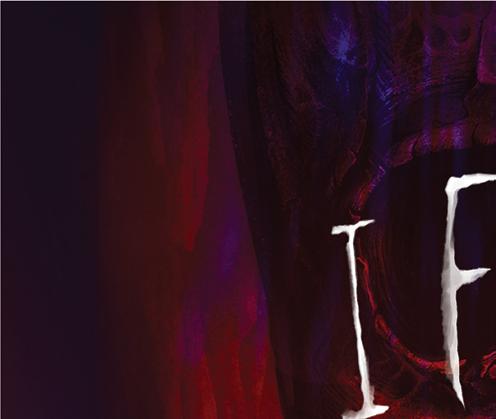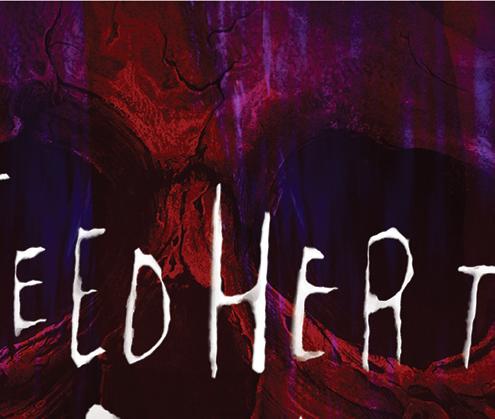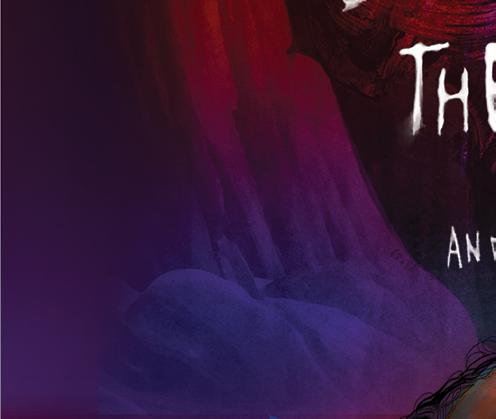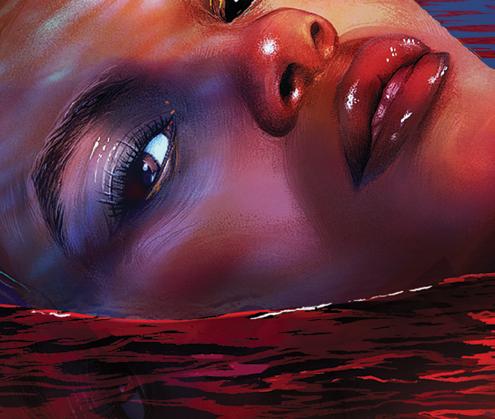KIRKUS REVIEWS





















“Family stories fill gaps in my sense of history,” writes David Mas Masumoto in Secret Harvests: A Hidden Story of Separation and the Resilience of a Family Farm (Red Hen Press, April 18), the story of a Japanese American farm family in California, beautifully illustrated with linoleum block prints by Patricia Wakida. The author knows that his immigrant story—first- and second-generation farmworkers rounded up and sent to internment camps during World War II; an uncle who served in the all–Japanese American 442nd U.S. Army Infantry Regiment—complicates the traditional narrative of American history.
Family histories, too, have gaps: At the beginning of Secret Harvests, Masumoto learns that he has an elderly aunt, Shizuko, with an intellectual disability; she was sent to live at a state institution in 1942 and largely forgotten; Masumoto believed she was long dead until receiving a call from a funeral home trying to track down Shizuko’s relatives as she neared death in hospice care. Was the family ashamed of Shizuko? Unable to care for her? Masumoto grapples with the meaning of this family secret.
Family secrets and the toll of American racism are also at the heart of Ava Chin’s Mott Street: A Chinese American Family’s Story of Exclusion and Homecoming (Penguin Press, April 25). Like Masumoto, Chin was in the dark about a large portion of her family history—specifically the story of her father, Stanley Chin, who left her mother when Ava was just a child. (“He used your mother, then threw her away” is how her maternal grandmother puts it.) As an adult, Chin finally meets her father and begins to fill in the gaps in what she knows. Everything connects back to one building at 37 Mott St. in New York’s Chinatown, where both sides of her extended clan lived in the early 20th century.

Drawing on her skills as a journalist and researcher (she’s written for the Washington Post, the Los Angeles Times, and other publications), Chin follows the story back to villages in China that sent their sons and daughters to seek fortunes in the United States. Here, those immigrants worked on the railroads, opened laundries, ran eateries, and joined the business associations known as tongs. Casting a long shadow over their American experience, however, was the Chinese Exclusion Act, which restricted immigration from China and blocked Chinese immigrants from citizenship from 1882 to 1943.
“It is a general rule of thumb among researchers and historians alike, that it is the written record that is the gold standard, and the family stories are long on twisted falsehoods, embellishment, and tall tales,” Chin writes. “But when you’re Chinese in America, with roots that stretch back to the Exclusion era, it is the historical record that is a fabulist fabrication, and the oral stories, passed down from generation to generation, like rare, evolving heirlooms, that ultimately hold the keys to the truth.” Books like Secret Harvests and Mott Street begin to show us a fuller, more troubling, but also richer picture of American history.
Co- Chairman HERBERT SIMON
Co- Chairman MARC WINKELMAN #
Publisher & CEO MEG LABORDE KUEHN mkuehn@kirkus.com
Editor - in- Chief TOM BEER tbeer@kirkus.com
Chief Marketing Officer SARAH KALINA skalina@kirkus.com
President of Kirkus Indie KAREN SCHECHNER kschechner@kirkus.com
Managing/Nonfiction Editor ERIC LIEBETRAU eliebetrau@kirkus.com

Fiction Editor LAURIE MUCHNICK lmuchnick@kirkus.com
Young Readers’ Editor LAURA SIMEON lsimeon@kirkus.com
Young Readers’ Editor MAHNAZ DAR mdar@kirkus.com

Editor at Large MEGAN LABRISE mlabrise@kirkus.com
Senior Indie Editor DAVID RAPP drapp@kirkus.com
Indie Editor ARTHUR SMITH asmith@kirkus.com
Editorial Assistant NINA PALATTELLA npalattella@kirkus.com
Editorial Assistant of Indie LEAH BLOCK lblock@kirkus.com
Editorial Assistant of Indie DAN NOLAN dnolan@kirkus.com
Mysteries Editor THOMAS LEITCH
Contributing Editor GREGORY McNAMEE
Copy Editor BETSY JUDKINS
Designer ALEX HEAD
Kirkus Editorial Senior Production Editor ROBIN O’DELL rodell@kirkus.com
Kirkus Editorial Senior Production Editor MARINNA CASTILLEJA mcastilleja@kirkus.com
Kirkus Editorial Production Editor ASHLEY LITTLE alittle@kirkus.com
Publishing Promotions Manager RACHEL WEASE rwease@kirkus.com
Indie Promotions Manager AMY BAIRD abaird@kirkus.com
Social Media & Partnership Manager SEYANNA BARRETT sbarrett@kirkus.com
Author Consultant JESSICA PACK jpack@kirkus.com
Graphic Designer KYLA NOVAK knovak@kirkus.com
Design by Kyla Novak
Don’t wait on the mail for reviews! You can read prepublication reviews as they are released on kirkus.com even before they are published in the magazine. You can also access the current issue and back issues of Kirkus Reviews on our website by logging in as a subscriber. If you do not have a username or password, please contact customer care to set up your account by calling 1.800.316.9361 or emailing customers@kirkusreviews.com.

The Kirkus Star is awarded to books of remarkable merit, as determined by the impartial editors of Kirkus.
When Prince James’ father dies, the closeted gay 17-year-old becomes the United Kingdom’s first Black king—and the target of tabloid venom—in this thriller by celebrity journalist Benjamin Dean. Read the review on p. 131.
Ani Kayode Somtochukwu
Roxane Gay Books/Grove (304 pp.)
$27.00 | June 6, 2023
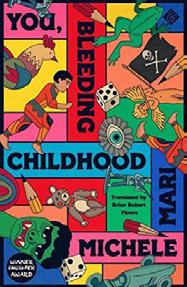
9780802160751
A debut coming-of-age love story about two young queer men in Nigeria. The debut novel from 23-year-old author and activist Ani follows two young men growing up in contemporary Nigeria. August is the only son of a woman who died after bearing him; he was raised by his father—“a ghost for whom life held no more surprises, or disappointments, no pain or happiness”— and three doting sisters. He’s not the best student, but he’s a track star and popular with his schoolmates, although he’s still haunted by the death of his mother, feeling “pangs of incompleteness, an almost, something he should feel that he never would, someone he knew enough to love but never met.” Segun is quiet and sensitive, “a boy who naturally attracted attention. The way he walked, the way he talked, his gesticulation.” He’s bullied in school because of his effeminate nature; changing schools doesn’t help. The two young men meet each other at the University of Nigeria and fall for each other, but there’s a big complication: August is bisexual but closeted, while Segun refuses to deny that he’s queer. August “had come to accept certain things about himself, certain walls he was not allowed to look over, and now Segun demanded August take a bulldozer and bring it all down.” Segun, for his part, tells August, “I’ve waged my own war with myself and my shame. I cannot deal with yours. I won’t.” The young men’s relationship is tested when Segun is brutally beaten in a homophobic attack—it won’t be the last time he’s targeted by violence. Ani’s novel is undoubtedly sincere, filled with a justifiably righteous anger over antigay hate crimes, and it’s apparent he cares about his characters. But they’re not fleshed out quite enough, leaning too close to archetypes. The writing is competent but uninspired, the plot formulaic, and the dialogue unrealistic. The author shows promise, but the novel feels like a first draft, though certainly a well-intentioned one.
Earnest but underdeveloped.
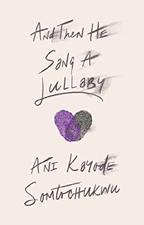
 Trans. by Stuart Schoffman Schocken (240 pp.)
Trans. by Stuart Schoffman Schocken (240 pp.)
$27.00 | June 20, 2023

9780805243611
On a visit to the Polish village where his late parents were born and his grandparents perished in the Holocaust, Tel Aviv shop owner Yaakov Fein finds love with a gentile farmer and hate in the form of festering antisemitism.
No physical evidence remains of the Jewish families who lived in tiny Szydowce, but Yaakov, whose coldly distant wife opposes the trip, hopes that merely by being there he will learn things that were kept from him by his parents. They survived the Nazis by hiding in the forest (as did young Appelfeld). Magda, the kindly farmer who takes Yaakov in and quickly becomes the love of his life, provides valuable memories, having worked in his grandparents’ house.
His encounters with other villagers are unsettling. They claim they don’t know anything about the wartime massacre of Szydowce’s Jews, who were locked inside a synagogue and burned alive. Their hatred of Jews surfaces after Yaakov discovers that after the massacre, tombstones from the Jewish cemetery were broken up and used as cornerstones for the town square. His attempts to acquire the stones, including his grandfather’s, are met with derision by the manipulative mayor, who sets an exorbitant price for them and rips Yaakov for turning it down. “There are people for whom money is God,” he says. “They can’t be changed. Even God himself can’t change them.” Appelfeld (1932-2018), who didn’t often make explicit references to the Holocaust in his fiction and uses that word only once here, attains raw emotion with his account of the horrific violence. The book, in which Yaakov’s dreams play an important role, has a fuzzy, dreamlike quality itself, leading to a more detached ending than in masterpieces such as The Age of Wonders (1981) and The Conversion (1992). But this 2005 work, being published in English for the first time, still haunts.
A powerful and timely addition to Appelfeld’s great body of work.

When you read fiction, you’re invited to enter a fictional world. The welcome might be prickly— James Joyce isn’t exactly laying down a smooth path for you on the first page of Ulysses—but you’re given the opportunity to meet the people there, peek in their closets, participate in their holidays. Sometimes the world will resemble your own, and you’ll feel validated by seeing people like you on the page. Sometimes the world will be unfamiliar, and you’ll have the privilege of spending time in a place you might not otherwise have access to.
In her debut novel, What Happened to Ruthy Ramirez (Grand Central, March 7), Claire Jiménez pulls the reader in from the first line: “If you drew a map of our family history, you might start it off with my dad, young, fat, and handsome, eighteen-year-old Eddie Ramirez, plotting to get with my moms, who was dark-skinned, small and freckled, long black curly hair. Freshly turned seventeen. Her name is Dolores.” They begin in Brooklyn, but soon you can “draw the Verrazano, the water, the Island, the dump. Draw my proud family, Puerto Rican and loud, driving over the bridge and a little pink town house” on Staten Island. Add three daughters, then subtract one—Ruthy, who disappears when she’s 13 and just may have shown up on a reality TV show her sister Jessica watches 12 years later. Our starred review said, “There’s a delightfully subversive quality to the way…Jiménez gives her characters the freedom to tell the truth as they see it.…Jiménez brings bravery to the page, and it’s her strong storytelling and humor that make this an outstanding debut.”
The characters in Jennifer Maritza McCauley’s debut story collection, When Trying To Return Home (Counterpoint, Feb. 7), don’t fit neatly onto a map. “Now that Andra has moved to South Florida, she has become Andra, Black and Something Else,” the title story begins. “In the northern city, where she grew up, they called her heyyy, you. In the Midwest, where she

lived with her father after her parents divorced, she was Kal’s baby. In Puerto Rico, where she watched her mami pass in Ponce, Andra was la negrita, la hija de Nadia.” Like Jiménez’s characters, Andra is situated within her family and community as well as in a physical place.
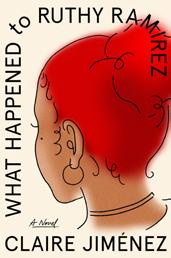
“The stories hang together in surprising ways, often linked across time,” our starred review said. “Individually, they are each admiringly gutsy and tender, with flashes of poetry.”
Maddie, the narrator of Jessica George’s debut novel, Maame (St. Martin’s, Jan. 31), lives in London and works in publishing, but she also begins her story by mapping herself into her family and community: “In African culture—Wait, no, I don’t want to be presumptuous or in any way nationalistic enough to assume certain Ghanaian customs run true in other African countries. I might in fact just be speaking of what passes as practice in my family, but regardless of who the mores belong to, I was raised to keep family matters private.” So none of her friends know that Maddie is caring for her father, who has Parkinson’s disease, while her mother is living in Ghana and running a family business. According to our starred review, George “examines Maddie’s awkward steps toward adulthood and its messy stew of responsibility, love, and sex with insight and compassion. The key to writing a memorable bildungsroman is creating an unforgettable character, and George has fashioned an appealing heroine here.…Funny, awkward, and sometimes painful, her blossoming is a real delight to witness.”
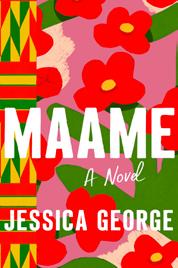
Bailey, Robert Thomas & Mercer (508 pp.)

$16.99 paper | June 20, 2023
9781542037297
An alcoholic attorney’s second murder case looks every bit as impossible as his first.
The morning after former high school football star Trey Cowan, reduced to sanitation work by a broken leg and a botched surgery, threatens to kill Sgt. Kelly Flowers, meth lord Tyson Cade’s inside man on Alabama’s Marshall County police force, Flowers is found shotgunned to death at a deserted farm. When Trey is arrested, Cade—who warned personal injury lawyer Jason Rich not to defend his own sister when she was accused of murder in Rich Blood (2022)—demands that Jason take the case pro bono. Trey refuses to tell Jason anything that might help in his defense, and the evidence against him is so damning that Jason is reduced to begging Cade for help. Cade, determined to play the piper who calls the tune, produces an alternative suspect, but it’s the last person in the world Jason wants to incriminate. In the meantime, Cade has anointed a new inside source in the police department, and Det. Hatty Daniels, the supervisor who’d opened an investigation of Flowers before his death, is convinced that it must be her boss, Sheriff Richard Griffith, or her old partner, Sgt. George Mitchell, since only they could have wiped her files on Flowers from her hard drive. With such a short list of suspects, Jason’s job should be easy, but the pressures on him from his ex-lover, his impossible niece, his nonpaying boss, and the legal system that’s pressing charges against him are so intense that he realizes that “I could win this case…and still lose everything I care about.”
Not much of a mystery but a compelling dive into the life of a lawyer out way past his depth.
Barclay, Linwood
Morrow/HarperCollins (352 pp.)

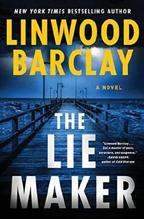
$30.00 | May 16, 2023
9780063276246
Struggling Boston novelist Jack Givins exploits an unusual writing job for the U.S. Marshals Service to track down his father, a reluctant hit man who vanished into witness protection when Jack was 9.
The father, Michael Donohue, was whisked away 25 years ago after turning state’s evidence on his boss Galen Frohm, the corrupt operator of a nationwide chain of cheap motels. Frohm ordered Michael to kill the owner of a linen company in Chicago who was making noise about the payoffs he was required to make to Frohm to service the Sleep Tight Tonite motels. Jack’s mother refused to leave with her husband, staying behind with her shattered son. “Your dad’s not
a good person. Your dad killed people, son,” Michael told Jack, words that would haunt the boy through the years. Now, scuffling for employment after failing to sell his third novel, Jack is hired by a U.S. marshal to concoct a convincing backstory to be used by a man being placed in witness protection. After Jack’s car is torched amid other mysterious occurrences, including the disappearance of the judge who presided over Michael’s trial, Jack and Lana Wilshire, his dogged newspaper reporter girlfriend, find themselves in the middle of a revenge plot to kill Michael, wherever he is. For most of the book, Barclay does a bang-up job of mixing and matching characters and plotlines and building suspense. A big reveal badly stretches credulity, though, and for a fiction writer, Jack proves to have a limited imagination. But Barclay’s latest is a fun ride nonetheless, with dips and swerves that should delight his fans.
A relentless mystery with an affecting dose of father-son intrigue.
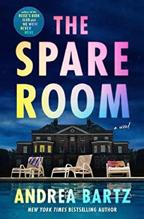
Bartz, Andrea Ballantine (352 pp.)
$28.99 | June 20, 2023
9781984820495
A woman’s pandemic-inspired lifestyle change might just become a nightmare.
Kelly Doyle moved to Philadelphia for her fiance’s job, and it’s been miserable. She hasn’t been able to find a job or make new friends, and after a fight, her fiance wants to pump the brakes on the wedding. So when Sabrina Lamont, a school friend she recently reconnected with over Instagram, invites her to stay in her spare room for a break, Kelly makes her way to the D.C. suburbs. Sabrina and her husband, Nathan, live a seemingly blessed life, she a bestselling author of erotic thrillers and he high up at the Department of Defense; their beautiful mansion is also a perfectly private fortress. As Kelly adjusts to her new life in their guest room, she
finds herself moving on and falling for both of her hosts. But just as the two open their marriage for her, Kelly discovers that their last partner went missing. Is this a sexy new beginning or a terrible mistake? Bartz is known for her thrillers, and there’s a constant thread of tension as Kelly ignores red flag after red flag in favor of her new and exciting relationship with her hosts. At times it all becomes slightly unbelievable, as Kelly seems to almost willfully wave off the most dire of warnings. Though some plotlines ultimately go nowhere and there are a few too many small twists that will throw you off rather than pull you further in, readers looking for steamy sex scenes with their suspense will have plenty to look forward to. Unfortunately, though, the mystery itself is melodramatic and ultimately does not live up to all the groundwork laid out for it.
A thriller with plenty of sex but little sense.

Brazier, Eliza Jane Berkley (416 pp.)
$27.00 | June 6, 2023
9780593438886
Brazier takes readers deep inside the rarified and competitive world of “horse girls” in this tale of jealousy and deadly secrets.
This irresistible novel opens with police asking questions about “an unimaginable tragedy” but quickly spins backward in time, exploring the months leading up to the suspicious death of one of its major characters, whose identity remains a mystery throughout most of the book. Brazier’s juicy narrative gives credence to a detective’s comment that “there were no people quite like horse people,” as she perfectly describes the back-stabbing day-to-day life at an equestrian school in California. The school is run by the megalomaniac trainer Kieran Flynn, an imperious man who makes or breaks horses as well as their riders. Young girls are his beleaguered students, but their overinvolved mothers are holding the reins, and Brazier expertly captures their arrested development, broken relationships, and neediness. Heather, rich and oh-so-sad, wants her teenage daughters to fulfill her lost dream of being a champion show jumper. Daughter Piper, a natural equestrian, won’t ride because of the overbearing Heather’s interference. Her timid sister, Maple, is afraid of horses but is pressured by Heather into riding. Ex-addict Pamela is broke but wants her daughter, the chaos-loving Vida, to have the same opportunities as Heather’s girls and will do anything to make that happen. This tale of the horsey set unpacks enough mean-girl drama and emotion to fill a horse barn. Equipment tampering, underage drinking, and animal doping will keep readers turning the pages, and long-kept secrets, unplanned pregnancies, and power-hungry manipulators add to the novel’s can’t-look-away storyline. Laughing at rich-people problems is a popular theme, but Brazier makes us feel for her characters, rich and poor, and delivers a blue-ribbon story of the haves and have-nots.
Horses and young riders are center stage, but dysfunctional adults steal the show in this moody mystery.

Brodeur, Adrienne
Avid Reader Press (320 pp.)

$28.00 | June 27, 2023
9781982198107
A family’s trauma laid bare.
As with her memoir, Wild Game (2019), Brodeur sets her debut novel on Cape Cod, whose terrain she knows intimately, within a family, like her own, harboring secrets and lies. It’s the summer of 2016, a contentious election looms, and marine biologist Adam
Gardner is deeply unsettled by his impending birthday. Soon to turn 70, he feels on the cusp of a great discovery about humpback whales—a discovery, he believes, that will finally earn him the accolades he deserves. Suffering from bipolar disorder that he has managed to keep in check with medication, he decides to free himself from “the mind-numbing effect” of those meds in order “to succumb knowingly to the allure of mania.” The immediate effect is energizing: He professes “a remarkable facility with a broad and unexpected range of topics: Shaker furniture, Tibetan culture, black holes, Homer, string theory, you name it,” and, most notably, the language of whales. Adam’s 70th birthday party is the central event of the novel, an occasion when his son, Ken, an arrogant real estate developer with political ambitions, and his daughter, Abby, an artist just becoming recognized, will present him with gifts they hope will elicit the praise and admiration they desperately covet. Raising Ken and Abby on his own after his wife’s death, Adam was a difficult father, distracted by grandiose professional ambitions, undermined by his mental illness. He called his children his “little monsters.” Ken, bullied at school, felt neglected; Abby felt demeaned as both a woman

“Horses and young riders are center stage, but dysfunctional adults steal the show in this moody mystery.”
girls and their horses
and an artist. Adam thought of her as “a special snowflake of the highest order.” As Brodeur’s narrative unfolds, tensions erupt, revealing festering wounds, anger, and pain. Through Ken’s sessions with an unfortunately stereotypical psychiatrist, the shocking details in Abby’s latest painting, and the appearance of a mysterious woman, the family’s “conspiracy of silence” is irrevocably shattered.
A sensitive portrait of troubled lives.
Bromwich, Kathryn
Two Dollar Radio (180 pp.)
$26.00 | June 6, 2023
9781953387318
In this haunting debut, a woman running from her past tries to find solitude and independence in the woods.

Laura Mantovani has spent several months living in a cabin in the mountains above an Italian village. There, she walks in the forest, reads, and tends to the small home she has fashioned for herself. Interactions with the locals are limited to brief errands and odd jobs, such as translations and tutoring, and though she is not accepted fully, she seems to command some level of respect from those she meets. This distance is threatened, however, when she takes a lover—a bartender who visits her at night and is eager to keep their relationship a secret. The secrecy suits Laura, who has secrets of her own she’d like to keep from the village; she’s hiding from an abusive and controlling husband. When a friend from her previous life appears at her door, Laura’s carefully constructed world begins to come apart. Wracked by illness and increasingly dependent on laudanum, she retreats into herself and the woods, unable to see the growing discontent the villagers have with the strange woman who appears increasingly unmoored. At under 200 pages, this tight novel doesn’t have much room for revelations to be overly drawn out, including a flashback to the days preceding Laura’s decision to run away from her marriage. Bromwich’s pacing works brilliantly; languid and slow as we meet Laura a few months into her time in the cabin, comfortable and familiar, before becoming increasingly disjointed and rapid to match her deteriorating mental state. Awkward interactions with locals give way to jarring and difficult exchanges in which Laura, from whose perspective the story is told, struggles to comprehend the growing animosity from even those with whom she was nominally friendly. The result is a slow-burning tension that never quite resolves into something like closure but is nonetheless riveting and original.
A gripping, richly layered story of a woman’s unraveling as she grapples with threats both past and present.
ON
Burke, James Lee
Atlantic Monthly (288 pp.)
$27.00 | July 11, 2023
9780802161697
The Civil War comes to New Iberia, Louisiana, the capital of Burke’s wondrous fictional empire.

Seriously in debt to business associate Minos Suarez, Charles Lufkin rents him Hannah Laveau, an enslaved woman he’s recently purchased. Things don’t go well for either Hannah,

“A woman running from her past tries to find solitude and independence in the woods.”
at the edge of the woods
whom Suarez unmercifully assaults, or Suarez, who’s found castrated with his throat cut shortly after Hannah parts company with him. Just as Hannah is haunted by Samuel, the son from whom she was separated during the bloody Union attack on Shiloh Church, Lufkin’s nephew, Wade, who volunteered as a medical officer on the condition that he wouldn’t have to fight, is haunted by the Union officer he killed. Pierre Cauchon, the local “oversight constable for Negro legal problems” who’s already tangled with his own devils, soon comes up against another two officers on opposing sides of the conflict. Confederate Col. Carleton Hayes is a self-described man of “egalitarian views” who’s hanged a number of abolitionists and would like to hang more. Union officer Capt. John Endicott’s enfilade at Shiloh Church left Cauchon traumatized but, unlike so many of his other comrades, still alive. As schoolmistress Florence Milton takes Hannah under her wing and goes into hiding with her, Wade Lufkin challenges Cauchon to a duel with an unexpected result. All the while, conflicts rage between the two sides in the war, between ostensible allies on either side, and within every single character. In his closing acknowledgments, Burke indicates that he considers this novel his very best. Even readers who find themselves swamped by all the calamities of war may well agree that it’s his most probing examination of the enduring legacy of slavery.
A grueling, compassionate demonstration that “the devil ain’t down in a fiery pit. He’s right here.”
Bushnell, Jeremy P. Melville House (352 pp.)

$17.99 paper | June 6, 2023
9781685890322
Bushnell’s third novel blends an atmospheric supernatural mystery with an intriguing exploration of gender identity.
In 1909 Boston, 17-year-old Artie Quick works as a salesgirl in Filene’s Tunnel Bargain Basement, the recently opened overflow shop. But on Wednesday evenings she disguises herself as a man, slicking back her cropped black hair with pomade filched from the men’s counter and wearing her estranged brother Zeb’s old suit, to attend Professor Winchell’s course on Criminal Investigation at the YMCA’s Evening Institute for Young Men. Although Winchell, a police detective, easily outs Artie after the first class, he is impressed by her “keen investigative mind” and refuses to expel his bright student. Eager to practice what she has learned, Artie and her friend Theodore, an eccentric upper-class bachelor and student of magic, head to Boston Common to investigate a mysterious scream heard the previous evening. When they stop an attempted abduction of a young woman and Artie’s class is abruptly canceled, the duo probe further into a series of unsolved kidnappings and gradually uncover a malevolent conspiracy that leads from City Hall to an abandoned subway tunnel construction site that may house an ancient evil. Bushnell
keeps his fantastical elements light but believable, focusing instead on the affectionate (but not romantic or sexual) friendship between Artie and Theodore, two appealing social misfits who together “navigate the world better than either of them could alone.” Also compelling is Artie’s gradual recognition of her real self (“not exactly a man, but maybe something other than a girl”) as she grows more comfortable in her suit and enjoys the freedom it allows. Unfortunately, the abrupt deus ex machina ending undermines Artie’s budding agency and gives the impression the author didn’t know how to finish his novel.
An entertaining urban fantasy.


Calder, Natasha
Overlook (224 pp.)
$25.00 | June 27, 2023
9781419764660
The narrator of British author

Calder’s eerie dystopian novel is a young woman living on an isolated island within sight of a mainland ravaged by infection.
The novel’s greatest draw is the woman’s enthralling voice, archaically formal and casually poetic. Whether her story makes sense or should be trusted is another matter. She avoids explaining why she’s ended up on the island, secure in a well-stocked bunker under a disintegrating ancient castle. Her sole companion is handsome, mysterious Crevan, who joined her some time ago and calls her Kit though it’s not her name. Although she sometimes, creepily, calls him daddy, he is clearly not her father. Nor are they lovers, although the
sexual tension can grow intense. She prefers not to dwell on risk and considers Crevan paranoid. He repeatedly promises he will never hurt and always protect her, but she doesn’t trust stories about his previous life and how he was forced to kill in selfdefense. Still, she’s fascinated by his explanations of the strange tattooed patches pricked onto his arm while he was a captive of what they both call backbiters, former doctors now “a-hunting” human blood. Why they’re doing so remains initially unclear, although Kit occasionally breaks away from personal obsessing to deliver treatises on how humankind has reached “the end of days” because science has lost the battle against devouring bacteria that attack not only people, but, more disastrously, plastic. Meanwhile, Kit’s happy on the island and drawing closer to Crevan. Then a half-dead woman shows up to disrupt, possibly infect Kit and Crevan’s uneasy paradise, and Kit discovers she’s willing to do almost anything to survive. Although Calder missteps with an unfortunate last plot twist into psychological melodrama, the bulk of her novel plays cleverly with contagion and bacteria as metaphors for the spread of both good and evil.
Tantalizing prose carries what is essentially a cautionary tale about unintended consequences; Calder is worth watching.
Caron, Amber
Milkweed (208 pp.)
$16.00 paper | July 11, 2023
9781639550449
Ten stories that paint vivid characters in emotionally resonant moments. The short stories in this collection often describe dramatic events—a cabin washed away; a boy dead in a fire—but they center subtleties of emotional life. Racial diversity isn’t explicit, and apart from mentions of a migrant family, character descriptions don’t suggest it. But the stories feature a welcome range of economic backgrounds: a wealthy father who uses his money to assuage a personal sense of guilt; a girl whose family can’t quite scrape together $1.50 for a plastic razor. Throughout the collection, we encounter characters through details that don’t coalesce into revelation or diagnosis. A mother’s fixation with divining rods sends her wandering canyons at night; she embraces trees because it “chases away bad thoughts”; and her knitting basket is full of unfinished projects. But we don’t know why she is like this, what a name for it might be. In the poignant final story, a woman struggles to reconcile everything she knows about her niece—her watchful demeanor, the way she picks at her food, the trouble she causes her parents—and comes up short. “Do you want to know where she was, what she was doing? (She will refuse to say.)” This willingness to describe without arriving at answers might frustrate readers accustomed to short stories that end with a flourish of insight or irony. But the achievement of these stories has more to do with emotional movement than a point of arrival. This approach creates a sense of depth and realism: These characters

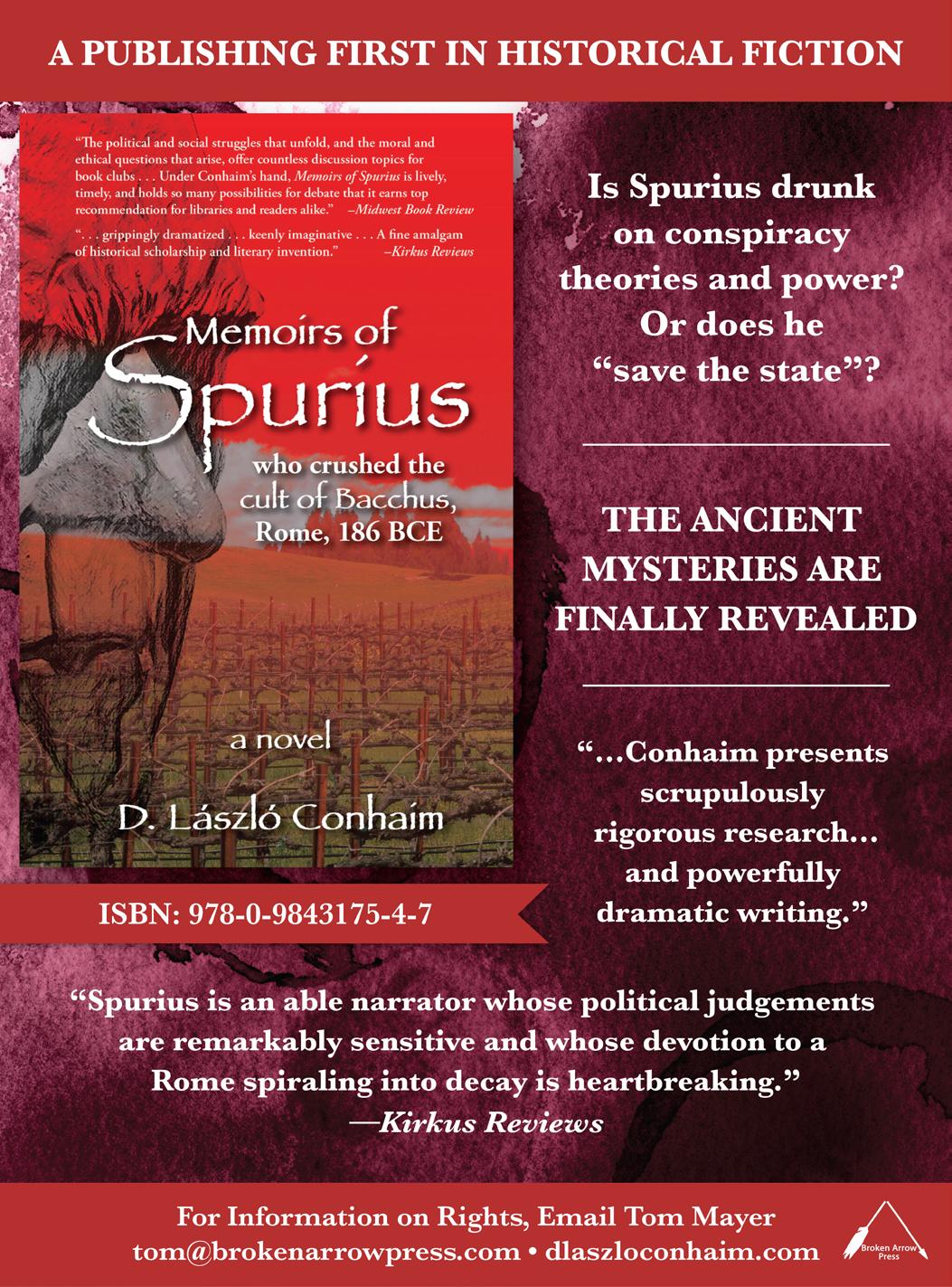
 BY STEPHAN LEE
BY STEPHAN LEE
Novels about writers stealing each other’s ideas are nothing new, but it’s hard to think of a writers-behaving-badly novel that’s as shockingly current as Yellowface (Morrow/HarperCollins, May 16), the latest by Babel author R.F. Kuang. When disappointed novelist June Hayward witnesses her much, much more successful frenemy Athena Liu die in front of her, she stumbles on an opportunity to steal Athena’s unpublished manuscript, rewrite much of it, and pass it off as her own. June gets propelled into the career she’s always felt she deserved, but of course, the telltale bestseller slowly corrodes her soul, one lethal subtweet and Goodreads review at a time. Although Yellowface is written in the tone of literary satire, it’ll give anyone familiar with the industry cold sweats with how hyper-real the depictions of social media scandals and racism in the book world are. “Every single thing that hap-
pens in this book is milder than scandals that happen every other month in publishing,” says Kuang in a recent interview over Zoom. “It doesn’t even get to some of the more malicious and deceitful things people have done in this industry, and that’s because I don’t have 800 pages to cover it.” Here, Kuang tells us more; our conversation has been edited for length and clarity.
On the face of it, Yellowface seems like a big departure, genrewise, from your Poppy War trilogy and Babel , both of which are rooted in history and fantasy. Was it actually a major departure in your mind?
People keep asking me what it is like to write in such a different genre, and I don’t really understand the question, because it makes it sound like there’s something exceptional about fantasy or that modes of storytelling are inherently different. I think it comes from a place of looking down at fantasy. For instance, recently there was a headline that said “R.F. Kuang Makes Her Literary Debut.” And I thought, “Is this my debut? Really, after Babel, I still haven’t had my literary debut?” And I think about how, for instance, Kazuo Ishiguro clearly is writing science fiction and fantasy, but we don’t shelve his books under SF/fantasy.
Even if there aren’t literal epic battles happening in this book, you made the process of June’s rewriting and editing Athena’s work just as dynamic, if not more so, than any fight scene. Was that difficult to do?
Oh, writing about writing is the easiest thing in the world. When you’re writing about people having sword fights or doing magic, there’s so much research involved. I’ve never been in a fight for my
In the wickedly readable Yellowface , the novelist pulls back the curtain on hypocrisy and racism in publishingJohn Packman
life involving magical weapons, but I write all the time. I think there are really good literary models of how to make writing about writing seem interesting, and I’m thinking of Stephen King’s Misery. And Sally Rooney, who I love, also writes a lot about writers thinking about writing. I mean, those are the trenches that we’re familiar with. Those are the battles that we’re used to fighting.
There’s so much that June does that’s completely reprehensible, but as someone who also does creative work for a living, I found myself siding with her more than I’d like to admit. How intentional is that?
A lot of my BIPOC writer friends who have read this tell me, “I can’t believe it, but I kind of side with June here,” and that’s absolutely intentional because, first of all, I never like to create a villain that you can’t somewhat relate to—otherwise it’s like watching a random object sow chaos. I’m much more interested in villains who have clear goals and motivations and whose wicked schemes are quite understandable.
Also, June is relatable because the things she struggles with in publishing are so universally relatable—we’ve all been made to feel like June. This industry grinds us to the ground. Nobody really talks openly about the mental toll that being an author takes on you.
From an outsider’s perspective, your career seems more like Athena’s right now, but talk about a time you’ve felt more like June. I’ve felt more like June for most of my career. The Poppy War trilogy never hit any bestsellers list— when it first came out, I thought it had flopped. I thought there was no way it was ever going to earn back its advance. I’ve had that experience of sitting at a signing table for two hours and not a single person coming up and buying the book. I mean, it’s excruciating and humiliating and you feel like your career is never going to recover.
The books ultimately got legs of their own and spread really through word of mouth…but that took a long time to build. It wasn’t evident in the first few years of my career that this would ever happen, so we were all astonished when Babel did as well as it did, because I thought that if Babel didn’t do well, then that was the end of things for me. It just goes to show you never feel quite secure.
Wherever you are in publishing, it can all disappear beneath you.
Because this book deals so directly with publishing and how readers interact with authors, does it feel like you’re opening yourself up to criticism in a new way?
I guess I don’t really think about criticism or backlash to my books because I don’t read Goodreads reviews [laughs]. At the same time, a conversation is kind of the point of this book. People are supposed to engage with it, people are supposed to have strong opinions about it, and I would welcome people disagreeing strongly with arguments in the book. Those disagreements are generative, and those are the conversations we ought to be having about the industry. So we knew that this book was going to cause very strong reactions, either positive or negative, but the book exists to be a conversation starter. It doesn’t exist for everybody to agree with it. If it gets people talking, then I will consider that mission accomplished.
Stephan Lee’s most recent book is K-Pop Revolution. Yellowface was reviewed in the March 15, 2023, issue.

exist beyond the moments the text describes; their world is not restricted to a story arc.
A collection that patiently renders emotional depth without recourse to angst or melodrama.
Coates, Darcy
Poisoned Pen (352 pp.)
$15.99 paper | July 11, 2023
9781728270258
A winter mountain getaway goes horribly wrong when a small group is stranded in the snow and a gruesome killer picks them off one by one.
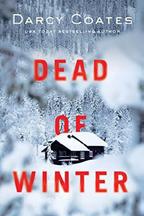
It was supposed to be a romantic getaway in the Rocky Mountains for Christa Bailey and her boyfriend, Kiernan. But when their private tour bus breaks down on the way to the Blackstone Alpine Lodge, Christa finds herself trapped in the woods and separated from Kiernan. After being rescued by other members of the group, who had been strangers to her until that day, Christa is determined to go back out into the woods to find Kiernan and bring him to safety. But the snowdrifts are high, and even the few members of the group who want to support Christa’s rescue mission know it’s a fool’s errand. Tour guide Brian convinces Christa to leave a lantern as a beacon for Kiernan, and the group prepares to hunker down for the night in a little cabin they’ve found unlocked and vacant, perhaps their last piece of good luck. Christa has a premonition—“We’re all going to die here”— and by morning, this isn’t just a feeling anymore. Brian, their best hope for rescue, is missing, and when the group searches for him, they find his head impaled on a tree, a branch sticking out of his lifeless mouth. Her worst fears justified, Christa is equally terrified and resigned when whoever killed Brian starts targeting the other survivors in a graphically grim take on a locked-room mystery.
A fast-paced thriller aimed at readers who enjoy a hunt ending with a head on a stake.
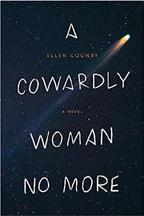
Cooney, Ellen Coffee House (232 pp.)
$16.95 paper | April 4, 2023
9781566896719
A 44-year-old woman comes to terms with her life while attending an annual corporate banquet.
Software analyst Trisha Donahue always relished the annual boozy parties thrown at the Rose & Emerald restaurant in central Massachusetts by the Boston company where she’s worked for eight years. But new management runs the company with a more corporate
ethos, and speechifying has replaced drinking alcohol, no longer allowed, at the now unofficially mandatory banquets. Having learned that she’s been passed over for a promotion she was all but promised, Trisha is a reluctant attendee this year. Then she’s stunned, not in a good way, when management announces to the crowd that she’s the first woman “Employee of the Year.” Trisha flees within the passageways of the almost magically charming Rose & Emerald, located (perhaps too) coincidentally in the community where she grew up “on the wrong side of the tracks.” While Cooney effectively draws peripheral characters like Trisha’s privileged yet self-aware husband and her stoic, ailing boss, the only character that truly matters here is Trisha. As she struggles through this one crazy day, she reviews her evolution from a working-class girl with brains and ambition to a woman afraid to rock the status quo. The depiction of Trisha’s middleclass financial anxiety is spot-on, but Cooney lays on the sociopolitical critique with a heavy hand. Trisha so relentlessly complains about blockheaded bosses and bemoans turning “corporate” that the good reasons she’s angry become boring. The novel’s explorations of class inequality and corporate mentality seldom reach beyond the obvious, and its perspective on society’s unfair treatment of women seems dated—Trisha has no awareness of the #MeToo movement, and her thoughts on what clothes a successful woman needs, including pantyhose, feel anachronistic. But Cooney is remarkably adept at capturing minute inner crises within an individual and the imperfect but real connections between people. While the writing can be pessimistic, even cynical, neither Cooney nor her central character is afraid to look kindness in the face when it arises. No mean feat.
A shining exploration of human frailty and endurance falters when it attempts social analysis.
Cronin, Justin Ballantine (560 pp.)

$27.00 | May 2, 2023
9780525619475
Things aren’t what they seem in the supposedly idyllic state of Prospera.
Cronin’s latest takes place in Prospera, an archipelago state that “exists in splendid isolation, hidden from the world.” The main island is designed to be something of a paradise, “free of all want and distraction,” where residents are urged to pursue art and personal betterment. The Annex, another island, is “home to the support staff—men and women of lesser biological and social endowments.” Proctor Bennett lives on the main island and works as a “ferryman”—when his fellow residents become older or infirm, he escorts them to a boat that will carry them to the “Nursery Isle,” where they are reborn as teenagers who will then rejoin Prospera. One day, Proctor learns that the next person he’s in charge of ferrying is his father, and it turns out the old man doesn’t go quietly—on the way to the pier, he begins muttering seemingly incomprehensible phrases, telling his son, “The world is not the world,” and
“Twisty, thrilling, and beautifully written.” the ferryman
“You’re not...you.” Then things get even more complicated: Proctor meets art dealer Thea, who’s tight with a group of dissatisfied Annex residents, and then he gets fired from his job, which leads him to believe Prospera might not be everything he’s thought it was. He’s also trying to navigate his increasingly rocky marriage to Elise, a fashion designer whose mother, Callista, is the chair of the Board of Overseers for All Prospera—“the boss of everything.” The twists in this novel are plentiful and authentically surprising, and although there are tons of moving parts, Cronin does a wonderful job handling them. This is a dystopian novel that doubles as a detective story, and Proctor is an appealing protagonist, semi-hard-boiled but never descending into cliché. Cronin’s prose is solid, and he handles the dialogue, sometimes leavened with humor, expertly. It’s a hefty book that moves with an astounding quickness—yet another excellent offering from an author with a boundless imagination and talent to spare.
Twisty, thrilling, and beautifully written.
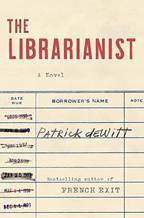
deWitt, Patrick Ecco/HarperCollins (352 pp.)
$28.99 | July 4, 2023
9780063085121
An old man’s routines are interrupted by a woman in pink in this wistful fable.
Bob Comet, a retired librarian, is 71 and has lived an unremarkable life in Portland, Oregon, in a mint-colored house that belonged to his late mother. “He had no friends, per se; his phone did not ring, and he had no family.” The year is 2005, and this dreary state of affairs stems partly from the fact that shortly after he married her in 1959, Bob’s wife ran off with his best friend. Things begin to change for the retiree when he encounters a woman about his age in a pink sweatsuit staring at the refrigerated beverages in a 7-Eleven. After he learns that she is a resident of a nearby senior center and returns her there, he makes a startling discovery. The narrative shifts to Bob in his 20s, when he becomes a librarian and meets his wife-to-be and the man who would become his best friend, before the two betrayed him. The story shifts again, to Bob at age 11, when he ran away from home and had an adventure with two eccentric women who performed elaborate stage shows. They are among the several lesser characters who provide color and light in this gray tale. DeWitt has gained a following with the black comedy of his past three novels—French Exit (2018), Undermajordomo Minor (2015), and The Sisters Brothers (2011). The new book is different, marked by the resigned melancholy surrounding Bob, a mood not always understated: “There had been whole eras of Bob’s working life where he knew a lamentation at the smallness of his existence.” He brings to mind John Williams’ Stoner and Thoreau’s chestnut about “lives of quiet desperation,” but it is telling that deWitt chooses to capture him at times when his life takes a turn. A quietly effective and moving character study.
Dorsey, C. Michele Severn House (240 pp.)
$31.99 | July 4, 2023
9781448310784
Her mother’s death begins a cascade of increasingly criminal traumas for a Boston law student.

Claire Taylor’s dementia has deepened, but she seems safe in Thompson House, a residential memory-care facility where she’s bonded with medication nurse Terry Walsh. When she unexpectedly dies soon after repeatedly mentioning the name Sheila Fairclough, her daughter, Olivia, is at a loss in more ways than one. She can’t help but be struck by the coincidence that the newest member of her study group at Portia Law School is Boston cop Ryan Fairclough, whose officious intervention had earlier forced Olivia to stop caring for her mother at home. Neglected by her husband, psychiatric resident Daniel Buchanan; bereft of her only other relative; and subject to a troubling series of attacks, from the theft of an orchid someone’s sent to commemorate her mother’s death to the slashing of her tires, Liv determines to track down Sheila Fairclough. Her search leads her to a raft of unholy revelations about her mother, who’d told Liv years ago that she’d fled with her from Liv’s father, and her own identity. Along the way, she finds just enough time to apply to become the legal guardian for Brady Parro, the 2-day-old baby who inherited an opioid addiction from his late mother, who turns out to be in even greater danger than she is. Dorsey escalates the tension masterfully until Liv uncovers one secret too many and lands both herself and Brady in mortal danger.
An endless supply of family skeletons compete for attention as they tumble from the closet.
Duncan, Eliot Norton (224 pp.)
$16.95 paper | June 13, 2023
9781324051220
A troubled protagonist deals with addiction and his own becoming in this expressive bildungsroman.
This novel in four parts begins in a Paris bathroom, where the titular protagonist is getting a haircut from his best friend and flinching at the sight of his own breasts. Ponyboy and Toni “grew up and over and out of Iowa, together,” discovering their true genders alongside each other. With Toni, Ponyboy feels like himself—or at least something close to the self he longs to be. But to his girlfriend, Baby—a lesbian—his masculinity is a problem that they may not be able to resolve. Everyone involved in this ménage drinks a lot of alcohol and snorts a lot of coke, and for Ponyboy, substance abuse is a
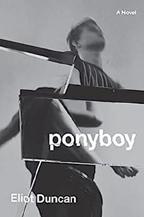
conscious attempt to escape the difficulty of being himself. His use reaches a crisis point in Berlin—where the second part of the book is set—which sends him into recovery and back to his family. The narrative is interspersed with scenes from his Midwestern youth and oddments like a letter to Sigmund Freud’s patient Dora and imagined conversations with Kathy Acker. During the first parts of the novel, Duncan deploys an arduously metaphorical style that veers from the sublime to the cartoonish. “I lose my body exceptionally” is a gorgeously economical way to describe the way Ponyboy feels liberated from his physical reality while wasted. On the other hand, “My cockintelligence smolders in my furrowed brow” is a bit hard to take.
“Back arched aching in solar want. My teeth pull on the meat of an olive.” This is an excerpt from a text sent to Baby. A very long text. An unsent email message to writer and philosopher Paul Preciado is similarly overwrought. But, as Ponyboy moves toward and through rehab, Duncan chooses a plain style that allows his protagonist to emerge as real and true—and alive. Technically ambitious, often trying, and ultimately rewarding.
Flattery, Nicole Bloomsbury (240 pp.)
$26.00 | July 11, 2023
9781635574319
Andy Warhol and his Factory are seen from the disaffected point of view of a teenage typist in Flattery’s bleakly funny debut novel.
In 1966, 17-year-old Mae, living with a mercurial waitress mother and her mom’s sometime boyfriend, is bored with school and alienated from her one friend there. After weeks spent riding department store escalators and a one-night stand with a creepy young businessman, Mae stumbles into a typing gig at Warhol’s studio, one for which she is paid only occasionally, when there’s some cash lying around. After a brief stint answering phones and typing up letters begging the parents of Warhol’s hangers-on for money, she is assigned the task of typing up verbatim a series of tape recordings of conversations in the studio, mostly between Warhol and actor Ondine, which will form a fictionalized version of Warhol’s book a, A Novel. Warhol, seldom mentioned by name, is a shadowy presence in the background of the commotion created by his followers, some of whom call him Drella, a combination of Dracula and Cinderella. “Everyone else forgot about the tape recorder,” Mae writes. “…Drella never did.” The typists themselves play a complicated role in the goings-on, at least in their own minds. “For several hours a day we had all the power. Then we stepped into the real world and had none,” Mae thinks. While oddly British locutions—ordinary New Yorkers saying things like “You’ve a very goofy personality” or “Will we order drinks?”—sometimes threaten the credibility of the novel, it pulls the reader deeply into Mae’s increasingly fragile mind, where the desultory, performative conversations she spends her
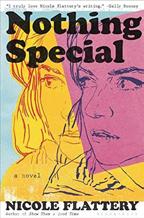
days transcribing threaten her ability to shape a life for herself. Like the conversations the young women transcribe, the novel is a strangely compelling combination of the soporifically mundane and the bracingly odd.
Not just for Warhol fans.
Ford, Richard Ecco/HarperCollins (352 pp.)
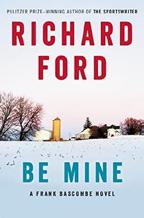
$29.99 | June 13, 2023
9780061692086
Frank Bascombe receives the sendoff he deserves in this fifth book of the series, following Let Me Be Frank With You (2014).
Death is very much on the mind of the 74-year-old narrator of this curtain call of a novel. But not primarily his own. His one surviving son, Paul, has contracted ALS (or “Al’s,” as they personify it), and Frank is shepherding him through what both know will be his final days—first at the Mayo Clinic in wintry, frigid Rochester, Minnesota, and then on a pilgrimage to Mount Rushmore. It’s a trip that both men find senseless and absurd, but you have to fill a life somehow, even if it’s about to end. Paul has neither forgotten nor forgiven his parents’ split, their marriage doomed after the death of his brother. Now Paul’s mother (Frank’s first ex-wife) is dead as well. Frank seems adrift, but then he always has. He’s a reflective man but not a particularly deep thinker, more reactive to the vagaries of life than purposeful at determining any particular goal, direction, or meaning. But death— his first wife’s, his son’s, and eventually his own—gives him a lot to ponder about the meaning of it all, if there is any, and causes him to reflect on the life he has lived through the previous novels. One needn’t have read those to appreciate this, but it could well inspire readers to revisit the entire fictional cycle, launched to great acclaim with The Sportswriter (1986). As its title alludes, the new novel focuses on Valentine’s Day, as much as Independence Day (1995) did on that holiday: It’s a novel about the ambiguities of love and happiness. Frank remains a funny guy, both ha-ha funny and a little odd, but Ford couldn’t be more serious about his craft, his precision, his attention to detail, his need to say exactly what he means.
If this is also Ford’s curtain call, he has done himself proud.

Frank, Victoria Benton
Morrow/HarperCollins (352 pp.)
$27.00 | June 6, 2023
9780063286153
A 29-year-old Manhattan chef who returns home to Sullivan’s Island, South Carolina, when her restaurant-owner grandmother is in a car accident ends up staying for the summer.
Magnolia Adams’ grandmother Rose is her beacon: the light by which she sees the world. After years of prioritizing her own goals of being a chef and working in New York, trying to make her way in the restaurant world, all she has to show for it are a poorly paid job where she is not treated well and an on-again, off-again open relationship with co-worker Ronny. The one highlight is that she lives with her best friend from back home, Jim, an aspiring actor. When her grandmother is put into a medically induced coma after a car accident, Magnolia and Jim race back to South Carolina. Magnolia ends up staying for the summer to help her family—her mother, Lily, who struggles with alcoholism and broken dreams, and her sister, Violet, who’s recently found out she’s pregnant—and the family’s restaurant, the Magic Lantern, a neighborhood institution that was founded by her great-grandmother Daisy. Things are much more dire than she’d realized, and her mother’s boyfriend, Buster, has all but run the restaurant into the ground. The story follows the complicated relationship of Magnolia and Violet as they work through their respective relationship troubles—Magnolia with Ronny back in New York and Sam Smart in South Carolina, and Violet with her live-in boyfriend, Chris—and as the sisters move on to new things in their efforts to save the restaurant and support each other, their Gran, and their mother. Frank writes in a breezy style that often belies the anger and discontent below the surface of her story, and though her characters are fully formed, she gives them glossy surfaces that tend toward expected gender norms: The women are slim, beautiful, and well dressed, the men are tanned, toned, and quick to offer help.
A story that focuses on the competition, love, and anger of sisterhood and the responsibilities of family.
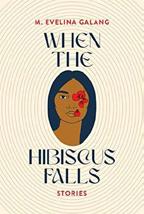
Galang, M. Evelina
Coffee House (256 pp.)
$17.95 paper | June 13, 2023
9781566896795
Galang’s short stories brim with family members—lolas and lolos, ates and kuyas, people whose care can be suffocating or revelatory as each generation confronts what Filipino American identity means to them.
In the title story, a debate between cousins about what
constitutes cultural identity—historical knowledge or family ties—becomes a family parable. “One day we will all be the ancestors,” the narrator says, articulating the collection’s implicit argument: that all stories, old and new, constitute valid and important histories. In “Foodie in the Philippines,” Clarissa takes her husband, a chef, on a tour of her family’s ancestral home to help create a compelling brand for a Miami restaurant. Though she brushes off her cousin’s suggestions that she pay respects to local spirits, she finds herself haunted and watched after by long-dead relatives and figures in traditional Filipino dress. Clarissa isn’t converted by the story’s end, nor is she ambivalent to the visions—she is simply left with them. Many of the stories refuse formal conclusions, preferring instead to leave their characters as they consider whether to embrace or reject the family histories that flit about like ghosts. And though some of Galang’s explorations of the future feel flat, like a foray into a time after “the Story Revolution” in “The Kiss,” her use of the past is deft. In “America, Still Beautiful,” an election causes a granddaughter to sob as her grandmother “weighed the candidates, slipping their campaign promises into her pockets and rolling them like loose change,” and in “Isla of the Babaylan,” colonization’s violence lies in its power to make a person feel lost within her own self.
A portrait of how complicated it is to face the history you inherit.
Gaynor, Jessie
Random House (320 pp.)
$27.00 | June 20, 2023
9780593447871
A rudderless woman searches for meaning at a wellness retreat.
Jane Dorner, an account manager at Relevancy PR, spends her day sending emails that include phrases such as “in case you think this is just another basicbitch vibrator” and “#GirlBoss.” That is when she’s not pining over her poet ex-boyfriend, Byron; agonizing about her nearly $100,000 in medical debt; or using company time to cyberstalk Byron’s new girlfriend. After Jane is caught slacking off by her boss, she’s desperate to keep her job. Her Hail Mary pass is to pitch the idea of Relevancy getting into “experiences” rather than just products. Jane has her eye on FortPath, a wellness retreat she discovered on Instagram. Despite warnings that it might be a cult, Jane, so entranced by the woman she saw on FortPath’s Instagram page, packs her bags (and a decent amount of self-loathing) and departs on FortPath’s 11:30 a.m. livery cab to New Jersey—the 6:30 a.m. option that all the other participants take being unfathomably early. When she arrives, Jane meets the beautiful and enigmatic Cass, the woman she had admired on Instagram. Cass, who walks around barefoot and has the uncanny ability to make participants release themselves by weeping (among other, less PG–rated releases), is described by Jane as having “the charisma of a cult leader, but not enough

“A portrait of how complicated it is to face the history you inherit.”
when the hibiscus falls
of the drive.” FortPath is also staffed by Tom Bradstreet, a surprisingly three-dimensional character whose backstory is the most compelling part of the novel. The first third of the book is a hokey slog, filled with every wellness cliché imaginable. However, once Jane starts working for FortPath full time, there is a definite shift, and Gaynor is able to balance humor with a decent amount of heart.
A somewhat successful look at the people who participate in and profit from the wellness industry.
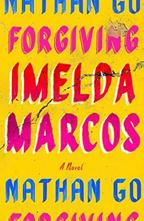
Go, Nathan Farrar, Straus and Giroux (240 pp.)
$26.00 | June 13, 2023
9780374606947
A deathbed confession opens into a journey through the history of the Philippines and a nuanced exploration of deep spiritual questions.
From a hospital bed where he is suffering complications from kidney surgery, Angelito Macaraeg begins a letter to his estranged son. Lito insists that he simply intends to tell “a good story”—something that might be useful for his son’s career as an American journalist. However, the deeper Lito delves into his memories, the more apparent becomes his struggle to make peace with the past. As Lito tells the story of his youth in the Philippines, he recounts his mother’s murder, his father’s frequent disappearances, a troubling experience in the mountains at a Communist camp run by a retired “magical” priest, the experience of falling in love with his son’s mother and the circumstances that led to their estrangement. He also relives his formative experiences as a chauffeur for Corazon Aquino, who led the People Power Revolution of 1986 and later became president of the Philippines after her husband’s assassination. At the center of Lito’s reckoning with the past is a secret meeting between Mrs. Aquino and Imelda Marcos, the wife of dictator Ferdinand Marcos, whose extravagant lifestyle earned her the unofficial title “the Lady of the Thousand Shoes.” There is something almost Kierkegaard-ian in the way Go weaves together fictional narrative and nuanced explorations of forgiveness, redemption, guilt, and commitment to one’s ideals. His attention to historical detail breathes life into the novel’s philosophical inquiry, which avoids didacticism while striking at the heart of some of the most pressing questions of the human condition. Despite its often dramatic subject matter, Go’s narrative burns slowly, gracing the novel with an understated yet profound power.
A tender meditation on the unseen moments that shape history and the human spirit.
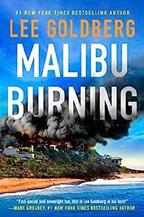
Goldberg, Lee
Thomas & Mercer (304 pp.)
$28.99 | June 20, 2023
9781662500671
Goldberg returns to the wildfire he memorably chronicled in Lost Hills (2020) from a strikingly new angle.
Not many con men are also trained firefighters. But when Danny Cole was convicted of a typically bold con eight years ago after a heroically unselfish act derailed his escape, he volunteered for service as a convict firefighter alongside a crew of other convicts that included car-leasing scammer Arnie Soloway. Arnie’s death fighting a fire around the extravagant home of millionaire Roland Slezak, who leaned on his connections to make sure the blaze spared his home at a high cost to others, has made Danny hunger for vengeance, if possible with substantial financial profits on the side. So he comes up with a staggeringly audacious plan: to persuade underwater real estate developer Levi Brisker, Slezak’s neighbor, to host his surviving cohort while they set a fire that will burn down every home in the area but Brisker’s, whose value will accordingly skyrocket. As Danny methodically lays the groundwork for his coup once he’s released from prison, LA County arson investigator Walter Sharpe and his new deputy, former U.S. Marshal Andrew Walker, who Sharpe aptly says “could make delivering pizzas a high-risk job,” learn of an Icarus drone that’s gone missing from CAL FIRE and trace its theft to Danny. While heroes and villains race against the clock and each other, Goldberg creates such a maelstrom of loyalties that it’s hard to know who to root for. Could Danny possibly get his revenge even while justice is done in a technical sense as well?
A businesslike thriller that shows how rewarding it can be to revisit the same story from a new point of view.

Gray, Anissa Berkley (336 pp.)
$24.30 | April 11, 2023
9781984802460
A Black family in suburban Detroit is torn apart by long-held secrets.
In her sophomore novel, following The Care and Feeding of Ravenously Hungry Girls (2019), Gray again braids the narrative perspectives of three family members—here Daniel Ozro Armstead Jr.; his wife, Deborah; and his daughter, Trinity. Trinity narrates the opening section of the book, which is set at her father’s funeral—though they are burying an empty casket because her father vanished years earlier and his death is only presumed. From there, the sections move back and forth in time to illuminate the situation and its aftermath, from the early 1960s to the early 1990s. Oz, as he was
called, grew up in rural Alabama, but after a fire took his father’s life and burned their house to the ground in 1962, his mother, Pearl, took her two sons and fled to Detroit. Both boys have mysterious scars and keep the full story of what happened from everyone, including the beautiful up-and-coming singer Deborah, whom Oz meets at a rent party. So much hope and promise are vested in Deborah’s career, and in the life she and Oz create for Trinity—but her recording contract never materializes, she turns to alcohol, and their home in an all-White-except-forthem suburb becomes a tense and unhappy place. Gray keeps the narrative interest high by teasing out the mystery of Oz’s disappearance as the family splinters and the story follows them to Chicago, New York, and back to the rural South. Oz, the most complicated character, retains a core of decency even as his mistakes pile up, and Trinity is a snappy smart-mouth— “I, on the other hand, looked like an aging hooker who’d had a particularly bad night”—who injects the story with energy and moments of comic relief.
The trajectory of Gray’s flawed but relatable characters offers hope that even deep, long-festering wounds can heal.

Hadley, Tessa Knopf (240 pp.)
$28.00 | July 11, 2023
9780593536193
Families come in many varieties, all of them equally fraught, in a dozen new stories from British writer Hadley.
Feckless bohemian parents get withering portraits in “My Mother’s Wedding” (not her first, needless to say) and “Funny Little Snake”; the latter is a particularly poignant tale of a neglected 9-year-old girl and a second wife who reluctantly comes to feel responsible for her. These two stories, like many in the collection, stop rather than end with people poised on the brink of change and no guarantees things will turn out well. Hadley’s work, very much in the realistic tradition of classic English fiction, is old-fashioned in the best sense: Characters’ personalities and backstories are fully drawn and set against thickly detailed physical and social surroundings. The childhood home where three middleaged sisters assemble to visit their hospitalized mother in “The Bunty Club” is “a stolid Victorian villa” set on a hillside dotted with houses “intended to accommodate a certain sort of privileged, discreet, unexceptional, unchanging middle-class existence—which had changed after all, because it hardly existed any longer.” Hadley shifts through each of the at-odds sisters’ perspectives, a frequent technique of hers to remind us that people’s inner lives do not necessarily match others’ views of them. This is particularly effective in “Dido’s Lament,” which portrays a chance encounter between a former husband and wife almost entirely from her point of view until the very end, when a glimpse into his thoughts shows that the comfortable, affluent post-divorce existence she has glimpsed with chagrin is
“all so that [she] could get to visit it some day, and see that he’d managed to have a life without her.” The mastery she has honed over a decades-long career makes Hadley’s gaze as sharp as her empathy is expansive; each tale feels as satisfying as a full-length novel despite—or perhaps because of—the ambiguous endings. A pleasure to read, with characters and themes that linger long after the final page.
Hall, Louisa
Ecco/HarperCollins (256 pp.)
$30.00 | June 13, 2023
9780063283626
The author of Trinity (2018) asks what Frankenstein can tell us about motherhood in the 21st century.
“I began work on a novel about Mary Shelley in 2018, when I was pregnant for the first time.” So begins this novel that is—obliquely—about Mary Shelley but is not that novel. If the previous sentence makes you wince or causes your eyes to roll out of your head, you probably will not enjoy the novel that is this novel. Same if you savor plot, action, and a rich cast of fully formed characters. If, however, a semiautobiographical, plainly feminist, sort of science-fiction exploration of what it means to create life sounds intriguing to you, read on. The unnamed narrator of this genre-defying book loses her pregnancy. She also gives up working on her Mary Shelley novel, but she doesn’t stop thinking about Mary Shelley. The earlier writer’s masterpiece and her biography provide a framework that helps the narrator understand both her pregnancy loss and—later in the story—the birth of a daughter. The narrator thinks about Shelley’s experience of loss while trying to make sense of her own. She contrasts her own creation with Victor Frankenstein’s while also comparing herself to Capt. Robert Walton, the Arctic explorer Frankenstein meets while pursuing his creature. This book would be valuable if only for Hall’s phantasmagorical depiction of childbirth and her honesty about how lonely mothering can be. But Hall also situates her story in a world in which gene-editing technology and climate change and global pandemics are real. Like Shelley herself, Hall provides readers a text composed of diverse parts, a text that readers can endlessly take apart and stitch back together to create new ideas.
Body horror and philosophy commingle in this strange, enthralling novel.

“Body horror and philosophy commingle in this strange, enthralling novel.” reproduction

$25.00 | June 27, 2023
9781662601927
Based on the true story of one of America’s first female serial killers, Kielland’s dense, lyrical novel offers both insight and opacity.
In 1876, 17-year-old Brynhild Størset is overwhelmed by her own longings and her religious-induced shame. When she becomes pregnant, an act of violence leads to a miscarriage and, from there, a miserable boat trip from Norway to the United States. She makes her way to the Midwest and moves in with her disapproving sister, Nellie, and her family, even taking a new name: Bella. (Later, she becomes Belle.) Despite the vast landscape, she tries to keep herself small and contained, focusing on her work as a seamstress and faithfully attending church. She longs to be touched, longs for a child of her own, but “it was the same in America as in Norway—it didn’t matter, the world didn’t care about her.” Then she meets Mads Sørensen, and despite his love for her, she finds herself “just waiting for everything else to be taken away, for the invisible betrayal.” Nevertheless, they get married and begin to take in a series of children, many of whom seem to die through some vague failing of Belle’s, who isn’t “a real mother.” When Mads dies suddenly, and suspiciously, Belle and her remaining three children trade their house for a pig farm, which begets a series of men and tragedies. Despite the subject matter, this novel is not your typical thriller. The language, in Searls’ translation, is dense, poetic, and deeply figurative, as demonstrated by the first page: “The words grabbed her by the throat, Belle didn’t know when it was all going to snap, but she knew it would. A bullet, an inverted lung, a postscript to a thousand wars, tears ran down her face.” Belle is unknowable, even by the novel itself, for in the end, this isn’t really a story about a serial killer.
A meditation on female desire, on loneliness, on mental illness.
THE ICE HARP
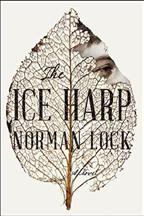
Lock, Norman
Bellevue Literary Press
(240 pp.)
$17.99 paper | July 4, 2023
9781954276178
An aging Ralph Waldo Emerson grapples with an ethical dilemma.
Over the last decade, the stylistic range and subtle connections on display in Lock’s American Novels cycle have afforded many pleasures. This latest installment focuses on Ralph Waldo Emerson, opening two and a half years before his death. He’s showing the effects of dementia—which,
unsettlingly, include a moment in which he doesn’t recognize a passage from one of his own works. Emerson also converses with other people, living and dead, with whom he crossed paths. “I hope Garrison doesn’t take it into his head to visit me. His opinions are fiery, and I dread being scorched,” he thinks at one point. In his introduction, Lock writes that this book “can be thought of as a play for voices”—and an early passage in which Emerson ponders the word spoon suggests, perhaps, a slight influence of Beckett’s Krapp’s Last Tape in the mix. Eventually, Emerson must try to focus on the present moment; he meets James Stokes, a Black soldier who deserted after defending himself from a racist attack and killing another soldier in selfdefense. As in A Fugitive in Walden Woods (2017), Lock explores the gulf between some transcendentalists’ idealism and their reticence to take a stronger moral stance on racism and slavery—and Emerson occasionally muses on Samuel Long, the protagonist of that earlier novel, strengthening the connection between the two books. There’s a profound sadness here, as Emerson muses on his losses, noting that “our bereavements bring us no nearer to God.” And his awareness of his own condition is heartbreaking to ponder: “Soon the universe inside me will slip out like a yolk from an eggshell.”
An elegiac, powerful book about a thinker’s limitations.

MacMillan, Lindsay
Alcove Press (336 pp.)
$17.99 paper | June 6, 2023
9781639102822
A high-flying American management consultant working with a Londonbased oil company develops a crush on a man who rides the top floor of the bus by her home office window.
Kat has dreamed of being a CEO since she was a child, and now that she’s 31, she can feel how close she’s getting. She’s confident that she’ll make partner soon, and after that becoming CEO is just a hop, skip, and a jump away—and then she’ll be able to change the system into one she values. Working a hybrid schedule with a home office that faces the street, she develops a love-at-first-sight crush on a commuter who frequently passes by her window. Her crush knows no bounds, and she develops an entire British backstory for this person. But after she screws up the courage to get on the bus and meet this commuter of her dreams, she finds that instead of being Prince Alexander, as she fantasized, he’s Rory, an American from Kalamazoo, Michigan, just like her. Rory, a teacher, is in love with his hometown ex-girlfriend, who wants him to get a higher paying job and break out of his routine. He’s teaching in London in an attempt to do this, and the pair will reassess their relationship at Christmas. As the story wends its way through Kat and Rory’s friendship and—eventually—burgeoning romance, Kat begins to second-guess the value of being an aspirational businesswoman. Author MacMillan spends much time postulating—through Kat’s thoughts—on theories of love, happiness, motherhood,
you, bleeding childhood
and the importance of a quiet life and a strong nuclear family unit; many readers might find the tone preachy.
An alternate fairy-tale love story in which quiet love and routine are held up as best of all.
Madievsky, Ruth
Catapult (304 pp.)
$27.00 | July 11, 2023
9781646221509
A first novel contemplating sisterhood, drugs, sex, and other disappointments.

Madievsky’s coolly delivered debut has an unnamed narrator—which is fitting, since she often sees herself as a function of those around her. Chief among them is her older sister, Debbie, who introduces her to some of LA’s more dissolute haunts. (Their preferred den is a bar with the ironic name Salvation.) Bad things inevitably ensue for the narrator: opioids, a miscarriage, and a fight that leads to her stabbing Debbie, who soon disappears. But the bulk of the novel deals with her efforts to get clean and reassemble her life in the two years that follow. A job working the late shift at an emergency room help desk puts her own drama in perspective, and it’s where she meets Sasha, a Jewish refugee from Moldova who claims psychic powers (“I’m your amulet”). As their romance blossoms, particularly on a trip to Sasha’s homeland, the narrator begins tangling with her inner demons and (with a peculiar slowness) contemplates searching for Debbie. Early on, Madievsky’s deliberately flat prose and druggy milieu recall Less Than Zero, and at times that Ellis-like emotional distance clangs against the themes of sexual abuse and the Holocaust she introduces. (The narrator has a Russian Jewish background and dwells on a patient suffering from “Shoah grief.”) But ultimately Madievsky captures the mood of a woman working hard to connect with a sense of self, and she has an excellent arsenal of metaphors for disconnection: “The city splayed open like a surgical patient,” “the sky was the hopeful blue of toilet bowl cleaner,” “her love felt like cold hands shaking me awake.”
An assured debut, at once atmospheric and gritty.
Mäkinen, Maija
New American Press (170 pp.)
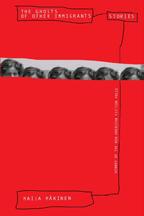
$19.99 paper | June 6, 2023
9781941561294
A story collection that explores belonging, displacement, and the ghosts of immigration.
When an immigrant leaves their country, they must often make many smaller departures: They leave their language, family, friends,
norms, food, and customs along the way to settling in their new home. The stories in this collection orbit these smaller departures. “Monkey Bars,” the first story, is about fourth grader Saila Horsma, whose family has emigrated from Finland to the Washington, D.C., area. It begins with vivid, wonder-filled descriptions of their arrival at Dulles Airport: “A yolk-colored sun simmered in the dirty horizon, slender stretches of cloud, like liquefying pewter, stretched across it.” Lyrical prose can be found throughout the book, but it works especially well here to create a sense of excitement about arriving in a new country. Saila begins school and quickly realizes how different the fashions and cultural norms are from Finland. She takes note and tries her best to fit in, but she has a few mishaps, such as when one of the boys in her class asks her to strip for him and she says she will, not knowing what strip means. Reckoning with belonging is a common struggle of childhood, and it’s also a primary challenge for immigrants, so this story is a perfect opener. The protagonists of the subsequent stories struggle with identity and relationships and embody the complicated nature of being human. Several stories explore love by questioning the ways selfhood can get tangled in relationships. In “P.S. Kate,” Kate realizes that she has been living as an “afterthought” and comes to the realization that “life was uncontrollable but that there was a whole dimension of life that she had no knowledge of, except that it was there.” Funny, bittersweet, and filled with many kinds of longing, these stories show that though we are often defined by relationships to both people and places, we are also capable of defining ourselves on our own terms and that home follows us like a ghost wherever we go.
A subtle and compelling collection with superb prose.

Mari, Michele
Trans. by Brian Robert Moore
And Other Stories (128 pp.)
$17.95 paper | July 11, 2023
9781913505684
Short stories from an Italian maestro finally translated into English.
The son of a domineering industrial designer and a children’s book illustrator, Mari has been compared to Kafka and Borges for his unnerving yet humorous excavations of the psyche in which the pulpy influence of speculative fiction and pop art surfaces and glistens. In “Comic Strips,” an unnamed academic launches into a nostalgia-fueled frenzy upon learning of his impending fatherhood, and he rankles at the thought of what he assumes will be his unborn offspring’s lack of interest in his collection of comic books, ascribing to his future child “the adiaphorous passivity of the profaner.” Intergenerational conflict often serves as connective tissue between the loosely interlinked stories, as when one title from the professor’s shelves—the Italian SF magazine Urania—reappears in “The Covers of Urania,” a love letter to the fantastical monsters on each issue’s cover (“furry, slobbery,
“Amusing, disturbing, intoxicating tales of childhood terrors and obsessions.”
slimy, flaming, ungulate, bituminous, lobated, crested, gaseous, glutinous”), and we learn that the academic inherited the glossy comics from his grandfather. Originally published in Italian in the mid-1990s, Mari’s depictions of school violence will ring differently for American readers mired in an era of mass shootings. In “They Shot Me and I’m Dead,” the use of second person narration drives home a sickeningly familiar feeling: “a gloomy hatred for all your classmates would take hold of you; envisioning for them a thousand different deaths….” But the story spins into the surreal as the narrator imagines a bullet circumnavigating the planet, piercing even “the wood of trees, the brick and the cement of houses, the iron of beams, the ice of cliffs,” before seeking out its intended target. Freud would have a field day unpacking the many neuroses bundled up in Mari’s stories. Readers will, as well.
Amusing, disturbing, intoxicating tales of childhood terrors and obsessions.
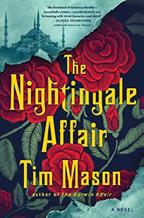
Mason, Tim Algonquin (400 pp.)
$28.00 | May 9, 2023
9781643750392
The second historical mystery featuring former chief detective inspector Charles Fields revolves around the heroic work of Florence Nightingale.
In The Darwin Affair (2019), Mason introduced readers to a fictional London detective who was the inspiration for the intrepid Inspector Bucket in Charles Dickens’ Bleak House—indeed, Dickens appeared as a character. Fields returns in this book, set in 1867, no longer a member of the Metropolitan Police but working as a private detective. He’s been hired “by a member of Parliament who harbored misgivings concerning his much younger wife,” and Fields quickly determines she seems to be having an affair with a politician of the opposition party. But Fields’ surveillance leads to his discovering her body after she’s been strangled. The most disturbing detail for him is a scrap of cloth, embroidered with a rose, left inside her mouth. He’s seen such scraps before, several of them, when he was dispatched in 1855 to Crimea to investigate a series of attacks on the nurses working there under the command of the famous, fearless Florence Nightingale. Although the wounded troops revere them for their loving care, the “medical men and the military brass had no time for Nightingale or her women.” When those women start to die, Fields’ pursuit turns urgent, and he returns to London only after the man responsible is dead. Or so he thought. Now, 12 years later, women are dying again just as the issue of women’s suffrage heats up. His experience in Crimea has had lasting effects on him, not least of which is his marriage to Jane Rolly, one of Nightingale’s nurses, but now it all comes rushing back. The book’s first part, set mainly in Crimea, is compelling, in part because Nightingale herself is a fascinating character. The later section is not quite as absorbing, largely because Nightingale
fades into the background as Fields chases both the killer and the connection between the two sets of crimes. It does boast a blockbuster ending in subterranean London, rich historical detail, and a cast of real characters, from Benjamin Disraeli to Dickens himself.
A killer who once stalked Florence Nightingale’s nurses seems to be resurrected in this satisfying thriller.
McLaughlin, James A. Flatiron Books (368 pp.)
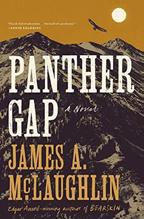
$28.99 | April 4, 2023
9781250821003
A fractured family, secrets, and a big bag of cocaine lead to short, sharp violence in the Colorado wilderness. This follow-up to Bearskin (2018) is marked by many of the same traits that made McLaughlin’s Edgar Award–winning debut so rewarding, not least the spare, menacing prose depicting a man seeking redemption in isolation. But while the two books’ mechanics are similar, the idiosyncrasies of the heroes here don’t inspire much sympathy, and the deus ex machina acrobatics setting events in motion fray the book’s credibility. The heart of the story lies in two siblings, dissimilar as oil and water yet inextricably tied together. Summer Girard is the reasonable, responsible one who, along with uncles Jeremy and Darwin, is holding down the fort on a struggling cattle ranch near Durango, Colorado. Her brother, Bowman, is a whole other animal, a near-feral drifter whose notions of his one-quarter Native American heritage (“tribe unknown”) combined with nerve damage from exposure to fish toxins have left him paranoid and troubled. Two precipitating events harden Summer’s resolve to keep her ranch and bring Bowman out from where he’s hiding in Costa Rica. First, road-tripping lawyer Sam Hay and his pal Mac realize that Melissa, the young woman they picked up in a cafe, might land them in big trouble with a Mexican cartel over the large backpack full of coke she claims to have stolen from her boyfriend. Simultaneously, Summer discovers that her grandfather Martin has left her and Bowman a secret stash of money they can only claim together at a bank in Denver. While Summer reluctantly agrees to protect Sam when she finds him looking for water on her land, having been deserted by Mac and Melissa, a mobster colleague of her grandfather’s named Jake Salifano gets word of her inheritance and dispatches a violent, armed prison gang to take back his ill-gotten gains. Stylistically, McLaughlin’s novels recall Taylor Sheridan’s films, most notably Wind River and his adaptation of Michael Koryta’s Those Who Wish Me Dead. The prose and the setting remain arthouse cool, but the triggering menace and nominal twists are strictly B-movie material.
Breathtaking vistas and hallucinatory visions weighed down by pedestrian villainy and narrative expediency.
Mendelson, Charlotte
St. Martin’s (304 pp.)
$29.00 | July 4, 2023
9781250286932
For the suffering members of an English family crushed by its artist patriarch, a weekend of so-called celebration leads to implosion.
Ray Hanrahan is a monster, “a oneman chorus of contempt” whose withering criticism and ceaseless manipulation of his wife, Lucia, and younger daughter, Jess, have caused the first to self-sabotage and the second to flee London for a teaching career in Scotland. Originally her tutor, Ray used to nurture Lucia’s artistic gifts, but he has become so jealous of her success that she, drowning in loyalty, must dodge the limelight in order to keep the domestic peace. Ray and Lucia’s other daughter—32-year-old Leah, who’s never had a boyfriend and still lives at home—has created a comparatively safe space by devoting her life to her father’s needs and wishes. Now the family is preparing for an important event: Ray’s first solo art show since the mid-1990s, which he hopes will rekindle his fading reputation. Meanwhile, stable things are shifting. Lucia is “stupid with lust” for a woman she met at a party, and her gallerist is trying to reach her with important news. Both Jess and Leah have secrets of their own, and so does Patrick, Lucia’s first child, Ray’s stepson and another lacerated victim of his heedless disdain. Mendelson stuffs every page of her three-day-long comic parable of dysfunction with a high pitch of discomfort, squirms, plots, and wounds while delineating her characters—especially the toweringly horrible yet compelling Ray—with a broad brush. The repetitive dilemmas and submission of those surrounding Ray will be a test of some readers’ patience, or perhaps a cause of sympathy if the characters are viewed as in thrall to their emotional abuser. The writing sparkles with perfectly judged perceptions, but by the novel’s conclusion its rigid structure and underlining can seem oppressive.
A relentless black comedy, excellently phrased but formally frustrating.
Myers, Kate HarperVia (288 pp.)
$27.99 | July 4, 2023
9780063304512
Myers’ lively comic novel focuses on the raw passions of four women, not for men or each other—well, maybe those too—but mostly for the physical experience of archaeology, the grueling grunt work of a hot summer dig.
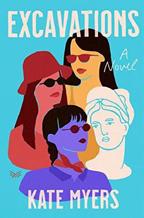
The dig in question takes place in Greece under the auspices of autocratic Dr. Charles Barton, from an unnamed

university. Zara, Kara, Elise, and Patty arrive with different skills and expectations. Patty, a clueless undergraduate intern who knows nothing about archaeology, has become Barton’s spy and general whipping girl. Zara had a wonderful experience in Greece as an undergrad on the dig six years ago until she broke up with her grad student boyfriend, Gary, now a committed archaeologist. She’s drifted through various botched jobs and boyfriends ever since. Aware that Gary will be there, she joins this year’s dig on a desperate whim. But Gary is engaged to ambitious, high-strung perfectionist Kara, who was also on Zara’s first dig and now runs the site lab; she’s worried that her goal of a job at Sotheby’s could be derailed if she doesn’t find two missing discuses for which she’s responsible. Eccentric, independent 44-year-old Elise lacks academic credentials but is highly respected as an adept professional excavator. She and Kara blame each other for a loss suffered several years earlier, a small but valuable statue Elise found and Kara restored before it was supposedly destroyed by an earthquake. Is there a connection between the discuses and the statue? Maybe. Myers gives the angst-ridden, imperfect women entertainingly distinct voices and personalities. The men are fun too, both the appealing ones and the creeps. (And then there’s the voice of the buried.) Desires collide and relationships realign rapidly as the dig begins to go awry. Myers is adept at academic satire with a feminist bent and at unsentimental romance, but she really shines at bringing to life a working excavation: the smells, the grime, the exhaustion. And the exhilaration.
Fresh, funny, intelligent, and deeply satisfying.
Penney, Stef Pegasus (352 pp.)
$26.95 | July 4, 2023
9781639363766
“War showed you who people really were,” Penney says.
Penney, whose detailed and evocative novels have been set in such inhospitable places as the Arctic Circle, places her current saga in what might, initially, seem to be a more pleasant location: Paris. There, the lives of the working class and the bourgeoisie alike are unsettled by the onset of the Franco-Prussian War in 1870. The horrors of war continue even after a peace treaty is signed, as former members of the National Guard take control of Paris and run it as a revolutionary Commune. The end days of the failing Commune are marked by violence and acts of war committed upon French people by their fellow citizens. Caught up in the violence and mayhem are the well-drawn characters of Penney’s sprawling chronicle of love, loss, and self-discovery. Two young gay men—a Canadian and an American—seek love and recognition amid the carnage. A young woman of Haitian heritage combats the effects of abuse and marginalization in her painstaking journey to self-determination. Personal relationships create bonds across the class boundary dividing a housemaid

“Fresh, funny, intelligent, and deeply satisfying.” excavations
and her mistress. As the intense human drama unfolds, Penney illuminates a parallel civilization living within the embattled city walls: that of the animals of the zoo within the Jardin des Plantes. The fates of many of the creatures are distressing, but others serve as emblems of survival in a city wracked by violence motivated by politics far removed from the majesty of those residents of the fauverie. (The character of the zoo’s primary veterinarian is the subject of some moral scrutiny as well.) The real beasts of Penney’s gripping account may actually reside in apartment buildings.
Penney’s portrait of a city in flames honors the traditions of historical fiction while realistically enlivening the genre.
Raimo, Veronica
Trans. by Leah Janeczko
Black Cat/Grove (224 pp.)
$18.00 paper | June 27, 2023 9780802162045
A coming-of-age story set in Italy and filled with humor and neuroses. When Veronica falls ill with rheumatic fever as a child, her father—whose pastimes include building walls in their apartment, worrying about radiation, and yelling—is overjoyed that someone in their family is actually sick and wraps Vero in paper towels because he’s convinced that sweating will harm her. Later, Vero’s mother, not to be outdone in an unspoken competition of maladjusted parenting, calls Vero on the phone several times a month to say that her brother, Christian, has died, all because he didn’t immediately respond to his mother’s texts. Vero’s childhood and adulthood are on full display in this novel, as we are invited into her home to witness the absurd, the loving, and the traumatic. She navigates an isolated childhood during which she and Christian watch children play in the courtyard below their apartment but are not allowed by their parents to join in. (In one particularly distressing yet absurd moment, they witness the neighborhood children playing soccer using a toad in lieu of a ball.) There is also Vero’s adolescence, full of first loves, best friends, and familial abuse, and an adulthood spent trying to reconcile it all through her writing. Raimo weaves together a series of nonlinear vignettes with a deft hand, connecting seemingly disparate moments through themes of longing, loneliness, identity, and, perhaps most profoundly, the concept of memory itself: “But how can you reconcile with something or someone if your memories are hazy? If they change in the very process of forming? They can take away everything but our memories, people say. But who would ever be interested in that kind of expropriation?”
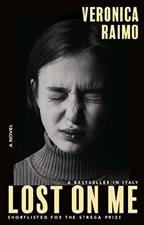
A witty and complex portrait of a woman becoming herself.
Ridker, Andrew Viking (432 pp.)

$28.00 | July 11, 2023
9780593493335
Over the course of a year, an affluent Jewish family implodes.
When Scott Greenspan, a cardiologist overseeing a clinical trial, starts falsifying blood samples, his intentions are more or less (rather less) innocent. He’s just lost a lot of money on an investment he kept secret from his wife, and in the meantime, he needs to make a payment on his mother’s expensive retirement home. Scott’s “whole life,” Ridker writes, “he’d been climbing a ladder to respectable living…. He’d proceeded with caution, taking the slow route, secure in the knowledge that the world would reward his patience as it had rewarded his hard work and intellect.” The ease with which he can cheat comes as a revelation. Scott is caught, of course, and the repercussions of his actions, for himself and his entire family, inform Ridker’s engaging but uneven novel. In alternating chapters, Ridker visits each family member, including Scott’s wife, Deb, who has suggested that the two open their marriage; Maya, their daughter, who works an entry-level position at a prestigious publishing company; and Gideon, their son, who had planned on applying to medical school but now, in the wake of his father’s misconduct, flails about, uncertain how to proceed. Ridker clearly owes a debt to Jonathan Franzen, whose influence is plain. But each of Ridker’s points of satire—busybody suburban housewives, predatory high school teachers, the publishing industry as a whole—is too predictably on-the-nose to be funny or surprising or fresh. Sometimes the satire veers into the slapstick. At one point, for example, a housewife on one of Deb’s many volunteer committees says, “We have a protocol for this.” She goes on, “But I can’t remember what it is.” And while Scott and Gideon feel more or less like full-fledged characters, Deb and Maya most assuredly do not.
The novel covers well-traveled terrain with few surprises.
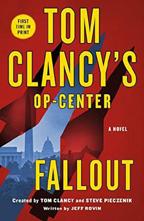
Rovin, Jeff
St. Martin’s Griffin (336 pp.)
$19.00 paper | May 30, 2023
9781250868725
America’s relations with China get testy in the Tom Clancy industry’s 22nd Op-Center thriller.
Sen. Yvonne Malo and three fellow astronauts circle the Earth in the Phoenix One until suddenly everything goes wrong. They lose all power and communications, the vehicle burns, and they all die. China has fired the first shot in what could be a war in space. It doesn’t take long for Americans to figure out that the Chinese have
sabotaged Phoenix One in retaliation for the American abduction of a Chinese engineer who was working on a hypersonic missile program. Now President John Wright looks for a way to retaliate without escalating too far. This calls for the OpCenter, a strike force that takes on highly secretive missions for the president of the United States. China wants their man back, and they demand that Adm. Chase Williams make the delivery. Hmm, that sounds suspicious. Yes, they kidnap him to use him as bait to destroy Black Wasp, a subgroup of five members of Op-Center that does tough, on-the-ground dirty work at the behest of the president. As with all the novels that are part of the Op-Center formula, this one is filled with well-plotted action and strong characters. In captivity, Adm. Williams does himself credit as an American citizen, but can Black Wasp rescue him? Or will the Chinese destroy them all? When a Black Wasp suffers a heavy personal loss, readers might expect a greater showing of grief. Yet amid all the violence and turmoil, there is an unexpected grace note at the end. The writing style has not changed since The Hunt for Red October—eminently readable and enjoyable but with no memorable dialogue. More importantly, this story reflects America’s ongoing struggle to maintain its place in the world and China’s ongoing effort to surpass us. It’s a world where the U.S. is imperfect but essentially just, no victory is ever complete, and the sequels keep coming.
Op-Center fans will find this a worthy entry in the series.

Rudnick, Paul Atria (368 pp.)
$28.99 | June 6, 2023
9781668004678
A gay love story for the ages from one of the great comic voices of his generation.
Known for his plays; screenplays; adult and YA novels; and film criticism written under the pseudonym Libby Gelman-Waxner, Rudnick is famously unable to write a single sentence that isn’t funny. His latest work, a novel tracing a gay love affair from the 1970s to the near present, features a narrator very close to the author. Nate Reminger, a gay Jewish kid from Piscataway, New Jersey, goes to Yale, writes a play about AIDS (in real life, Rudnick’s Jeffrey) and a movie about nuns (in real life, Sister Act), and bears witness to the devastation wreaked by AIDS on his generation. As Rudnick puts it in the acknowledgments, “This book was written after I’d lived a good long time, and wanted to at least begin to make sense of things.” He also makes clear that the title character, Farrell Covington, is a creation of his imagination, based on a fleeting encounter on a train many years ago. And what a creation he is. Scion of the third richest family in America, his voice is “maddeningly but somehow naturally affected, as if the person had been raised by a bottle of good whiskey and a crystal chandelier.” His “lush, dewy handsomeness” is such that it disconcerts
“everyone, even himself.” And yet, soon enough, he appears in Nate’s dorm room, making an announcement: “We’re about to sodomize one another….Does anyone have a manual, or perhaps a brief educational film, with puppets, to help us go about this?” Magic ensues. But just when Nate is getting used to living in la-la land as Farrell’s consort, the evil and deeply homophobic Covington paterfamilias appears from Wichita to shatter his bliss. This is not the end of the relationship but the beginning of the war, as every possible opponent to gay conjugal happiness takes its turn with the couple over a 50-year swath of the American cultural landscape.
Is it a spoiler to say there are no limits? At least not to Rudnick’s ability to brilliantly elegize and entertain.

Sibhat, Mihret
Viking (400 pp.)
$28.00 | June 27, 2023
9780593298619
In Ethiopian writer Sibhat’s debut novel, a young girl chronicles civil war and ethnic division in the 1980s.
Selam Asmelash comes into the world with what, says a sister, is “a very large, abnormally sized head.” Her father asks what’s the matter with that, and the sibling, as if a sibyl, replies, “You’ll see.” Selam’s appearance will later prove a cause for schoolyard bullying, but for the moment, thoughtful beyond her years, she decides on a couple of things: She’s not going to walk until she’s good and ready, and she’s not going to be fooled by political rhetoric, as when, still a toddler, she proclaims of the new constitutional freedoms “Comrade Chairman” promises over the radio, “Liar.” Selam is not the only one resisting the alternate realities the regime promotes: Her grandmother, for example, holds up a black bar of soap sold in a government shop and demands of the dictator in faraway Addis Ababa, “He needs to tell us whether this is really soap or his shit in a package!” Selam, the conscience of the tale, finds her bête noire in, appropriately enough, a government functionary whom she calls RectangleHead, but there are other foes: the villagers who throw rocks at their house because her family is Protestant; the rebel army that arrives during an uprising against the regime, so quick to commit atrocities that, says Selam, “I am terrified of them even more than I used to be of comrade Rectangle-Head, whom I don’t even think about anymore.” Long since fully ambulatory, Selam, in Sibhat’s touching conclusion, puts aside these murderous squabbles of adults as the childish things they are and decides instead that she’s going to be a star soccer striker, scoring goals for all the dead of her family and village and even one for God, “the madman who created so much chaos while desperate to escape aloneness.”
A moving evocation of life in a time of terror, as seen through innocent eyes.
“A gay love story for the ages from one of the great comic voices of his generation.”
farrell covington and the limits of style
Smith, Martin Cruz

Simon & Schuster (272 pp.)
$26.99 | May 9, 2023
9781982188306
Moscow police detective Arkady Renko takes on dangerous challenges on the eve of the Russian invasion of Ukraine.
An acquaintance asks Renko to find his adult daughter Karina Abakova, who has “disappeared down a rabbit hole,” and Renko says he will search for her for no pay. Karina’s interests are music and politics, specifically the anti-government Forum for Democracy. The latter passion seems unwise, as “politics in Russia was for the corrupt, the brave, and the foolish.” Then an acquaintance of Renko’s is killed before they can meet, and the detective is assigned to find the man’s killer. Maybe a connection exists between Karina’s disappearance and the murder, which is the first of several. Meanwhile, long-time Renko readers will recall his lover Tatiana Petrovna, who had left him, saying he lacked ambition. And now he’s begun to show the classic signs of Parkinson’s disease. With Tatiana out of his life and him having an incurable disease, he wonders if life is worth living. Still, he carries on with what becomes two murder cases and a missing person case. One trail leads to Independence Square in Kyiv as Russia appears on the brink of launching an invasion. He crosses paths again with Tatiana, now a New York Times correspondent covering developments in Ukraine. Independence Square plays less of a role in the story than the title might suggest, with plenty of space going to Moscow and Crimea—Renko is a Moscow cop, after all. There are fascinating insights into the Russian character: “No one was better than a Russian at having a superiority complex and an inferiority complex at the same time,” and “Beer didn’t really count as alcohol in a country where men drank vodka and real men drank brake fluid.” (Oh, that can’t be true!) And yet there is sympathy, as a character laments the demise of the Soviet Union, saying “We lost everything we had for bubble gum and jeans.”
Solid sleuthing by Arkady Renko and a good read for his fans.
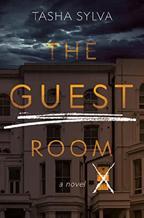
Sylva, Tasha
Henry Holt (368 pp.)
$28.99 | July 11, 2023
9781250863959
Grief complicates everything for the protagonist of this psychological thriller.
Tess, still wracked with grief over the recent unsolved murder of her sister, Rosie, moves into Rosie’s apartment and starts renting her sister’s old room for short-term stays when she realizes she’ll need help paying the
mortgage. As Tess becomes more isolated from the people and activities of her old life, she develops an increasing compulsion to snoop through her guests’ possessions. The arrival of Arran, an enigmatic (and nice-looking) longer-term boarder, adds fuel to the already raging fire of Tess’ jumbled emotions and thoughts about Rosie’s death. Stymied in her efforts to find out who killed Rosie and why, Tess continues her risky nighttime solo forays into parks in order to root out predators as well as her closer-to-home explorations of duffel bags and backpacks in the guest room. Tess’ discovery of Arran’s diary—which contains entries that might signal an obsession with Tess herself— leads her to follow Arran (and others) all over London in a series of surveillance missions driven more by passion than reason. Tess’ desperation to achieve some sort of understanding of the circumstances of Rosie’s death drives her to suspect more than one character (while failing to consider some others). Sylva skillfully illustrates an unmoored character completely consumed by a spiraling, unrelenting grief in a setting where others continue their lives as usual. Moody and proceeding at a measured pace, Tess’ narrative slowly unfolds toward a cinematic resolution. Interspersed with passages from Arran’s diary entries as well as anonymous text of a more ominous nature, Tess’ story elucidates the fog of grief as well as the tendency of the human heart to see what it wants to see.
A slow burn of a psychological thriller wrapped up in mysterious ambiguity.
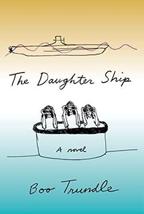
Trundle, Boo
Pantheon (288 pp.)
$27.00 | June 27, 2023
9780593317297
A variety of narrators—including three children who live on a submarine— tell the story of one woman’s claustrophobic domestic life.
How many points of view narrate the story of Katherine, a mother of two in recovery, depends on how many selves you think the average person contains. Are we a composite of our past selves and our present self? Are we a compendium of all the different facets of our personality? Are we our ancestors, strands of whose DNA chaotically combine to form us as individuals? Are we all, really, several personalities living together on a submarine under the water of a dirty lake in Virginia? This latter forms the premise of Trundle’s unruly and experimental debut. The protagonist, Katherine, is entangled in a problematic marriage and feels her mental health rapidly fraying. There is also Katherine’s child self, nicknamed Katchie, who grows up in Virginia Beach with a falling-apart mother, a racist grandmother, and an ominous father. Inside the submarine, there are three presences: Star, a sex-obsessed teen; Smooshed Bug, an 8-year-old girl; and Truitt, a young boy who identifies with Katherine’s father. There are all the dead relatives, descended from a Confederate general in Katherine’s family tree. And there’s Dead Girl herself, keeper
of Katherine’s most shocking secrets. Told in rapidly cycling vignettes like TV channels continually being flipped through, the novel is, at its core, about the trauma of growing up in a dysfunctional family and the way trauma and mental illness can fracture a psyche. (A family is a circuit, says one narrator. “A family is a haunting.”) Despite this dire description, though, Trundle’s book is as cheekily humorous as it is deadly serious, a chaotic performance art piece wearing a novel as a disguise.
A wildly strange reading experience that disorients and exhilarates in equal measure.
Tsukiyama, Gail
HarperVia (352 pp.)
$32.00 | June 20, 2023
9780063213753
A pioneering Chinese American actress reflects on her life in Hollywood and the prejudice she faced throughout her career in this biofiction.

As a child coming of age in early-20thcentury Los Angeles, Anna May Wong longed to be an actress—and she made it happen. This would have been unimaginable if it weren’t true, considering that Wong rose to fame in an era of the Chinese Exclusion Act, antimiscegenation laws, and morality codes in the United States. As the book begins, Wong is traveling by train from California to New York in 1960, near the end of her life, and she’s reading over three notebooks in which she’s chronicled her stardom, dazzling social life, complicated family life, activism, and struggles with racism, misogyny, alcohol, and health. There’s no doubt that the breadth of Wong’s life is worthy of artistic treatment, and she’s inspired many Asian American writers, including novelist Peter Ho Davies and poet Sally Wen Mao. The U.S. Mint released an Anna May Wong quarter in 2022. Tsukiyama presents Wong as a complex, savvy, iconoclastic artist caught between cultures as she surfs the tides of history. The novel demonstrates how Wong courageously weathered the industry’s transition from silent films to talkies to the advent of television as well as her tumultuous times, from the Roaring ’20s through the aftermath of World War II. She had fascinating friendships with the likes of Josephine Baker and Marlene Dietrich and experiences working across America, Europe, and Asia. But in offering so much painstaking, historically accurate detail, Tsukiyama sacrifices story. For readers familiar with Wong’s biography, the book reads too much like an elevated Wikipedia entry. Swaths of the novel are repetitive, summarizing previous events as if they were weekly series recaps or emphasizing Wong’s struggles as a third-generation Chinese American woman without imagining any more of her internal landscape.
This sympathetic account of a silver-screen legend flies admirably between triumph and tragedy but struggles to soar.

Urrea, Luis Alberto Little, Brown (416 pp.)
$29.00 | May 30, 2023
9780316265850
Two women witness the horrors of World War II via a snack truck.
Pulitzer Prize and NBCC Award finalist Urrea’s remarkable, elegantly written novel focuses on the Red Cross’ little-known Clubmobile Corps, which during World War II was charged with bringing coffee, doughnuts, and good company to weary GIs. The women had no medical training and were often condescended to as “Donut Dollies,” but because they were stationed in the heart of battle, they played no small part in improving morale and required a steely resolve of their own. Irene Woodward, who’s escaped New York and an abusive fiance, and Dorothy Dunford, who’s left her family and failing farm in Indiana, are paired together in a massive truck that, across the novel, heads from England to France and Germany in 1944 and 1945. En route, they witness some of the worst the post–D-Day European theater has to offer, from bombs to snipers to death camps; during lulls, the two fend off their share of harassment as well. (It’s all a recipe for PTSD and overwhelming for many; the Clubmobile was designed to be operated by three women, but so many drop out there’s a running gag about an unnamed “Third Girl in the Truck.”) Irene, artsy and romantic, has an opposites-attract rapport with the no-nonsense Dorothy, which Urrea plays for both humor and pathos, but he stresses how unified they are in absorbing the constant surprises and tragedies of warfare; a sunny retreat to Cannes is followed by a trek to Buchenwald. This material is personal for Urrea, whose mother served in the Clubmobile Corps, and a few sentimental notes slip into the story. But there’s plenty of grit, detail, and twists that make for both a fine page-turner and an evocation of war’s often cruel randomness.
Top-shelf historical fiction delivered with wit and compassion.
Von Doviak, Scott
Hard Case Crime (352 pp.)
$9.99 paper | July 11, 2023
9781803361420
In 1974, a pair of Texas cousins embark on a felonious road trip guaranteed to force them into contact with endless lowlifes even more unscrupulous than them.
Six months out of prison, Chuck Melville steals his cousin Dean’s Dodge Challenger, comes on to bad girl Gwen Harlan at a local bar, and suddenly finds himself fleeing a murder charge. Naturally, he

“Top-shelf historical fiction delivered with wit and compassion.”
good night, irene
stops long enough to pick up Dean, whose best chance of paying salvage yard owner Antoine Lynch the money he owes him vanished along with his car. But there’s another possibility, though it’s something of a long shot: The two can heist some hefty bricks of marijuana Antoine’s planning to sell, drive them to Snake River Canyon, Idaho, where daredevil biker Evel Knievel has announced his latest stunt, and arrange through Chuck’s prison buddy Double H (now Triple H) Hendricks, to retail them through Bob Dillon, Knievel’s events manager, to the crowds assembled at this “redneck Woodstock.” The cousins are soon pursued by Antoine, Ivor County Sheriff Bud Giddings, and Uptown Mike, who just happened to be in the wrong place at the wrong time when Chuck polished off a 72-ounce steak. As the feckless crooks and the nemeses on their tails make their way through New Mexico, Colorado, and Utah, Von Doviak keeps things equally shaggy and pulpy by constantly bringing Chuck and Dean up against new waves of largely unconnected miscreants determined to force them into further criminal enterprises, fleece them, kill them, or sometimes all three.
A wild ride that can’t end well for anyone but readers whose nostalgia includes a hearty appetite for violence.
Whitehead, Colson
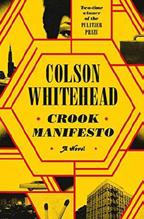
Doubleday (336 pp.)
$30.00 | July 18, 2023
9780385545150
Two-time Pulitzer Prize winner Whitehead continues his boisterous, incisive saga of late-20th-century Harlem and of a furniture dealer barely keeping his criminal side at bay.
The adventures of entrepreneur, family man, and sometime fence Ray Carney, which began with Harlem Shuffle (2021), are carried from the Black Citadel’s harried-but-hopeful 1960s of that book to the dismal-and-divided ’70s shown here. In the first of three parts, it’s 1971, and Carney’s business is growing even amid the city’s Nixon-era doldrums and the rise of warring militant groups like the Black Panthers and the Black Liberation Army. Carney barely thinks about sliding back into his more illicit vocation until his teenage daughter, May, starts hankering to see the Jackson 5 perform at Madison Square Garden. And so he decides to look up an old contact named Munson, a seriously bent White NYPD officer and “accomplished fixer,” who agrees to get free “up close” seats for the concert if Carney will fence stolen jewelry stuffed in a paper bag. But the job carries far more physical peril than advertised, culminating in a long night’s journey into day with Carney getting beaten, robbed, and strong-armed into becoming Munson’s reluctant, mostly passive partner in the cop’s wanton rampage throughout the city. In the second part, it’s 1973, and Pepper, Carney’s strong, silent confidant and all-purpose tough guy, is recruited to work security on the set of a blaxploitation epic whose female lead inexplicably goes missing. The third and final part takes place in the bicentennial year of 1976, the nadir of the
city’s fiscal crisis, marked by widespread fires in vacant buildings in Harlem and elsewhere in New York’s poorer neighborhoods. When an 11-year-old boy is seriously injured by a seemingly random firebombing, Carney is moved to ask himself, “What kind of man torches a building with people inside?” He resolves to find out with Pepper’s help. What recurs in each of these episodes are vivid depictions of hustlers of varied races and social strata, whether old-hand thieves, crass showbiz types, remorseless killers, or slick politicians on the make with the business elite. Whitehead’s gift for sudden, often grotesque eruptions of violence is omnipresent, so much so that you almost feel squeamish to recognize this book for the accomplished, streamlined, and darkly funny comedy of manners it is. If its spirits aren’t quite as buoyant as those of Harlem Shuffle, it’s because the era it chronicles was depressed in more ways than one. Assuming Whitehead continues chronicling Ray Carney’s life and times, things should perk up, or amp up, for the 1980s.
It’s not just crime fiction at its craftiest, but shrewdly rendered social history.
Williams, Beatriz
Morrow/HarperCollins (368 pp.)
$30.00 | June 27, 2023
9780063020849
Shortly after World War II, a young woman falls for the prized son of a wealthy family and finds herself caught in a web of international espionage.
The book opens in 1954 as Emilia Winthrop, a professor at Wellesley College, receives a phone call from her aunt informing her that the Peabodys are returning to Winthrop Island to restore their summer home. Summerly hasn’t been used since just after the war, and the return of this prominent family raises many questions. The book then shifts to 1946, back when Emilia still lived on Winthrop Island. Though the island bears her family’s name, the Winthrops sold their land generations earlier, and they have since acted as hired help for the wealthy vacationers who use the place as a summer playground. Emilia reconnects with Shep Peabody, her best childhood friend, who has returned from the war a hero. As they get to know each other all over again, Emilia wonders if she and Shep could be more than just friends, though she worries their family backgrounds are simply too different. Meanwhile, Shep’s cosmopolitan and mysterious Aunt Olive has just arrived on the island, bringing along her high fashion and tales of Europe during the war. While Emilia revels in Olive’s worldliness and sophistication, others on the island begin to grow suspicious of the long-lost aunt and her unusual behaviors. As the accusations against Olive grow increasingly serious, Emilia is forced to defend her new friend against allegations of disloyalty to the U.S., even whispers of treason and spying. As tensions continue to build, Emilia wonders whether Olive’s presence on Winthrop might destroy her budding relationship with Shep, or worse. When the story shifts back to 1954, an
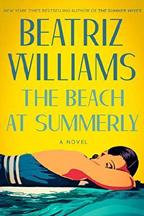
“It’s not just crime fiction at its craftiest, but shrewdly rendered social history.”
crook manifesto
older Emilia must confront the memories of that fateful summer and ask herself if she can claim the life she’s always wanted. With a narrative that starts in the middle and jumps frequently between timelines, Williams’ novel requires patience as readers get the lay of the land. Once the plotlines become clearer, suspense builds, and the novel becomes entirely engaging. Full of evocative, whip-sharp dialogue, the book shines especially in its description of fictional Winthrop Island, a New England vacation enclave something like Nantucket but with idiosyncrasies and traditions all its own. As the characters struggle to regain their footing after the war, there are moments when excessive description and lengthy backstory get in the way of the plot. Even so, the author’s deft exploration of many thought-provoking issues, from social class to personal responsibility and regret, make this one a winner.
A well-researched exploration of love and redemption against the backdrop of post–World War II New England.
Willis, Deborah Norton (336 pp.)

$28.00 | June 13, 2023
9780393285918
Amber Kivinen is going to Mars! She just has to win a game show first.
Amber and Kevin Watkins have known each other since second grade and have been going out since they were 17. When they left their hometown of Thunder Bay, Ontario, to move to Vancouver, it was supposed to be for brighter horizons—an escape from their oppressive home lives and a chance to pursue their dreams. Ten years later, those dreams seem to have stalled out. Kevin’s ambition to be a screenwriter only lasted one semester in film school, and in spite of her master’s degree in environmental science, Amber is working as a receptionist. To supplement their incomes Amber and Kevin also run a small-scale hydroponic marijuana farm out of their basement apartment and, inevitably, partake fairly heavily of their product. For Kevin this life seems an ideal fit; he is perfectly content to go nowhere as long as he and Amber are “going nowhere together.” Amber, however, who was on track to become an Olympic gymnast before a shoulder injury sidelined her, has nowhere to channel the energy that propelled her to athletic greatness except into a cycle of self-destructive flirtations. That is, until she hears about the MarsNow mission and the attendant game show, a “Survivor-meets-StarTrek amalgam,” in which the two winners—one man and one woman— will receive one-way tickets to Mars as the first Marsonauts in billionaire tech guru Geoff Task’s settlement. Seemingly against all odds, Amber is chosen to appear on the show; then, as 12 grueling weeks of challenges winnow down the competitors, it becomes a real possibility that she might win, leaving Earth, and Kevin, behind forever. Part disaffected-slacker rom-com, part social satire, part wistful end-of-the-world eulogy for ordinary, unscripted love, this novel veers close to the kind of wearying
cynicism and late-stage capitalist master-villainy that would make its conceit feel familiar. Yet again and again the novel saves itself from this fate by the very real hope at the heart of its main characters’ binary orbit around each other—that love may be enough after all; if not to save them, then at least to make sure they will not be forgotten.
Winsome, sweet, and apocalyptic—a perfect blend for the end of days.
Yan Ge Scribner (304 pp.)
$18.00 paper | July 11, 2023
9781982198480
“Elsewhere” is a fitting description of this literary buffet of a short story collection.

These tales are set across multiple countries and centuries. To give an idea of the range on display, the collection’s two best stories follow a woman falling in love with the Facebook page of a recently deceased stranger and a political plot among the disciples of Confucius. Even more impressively, Yan writes across styles to best serve each story. “Stockholm,” a story about a literary conference, borrows from the blunt confessionalism of autofiction; meanwhile, the protagonist of “Free Wandering,” a story about being overwhelmed by New York, is a direct descendant of Dostoevsky’s Underground Man. This book is Yan’s first to be written in English, and language is a major theme throughout. At a meeting of the Foreign Movies No Subtitles group in “How I Fell in Love With the Well-Documented Life of Alex Whelan,” members debate the plot of a movie in a language they don’t understand. In “Mother Tongue,” a couple of Chinese poets commit to surrounding their new baby only with English. But at 6 months old, the baby can speak only nonsense words, and it’s unclear if the experiment is working: “It was impossible to tell if they were Chinese or English, prose or verse.” Language is a source of alienation, a way for characters to be told they don’t belong. But it can also lead to new possibilities as characters find inspiration in misreadings. An Irish man with a Chinese character tattooed on his bicep believes the character reads home. In fact, it reads grave, and though it wouldn’t be difficult to fix, he decides to keep the tattoo as it is:
“ ‘Grave’ is grand,” he declares. In an interview, Yan said that she relies on the distance of English, her second language, to talk about her mother’s death. In fact, a few of these stories touch on maternal mortality, a signal that the book’s themes of communication are deeply personal.
A bold, confident book that delights in written language even as it probes it.
$17.95 paper | June 13, 2023
9781681377285
Hewn out of the brutality of Watership Down and the trenchant ironies of Animal Farm, this is an animal story for adults.
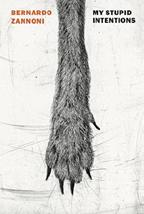
A fable that makes Aesop’s darkest seem saccharine, Italian author Zannoni’s debut novel concerns Archy, a beech marten (a weasel-like animal) inhabiting a stretch of forest with his small family. With a dead father, a harsh, unfeeling mother, and siblings barely able to make their way through the brush, young Archy can only envision a Hobbesian future for himself: nasty, brutish, and short. When his mother sells him as a slave to the mysterious Solomon, a fox who has set himself up as the woodland’s only trader-lender (with the help of his bodyguard/ enforcer, a dog called Joel), Archy finds himself receiving many beatings for his clumsy mistakes as well as an odd, intriguing education at Solomon’s hands. Gradually, the marten meets other denizens of the forest and discovers life to be nothing less than drenched in the red of tooth and claw. Growing into a stumbling adulthood, Archy wills himself to learn at Solomon’s feet, to open himself up to the fox’s abusive instruction, which stems from a strange human book, the Bible, which the old trader found years earlier while feeding on the body of a hanged man. In time, Archy yearns to live on a higher, less degraded plane and turns to his painfully acquired writing talents to make sense of the carnage around him. The character of Archy, in all his awkward, vulnerable marten-ness, emerges as courageously as any classical hero. Finding happiness in the arms of a beloved only to have her ripped away, finding stability in the trading post after the death of his master only to be driven from it by interlopers, he is a noble, tormented protagonist striving amid a beastly contingent of the selfish, stupid, and evil. This darkly beguiling novel casts its enchantments with an eye trained on the human heart, with its false chambers and rough, bestial inclinations.
A remarkable education in the grief of staying alive.
Chow, Jennifer J. Berkley (288 pp.)
$8.99 paper | June 6, 2023
9780593336557
Thanksgiving dinner at the Asian American Restaurant Owners Association in West LA leaves the often squabbling members grappling with a murder.
Yale Yee isn’t a member, but her restaurateur father is. So she and her cousin, Celine, who’s visiting from Hong Kong, pitch in to help. Since her mother’s sudden death, Yale has been unable to live at home, but she happily shares her apartment with Celine, a social media influencer, who helps her run a food stall at the nearby Eastwood Village Night Market, where they solved a previous murder. The Thanksgiving dinner at Ho’s, a restaurant owned by Mrs. Ho and her son, Nik, who’s long butted heads with Yale, includes a hot pot dinner for a dwindling AAROA membership including club president Jeffery Vue; his vice president, Derrick Tran; and Roy Yamada, who all help prepare the meal. Misty Patil shows up to help with the cooking though she claims she didn’t get an invitation to the dinner, and when someone named Trisha Kim arrives, she says she heard about the dinner on a blog and thought it was a public meeting. Things take a shocking turn when, while setting up the dining room, Jeffery is electrocuted while plugging in a damp extension cord. Det. Greyson Strauss, whom Yale knows from the Night Market murder, insists that the death was no accident. With so many of their friends as suspects, Yale and Celine decide that a little sleuthing is in order, and they dig up some tidbits to share with Strauss. Celine’s parents arrive from Hong Kong and insist she return home with them, but she’s grown to love her independence and wants to stay, setting up some family drama. Then both women are endangered when they get too close to a desperate killer.
Great characters and a delightful mystery filled with luscious descriptions of food.

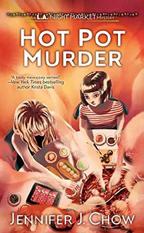
GIVE FUDGE A CHANCE
Coco, Nancy
Kensington (352 pp.)
$8.99 paper | May 23, 2023
9781496735553
Winning a candy contest brings nothing but trouble to a fudge-making Michigan hotelier.
Allie McMurphy hopes that winning the Mackinac County Fair’s candy contest will bring good publicity to the
murder on the home front
McMurphy Hotel and Fudge Shop. After she wins, however, the publicity isn’t exactly the kind she wanted. When she and her friend Jenn Carpenter visit the fair’s haunted murder mansion, they find a dead body. It’s far from a first for Allie, who’s stumbled on quite a few corpses since she moved to Mackinac Island, much to the despair of her boyfriend, police officer Rex Manning. To add to her woes, she’s accused of bribing the candy contest judges by Christine Keller, whose caramels have won best in show for 20 years and who doesn’t accept Allie’s win gracefully. The friends who’ve helped Allie solve past crimes are eager for her to look into carnival attractions owner Mike Sanders’ death, but it’s not till Hazel Green falls or is thrown off the McMurphy’s roof that she starts sleuthing. Hazel was deeply involved in parkour, an activity that required her to travel to a destination by jumping from roof to roof. Allie’s little dog, Mal, sniffs out clues, and even her cat lends a paw, leading her to one of a series of underground tunnels that are being used for nefarious purposes. The two murder investigations become one as Allie and Rex find connections between them that are confusing but eventually lead to a solution.
An enjoyable character-driven whodunit that mixes murder with a touch of romance and the requisite sweet treats.
Copperman, E.J.
Severn House (240 pp.)
$31.99 | May 2, 2023
9781448309702
Copperman launches yet another new franchise with perhaps his most offbeat protagonist to date.
How could the creator of a sleuth who communes with ghosts, a problemsolver on the autism spectrum, and an animal talent agent with a knack for detection push the envelope even further? By creating a detective who is herself created. Fran Stein learned at a young age that she and her brother, Ken, were made in a lab by her mother, a professor of genetics and biology who taught at Rutgers under the alias Olivia Grey, and her husband, a neurologist known to the world as Brandon Wilder. The Grey-Wilders have long since disappeared, leaving Fran and Ken to be raised by their “Aunt Margie,” actually a journalist who was working on a story about the brilliant scientists when they decamped for parts unknown and who then sacrificed her career to raise Fran and Ken. When she grew up, Fran naturally became a private eye specializing in helping adults find their long-lost parents and pressured chronically underemployed Ken into joining her. Their latest client, Evelyn Bannister, wants the pair to find a Gibson Poinsettia ukulele that she claims will lead to her birth father, an avid collector. The siblings think her story stinks like week-old sushi but play along to see what her game really is. Evelyn’s murder pushes Fran to keep going, and pursuing the homicide leads her into a perplexing relationship with 5-foot-8 Det. Richard Mankiewicz. (Like most lab-created humans, Fran is on the statuesque side.) The
solution is likely to strain the credulity of even die-hard Copperman fans, but what his shaggy dog story lacks in verisimilitude, it makes up in commitment to its wacky premise.


What next?

Ellicott, Jessica
Severn House (256 pp.)
$29.99 | May 2, 2023
9781448306534
A wartime female police constable confronts misdeeds both in and out of the nick.
Only a national emergency like the Great War could allow a parson’s daughter from Wiltshire to become a police constable in the bustling port city of Hull. But Billie Harkness hopes that her success at her job will open the door for other women to pursue careers in police work. Of course, not all her colleagues feel the same way, and getting groped by loutish Constable Drummond while making tea in the station’s kitchen rattles her confidence. Still, Sgt. Skelton doesn’t hesitate to team her up with Special Constable Peter Upton and send the pair out to investigate a murder. And Upton isn’t afraid to let her take the lead in questioning witnesses. Billie’s perceptiveness is impressive, and she shows real ingenuity in getting folks to spill the tea. The biggest treat for readers, however, is seeing the busy industrial city of Hull through her eyes. Country-bred Billie isn’t naïve, but she’s capable of finding excitement in a tram ride. Whether she’s walking the pavement, finding the shortcuts known only to city natives, or enjoying the luxury of a coach ride, she uses her keen powers of observation to express her sense of wonder at her new world. She also cracks the case, earning well-deserved admiration from her partner and her canny sergeant.
A worthy follow-up to Ellicott’s series debut.
Flower, Amanda
Kensington (304 pp.)
$8.99 paper | May 23, 2023
9781496734631
Another murder roils the peaceful surface of Harvest, Ohio, a town located in an Amish area filled with farms and quaint shops that attract plenty of tourists.
Bailey King left a job with a New York City chocolatier to return home and help her grandmother run Swissmen Sweets in Harvest. Business is good, and her reality TV show, Bailey’s Amish Sweets, has helped bring her dream of a chocolate factory close to fruition. Just as a camera crew arrives in town to record her progress, her
“A wartime female police constable confronts misdeeds both in and out of the nick.”
contractor, Wade Farmer, stops working, suspiciously demanding more money from her and all his clients. Bailey’s boyfriend, Aiden Brook, has been working for the state Bureau of Investigation in Columbus for the past year, but he’s given up his job to move home and set up as a private investigator. When Wade is found shot dead at the shell of her factory, Bailey knows she may be a suspect because she’d just fired him. Her cousin Charlotte Weaver, who’s making a splash as Blueberry Princess at the town’s summer Bash, is engaged to Deputy Luke Little of the local sheriff’s office and estranged from her Amish family, which blames Bailey for her defection. When Charlotte’s conservative father is arrested for the crime, Bailey knows she must investigate. With Aiden’s mother’s pet pig in tow, she visits Amish and English suspects alike in an attempt to uncover a motive.
Mystery, humor, and romance mix with an overview of the diverse spectrum of Amish beliefs.

Gates, Eva Crooked Lane (272 pp.)
$26.99 | June 6, 2023
9781639102723
The wedding of a North Carolina librarian and a dentist who’s been elected mayor would be perfect if not for the dead body.
Nothing worse than some family squabbles mars the ceremony, held at a Nags Head hotel, until a corpse pops up in a utility closet the next morning. The dead man, Wayne Fortunada, had accompanied bride Lucy Richardson McNeil’s Aunt Joyce to the wedding, and he’d seemed pleasant enough until the reception, where he drank heavily and was reduced to monosyllabic conversation. Lucy’s already had an unfortunate amount of experience with murder, and her friendship with Det. Sam Watson has enabled her to give him information without risking snarky comebacks. This doesn’t apply to the newly hired Det. North, who’s helping Sam with the case; he’s suspicious of Lucy’s friendship with Sam and thinks he should be running the investigation himself. In addition to the murder, Lucy’s concerned about the tension between her brother Kevin and his estranged wife, Kristen, who came to the wedding with a date of her own. Lucy’s motivation to meddle is redoubled when absent-minded professor Eddie McClanahan, library director Bertie James’ date, vanishes on the night of the wedding and becomes the chief suspect. When she and her groom, Connor, track Eddie down at a friend’s beach cottage, he seems unaware of the murder but admits to having known the dead man years ago in New York and being blackmailed by him. Kristen’s date was an actor who also had a past with Fortunada. Blackmailers are obvious targets for murder, but which of the suspects was willing to go that far?
Quirky characters enliven a mystery with a twisty payoff.

Gaylin, Alison
Putnam (336 pp.)
$29.00 | June 13, 2023
9780593540527
Boston PI Sunny Randall searches for the unknown person who’s threatening a pair of Instagram influencers before the threats come true.
The Covid pandemic has taken its toll on the restaurant Sunny’s buddy Spike owns, and she can’t help being interested when self-styled “media concierge” Bethany Rose offers the services of red-hot influencer couple Blake James and Alena Jade to promote the place and bring in new customers. Of course, neither Spike nor Sunny can afford these services, but Bethany is willing to offer them gratis if Sunny will figure out who’s been sending Blake a series of ominous Instagram posts warning, “YOU REAP WHAT YOU SOW.” No sooner has Sunny started asking who sneaked past Eddie Voltaire, the guard at Blake and Alena’s pricey apartment building, to snap a photo of Blake sleeping than Eddie’s body is found stabbed 13 times. Clearly the influencers and their manager are up against a seriously bad adversary. But Sunny’s appeals to her mobbed-up ex-father-in-law lead only to dead ends, and the closer she looks into the backgrounds of her clients, the guiltier they look themselves. In fact, she reflects, they’re remarkably closemouthed for people whose “entire careers were based on letting strangers in on their so-called personal lives.” Taking over the franchise for the first time, Gaylin proves the equal of Sunny’s creator in plotting and his clear superior in bringing his heroine to life. She doesn’t sound all that much like Parker; she sounds better.
Gaylin brings Sunny to terms with contemporary social media even as she uncovers motives older than you can imagine.
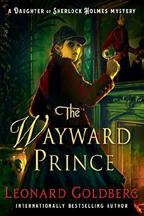
Goldberg, Leonard
Minotaur (336 pp.)
$28.00 | July 11, 2023
9781250789617
The daughter of Sherlock Holmes encounters still more historical figures and another blast from her late father’s past.
As her admiring husband, Dr. John Watson Jr., puts it, Joanna Watson “sees things which others do not.” So it’s only natural that Sir Charles Bradberry, the commissioner of Scotland Yard, would arrange a meeting with her at 10 Downing St. when Prince Harry, the son of George V, who’s third in line to the British throne, goes missing in May 1918. Joanna instantly suspects that His Royal Highness has been kidnapped, and indeed a ransom note
soon appears, setting up a phone call in which the kidnappers demand the fabled crown jewel the Sovereign’s Orb for the prince’s safe return. As Joanna matches wits with the kidnappers and tosses off a barrage of casual deductions, her husband learns that the death of barmaid Martha Ann Miller following a botched abortion at St. Bartholomew’s, where he’s director of pathology, has surprising links to the abduction. But the biggest surprise is yet to come: The identification of the brains behind the kidnapping as Col. James Moriarty, whose brother so memorably encountered Joanna’s father at Reichenbach Falls. The crime is clearly personal for Moriarty, and identifying him as the mastermind makes it personal for Joanna, too. Though the supporting criminals are obvious from the beginning and the constant thrust and parry between Joanna and the forces of evil can become tiresome, Goldberg, as usual, keeps up the pace on every page and in virtually every pregnant remark from Sherlock Holmes’ daughter.
An appealing installment for franchise fans and newcomers alike.

Hall, Emylia Thomas & Mercer (439 pp.)
$16.99 paper | July 1, 2023
9781662505126
A police detective’s widow in a Cornwall town develops an unlikely friendship as she tries to learn what happened to a young man whose plea for help she spurned.
Ally Bright has been a bit of a recluse since the death of her husband, Bill, last year. Though Bill was a well-regarded police detective in Porthpella, Ally prefers to spend her time at home in Shell House, fabricating sculptures from trash washed up by the sea, and isn’t close to her neighbors. When her daughter, Evie, tries to convince her to move to Australia, Ally—who has a hard time even leaving Shell House—is hard-pressed to answer Evie’s question about what’s left for her in the town. Jayden Weston, a newcomer to Porthpella, is wondering about his own place in the world. He’s come to the family home of his wife, Cat, so the two can raise their baby, who’s due any day now. Ally’s and Jayden’s paths cross one morning when they meet over Lewis Pascoe’s body on the seashore. Lewis is rushed to the hospital, but the police think he’s unlikely to recover from what they deem a botched suicide attempt. Ally’s left in shock. Lewis had come to her house just last night begging for help from Bill. Unprepared for his visit, Ally had turned him away. Jayden isn’t sure that what happened to Lewis was of his own doing, and he senses that Ally shares his doubts. Whether or not it’s because Jayden was once a police officer, he’s determined to find the truth, and he teams up with Ally in an improbable duo whose kinship warms their investigation.
Despite the familiar salt-and-pepper premise, the whole is greater than the sum of its parts.
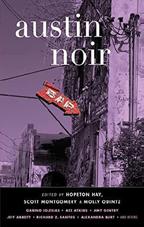
Ed. by Hay, Hopeton, Scott Montgomery & Molly Odintz
Akashic (296 pp.)
$16.95 paper | May 2, 2023
9781636140896
Austin has quite a reputation.
It’s a place where hippies and rednecks came together to listen to Janis Joplin. But just as more people bring more money and more experiences into a city, they bring more crime. Some of the dark deeds this volume chronicles are solid and old-fashioned. Gunplay has its place, as Gabino Iglesias documents in “The Pink Monkey” and Ace Atkins shows in “Stunts.” So do the dysfunctional families in Amanda Moore’s “Reflections” and Jeff Abbott’s quietly creepy “The Good Neighbor.” Con games are another pillar of traditional noir, as Chaitali Sen reminds genre fans in “The Foundation.” But other transgressions are more up to the minute. In “Rush Hour,” Richard Z. Santos shows what can happen when a good Samaritan confronts the TikTok generation. Alexandra Burt’s “Sapphire Blue” is a shocking look at America’s child care crisis. Miriam Kuznets offers a wholly unexpected solution to the high price of prescription drugs in “Saving.” Not to neglect Austin’s status as a university town, editor Odintz’s “Michael’s Perfect Penis” and Amy Gentry’s “Stitches” celebrate those bright college years in a way that feels both nostalgic and new. A perfect testament to Austin’s ability to look backward while moving forward.

Khavari, Kate Crooked Lane (352 pp.)
$27.99 | June 6, 2023
9781639102785
A series of murders marked by unusual bouquets puzzle a botanist familiar with poisonous plants.
Though she’s already solved a murder, Saffron Everleigh is still fighting harassment and low expectations as a female researcher at University College London in the 1920s. Now she’s teamed with the attractive, mischievous Dr. Michael Lee in a project to investigate accidental poisonings and identify the toxins. She’s intrigued when DI Green calls upon her for help with several murder cases in which toxic bouquets have been left. Saffron has no trouble identifying the poisonous plants, and when she turns to a Victorian book about the language of flowers, she finds that the meaning of the bouquets is “a whole, alarming story.” Lee’s interest is piqued by the discovery that all the victims had drugs in their systems, and the two reluctantly form a sleuthing partnership for different reasons. After finding some commonalities between the victims, they seek information in a jazz
“A perfect testament to Austin’s ability to look backward while moving forward.”
austin noir
club where wealthy aristocrats hang out. Saffron, who, like Lee, comes from a privileged background, uses a fake name to hide her connection to her family. As Lee begins to understand the battle Saffron wages against misogyny, he develops romantic feelings for her, putting her in a quandary when her love interest, Alexander Ashton, returns from an Amazon expedition and is horrified to find her involved in another murder investigation. Her refusal to stop places them all in mortal danger.
An intriguing mystery with plenty of esoteric plant lore and a touch or two of romance.
Lorac, E.C.R.
Poisoned Pen (288 pp.)
$14.99 paper | July 11, 2023 9781728278537
Murder eventually strikes a quiet Lancashire farm village in this slowburning whodunit originally published in 1953.
Everyone in Lunesdale, it seems, covets Aikengill, the home Yorkshire accountant Gilbert Woolfall inherited from his uncle Thomas but has scant time to visit. On one of those infrequent visits, neighboring farmer Christopher Fell’s daughter, Betty, is cheeky enough to come out and ask if she and her suitor Jock Shearling might occupy two of its rooms in Gilbert’s absence after they’re wed. Lambsrigg Hall owner Daniel Herdwick, Jock’s employer and Thomas Woolfall’s longtime grazing tenant, wants to buy the acreage for his herd. The Rev. Simon Tupper, rector of the local church, thinks Gilbert should donate a substantial part of his inheritance to the Ewedale-with-High Gimmerdale church. Thomas’ housekeeper, Mrs. Ramsden, can’t quite bring herself to leave the house even though there’s no one in residence to take care of anymore. Her ambivalence turns out to be a serious misfortune, since Mrs. Ramsden is on the premises when someone sets Aikengill ablaze one night, destroying half the lovingly restored house and suffocating its faithful servant. The local police waste no time in roping Chief Inspector Robert Macdonald, a CID investigator on vacation from Scotland Yard, into the case. It’s Macdonald who’ll uncover the surprisingly complicated links between the fatal fire and a series of thefts of sheep and other valuables and identify a killer likely to take most readers by surprise since most of the villagers seem absolutely incapable of even the mildest criminal infractions.
An effortlessly atmospheric idyll that has a lot to teach contemporary cozies.
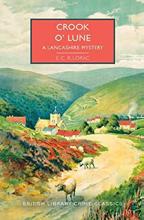
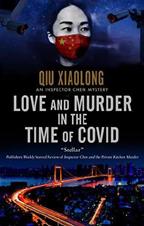
Qiu Xiaolong
Severn House (224 pp.)
$31.99 | July 4, 2023
9781448311491
The turmoil surrounding the pandemic provides cover for a brutal serial killer.
Veteran bureaucrat Chen Cao, once the chief inspector of the Shanghai Police Bureau, currently languishes as the director of the Shanghai Judicial Reform Office. In the middle of the Lunar New Year celebration, he finds himself stranded on a dark subway car, the first of the day’s indignities. Then he gets a telephone call from government authorities telling him to get a Covid test because he was seen on the street near a hospital. Chen is chilled at the realization that he was caught by a surveillance camera. The pandemic has pushed China toward even stricter regulations, echoing Nineteen EightyFour’s Big Brother in a motif threaded through the novel. As his title’s nod to Gabriel García Márquez already hints, Qiu’s 13th Inspector Chen mystery is both more literary and more political than earlier books in the series. Relevant literary references, quotations, and poems are peppered generously throughout, from Dante to Doctor Zhivago to Yeats to Animal Farm to several Chinese poets. A collection of recent deaths near the hospital leads Chen to believe there’s a serial killer on the loose. His straightforward murder investigation, which allows him to reunite with his friendly ex-colleague Jin, often feels like a MacGuffin for the novel’s larger plan to view the Covid pandemic through a haunting literary lens.
A provocative and timely take on Covid in China, with a whodunit kicker.
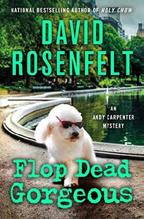
Minotaur (272 pp.)
$28.00 | July 4, 2023
9781250828903
Paterson, New Jersey, attorney Andy Carpenter ventures all the way to neighboring Bergen County to defend a client dear to his heart.
Back in high school, Andy briefly dated Jenny Nichols, something he repeatedly tells everyone who’ll listen now that she’s become a major movie star. Since Jenny’s on the East Coast shooting a film with Ryan Griffin, Andy and his wife, private eye Laurie Collins, throw her a dinner party that’s crashed by Griffin, who insists that she’d made dinner plans with him. Andy’s muscular pal Marcus Clark persuades Griffin and the two goons he’s brought to leave quietly, but that only sets the stage for the discovery of Griffin’s body a few hours later. When the county prosecutor issues a warrant for Jenny’s arrest, Andy swings into
witch upon a star
action with all the motivation in the world. Working feverishly, he links Griffin to Yaroslav Miranov, a Russian crime lord who’s laundering huge amounts of money and whose hired assassin, Sergey Bondar, has already left a bloody trail in his wake. If only any of those parties had been staying at Jenny’s mother’s house in Englewood Cliffs that fatal night; if only any of them could be linked to the cake knife that stabbed Griffin in the back in that house’s kitchen; and if only the jury weren’t prevented by a sequestration order from hearing about most of these developments. Series fans familiar with the trajectory from small-scale murder to predictable large-scale international intrigue will await the inevitable final twist with bated breath. This time, though, that twist is as unsurprising as the rest of the mystery.
Perhaps the weakest entry in a strong and entertaining series. Skip this one and wait a few months.
Sanders, Angela M.
Kensington (304 pp.)
$8.99 paper | May 23, 2023
9781496740915
A witchy librarian counts on books to help solve a baffling series of crimes.
Josie Way, who lives in an apartment above the library in tiny Wilfred, Oregon, is apprehensive about a visit from her younger sister. Jean is coming to Wilfred for a workshop for aspiring life coaches that their mother thinks is a scam. Their family has magic powers that Jean doesn’t know about, and Josie’s been warned not to tell her. Life coach Cookie Masterson seems nice enough when Josie walks Jean over to the workshop, but as she explains her ReadySet-Go method to her new students—she calls them “crumbs”— Josie takes a quick dislike to her. While Jean is at the workshop, Josie heads over to the big reopening of the town cafe—which is ruined when the doors open to reveal a dead man slumped over the counter, a knife in his back and the words READY-SET-GO written on a place mat. Town sheriff (and Josie’s crush) Sam Wilfred is called, but he’s already busy with another death at the retreat center where the workshop is being held. Despite the unexplained death of the attendee Josie and Jean had overheard arguing with another crumb at the grocery store that morning, before they knew who they were, the workshop goes on. But now Josie’s more worried than ever about Jean’s safety even as Jean urges her to reveal her feelings for Sam. Josie uses her magic to get answers from books. The dead man turns out to have been Cookie’s husband, and it seems every death that follows is also related to her. As more people die, the case becomes ever more dangerous for the sleuthing sisters.
A complex mystery with some amusingly witchy touches.
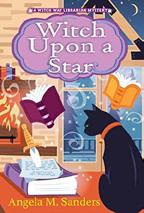
Seales, Julia
Random House (336 pp.)
$27.00 | June 27, 2023
9780593449981
A young woman of marriageable age and prospects moonlights as a detective in Seales’ tongue-in-cheek Regency murder mystery.
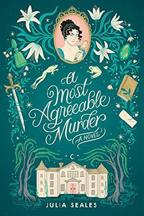
Beatrice Steele spends hours in her turret room, dreaming of solving dark and dire crimes like her favorite “gentleman detective,” Sir Huxley. As the oldest daughter in a family of girls, she would usually be the one on whom all hopes were pinned to make a good match, but luckily, her sister Louisa is the beautiful one and, as such, may be the one to keep the family out of ruin. When they are invited to the annual autumn ball at Stabmort Park, home of the Ashbrooks— the oldest and wealthiest family in their corner of Swampshire— they have no idea that the storm that ushers them across the moors is also blowing together an unlikely cast of characters. By the end of the evening, secrets will have been revealed, false identities exposed, missing persons found, and murder committed (twice!). The character types are endearingly familiar to anyone who has ever read a Jane Austen novel, and the dialogue crackles with wit, outrage, subtext, and pluck. Beatrice, a true Sherlock Holmes within her restrictive social world, is a delight, and while the characters may be familiar, Seales’ over-the-top caricatures succeed in being humorous rather than cliché. As Seales writes about the Regency period in a readers guide at the end of the book: “Women learned to interpret every look, every word, every tiny insight they observed. If they were so good at doing this in order to catch a husband…what if they turned these skills toward catching a killer?” The result is a deliciously dark delve into a world that seems genteel on the surface and teems with sex and violence and greed just underneath—not so unlike Austen’s but with a morbid, rather than domestic, bent. Irreverent, satirical, and oh so much fun!
BLACK RIVER

Spencer, Matthew Thomas & Mercer (303 pp.)
$16.99 paper | July 1, 2023
9781662510069
The murder of a third girl in an affluent Sydney suburb brings out an army of police and press.
A young woman is brutally killed on the campus of Prince Albert, a private boys’ boarding school in suburban Sydney. She’s assumed to be the latest casualty of the Blue Moon Killer, who’s currently at large. This victim is Marguerite Dunlop, daughter of the school chaplain and a recent graduate of a neighboring girls’ school. Reporter Adam Bowman, an alumnus
“A witchy librarian counts on books to help solve a baffling series of crimes.”
of Prince Albert, is sent to cover this hot story with orders to stay out of the way of his brash colleague “Beat-Up” Benny Diamond, who’s already reporting on BMK for their newspaper. Meanwhile, the investigation by DCI Steve O’Neil and DS Rose Riley is underway. A police team dubbed Strike Force Satyr that’s also investigating BMK is on the scene as well. Riley and O’Neil’s methodical gathering of forensic evidence and questioning of witnesses alternates with Bowman’s more personal reminiscences and interviews. An additional perspective is provided by DC Priya Patel, a young officer with a justifiable chip on her shoulder over “a lifetime of explaining yourself to dumb fucks.” Spencer’s fiction debut, the first installment in a planned Rose Riley series, features a straightforward detective plot that’s enriched and deepened by touching on issues of class, race, and gender.
An engaging police procedural with a little something extra.
White, Karen Berkley (400 pp.)
$28.00 | May 9, 2023
9780593334621
White’s second Royal Street book, a spinoff of her bestselling Tradd Street series, continues the tradition of haunted houses, evil ghosts, and fraught romances.
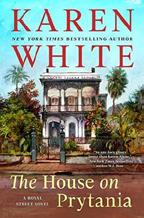
Nola Trenholm has recently moved from Charleston to New Orleans, and her father, author Jack Trenholm, and stepmother, Melanie, whose ability to communicate with the dead has produced many scary moments, are coming to visit soon along with her 12-year-old half siblings, Sarah and JJ. They want to see the historic haunted home Nola has recently purchased. In the meantime, she’s living in an apartment with her dog, Mardi, and Jolene McKenna, a Southern belle with many talents. Nola has a complicated relationship with old friend and current contractor Beau Ryan, whose sister Sunny, kidnapped more than 20 years ago, has just found her way back to her family. Beau hates to admit that, like his presumably dead mother, he can communicate with ghosts. He and his girlfriend, Sam, have created a podcast debunking psychics. Beau wants revenge after uncovering the truth about Sunny’s kidnapping, which was arranged by the late Antoine Broussard, whose evil deeds live on. Nola, whose new house is haunted by both Beau’s grandfather and Broussard’s malignant spirit, soon finds herself attracted to three different men: Beau; Michael Hebert, who broke her heart after starting a romance with her to help conceal his Broussard relatives’ misdeeds; and her first love, Cooper Ravenel, who’s just moved to New Orleans. Both Sunny and Sam beg her to renew her former friendship with Michael in order to infiltrate the Broussard family and get answers to some of their many questions. Nola’s sister Sarah, who has psychic abilities, helps them track down clues in what turns out to be a dangerous case that could ruin many lives.
An exciting psychic mystery best enjoyed by veterans who’ve read all the previous entries in both series.
Sanderson, Brandon Tor (384 pp.)
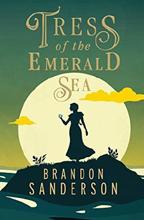
$25.49 | April 4, 2023
9781250899651
A fantasy adventure with a sometimes-biting wit.
Tress is an ordinary girl with no thirst to see the world. Charlie is the son of the local duke, but he likes stories more than fencing. When the duke realizes the two teenagers are falling in love, he takes Charlie away to find a suitable wife—and returns with a different young man as his heir. Charlie, meanwhile, has been captured by the mysterious Sorceress who rules the Midnight Sea, which leaves Tress with no choice but to go rescue him. To do that, she’ll have to get off the barren island she’s forbidden to leave, cross the dangerous Verdant Sea, the even more dangerous Crimson Sea, and the totally deadly Midnight Sea, and somehow defeat the unbeatable Sorceress. The seas on Tress’ world are dangerous because they’re not made of water— they’re made of colorful spores that pour down from the world’s 12 stationary moons. Verdant spores explode into fast-growing vines if they get wet, which means inhaling them can be deadly. Crimson and midnight spores are worse. Ships protected by spore-killing silver sail these seas, and it’s Tress’ quest to find a ship and somehow persuade its crew to carry her to a place no ships want to go, to rescue a person nobody cares about but her. Luckily, Tress is kindhearted, resourceful, and curious—which also makes her an appealing heroine. Along her journey, Tress encounters a talking rat, a crew of reluctant pirates, and plenty of danger. Her story is narrated by an unusual cabin boy with a sharp wit. (About one duke, he says, “He’d apparently been quite heroic during those wars; you could tell because a great number of his troops had died, while he lived.”) The overall effect is not unlike The Princess Bride, which Sanderson cites as an inspiration.
Engrossing worldbuilding, appealing characters, and a sense of humor make this a winning entry in the Sanderson canon.
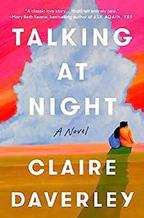
Daverley, Claire
Pamela Dorman/Viking (400 pp.)
$28.00 | June 20, 2023
9780593653487
British author Daverley follows a young man and woman through decades of their lives as they experience love, tragedy, and heartache.
At 17, Rosemary Winters hopes there will be more to life than studying for her exams and counting calories to please her mom. Her energetic twin brother, Josh, has big dreams—he hopes to attend Cambridge. He’s taken to studying math with the broody Will White, a bad boy with a reputation for sleeping around, an absentee mother, and no current plans to go to university. Will first noticed Rosie singing at a bonfire, with her ever attentive doe eyes and enchanting voice, and hasn’t been able to forget her since. Rosie, on the other hand, could never imagine a boy like Will being interested in her, especially with her keen attention to school and what her friend Marley calls a “vanilla virgin” personality. And yet, one midnight conversation at the Winters’ house leaves Rosie noticing Will as much as he’s been noticing her. The closer Will and Rosie get, though, the further Josh seems to pull away from his sister, until tragedy strikes and leaves their budding romance in shambles. Suddenly, Rosie’s dream of attending music school and Will’s travel plans are cut short, broken by the secrets they share and a loss they can’t overcome. As years pass, the two lose touch and find each other in different stages of life, but somehow, their attraction never wanes. Daverley’s moving debut outlines a lyrical story of unspoken words and one unending love: “But her voice keeps him awake that night. And again, the night after that.” While Rosie and Will’s love story is fraught with heartbreak and change, and although the journey is almost always tumultuous, their evolving friendship and unbreakable connection prove entirely worthwhile and real.
A poignant romance perfect for fans of Josie Silver and Bethan Roberts.
Guhrke, Laura Lee
Forever (336 pp.)
$16.99 paper | June 20, 2023
9781538722626
A bookstore owner is swept into a new life by a duke.
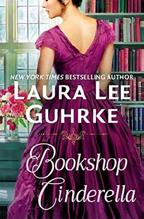
Evie Harlow doesn’t have much, but she does still have her late father’s bookshop, after years of hard work to pay off
his debts, and her dreams of romance with a childhood friend. Those dreams take a different turn when Maximillian Shaw, Duke of Westbourne, pops into her store on an errand for his cousin, with whom Evie helps plan elaborate dinner parties at the Savoy Hotel. That night, at the Savoy’s famous American Bar, when he hears some young fops disparaging her, he’s rather surprised and tells them she has “the potential to be an incomparable beauty,” then backs that assertion up with a drunken wager that he can introduce her to society and transform her into the belle of an upcoming ball. It isn’t until the next day, explaining his offer to Evie, that he realizes it might not sound quite as complimentary to her as he thought. But Evie, after a bookshop emergency, agrees it would be nice to have a short vacation staying in the Savoy, being taken to the opera, and given a whole new wardrobe. As her transformation begins, dance lessons and other circumstances bring her and Max closer, but early experiences with high society made her wary of it, and Max has his own reasons for keeping her at arm’s length. As the ball draws closer, though, they may not be able to resist at least one night together. Evie and Max develop a charming chemistry that starts slow and then ticks all the historical romance boxes without feeling clichéd. Guhrke’s slightly spicy new series, set against the Victorian backdrop of the opulent Savoy Hotel, is full of rich detail and side stories that will thrill historical romance lovers. Enjoy it with the newfangled drink that got the duke soused enough to bet on Evie: “something...called a ‘Manhattan.’ ”
A promising start to a cheery new Victorian romance series.
Heath, Lorraine

Avon/HarperCollins (384 pp.)
$9.99 paper | June 27, 2023
9780063114678
Published as an act of revenge, a scandalous novel unwittingly reunites formerly betrothed lovers.
Who is “Lord K?” That’s what everyone in London is asking about the seductive lead in the anonymously published My Secret Desires, A Memoir. Many suspect Arthur Pennington, the Earl of Knightly, and he has grown annoyed by all the attention. When he finally gets his hands on the book some are trying to have banned for obscenity, he realizes that it’s true—he is indeed Lord K, and the author is Miss Regina Leyland, the woman he left at the altar five years ago but secretly never stopped loving. When Regina’s reputation and livelihood are threatened by the revelation that she is the book’s author, she agrees to a fake reconciliation with Knightly, whom she loathes for hurting her. They’ve both changed and matured in the last five years, but their desire for each other remains fiery hot. To truly move on from the past, though, they’ll have to trust each other with the secrets they’ve been harboring to protect loved ones. This second-chance romance is brimming with
“Among Heath’s impressive oeuvre, this one is a standout.”
the notorious lord knightly
heightened emotions; there’s regret and anger and so much delicious yearning. The ramifications of Society’s harsh expectations and judgments are thoughtfully incorporated, while the narrative is smartly and purposefully constructed for maximum emotional impact. Flashbacks to Knightly and Regina’s passionate and ultimately heartbreaking initial courtship are woven in, and their closely guarded secrets are gradually revealed to the reader before the pair learn each other’s truths.
Among Heath’s impressive oeuvre, this one is a standout.
Lenker, Maureen Lee
Sourcebooks Casablanca (384 pp.)
$16.99 paper | July 11, 2023
9781728267883
An actress falls in love with her leading man in this historical romance set during the golden age of Hollywood. Hollywood superstars Joan Davis and Dash Howard are contractually obligated to make one final film together. Joan is relieved it’s only one. Although working with Dash made her a star, he was also responsible for her greatest public humiliation, setting her up to be targeted by ruthless tabloid reporter Leda Price. Ever since, Joan has treated Dash with cold, professional courtesy, while he has retaliated on set with a series of juvenile pranks. On the other hand, Joan is frustrated and humiliated that her recent movies—all of them without Dash as her leading man—have been a string of flops that have earned her a reputation as “box-office poison.” As Dash and Joan prepare to start filming, Joan’s tabloid-reporter nemesis reveals a piece of delicious and damning gossip. A wedding certificate Joan and Dash signed on the set of a previous film was filed at the LA County Courthouse—in the eyes of the law, they are married! Since the stars are unable to divorce in the state of California, the studio suggests moving the film set to Reno. If Joan and Dash take up residency there for six weeks, they can file for divorce in Nevada. Lenker’s debut delights in playing with the language and tropes of classic Hollywood films—studio moguls chewing cigars, curtains strung between beds, and furious banter between the love interests. Dash and Joan are both pressured to perform “being a star” in public, which makes it difficult for them to let down their guards and trust each other in private. The book itself falls into the same trap, though, with the focus on capturing old Hollywood’s glitz and glamour overshadowing the romance between Joan and Dash.
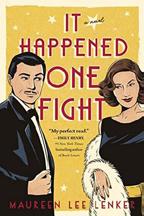
A promising debut for historical romance readers looking for a fresh, new setting.
(352 pp.)
$16.99 paper | July 11, 2023
9781538740880
A wedding planner and a florist with a romantic history are forced to work together for a celebrity wedding in this sexy romance debut.
Despite taking great pride in her work as a wedding planner, Ama Torres has no desire to get married. After witnessing her mother’s numerous failed marriages, Ama is fine letting others say “I do” but has decided it’s not for her. Elliot Bloom never thought he’d become a florist, but he begrudgingly accepts the role after his father leaves him his flower shop. When Ama is hired by an influencer with 4.2 million Instagram followers, she knows exposure on this level could skyrocket her business and lead to work with more high-profile clients. Unfortunately, the brides already have Elliot in mind as a florist, which could pose a bit of a problem. A couple of years ago, Ama and Elliot seemed like the perfect pair, mixing business with pleasure. But Elliot’s proposal seemed to ruin everything, and Ama has successfully avoided speaking to him since. Neither Ama nor Elliot wants to give up such a promising gig, so they agree to work together and keep their relationship history a secret. They still possess some sparkling chemistry, though, and it doesn’t go unnoticed by the meddling brides. Ama and Elliot offer differing perspectives. The present-day story is told through Ama’s optimistic firstperson point of view; Elliot narrates the earlier part of their relationship in a grumpier voice, ruminating on his relationship with Ama and where it all went wrong. The main characters are front and center here, and while the detailed descriptions of a gorgeous, over-the-top wedding will send readers’ imaginations running wild picturing couture gowns and grand floral displays, the secondary characters who orbit Ama and Elliot feel paperthin. The interactions—and sexual tension—between Ama and Elliot are where the story shines; just exercise patience with everything else.
A debut that is equal parts sexy and sweet, with some minor distractions.

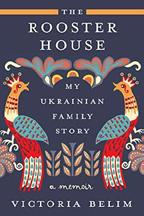
Belim, Victoria Abrams (288 pp.)
$28.00 | June 27, 2023
9781419767852
A Ukrainian American journalist recounts the history of her Ukrainian family within the broader context of Russian aggression since the 1930s.
“I was born in Kyiv, but the first fifteen summers of my life unfolded in [Bereh] on the Vorksla River.” So writes Brusselsbased journalist Belim in this poignant, gently unfolding tale. To her, the small village of Bereh was a “second home,” and her great-grandparents Asya and Sergiy were her “second set of parents.” Although she grew up in Chicago with her mother and stepfather, Belim pined for Bereh, yet she rarely visited—until 2014, when Russia seized Crimea and war broke out. Spurred by the rabid pro-Soviet stance of her uncle Vladimir, her father’s older brother, who goaded her with anti-Western propaganda, the author decided she needed to return to the Ukraine of her youth and reconnect with her aging grandmother Valentina, who lived in Kyiv but spent her summers in Bereh. The author writes movingly about helping Valentina with her cherry orchard and extensive garden and cooking traditional Ukrainian meals while weaving in painful memories of Soviet oppression—her relatives’ surviving the Holodomor of 1932-1933, when 4 million Ukrainian peasants died due to Stalin’s disastrous collectivization policy. Belim also writes about how, during the political purge of 1937, her uncle Nikodim inexplicably disappeared after being interrogated at the secret Soviet police headquarters called the Rooster House. “I thought of this uncle who had fought for a free Ukraine and who had paid the highest price as a kindred spirit,” she writes, “and I wanted to restore him to his rightful place in the family story.” While Valentina refused to revisit this haunting history, Belim was able to access Nikodim’s files and discover the truth. Throughout this powerful text, readers will encounter numerous satisfying layers.
An elegant family narrative of myriad characters traumatized by the deep-seated Russia-Ukrainian struggle.
Inclusivity over exclusivity. When someone asks me anything related to diversity or social justice, that is my basic answer. I hold the unwavering belief that the more diverse a group is, the stronger it is—and diversity requires inclusion and openmindedness. For our annual Diversity Issue, I’ve chosen to highlight three books that provide instructive, convincing encouragement on how to effectively embrace diversity—be it ethnicity, gender, race, sexual orientation, or socioeconomic status—and thrive.
The first is by Kenji Yoshino and David Glasgow, founders of the Meltzer Center for Diversity, Inclusion, and Belonging at the NYU School of Law. Say the Right Thing: How To Talk About Identity, Diversity, and Justice (Atria, Feb. 7) is a must-read for anyone seeking guidance on how to foster positive communication about identity. As our starred review noted, “the authors skillfully explore seven key areas: how to avoid socalled ‘conversational traps,’ build resilience in dealing with differing points of view, cultivate curiosity about how others perceive the world, disagree respectfully when necessary, apologize authentically when wrongs are committed, apply the platinum rule (help others as they would prefer to be helped), and be generous to those who act in noninclusive ways. The authors’ advice has been extensively field-tested, and they are admirably nuanced in their identification of specific challenges to the promotion of constructive dialogue.” The authors are unafraid to examine how their personal lives have influenced their work: “We are both gay men who spent our formative years in the closet,” they write. “During that time, we were desperate to talk about our own identities, but the words felt unspeakable, even to the people who mattered most in our lives. That suffocating silence led us to search for a more powerful way of communicating.”
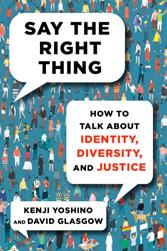
Effective communication is paramount in any discussion of diversity and identity, and Letters to a Writ
er of Color (Random House, March 7), edited by Deepa Anappara and Taymour Soomro, tackles the many unique challenges that writers of color face. The contributors include Tiphanie Yanique, Kiese Laymon, Myriam Gurba, Mohammed Hanif, and a host of others, all of whom address not just craft, but also broader concerns of identity, authenticity, and self-acceptance. In a starred review, our critic noted that while the book is geared toward writers of color, “artists of all races will benefit from the honesty, profundity, and munificence radiating from each of these letters.” The essayists also demonstrate an “astounding” generosity in sharing elements of their private lives, resulting in “a stunningly personal and practical compilation of literary and life advice.”

Simple-to-follow life advice is at the heart of David Moinina Sengeh’s Radical Inclusion: Seven Steps To Help You Create a More Just Workplace, Home, and World (Moment of Life Books/Flatiron, May 2). Despite significant obstacles to his mission of “radical inclusion,” our reviewer writes, “Sengeh dismisses roadblocks like hesitancy, appeasement, or behavioral ‘code-switching’ and offers comprehensive solutions and tactics to achieve inclusiveness.” The author’s personal experiences as the chief innovation officer for Sierra Leone inform his work, whether in his own country or in other nations such as Uganda. “As a father of two daughters,” our reviewer writes, “he is attuned to how females experience a host of exclusionary inequities, including lower pay differentials and social status as well as susceptibility to sexual violence.” The author lays out an accessible vision for creating a more just world, regardless of external circumstances, and his book is “inspirational, motivating, and intellectually sound,” successfully showing how to achieve “radical inclusivity across social divides.”
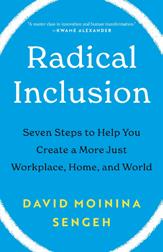 Eric Liebetrau is the nonfiction and managing editor.
Eric Liebetrau is the nonfiction and managing editor.

 Ed. by Brown, Jericho Amistad/HarperCollins (352 pp.)
Ed. by Brown, Jericho Amistad/HarperCollins (352 pp.)
$18.99 paper |
9780063278189
July 4, 2023A one-of-a-kind anthology featuring guidance and perspectives from acclaimed Black writers.
“Born out of absolute generosity and hope for the future of Black writing,” this collection of 31 essays and interviews, edited by Pulitzer Prize–winning poet Brown, features a who’s-who roster of Black fiction and nonfiction writers, poets, and essayists. Though the book is for “anyone who is a student of the craft,” its primary purpose is to inform and encourage emerging Black writers in particular. The text includes original essays from Daniel Omotosho Black, who examines the rhythm of Black vernacular; Jacqueline Woodson, who shows how to discern what characters want and how they’re going to get it; and Tiphanie Yanique, who contributes a piece called “Fiction Forms: How to Make Fun and Profundity Possible in Fiction.” The book also includes previously published works such as a 1979 interview with Ernest J. Gaines and Callaloo editor Charles Rowell. Some of the essays come with writing exercises, such as Crystal Wilkinson’s “Asking Questions and Excavating Memory: Creating Complex Fictional Characters,” while others focus on revision and how to read to become a better writer. Rita Dove begins her piece by noting, “I do not like how-to-write manuals.” Still, she decided to pen an essay to help writers “avert disaster” and to “extol the passion that drives the writing.” Brown’s collection is conversational, anecdotal, and collaborative in tone throughout. Divided into eight sections with titles such as “Who Your People?” “Where You At?” and “What It Look Like?” this isn’t your average craft book. It’s something exponentially better, more engrossing, and more easily applicable for writers in undergraduate and graduate writing programs as well as those in no program at all. A must-read treasure trove of practical wisdom for Black writers, writing teachers, and anyone interested in the craft.
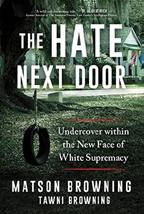
Browning, Matson with Tawni Browning
Sourcebooks (352 pp.)
$27.99 | July 4, 2023
9781728276625
A White police detective chronicles his time undercover with organized White supremacy groups.
Matson Browning’s firsthand experience working with White supremacists at local, national, and international levels makes for a largely gripping read, akin to
watching your favorite cop show on TV. In the introduction, Matson, writing with his wife, Tawni, states that the book is a history of groups like White nationalists, neo-Nazis, Christian identitarians, and other less recognizable supporters of an ideal Aryan nation, but the text reads more as a memoir mixed with organizational ethnography, touching on the histories of the groups but not the underlying causes of their creation and popularity. Matson saw the danger of organized White supremacy groups before it was considered a true threat, and through his foresight, he has managed to create a knowledge base that is likely unmatched. This includes the building of personal relationships with high-level members of influential hate groups, which he has leveraged into the Skinhead Intelligence Network. The scope of the book is ambitious. While there is a clear focus on Matson’s experience with specific groups and their major players, dwelling in equal measure on his successes and his regrets, there are also discussions of police push back, infiltration of White supremacists in law enforcement, and the failure of those systems to recognize and respond to the threats in their communities and within their ranks. In between chapter breaks

“A must-read treasure trove of practical wisdom for Black writers, writing teachers, and anyone interested in the craft.”
are news stories, distilled and reframed, of the violence that has been perpetrated in the name of White supremacy. The authors speak less to current movements and groups, but they touch lightly on a post-Trump America and its implications. They conclude with a guide to rehabilitating White supremacists, a glossary of hate terms and symbols to recognize, a “Where Are They Now” of racist organizers, and a reading group guide.
Knowledgeable, propulsive, and a bit terrifying, though a deeper analysis of hate in the U.S. would have been appreciated.
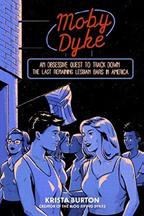
Burton, Krista Simon & Schuster (320 pp.)
$28.00 | June 6, 2023
9781668000533
The saga of a queer blogger traveling the nation in search of lesbian bars.
In the past couple decades, lesbian bars and clubs have become an endangered species. While gay bars have flourished, lesbian and queer women’s establishments are fewer and farther between. Burton, the creator of the popular blog Effing Dykes, recalls how vital these bars were to her in her younger days and how she has yearned for a chance to seek out other circles of queer folk, especially after the pandemic lockdown. The author writes with a bloglike familiarity, often employing stream-of-consciousness prose. Her overenthusiastic and quippy tone paints the book more as a memoir or think piece than a sociological case study. Readers expecting a datafilled, academic record will be disappointed. The book is more of a travel diary, with the author recounting funny anecdotes and personal revelations throughout. “Just me and my thoughts, heading to a lesbian bar near you!” she writes at the beginning of a journey filled with rental-car fiascos, tangents about karaoke, and other travel mishaps. Each chapter tells the tale of a different bar, sprinkled with comments from owners and customers about how the bar stayed open and how it has adapted for survival over the years. Apprehensive about approaching strangers, Burton sometimes forgoes the interview portion and focuses on her personal enjoyment in the club or bar. As a self-identifying femme lesbian, she writes about feeling excluded or presumed straight by others in the queer community. She investigates that emotional journey throughout her expedition alongside her larger quest for lesbian bars. Certain LGBTQ+ terms are explained concisely for those who may not be familiar with them. Using lots of capital letters, exclamation points, italics, and pop-culture references to get points across, the author presents a lighthearted, honest narrative about her messy adventure.
Fans of travel memoirs and Burton’s zealous personality will delight in this white-whale hunt.

Burton, Tara Isabella PublicAffairs (288 pp.)
$29.00 | June 27, 2023
9781541789012
A wide-ranging study of self-creation. Burton, a novelist, scholar of theology, and essayist, examines the idea that we have the power “to remake ourselves and our realities” to reflect our desires. Organized chronologically, from the Renaissance to internet influencers, the author’s investigation charts “an increasingly disenchanted world” in which humans lost faith that God created each individual’s unalterable personality. Rather, they came to believe in their own power of self-transformation. Burton cites German painter Albrecht Dürer, for example, as an artist who “forged a personality that sustained and advertised his work, even as his work—constantly emblazoned with his trademark—advertised the man. “Dürer-the-artist, Dürer-the-portrait, and Dürer-theadvertiser all mutually reinforced one another.” In Regency England, the “middle-class upstart” Beau Brummell saw fashion as a means to social and political influence. “The perception of the right people at the right time,” he understood, “was at the heart of this new avenue toward power. Perception was something that the clever and intrepid could learn how to shape.” Rather than reflect social station, fashion came to express individual personality as well as political identity. In 1859, acclaimed orator Frederick Douglass lectured on the “Self-Made Man,” asserting that work was the key to remaking the self. Burton’s well-populated history features figures such as Thomas Edison, “one of the canniest self-promoters”; the outrageous Oscar Wilde; and writer Elinor Glyn, inventor of the term it, defined as “a blend of raw sex appeal, Wildean dandyism,” and “quasi-magical personal magnetism.” The quality of “it” lay at the heart of a burgeoning celebrity culture. Perhaps the oddest group of selfcreators are extropians, “interested in optimizing every aspect of human existence, transforming the body into the best possible machine” through technology. The author concludes that our search for self-definition is ultimately a search for what it means to be human: vulnerable and inextricably interconnected. A thoughtful, well-grounded cultural history.
the marriage question
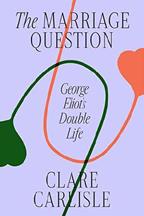
Carlisle, Clare
Farrar, Straus and Giroux (400 pp.)
$30.00 | Aug. 15, 2023
9780374600457
A highly illuminating portrait of the acclaimed writer’s evolution as a novelist and a wife.
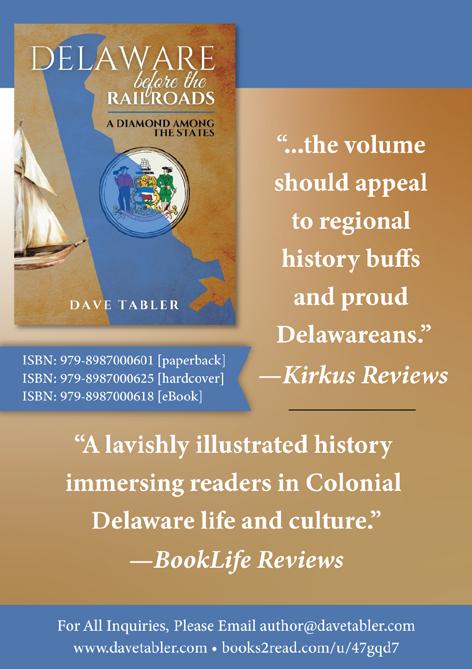
Carlisle, a professor of philosophy and author of Spinoza’s Religion and Philosopher of the Heart, digs into the unconventional relationship between George Eliot, who was born Mary Ann Evans, and her life partner, George Lewes. “How,” asks Carlisle, “does [the couple’s] defiantly idealized public image connect to the very dark marital interiors portrayed in [Eliot’s] novels, with their recurring scenes of ambivalence, brutality and disappointment? Do these scenes retaliate against the moralism that condemned their author, by smashing the façade of respectable marriage?” If this material sounds too dry or overly academic, not to worry. Carlisle’s ability to distill and connect ideas from such disparate fields as philosophy, theology, and literary analysis only brings Eliot into tighter focus. In addition to examining Eliot’s relationship with Lewes, Carlisle shows her in her artistic element, visiting with such luminaries as Herbert Spencer, Thomas and Jane Carlyle, George Sand, and Franz Liszt. As the author capably demonstrates, Eliot was determined to break away from the strictures of 19th-century British life and lead the fullest possible creative and emotional life. Much of this was made possible by Lewes, who, Carlisle reminds us, exerted abundant energy in buoying her up. “He was steadfastly cheerful,” writes the author, “through her recurrent depressions, relentlessly encouraging through her selfdoubt,” and “putting her work before his own…became a daily practice of devotion.” Carlisle’s descriptions of both Eliot and Lewes are engaging throughout. Regarding the latter: “Vigorous, bright, tenacious, not inclined to doubt or nuance: his personality flowed into his literary style….With his scruffy charm, dubious past, literary connections and bold ideas, he had a racy glamour.” Fans of literary history will savor this book.
Carlisle’s empathetic exploration of a unique relationship provides a clear lens through which to view Eliot’s life and work.

Clarke, Katherine Currency (416 pp.)
$30.00 | June 13, 2023
9780593240069
A gimlet-eyed look at the mega-skyscrapers that have been rising along New York’s Central Park.
The story of capital in the 21st century, writes Wall Street Journal reporter Clarke, is one of concentration in the hands of fewer and fewer people. As ever, many such people thrive on conspicuous consumption, and they find it in places such as One57, a massive city within a city that rose high in the Manhattan sky through the economic power of Saudi Arabian financiers. Other “copycat” structures have risen nearby, while
“A highly illuminating portrait of the acclaimed writer’s evolution as a novelist and a wife.”
predecessors have come and gone. One built by an aspirational developer named Harry Macklowe was an exercise in “amenityrich luxury,” with a comfortable waiting lounge for chauffeurs, around-the-clock catering services, a huge indoor swimming pool, squash courts, and even a wine cellar where collectors could house their prized vintages. Interestingly, Clarke writes, the Billionaire’s Row of her title, which runs along 57th Street, was once “a schlocky patchwork,” the locus of theme restaurants such as the Hard Rock Café and the Motown Cafe. When those restaurants failed in the Great Recession, developers began to buy up comparatively inexpensive properties through financial mechanisms that skirted regulations via sources that “included everything from private equity and hedge funds to sovereign wealth funds and ultra-high-net-worth individuals.” Some developers made fortunes, while others went broke; some outfoxed Donald Trump along the way. If most architecture critics hated the newly remade street, so, too, did many ordinary New Yorkers, for whom “the skyboxes for billionaires were simultaneously an object of fascination and loathing.” Clarke notes that while New York has pale imitators in places like Austin and Miami, it is far from being the world center of superopulent, supersized buildings, lagging well behind any number of Asian cities and with no sign of catching up anytime soon.
A revealing work of financial reporting in a time of staggering inequality.
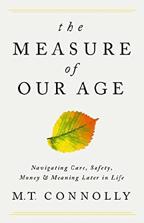
Connolly, M.T.
PublicAffairs (384 pp.)
$30.00 | July 18, 2023
9781541702721
A book about growing old and the indignities—many of them avoidable— that aging entails.
Connolly, former head of the U.S. Department of Justice’s Elder Justice Initiative, opens with the observation that in the 20th century, Americans added 30 years to their average life spans. Technology has helped, with family connections maintained by Zoom calls, uncooperative hips and knees easily replaced, and so forth, so that “for millions of people, there has never been a better time to be old.” People in their 70s report being happier than ever in the lives. Then come the 80s, when, as Connolly observes, some three-quarters of people suffer some “functional disability” that drastically reduces quality of life. Many of the attendant phenomena are structural and can be changed. However, most elder care is provided by unpaid family members, such as spouses and adult children, at an estimated annual loss of $522 billion in potential income. Those caregivers are often untrained, while facilities sometimes prey on patients. Regarding the latter, Connolly urges stronger policing and punishment, and she argues against the common practice of assigning full guardianship to non–family members.
As she writes, many of the societal woes that the elderly face are intersectional: Women face both ageism and sexism, while older minority members face racism and economic discrimination—to say nothing of worse institutional care generally, as the demographics of Covid-19 deaths in nursing homes attest. Throughout this lucid and thought-provoking treatise, Connolly offers thoughts on ways of improving life for the elderly, ranging from living in mixed-age communities rather than seniors-only retirement enclaves to applying psychotropic drugs to the treatment of anxiety and depression in hopes of finding “ways that mind-altering substances might alter the course of mind-altering diseases.”
A book that deserves wide attention and discussion among aging readers and those who care for them.
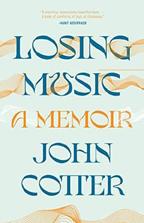
Cotter, John
Milkweed (320 pp.)
$26.00 | April 11, 2023
9781571311948
The author’s account of facing a lifechanging health issue.
In an affecting debut memoir, novelist and essayist Cotter recounts the health crisis that transformed his sense of self and connection to his world. Beginning in early September 2008, he experienced a ringing and roaring in his ears along with intermittent attacks of vertigo. He tried fad diets, meditation, and even a change in environment, moving from the East Coast to Colorado. Seeking medical help, he came away repeatedly frustrated: Doctors in Los Angeles, Boston, Denver—where he lived with his ever patient wife—and even at the Mayo Clinic were baffled and too often dismissive. “Why do we assume doctors can fix nearly anything?” he asks. “Why do we assume that even when cures aren’t around now, they’re around the corner, or a few years ahead?” Eventually, he received the diagnosis of Ménière’s disease—the same affliction that beset Jonathan Swift—for which there is “no reliable treatment, and no consensus on its cause.” As his symptoms worsened, Cotter became newly aware of the physical and social consequences of being disabled. “I’m white, male, cisgender—for someone in a position of such social privilege to find himself falling into any amount of marginalization is a shock,” he writes. He felt ashamed of his deafness, depressed by an increasing sense of isolation, and even suicidal. Hearing aids offered some amplification but hardly clarity. Although much improved over ear trumpets of the past, “hearing aids, no matter how advanced or how expensive—can’t entirely separate foreground from background.” Nevertheless, as the vertigo began to abate, they allowed him to return to teaching. Besides assorted adjunct classes, for a month, he lived and taught in a homeless shelter, where he found he had “plenty to learn from people so intimate with loss.” He and his students, he discovered, shared the language of pain.
A gracefully rendered, candid chronicle of trauma.
Coulter, Kristi MCD/Farrar, Straus and Giroux (384 pp.)
$29.00 | Sept. 12, 2023
9780374600907
A firsthand look at the jungle that is Amazon.com.
When Coulter began her career at Amazon in 2006, the company was a dynamic upstart, revolutionizing the way that books were marketed and sold. The author’s previous job in publishing had been safe but dull, and an offer from Amazon sounded like an opportunity to gain a foothold in an exciting business, with stock options. She soon realized that it was an extremely high-pressure environment, with impossible deadlines, endless streams of meetings, and unintelligible language and directives. It was also a very macho culture, with sexism hiding behind a screen of liberal pieties. Coulter liked the idea of blazing a trail but

started to wonder if the enormous personal cost was worth it. As the technology evolved and the company constantly expanded, the demands increased—and then increased again, until Amazon took over her entire existence. At the same time, Amazon was changing from a company that everyone loved to a behemoth that everyone loved to hate. Coulter offers a wide variety of horror stories about working with awful people on ethically questionable projects, but somehow she maintains a humor about the absurdity of it all. She realizes that she was trying to cope with the pressure by drinking too much but managed to stop before going over the edge (she addresses these issues in her 2018 collection of essays Nothing Good Can Come From This). Coulter eventually decided that she had to escape, although breaking the bonds turned out to be more difficult than anticipated. During her time there, she writes, “Amazon supplied me with a high-grade lunacy I didn’t know I needed until I touched it and my ambition bloomed like neon ink in water.” Thankfully, she eventually got over the fence, 12 years after signing on, and she left with her sanity and her soul largely intact.
With wry humor, Coulter provides candid insights about life, love, and gender as well as surviving a toxic workplace.

“With wry humor, Coulter provides candid insights about life, love, and gender as well as surviving a toxic workplace.”
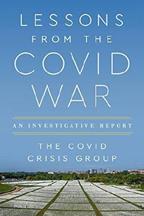
Covid Crisis Group
PublicAffairs (288 pp.)
$18.99 paper | April 25, 2023
9781541703803
A hard look at widespread failed governance during a global pandemic.
The Trump administration’s dismal response to the Covid-19 pandemic has been reported in numerous books and articles. The findings presented in this riveting analysis synthesize and go far beyond that material. The 34 members of the Covid Crisis Group, directed by Philip Zelikow, former executive director of the 9/11 Commission, and including prominent scientists, scholars, physicians, and public health experts, conducted 195 listening sessions with more than 270 participants, representing a broad range of expertise. Also drawing on their own background research, they offer an authoritative assessment of “the world war” against Covid-19, particularly in America. “No country’s performance,” they have found, “is more disappointing than that of the United States.” Although they agree that Trump “was a comorbidity” in the fight, his incompetence was not the only obstacle. The nation, they assert, “faced a twenty-first-century challenge with a system designed for nineteenth-century threats.” At the federal level, “confusion and friction” in myriad departments obscured “who was in charge of what problems.” Action plans emerged as “a jargon laden catalog of problems” and “statements of goals,” with “little in it about what people would actually do.” When the Trump administration threw responsibility to the states, it fell onto “a patchwork quilt of decentralized, detached, autonomous, and often contradictory operation plans and policies.” The nation sorely lacked a network of biomedical surveillance, which would have tracked the progress of the outbreak, testing results, and treatment protocols. Compared with Germany and South Korea, the U.S. evinced “splintered crisis management.” As the contributors clearly show, “what the Covid war exposed, what every recent crisis has exposed—even in Iraq and Afghanistan—is the erosion of operational capabilities in much of American civilian governance.” Crafting a system of national health security is crucial, where executive leadership is “aided by a much stronger core of trained, deployable public health regulars.”
An urgent, meticulously documented argument for better preparedness in future crises.

Curran, Thomas Scribner (288 pp.)
$28.00 | Aug. 8, 2023
9781982149536
A social psychologist shows how perfectionism can hold you back from real achievement and points the way out of the dilemma.
Curran, a psychology professor at the London School of Economics, shows how we are experiencing record levels of burnout, hypercompetitiveness, depression, and anxiety. The reason, he argues, is perfectionism, an impulse that runs through everything from work to personal attractiveness. It is relentless, impossible to satisfy, and inherently dangerous to mental well-being. Curran examines it from various perspectives and provides a self-diagnostic tool called the Multidimensional Perfectionism Scale. Many perfectionists think of themselves as highly productive, but that belief is not supported by the evidence. In fact, perfectionists often repeat the same task over and over again rather than looking for innovations and alternatives. They can also be intolerant of others, which is disruptive in the workplace and in relationships. Still, perfectionism is ubiquitous. We are constantly bombarded with messages telling us to be better, strive harder, and consume more. The filtered, glossy images of social media set impossible standards that cannot be met, although some people go to enormous lengths in attempts to do so. Curran offers solid suggestions on how to avoid the perfection impulse and move into “the Republic of Good Enough.” The best way is with measured steps, coupled with realistic goals and an understanding of where you actually want to go in your life. Unfortunately, he wanders off the point in the final chapter, when he discusses sociopolitical reforms like a universal basic income and progressive taxation. This section has a tinny tone that clashes with the sturdy research of the rest of the book. However, the author delivers many useful lessons and valuable insights, and that might be quite good enough.
Depression and anxiety are at epidemic levels; this book offers an alternative path to a fulfilling, productive life.
Davis, Wes Norton (368 pp.)
$30.00 | June 6, 2023

9781324000327
The story of an epic road trip of several American giants in August 1918.
In this somewhat nostalgic portrait of a lost rural America, Davis, author of The Ariadne Objective, portrays the touching friendships that sprang up among automobile tycoon Henry Ford, naturalist John Burroughs, inventor Thomas Edison, and tire industrialist Harvey Firestone as they took road trips together in Ford’s miraculous vehicle, exploring parts of rural America that had been largely inaccessible. The galvanizing relationship began in 1913 between Burroughs, then 75, and Ford, nearly 50 and enjoying a banner year for the Model T. Both men,
notes the author, were deeply influenced by the writing of Emerson, but they disagreed about the role of the automobile in American life. To Ford’s chagrin, Burroughs wrote in an article in Atlantic Monthly that the automobile “was going to kill the appreciation of nature”; Ford believed it would open up facets of America that most people could not access. In response, Ford sent Burroughs a new Model T, which indeed changed the old naturalist’s life by prompting him to set out on wide-ranging road trips beyond his Hudson River homestead. Meanwhile, Ford and Edison, who had both “imbibed” the rural values of the Midwest, and Firestone, “the head of the largest tire manufacturing concern in the country,” were long-standing friends, busy plotting numerous new business ventures. After a long lead-up that contains a few too many unnecessary details, Davis chronicles the memorable road trip of summer 1918, when the fast friends—who held wildly different views about the impending war—drove from the Allegheny range through West Virginia and into the “rustic magic of the Great Smoky Mountains,” all in the spirit of curiosity and exploration. A rare account of brilliant minds as they set off in search of America.

Matthew Pratt Guterl says he’s probably been thinking about writing his new book, Skinfolk: A Memoir (Liveright, March 28), since he was 5 years old.

That’s when his parents, Bob and Sheryl, who are both White, adopted his brother Bear from Vietnam, where the boy was endangered because his dark skin was a sign that his father was African American at a time when American occupation of Saigon was unpopular and quickly ending. Bear, who is only a month older than Guterl, is the second child his parents adopted but the first addition he remembers.
It’s also when his father started to talk about their New Jersey home as “a biblical ark for the age of the nuclear bomb, of race riots, of war” and his desire to have a family with “two of every race.” No wonder Guterl became fascinated with race and history—writing about racial profiling, Southern slaveholders, as well as the life of
Josephine Baker. He is currently a professor of Africana studies and American studies at Brown University.
Skinfolk is Guterl’s memoir of how his family of eight came to be and what it came to mean, both as some sort of racial experiment and as people who came to love one another despite their differences.
Guterl talked about why he wanted to write about his family and what they can teach others about diversity over Zoom from his home in Rhode Island. The conversation has been edited for length and clarity.
Where did the idea for this book come from?
I really started taking it up in earnest as a writing project during Covid. It was a moment where I didn’t have a lot of chances to see people. It felt like a good time to take up something new and different and try to work out my thoughts and feelings and put them on the paper.
How hard was it for you to apply academic rigor as a historian to your parents and their actions?
It was very hard. I think these things are so intertwined with who I am, and what I am now, in part because it’s the world that made me. I am an academic because I have always been thinking about these things, and I have always been thinking about these things because I grew up in this family. So there’s a complicated connection there between the work I do and the way I think about my family.
It was hard to talk to my mom. She was very courageous to talk to me as honestly as she did about a lot of what she and my father had attempted to do and very generous to give me access to her time and materials that had been in her basement. Once I got to actually doing the work, doing the writing, once I sort of opened up those old boxes and started going through the materials, then the historian’s instinct sort of kicked in. Then it was a matter of looking for evidence and looking for
patterns and checking them against my own feelings, my own memories, my own sense of things, and then trying to do justice to the story of our family.
Was it easier to look back at what you and your family had done through that historical lens?
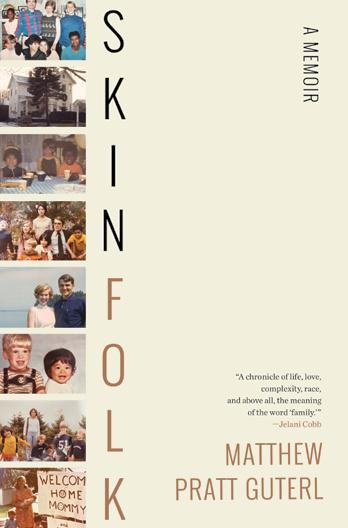
Absent a historical lens, your instinct is to look for intent and to try to find blame and to look for failures and mistakes. As a historian, there are no mistakes. Everything emerges out of a historical context and everything makes sense. For me, trying to understand what happened to us as a family, it was really easy to move from the early ’70s through the ’80s and come to an understanding about how history had changed in the country and had tilted in one direction. That helped me to understand the background context for a lot of what happened to us. It took me, at least a little bit, away from the question of responsibility, fault, and blame, which is how I think many people might write a story like this. It lets me see it with a historian’s eye and reminds me that context determines a lot of things.
Many memoirs are: “My parents really messed me up.” Or: “My parents messed up our whole family.” You’re not doing that.
I’m glad you say that. At the same time, I hold myself accountable in a number of ways. For me, it was very important to recognize the choices that I had made, even if I set them in context. Things that I did when I was 12 or when I was 13 really determined who I am and how I think about myself. I was trying to be fair and honest, so I also had a skeptical look at myself. It would be really easy to write a story like this and then just say, Isn’t this amazing that I grew up in this fabulous and fantastic family? And it surely made me into an amazing person. And that’s not what I wanted to say.
How did your family affect your views on diversity? We were a little multiracial democracy in the family, and we are still a polyglot democracy. We were uneven, and so is the landscape around us right now. To a certain extent, I’ve always been asking the question that we still ask nationally: What does it mean that we’re all here together? And how can we do this fairly and equitably and with justice?
But I think also as a kid I was wrestling with questions. I’m thinking about the moment I’m talking about watching movies with my brothers and sisters and keeping track of representations on screen. I mean, we were 8 or 9, and we’re watching all of these Black characters
come on the screen and routinely die in these action movies that my father loved to watch. I was feeling something for my brothers at the time—worried that they’d be depressed by the loss of so much Black life on screen or the absence of Asian life on screen. I think that is where we are today, nationally. I feel like we’re very attuned to missing populations. We have a heightened sensitivity right now about representation, and I feel like I always had that as a consequence of my siblings.
Your relationship with your brother Bear whom you write about being more popular in school, seems like an example of how we can all appreciate diversity. His arrival was a shock because I was 5 at the time that he arrived. We had almost the same birthday, and he was better looking, more athletic, funnier, and more interesting than me—and in so many ways that pattern continued for the rest of our lives, really. In high school, that was never a source of envy or jealousy. It provided me with a context to admire him on so many different levels—his dedication to being a superior football player, his commitment to reading, his humor. He was a real symbol for me of what a wonderful older brother and what an idol would be. And I think there’s some sense in the book that we should all have idols like that, irrespective of their skin tone or personal history.
regime change

Del Rey, Jason Harper Business (288 pp.)
$32.00 | June 20, 2023
9780063076327
Timely report on the ongoing clash between Walmart and Amazon for domination of the online marketplace.
When Amazon branched out from its initial bookselling business to become an online store for everything, it was bound to come up against the then-mightier Walmart empire. The trouble was, writes business journalist Del Rey, Walmart’s executives were “consumed by the massive revenue and profits associated with its Supercenters, and mostly ignorant to the threat and promise of the internet.” That uncomfortable position was antithetical to the operating premise of founder Sam Walton, who favored a decentralized system where local stores sold goods appropriate to the marketplace. On the other hand, Jeff Bezos’ growing empire had no practical constraints; it could sell everything, and its development of the Prime option of paying an annual fee for quick shipping outflanked anything Walmart could offer. Doug McMillon, a new Walmart CEO, turned some aspects of the business around to the extent that it was Amazon’s turn to play catch-up, including a grocery delivery service that Amazon abandoned only to start over by acquiring Whole Foods. In the end, both conglomerates fought each other in pricing wars that in the long term would have been unsustainable. Today, Del Rey writes, drastic cost-cutting is less common. While in one instance Amazon’s price for a 12-pack of diet soda was $10 more than Walmart’s, getting the latter would involve driving to the store, while the former would arrive at one’s door. Convenience versus price remains an issue, but regardless, the author concludes, surrendering the marketplace to a pair of mega-corporations doesn’t make for a healthy economy: “Outside forces—whether they be regulators, new startups, or labor groups—will still be necessary to apply pressure where the rivalry alone is not producing the best outcomes.”
An eye-opening look at a battle of corporate titans that shows few signs of slowing down.
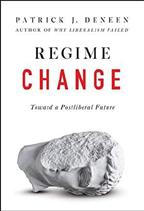
Deneen, Patrick J. Sentinel (288 pp.)
$29.00 | June 6, 2023
9780593086902
A manifesto against liberalism in favor of a “mixed constitution.”
According to political scientist Deneen, the author of Why Liberalism Failed, it’s the fault of liberalism, to which he assigns
a right and left wing, that urban elites scorn the farmers and factory workers of flyover country. It’s the fault of liberalism that no one goes to church anymore and that old-fashioned education has fallen to multiculturalism, identity politics, or any other ideology that “insist[s] that an individual or group’s perceptions of offense ought to replace appeals to any shared understanding of justice as a constraint upon tyrannical power.” That tyrannical power, of course, is the purview of the liberal elite, the people who don’t like Trump or Brexit. A little of this proposition that liberals hate “the people” goes a long way, and Deneen’s insistence that his so-called mixed constitution will level the differences between the elite and the masses is an assertion that longs for more convincing evidence. It’s unfortunate that one of the examples of family-friendly, birth-rate–promoting government that Deneen holds up is the far-right Orban regime of Hungary. It’s even more unfortunate that the conservatism it upholds is a counter to the “ethos of cosmopolitanism,” that last term being a historic antisemitic dog whistle, whether Deneen intends it that way or not. For his part, while Pope Francis may be a tad bit too liberal, Deneen seems quite happy at the thought of a Catholic state at whose vanguard is an aristocracy formed by “a kind of Aristotelian habituation in virtue.” One suspects that Deneen would find William F. Buckley too left-wing for the post-liberal regime he hopes will push aside the immoral, amoral politics of liberalism and reinvigorate “an exhausted Western civilization” through family, religion, and patriotism.
Just the thing for those who use the word woke without knowing what it means.
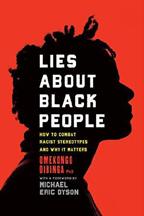
Dibinga, Omekongo
Prometheus Books (232 pp.)
$26.95 | July 15, 2023
9781633888784
How to identify and resist some of the most common and insidious racial prejudices.
“This book is designed for activists,” writes Dibinga, a professor of intercultural communication, and dedicated to “those who want to know not only what lies they were told about Black people but also why those lies were told and why those lies continue to be told.” The author provides a mix of analyses of the lineage of particular racial stereotypes, interviews with those who have endured discrimination, exercises for readers who want to assess their own biases, and even poetry articulating the author’s passionate take on the impact of bigotry and enduring faith in the power of education and love to overcome the evils of irrationality and hatred. One of the greatest strengths of the book is Dibinga’s frank engagement with the everyday expression—and destructive consequences—of racial assumptions. The author accessibly frames the features of contemporary stereotypes via historical precedents, and we never lose sight
“Just the thing for those who use the word woke without knowing what it means.”
of the topic’s intimate, urgent relevance to the psychological and physical well-being of Black Americans. Access to health care and fair treatment by the judicial system, for instance, are critically shaped by racial assumptions, and these assumptions are formed, in part, by the media we consume and its overt or covert insinuations about racial being. The author’s discussion of cinematic depictions of race is particularly incisive. Dibinga also provides illuminating commentary on the need for an evolving understanding of what genuine inclusivity would look and sound like. He reminds us that Blackness is a fluid social construct brought into being in relation to other racial categories. With serious, loving care, the author demonstrates, we can do much better in constructing that identity and in seeking a more just and vital social understanding. Michael Eric Dyson provides the foreword.
An astute, provocative survey of toxic assumptions about race and how to effectively challenge them.

Dickey, Colin Viking (368 pp.)
$30.00 | July 11, 2023
9780593299456
The author of Ghostland and The Unidentified returns with a colorful history of conspiracy theories in the U.S. Humans are disposed to seek order and explanation, but the world around us is a messy and unpredictable place. In this engaging book, cultural historian Dickey examines how conspiracy theories have been a way to deal with this tension. Most are harmless and a bit wacky, but others can metastasize into violence and persecution. The U.S. has a history of conspiracy theories dating back to the founding, and Dickey tracks theories about Freemasons, Catholics, and witches, among other groups. Most theories are based on the
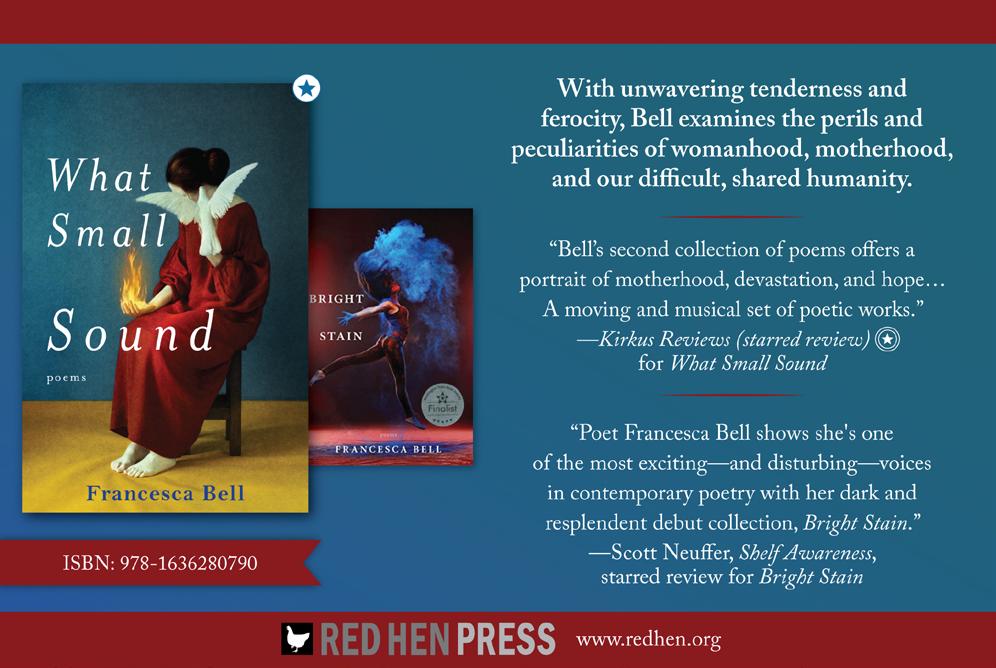
premise that a secret cabal is planning to undermine democratic institutions and personal freedom, or had already done so and was governing from the shadows. As society became more complex, many people felt an increasing desire for a single answer, a hidden paradigm that explained everything. Conspiracy theories are usually derived from a few pieces of evidence that are slotted together. Contrary material or alternate explanations are merely ignored or, in many cases, subsumed into the conspiracy itself. The internet, where anyone can say anything, was a boon for conspiracy theorists, both as a means to start new theories and to spread old ones. There are plenty on both ends of the political spectrum, but Dickey shows how, currently, the radical right has the edge in terms of number, variety, and silliness. The good news is that most conspiracy theories eventually burn out; the bad news is that they are quickly replaced. The best way to counter them, writes the author, is with common sense and hard-nosed skepticism. However, they are unlikely to disappear. “The idea that our day-to-day lives are determined far more by chaos than by human agency may be too much for many people to process,” Dickey concludes.
In an engrossing narrative, Dickey explains how the human search for purpose can become comical, weird, and/or dark.

Egginton, William Pantheon (368 pp.)
$30.00 | Aug. 29, 2023 9780593316306
An intellectual history centered on three men who expanded our understanding of what we can and cannot know about reality.
Egginton, a professor of humanities at Johns Hopkins and author of The Splintering of the American Mind, describes in detail how Immanuel Kant in the 18th century and Werner Heisenberg and Jorge Luis Borges in the early 20th century grappled with the widely accepted metaphysical prejudice that reality is “out there,” encased in rigid space-time coordinates and “conform[ing] to the image we construct of it.” For Kant, these basic but false truths interfered with the “necessary postulate of reason” that enables us to manage our personal lives and public affairs. Human thought, he argued, brings reality into existence, and our perceptions are merely “construct[s] in our minds.” For Heisenberg, reality becomes real when science “translates [it] into thought.” Our ability to know reality is thus saturated with the “ineradicable uncertainty” intrinsic to both observation and language. Additionally, Heisenberg’s quantum mechanics, together with Einstein’s Theory of Relativity, undermined the presumed fixity of space and time. Borges was poetic in his assessments, noting that “We…have dreamt the world,” and “the self’s experience of permanence and solidity [is] illusory.” Humans must “straddle
the impossible border between ephemerality and eternity, loss and permanence,” never fully understanding themselves but still having to negotiate between freedom and responsibility. All three men elevated free will over determinism and dispensed with the autonomous and omniscient self. Divine origins were also cast aside: Kant, Heisenberg, and Borges shared “an uncommon immunity to the temptation to think they knew God’s plan.” Egginton traces Kant’s influence on Heisenberg and Borges and situates the men in their historical contexts, discussing their personal lives, describing their seminal writings, and noting how their ideas emerged from engaging with others.
A challenging book that rewards those willing to suspend their prejudice about the fixed nature of reality.

El Rashidi, Yasmine
Columbia Global Reports (112 pp.)
$16.00 paper | July 11, 2023
9798987053508
An Egyptian journalist offers a brief, pungent dispatch from the vibrant youth music scene pushing against authoritarian dictates in her country.
A participant in the protest movement that convulsed Cairo during the Arab Spring of 2011, El Rashidi, the author of The Battle for Egypt and Chronicle of a Last Summer, has been a keen observer of the alarming crackdown on civil liberties in Egypt since Gen. Abdel Fattah El-Sisi took power two years later. The author follows several popular young hip-hop artists who continue to push against governmental boundaries and express ongoing revolutionary dissent. In a country where 60% of the population (65 million) is under the age of 29, the Arabic genre of hip-hop known as “mahraganat,” borrowing from American artists like Snoop Dogg, Tupac, Eminem, and Jay-Z, has been thriving. Marwan Pablo, one mahraganat artist who emerged from the street scene in the strictly conservative Islamic city of Alexandria, peppers his work with swear words and references to alcohol and had to go underground for a spell. As the author notes, he raps deeply emotional lyrics about “rising above the circumstances that plagued young men like himself, to buy himself freedom.” Expressing a general angst of disenfranchised young men, Cairo rapper 3enba became so popular that the government issued him a “syndicate” to perform, thus holding him on a tight leash. El Rashidi traces the beginnings of this musical trend in cybercafes, and she clearly shows the gravity of official condemnation and suppression of the work as blasphemy. The author’s interest in writing about this subject matter stems from her disappointment in her millennial generation, which, in the face of oppression, wilted. “These singers,” she writes, “have commanded my attention, even envy at first, precisely for their lack of inhibition—for their fierce assertion of independent, nonconformist identities….They did not cave in, as my generational peers did. They do not swallow their words.”
A vivid journalistic report.

Ennos, Roland Scribner (288 pp.)
$28.00 | July 18, 2023

9781982196523
Rotary motion may seem uninteresting, but it turns out to be worth understanding.
Ennos, a professor of biological sciences and author of The Age of Wood, points out that Isaac Newton derived his laws from studying rotary motion via planetary orbits. With some modification, circular movements obey his laws, but few scientists took note because 17th-century life and technology didn’t feature much spin. As both grew more complex during the following centuries, scientists struggled to explain rotational forces, making a surprising number of mistakes (which Ennos happily
points out). Beginning with the Big Bang, the author emphasizes that curved motion plus gravity formed the stars and planets, “so spin really did create both the heavens and the earth.” Traditionally, the invention of the wheel is considered the key landmark in the rise of civilization, although Ennos considers it overrated as a method of transportation until a much more recent development: roads. Regarding chariots, the author writes that “they would certainly have enabled wealthy aristocrats to be taken to the heart of battles without getting out of breath, but they would only have been practical on smooth, level battlefields, and so only suitable for stylized set combats.” Though wheeled vehicles have proven disappointing over the centuries, the principle of a circular disk whirling around a fixed axle has been vital to nearly all human machinery since the Bronze Age. By the 19th century, it had transformed the textile and metalworking industries and revolutionized transport, starting the process of globalization that continues to this day. Ennos divides the text into topical sections: spin related to the universe, to machines, and to the human body. Although generous with charts and pictures, inevitably, most of his
explanations require words, and readers with no scientific background may struggle to understand his written descriptions of high- and low-pressure turbines or how humans keep their balance. Nonetheless, there’s plenty to ponder.
A basic scientific concept receives long overdue attention.
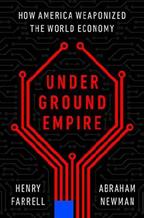
Farrell, Henry & Abraham Newman
Henry Holt (288 pp.)
$28.99 | Sept. 12, 2023
9781250840554
Two senior academics examine how the U.S. seeks to exert global power in the digital age.
Between them, Farrell, a professor at Johns Hopkins and member of the Council on Foreign Relations, and Newman, a professor at Georgetown, have a huge amount of expertise in foreign policy and international relations. In this collaboration, they adamantly assert that the U.S. is the supreme power in the world, dominating enemies and allies alike. The key is the effective control of critical elements of the world’s technological systems. Far from being a decentralized network, the information web depends on a relatively small number of “choke points,” most of them in American territory. Since 9/11, successive presidential administrations have used this situation as a tool for gathering intelligence and as a weapon for potentially cutting an adversary out of global communications. Connected to this is the domination of international capital flows, partly through economic weight and partly via forced compliance from banks and corporations. The authors have amassed a wealth of research material, but their overall argument is not entirely persuasive. After all, the idea of an empire—even an underground one— implies a high level of focused power, and anyone who examines U.S. foreign policy of the past two decades will quickly find failures as well as victories. Having power and using it effectively are very different things. Yes, pressure can be exerted through economic sanctions, but this does not mean guaranteed success. Russia still sits on a chunk of Ukraine; Iran has not collapsed; North Korea continues to make missiles; China continues to develop its surveillance state. As such, the global landscape is chaotic, adversarial, and unpredictable, as it has long been and will continue to be. Though the authors offer a number of intriguing ideas, the book is undermined by a persistent overstatement of its case.
Farrell and Newman are experts in their field, but this book will fail to convince many readers.
Ferguson, Jane Mariner Books (336 pp.)
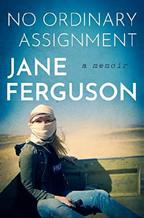
$29.99 | July 11, 2023
9780063272248
An award-winning war reporter recounts her remarkable career in some of the most dangerous places on the planet. Ferguson begins in Northern Ireland during the Troubles. Her childhood was marked by cold, anxious tension within her family and her country. However, this “stint on high alert” primed her for a career built through grit, moxie, and substantial risk: reporting from the epicenters of some of the most catastrophic conflicts of our time—in Afghanistan, Yemen, Somalia, Syria, Ukraine, and more. With vivid details and pointed reflection, her memoir draws readers into the world of war that exists beyond the “bang bang” of most news coverage. Chronicling her journey on bumpy mountain roads and through tense military checkpoints, embedding with soldiers and visiting makeshift field hospitals, Ferguson clearly demonstrates the devastating, oftoverlooked impact of war on civilians from every side. “There are always so many more,” she writes, “who suffer and die due to the unintended consequences of conflict: the collapse of economies and governments, and with these failures, the chances for any decent public health—sanitation, nutrition, or medical care.” She is an expert storyteller, conveying the fear and anxiety of her many harrowing close calls and the heartbreak of so many of her personal interviews. Her story of building a career in war reporting has an equally powerful arc, as she shows how she went from feeling like an impostor, plagued by doubt and shame, to a quietly confident professional. The author also goes beyond any adrenaline-junkie stereotype with frank rumination that grants space to grapple with heart-wrenching emotional confrontations as well as the moral complexities of her own role. While acknowledging the particularities of being a woman in her position, including the prevalence of double standards, she does not allow herself to be reduced to them.
A captivating, honest, and powerful attempt to do justice to the hardest stories to tell.
“An award-winning war reporter recounts her remarkable career in some of the most dangerous places on the planet.”
pp.)
$27.95 | June 20, 2023
9781324003793
A Houston native explores the city’s relationship to the storms that have posed a perennial threat to its existence.
In 2017, Fields, who works as a fly-fishing guide on the Missouri River, drove from Iowa to Houston. Though ambivalent about returning, the destruction wrought by Hurricane Harvey had “unlocked a spell of sudden and lucid conviction” that compelled him home. That journey became the basis of this book, about the people, such as land speculator Augustus Allen, and historical forces—like early-19th-century American expansionism—that created Houston from a “sucking bowl” of swampland. Accompanying Fields on his travels was a friend and fellow former Marine named Nigel. Together, they toured post-Harvey devastation by boat, observing how destroyed neighborhoods “seethed, in the humid, post-storm heat, like giant and filthy altars to loss.”
As the narrative develops, the “deep water[s]” against which Houston had always fought become a metaphor for personal pain and suffering. Fields reveals that Harvey provided “the neutralizing circumstance of real emergency” that allowed him and the “fierce and restless” bipolar mother from whom he had grown distant to “see each other freshly, without baggage.” At the same time, obligations created by the hurricane helped the author revive closeness with Nigel, who had tested him with years of maddening inconsistency. A year later, Fields returned alone to observe the lingering aftereffects of Harvey on the oil industry that had enriched Houston but also created refineries susceptible to toxic emissions, especially in the wake of massive storms. During such storms, writes the author, “most refineries and processing facilities shut down their monitoring systems, turning a blind eye to malfunctions.” In this brief yet memorable book, Fields creates an unsentimental yet poignant story that examines the complexities of one man’s homecoming. With eloquence and grace, the author investigates the interconnectedness of place, history, and identity.
A thoughtfully elegant, reflective work.
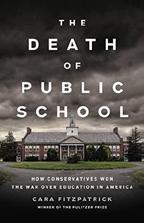
Fitzpatrick, Cara Basic Books (384 pp.)
$32.00 | Aug. 22, 2023
9781541646773
A Pulitzer Prize–winning education journalist follows the recent history of education movements in America.

In a landscape of declining trust in public schools, Fitzpatrick examines how public education has been radically redefined in the U.S. since the 1950s. From the South’s campaigns of “massive resistance” to desegregation that followed Brown v. Board of Education, she traces the country’s trajectory toward today’s understanding of “school choice.” Along the way, she delves into contentious movements for and against school vouchers, religious education, charter schools, and standardized testing along with these movements’ entanglement with racial biases, civil rights, church-state separation, and free market principles. Instead of the characters most regularly discussed in the media’s coverage of education—e.g., superintendents, school boards, teacher unions, and philanthropists enamored with charter schools—Fitzpatrick details the outsized influence of several less-familiar figures, such as the Jesuit priest Rev. Virgil Blum, Wisconsin state Rep. Annette “Polly” Williams, and conservative attorney Clint Bolick. Fitzpatrick’s substantial coverage of unlikely political alliances, granular explanation of legal battles, and detailed accounts of education legislation tempers the potential sensationalism of her subtitle: Rather than a tidal wave of conservatism, America’s current education system has been shaped by narrow wins, compromises, technicalities, and a few key pivotal moments—e.g., rebuilding the New Orleans school system in the aftermath of Hurricane Katrina. More textbook-style history than analysis, the book leaves Fitzpatrick’s driving questions about the role of individual liberty, government measurement and accountability, and the importance of education itself largely unanswered, and the narrative sometimes feels like more of a synthesis of materials rather than something new and incisive. Nevertheless, it is sure to be a valuable resource for anyone who studies public education, as the author offers sufficient context for divisions that went before and go beyond today’s partisan arguments over curriculum, merit pay, or online learning.
A cohesive study of America’s path to increasingly politicized—and privatized—education.
Flannery, Kate
Henry Holt (240 pp.)
$27.99 | July 18, 2023
9781250827289
A former clothing industry insider dishes on the anti-feminist excesses of a company she once embraced but then later called a cult.
When a stylish young woman offered Flannery a job with American Apparel, a company unfettered “by logos or politically correct tribalism,” she readily accepted. The opportunity seemed the perfect remedy to months of unemployment in her adopted city of Los Angeles and a perfect fit for her next job. The millennial females who sat behind desks in the corporate office or modeled American Apparel clothes in their stores made the company seem like a feminist utopia. Flannery’s first hint that all was not what it seemed came when she learned that the retailer’s free-spirited owner, Dov Charney, dated several of her colleagues and had once masturbated in front of a female journalist. At the time, however, the ambitious Flannery ignored what she saw and heard, choosing instead to seek her “true purpose” with the company. After she recruited a high school junior into the company, Flannery soon found herself flying all over the country to scout girls for different American Apparel branches. Suddenly, the colleagues who had earned their positions by sleeping with Charney became icons of sex-positivity rather than victims of sexism. Giddy with what she believed was her own self-made success, the author indulged in parties, marijuana, and casual sex with subordinates. Even as Charney found himself embroiled in sexual harassment lawsuits, Flannery, driven to maintain the LA life she loved, continued to support him and the ideology of anti-puritanism he used to control the women he used for sex and profit. As the author details her initiation into the realities of corporate misogyny, the author provides a disturbing look at the dangerous ways modern capitalism can debase, deform, and blind the individuals it exploits.
A candid and provocative memoir.
Good, Cassandra A.
Hanover Square Press (320 pp.)
$32.99 | June 6, 2023
9781335449511
A crisp account of George Washington’s stepgrandchildren and how they weathered the political shifting winds and preserved his legacy.
Although Washington had no children of his own, his marriage to Martha Dandridge Custis brought to his household a
new blended family thanks to her son’s four children. Good, a history professor at Marymount University and author of Founding Friendships, begins with an iconic portrait by Edward Savage. The painting featured the president and his wife in the presence of Nelly and Wash, two of the stepgrandchildren who were raised in the president’s home, and the author explains how the portrait helped create the reassuring image of what a first family should look like. Good painstakingly works through each of the four children’s lives: the headstrong girls, Eliza, Patty, and Nelly, who entered into strong marriages and made some political waves themselves; and Wash, who struggled in adolescence and dropped out of Princeton (George noted how he displayed “an almost unconquerable disposition to indolence in every thing that did not tend to his amusements”). All of the children were fierce protectors of their famous patriarch’s legacy, but they did not necessarily agree with Washington’s supposed intention to free his hundreds of slaves upon Martha’s death. Good offers a thoughtful discussion of Washington as a slave master, showing how many of the enslaved families had been torn apart and cruelly divvied up among Washington’s households. He never freed a slave in his lifetime. The Custises “chose to remain enslavers,” and Wash fathered several children with enslaved women (“a recognized and common reality” in 19th-century Virginia). Toward the end of this well-researched narrative, Good notes how “Americans defaulted to a definition of family that they still rely upon today: family was about blood relationships.”
An intimate and authoritative history offering a close look at the original first family.

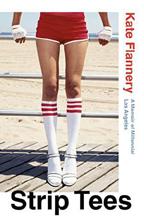

Goodell, Jeff Little, Brown (400 pp.)
$29.00 | July 11, 2023
9780316497572
A noted environmental journalist examines the effects of extreme heat on our lives and future generations.
In this gripping examination, Goodell, a Rolling Stone contributing editor and author of The Water Will Come and Big Coal, demonstrates the deleterious effects of rising temperatures and the frightening possibilities of what lies ahead if we don’t take immediate, globally coordinated action. Rather than simply providing scientific data to support his claims, the author provides an intimate look at the effects of our planet’s warming on individual lives. Among them is the heartbreaking story of Sebastian Perez, a migrant worker from Guatemala who succumbed to heat exhaustion while working in the fields of Willamette Valley, Oregon, a location once considered a refuge from extreme heat. Goodell argues for legislation to protect vulnerable outdoor workers from unsafe conditions; investigates how hotter weather will lead to a decline in food
“Yet another stark, crucial reminder that we are running out of time to save humankind.”
the heat will kill you first
production, which will make feeding the rapidly increasing global population more difficult; and looks at the decrease in mountain snowpack, which is already taking a toll on the water supply of the American Southwest. As the temperature of our planet continues to rise, we also face greater risks related to mosquito-borne and other infectious diseases. Rising temperatures increase the chance of ice-sheet collapse in the polar regions, resulting in rising sea levels and catastrophic damage to low-lying coastal cities. With the extreme weather conditions experienced in recent years throughout the world, including heat waves in Paris, prolonged drought followed by widespread flooding in California, and more frequent ice storms in Texas, climate change denial is no longer an option. “Making the necessary changes will be hard; it will require political leadership and a deeper understanding of our connection with one another and with the world we live in,” writes Goodell. “But it is not beyond our reach.”
Yet another stark, crucial reminder that we are running out of time to save humankind.
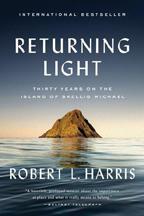
$29.99 | July 18, 2023
9780063268289
A memoir from the lighthouse keeper on a remote island off the southwest coast of Ireland.
Harris recounts his 30 years of parttime residency on Skellig Michael, a tiny, craggy pyramid more than seven miles off the coast of the Iveragh Peninsula. Despite its size, for the author, it harbors unlimited vistas onto nature and into the soul. Harris seduces with the lyrical opening pages, but the lengthy descriptive passages devolve into overly fanciful rhapsodies. Though he claims there are no words for the fleeting movements of light that play about the ruins of an ancient monastery or other parts of the island, the author never fails to tap oceans of words to express them. As a poet, Harris can be sublime, but his prose too often gets stuck in a single cadence, describing the same vistas and movements of animals over and over with little variation. He continually lets his imagination run away with him, investing both inanimate objects and living creatures with qualities they do not possess. It’s almost a shock when he suddenly comes down to earth and writes matter-of-factly about the island’s history and ecology, a respite from verbal pyrotechnics. To say Harris is imbued with the place is putting it mildly, but it’s not strictly a love affair. In addition to beauty, delicacy, and fortitude, he also shows nature’s indifference and a measure of spiritual darkness. One of the strongest features of the book is the author’s exploration of monastic histories, myths, and legends. Yet there are also wonderful personal interludes when he is transfixed by “magical” visitations, like a strange flight
of butterflies finding their way into his lonely hut, drawn by lamplight. The power comes from describing it simply.
Those enamored with the ethereal will be captivated; those with little patience for repetition are in for an endurance test.
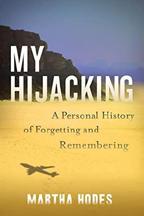
Hodes, Martha
Harper/HarperCollins (384 pp.)
$32.00 | June 6, 2023
9780062699794
A historian reckons with her own experience of a world-historical event.
As a professor of history at NYU and award-winning author of Mourning Lincoln and The Sea Captain’s Wife, Hodes has made a career out of examining the past. Here, she uses the tools of her trade to reconstruct an event from her childhood. In September 1970, 12-year-old Hodes and her 14-year-old sister, Catherine, were flying home to New York after spending the summer with their mother in Israel. Midflight, members of the Popular Front for the Liberation of Palestine took control of the plane and forced the pilot to land in the desert in Jordan. Hodes spent the next week wondering about her fate—and the next 45 years trying to forget the experience. This book records her attempt to know what she couldn’t remember and understand the global politics at play, which she could not fully comprehend as a child. Her search took her from her father’s storage unit to the State Historical Society of Missouri, where the airline’s archives are located, and to the desert where she was held hostage. As she read an old diary, Hodes discovers that she was erasing the worst parts of her experience even as they were happening. At the Swiss headquarters of the International Red Cross, she discovered a message her father wrote for her and Catherine that was never delivered, but most of the recollections she sought remained submerged. Eschewing a linear narrative, Hodes revisits the same events multiple times, as if another trip back to a particular moment will prove illuminating. The fact that such revelations fail to appear makes the narrative feel repetitious and sometimes superficial. The book is most interesting when the author writes candidly about the psychic burden of staying silent and the difficulty of excavating long-buried memories.
In a mixed-success attempt to understand her past, Hodes unearths trauma and contends with its aftermath.
waiting to be arrested at night

$32.50 | July 18, 2023
9781982173739
The riveting follow-up to The Fourth Turning
In 1997, entrepreneur and history buff Howe published The Fourth Turning with William Strauss. In that book, they laid out a clear cyclical pattern of Anglo-American history that occurs in units of 80 to 100 years, called a saeculum, which are further divided into roughly two-decade increments called turnings. The First Turning is a High, an upbeat era of strengthening institutions and weakening individualism when a new order arises. The Second, Awakening, is a turbulent era when the new order comes under attack. The Third is an Unraveling, a downcast era of strengthening individualism and weakening institutions when the order decays. The Fourth is a Crisis, when values change and another civic order moves in. Generous with specific examples as well as charts and graphs, Howe delivers a vivid chronicle of 700 years of Anglo-American saecula, emphasizing key events and four archetypes dominating each generation: Prophet, Nomad, Hero, Artist. According to the author, the current saeculum began after World War II, when the U.S. became confident and powerful but also bland and conformist. The second turning, the “Consciousness Revolution,” from the 1960s tumult to the tax revolts of the 1980s, featured personal liberation and increasing disorder. The third, the raucous “Culture Wars,” began as Reagan’s 1980s optimism peaked and “ground to exhaustion with the post-9/11 wars in the Mideast.” We are now embroiled in the fourth, the “Millennial Crisis,” which began with the global market crash of 2008 and continued with the rise of Donald Trump and authoritarian populism. This saeculum, writes Howe confidently, in the early 2030s, and its successor will feature a surprising number of positive features, including America’s continued global leadership. That history runs in cycles has always preoccupied a scattering of historians and attracted a fervent following. Skeptics may roll their eyes, but all readers should enjoy this wild ride by an entertaining writer who seems to have read every relevant source.
A fascinating work of global history and look to the future.

Izgil, Tahir Hamut
Trans. by Joshua L. Freeman
Penguin Press (272 pp.)
$28.00 | Aug. 1, 2023
9780593491799
A Uyghur poet recounts his family’s decision to seek asylum in the U.S.
In 2015, Izgil was an active member of a “tight-knit group” of Uyghur poets in the Chinese province of Xinjiang, where government oppression was intensifying. While producing a Uyghur TV series, Izgil was told he must not include the Muslim minority’s traditional greeting assalamu alaikum and its response, wa alaikum assalamu, in any of the show’s dialogue. While Izgil was confident enough to protest this rule, his ordeal was just beginning. He soon found himself driving a friend to a “study center” to drop off necessities for a relative whose crime against the Chinese government was simply that “he had received religious education for a period in his youth.” Although the government framed these centers as sites for reeducation, in truth, the buildings were “outfitted with iron doors, window bars, and barbed wire,” and those who entered were not allowed to leave. As the situation deteriorated and more and more of their Uyghur friends and neighbors disappeared, Izgil and his wife realized that the only way to protect their daughters from fear and suffering was to move to the U.S. “Even if our daughters graduated from China’s top universities,” writes the author, “as Uyghurs they would inevitably face constant discrimination in their careers and in daily life.” Leaving China, however, was no easy task, logistically or emotionally. When they finally landed on American soil, Izgil remembers, “Even with a new world before us, my thoughts wandered constantly back toward home.” The text is lyrical, heartfelt, and perfectly paced; the narrative unfolds with a slow, simmering burn. Never shying away from vulnerability, the author shines a much-needed light on the complex, contradictory emotions of trading a homeland for a lifetime of both safety and survivor’s guilt.
A profoundly moving memoir about China’s oppression of the Uyghurs.
Jacobs, Sally H.
St. Martin’s (304 pp.)
$32.00 | Aug. 15, 2023
9781250246554
A noted journalist chronicles the tumultuous life of the first Black American tennis superstar.
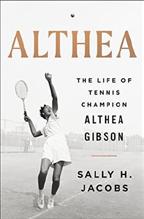
Jacobs, author of The Other Barack, presents a comprehensive and elegantly written life of Althea Gibson (1927-2003), one of the greatest athletes America has produced, capturing the considerable triumphs and obstacles she met throughout her life. The author is particularly adept at describing the personal and social conditions in which Gibson rose. An abused daughter languishing on the streets of Harlem during the Harlem Renaissance and the Depression, she flourished on the court, breaking the color barrier and rising to the top in the wealthy White sport of tennis. Jacobs also describes the contributions of Gibson’s supporters and benefactors, who made her Grand Slam championship career possible, including Sugar Ray Robinson, several top women players of the day, and Hubert A. Eaton and Robert W. Johnson, civil rights leaders and tennis aficionados who instilled discipline, refinement, and excellence in her game and life. Jacobs writes compellingly and sensitively about societal pressures that the complex and multitalented Gibson endured, including from an often critical Black press (that sometimes trafficked in rumors about her sexuality), to not only excel on the court, but to stand at the forefront of the mid-20th-century Civil Rights Movement despite her natural reticence about such matters. Gibson, writes the author, “let her success…speak for her and for the potential of her race, rather than her raised fist.” As Jacobs demonstrates, such success paved the way for Black players such as Arthur Ashe, Zina Garrison, and Venus and Serena Williams. The author profiles Gibson in full, including her stint with the U.S. State Department, her magnanimous contributions to youth tennis instruction, and the loneliness and financial difficulty of her later life. The book is a fascinating study of Gibson through the prism of 20th-century America. An essential book about an incomparably authentic American pioneer and the times in which she lived.

who engineered it, at the end as at the beginning.” This is the throughline for most of the book, until tensions over Roosevelt’s 1912 presidential run as an independent candidate for the “Bull Moose Party” caused a disruption in—but not an end to—their friendship and political partnership. Jurdem notes that he relied on previous biographers to fill in aspects of both men’s lives even as he delved deeper into their extensive correspondence. By moving beyond previously published and highly edited versions of the correspondence, the author sheds new light on the intricacies of the Roosevelt-Lodge friendship. At times, this laser focus results in a neglect of necessary historical context. For instance, Jurdem references the press coverage of “atrocities” that U.S. troops committed in the Philippines, but he never provides details about those atrocities for readers who may not be familiar with the controversy that erupted in 1902 when “a classified report detailing the behavior was released.” While the author keeps the narrative moving at a brisk pace, he sacrifices depth for breadth, leaving readers wanting more detail about these men and their times as well as further analysis of their lasting impact on American politics.
A fast-paced but uneven account of a significant personal and political friendship.
How Snob Zoning, NIMBYism, and Class Bias Build the Walls We Don’t See Kahlenberg, Richard D. PublicAffairs (352 pp.)

$30.00 | July 11, 2023
9781541701465
Henry Cabot Lodge,
Jurdem, Laurence
Pegasus (400 pp.)
$32.00 | July 4, 2023
9781639364411
A tale of two U.S. politicians and their struggles to obtain and keep power.
Jurdem, author of Paving the Way for Reagan, documents the decadeslong relationship between Theodore Roosevelt and Henry Cabot Lodge, offering glimpses of both men at their best and worst as they made decisions that impacted American domestic and foreign policy. The author reveals the significant ways in which Lodge maneuvered behind the scenes and spoke out to enable Roosevelt’s political ascension as well as how Roosevelt publicly and privately acknowledged Lodge’s role in his success. Upon Roosevelt’s 1897 appointment as assistant secretary of the Navy, Roosevelt noted, “Of course, it was Lodge
Provocative study of how institutional measures reinforce inequality of opportunity in housing and other aspects of daily life.
Across the U.S., writes attorney and activist Kahlenberg, “zoning laws prohibit the construction of multifamily units” that are economically accessible to low-income families. Many municipalities issue regulations on minimum lot sizes, again sorting out the cash-poor who might be able to afford small homes on small pieces of land. The effect, Kahlenberg argues, is that, while to all superficial appearances overt racial discrimination is declining, economic discrimination is rising—and economic discrimination, of course, disproportionately affects minorities, and it’s entirely legal. The result, one researcher concludes, is “incipient class apartheid.” What the author calls “snob zoning” is an obstacle to equal opportunity: It not only blocks those of lesser means from large parts of any given community, but also discourages the ability to purchase a home and build the intergenerational wealth that comes from equity. Kahlenberg notes that districts with the highest rates of postwar Black migration are those with the most stringent regulations, as with one San Jose–area suburb that for years has forbidden anything but single-family-home construction. While the author allows that “some zoning regulations are essential” and that reforming discriminatory zoning
laws is not the only remedy, it would make a good start, especially in a time when home ownership has lost some of its previous political clout. As evidence, Kahlenberg cites Trump-era cuts in mortgage-interest deductions even as Trump warned that Biden’s policies, if elected, would “allow ‘low-income housing’ to ‘invade’ suburban neighborhoods.” Suburban voters didn’t bite, and the author holds out hope that they will be amenable to further zoning reforms that, as he notes, would have the effect of building more diverse communities, which would promote “a more cohesive, less polarized democracy.”
A thoughtful, worthy argument for fair-housing reforms that are truly fair.
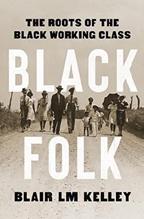
Kelley, Blair LM.
Liveright/Norton (304 pp.)
$30.00 | June 27, 2023
9781631496554
A study of Black workers from enslavement to the present.

Award-winning historian Kelley, director of the Center for the Study of the American South and author of Right To Ride, provides a powerful counter to the assumption that the term working class refers only to Whites. Rather, she argues convincingly, Black workers have been the nation’s “most active, most engaged, most informed, and most impassioned working class.” Rooted in her family’s stories—she is the descendent of enslaved people—Kelley’s history draws on census data and archival sources, as well, to offer vivid portraits of Blacks working as laundresses, porters, domestic workers, and postal carriers. She begins with Henry, her earliest identifiable ancestor in her maternal grandfather’s line, who was enslaved as a boy and picked cotton and became a blacksmith as an adult. In 1865, he was freed to make his way in the working world, and in 1867, he registered to vote. Although Blacks often were relegated to menial jobs, they established vibrant and supportive communities for their families and at work. Kelley recounts bold efforts to resist exploitation. In 1898, for example, laundress Callie House led the establishment of the National Ex-Slave Mutual Relief, Bounty and Pension Association, which called for reparations due to Blacks for unpaid work during slavery; although short-lived, it presaged future calls for reparations. In the 1920s, many Blacks joined the Great Migration from the South to the North, Midwest, and West. Women aspiring to office or factory jobs usually found only arduous, demeaning domestic work—at least until World War II opened more opportunities. Black men were in demand as porters. Overworked and underpaid by the racially segregated Pullman company, they established the Brotherhood of Sleeping Car Porters, the first all-Black railway union. The history of Black workers, Kelley asserts, is a continuing fight for “justice, fair pay, union representation, secure housing, and equal citizenship.”
A well-researched, engaging, corrective American history.
Kim, Peter H.
Flatiron Books (256 pp.)
$28.99 | Aug. 15, 2023
9781250838155
A social scientist argues that we should trust that the things that bind us are greater than the things that divide us. Despite the importance of trust in every area of our lives, we rarely think about it deeply. Kim, a professor of management and organization at the University of Southern California, has made it his life’s work, and this book examines the subject from a variety of perspectives. He notes that many societies around the world have become less trusting in the past decades, but in the U.S., distrust has reached epidemic levels. Americans have become prone to believing rumors, gossip, and accusations even when they suspect they are unfounded. Now, the default position, Kim suggests, is to think the worst of anyone outside our inner circles. The reasons appear to be connected to the emphasis that the media, including social media, place on the negative. Kim differentiates between competence distrust, where we do not believe someone is capable of doing what they say they will do; and integrity distrust, where we believe that someone is trying to mislead and damage us. Integrity distrust is the more dangerous, although it is often a matter of perception rather than reality—and this points to possible ways to rebuild trust. The offended person has to accept honest differences and be willing to forgive when no offense is intended. Kim admits that some people are simply not worth trusting, but his point is that most are, and we should be aware of the costs of forever remaining offended. Equally, the offender must be ready to make a genuine apology and make appropriate amends. This change of mindset is not easy, and Kim believes that each person must make that journey for themselves. But it is well worth the effort—and necessary if we hope to escape the distrust trap.
A thoughtful, well-researched study of a “critical foundation” of society.

Kitagawa, Kate & Timothy Revell
Morrow/HarperCollins (352 pp.)
$32.99 | Aug. 15, 2023
9780063206052
A fine history of mathematics that seeks to decouple it from its traditional Eurocentric focus and usually succeeds.
Kitagawa, a leading historian of mathematics, and Revell, a “lapsed mathematician” and U.S. editor for New Scientist, note
“A well-researched, engaging, corrective American history.”
black folk
that the discipline of mathematics began as tallying, the beginning of which is lost in history. However, anthropologists have turned up 20,000-year-old bones covered with regular notches that may or may not indicate that someone was counting. After a quick review of early civilizations—Babylon, Egypt, Assyria, Maya, Greek—the authors devote large sections to China and India from ancient to near-modern times and to the Arab world after the rise of Islam. Until the appearance of decimals, a base10 number system, and the concept of zero, during the first millennium, all of which make calculation easier, pre-modern mathematicians were limited to simple arithmetic and bookkeeping, but they accomplished amazing things. They could predict eclipses, measure the length of a day within seconds, and determine pi to eight decimal places. The Pythagorean theorem was proven long before Pythagoras, and the concepts behind calculus appeared during India’s golden age. The authors demonstrate that the scientific revolution was not strictly a European invention because science had been advancing throughout history. “Many ideas that turn up in the ‘Scientific Revolution’ had already been explored elsewhere or were the culmination of incremental steps made by others,” they write. What changed was the idea that humans were ignorant and that knowledge would encourage progress and make life better. Ancient cultures assumed that everything important was already known. Pre-modern mathematicians solved practical problems and were considered experts on calendars (essential for religious ceremonies), but mostly mathematics was admired as a mark of superior culture in the same class as poetry and philosophy. No one expected math to change the world; Galileo, Newton, and Einstein did that.
A solid corrective to a host of misunderstandings about math.
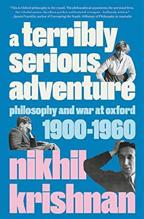
Krishnan, Nikhil
Random House (400 pp.)
$28.99 | July 4, 2023
9780525510604
Parsing the language of philosophy.
In his debut book, Krishnan, who holds a doctorate in philosophy from Oxford, brings wry wit and adroit observations to his investigation of the rise of analytic, or linguistic, philosophy at his alma mater. A department staffed by idealists, realists, and one pragmatist—F.C.S. Schiller—was shaken up by influences from near (Cambridge) and far (Vienna), and questions of meaning and language rose to new importance. “The special business of philosophy,” Krishnan writes, “was to scrape away at sentences until the content of the thoughts underlying them was revealed, their form unobstructed by the distorting structures of language and idiom.” Analytic philosophy, its adherents believed, would foster “particular virtues” that Oxfordians held
dear: humility, self-awareness, collegiality, restraint, elegance, concision, and directness. Krishnan chronicles the transformation, and the energetic debates it inspired, by focusing on salient figures, beginning with the “pipe-chewing, no nonsense” Gilbert Ryle, who, while at Oxford, became acquainted with G.E. Moore and Wittgenstein at Cambridge and discovered Husserl and Heidegger. His classmate A.J. Ayer, “whose greatest non-philosophical interest was women,” also studied in Vienna, where he encountered the American logician Willard Van Orman Quine and philosopher Ernest Nagel. Émigrés such as Isaiah Berlin, Ernst Cassirer, and Theodor Adorno brought ideas from Europe directly to Oxford. By the late 1930s, there were women involved, as well: Mary Scrutton, on scholarship; the fiery Elizabeth Anscombe, who pressed her colleagues to consider ethical consequences of their positions; the quietly sensible Philippa Foot; and the defiantly bohemian Iris Murdoch, who introduced British readers to Sartre. Beginning in the late 1950s, the likes of social critic Herbert Marcuse and New Left Review editor Perry Anderson critiqued the Oxfordians for being insular. Nevertheless, for four decades, they had carried out a formidable task: “to explain what we mean by what we ordinarily say.”
A lively, well-researched intellectual history.

Leland, Andrew Penguin Press (368 pp.)
$28.00 | July 25, 2023
9781984881427
Musings from the border between the countries of the sighted and the blind.
While he was in college, journalist and podcaster Leland, an editor at the Believer, was diagnosed with retinitis pigmentosa, a degenerative eye condition leading to blindness. As he began writing this book, 20-some years later, his vision had deteriorated to the point that he sums up his status to a new blind acquaintance as “legally blind, using a cane, but still reading print.” This memoir recounts the author’s attempt to navigate the titular land, which, for him, is “no longer a legendary, proverbial sci-fi country [but] instead…a real place, populated by real people.” He continues: “My hope is that…the sighted reader [will] likewise discover the largely invisible terrain of blindness, as well as other ways of living and thinking they might not have previously considered.” His exploration touches on cultural perceptions of blindness (“a tour through the Western canon,” he remarks with some acidity, “offers a highlight reel of blind abjection”); the socioeconomics of blindness; assistive technologies; learning to read braille as an adult; the elusiveness of treatment for RP, and more. In the process, Leland provides both fascinating capsule histories of the topics he’s pondering, as with a survey of the disability rights movement, and searching glimpses into his own existential struggle to understand what it means for him to be blind.
A discussion of racism and homophobia within the National Federation of the Blind, a leading advocacy group, reveals some uncomfortable truths. (Though much of Leland’s exploration is mediated by the NFB, he takes care to explain that its advocacy has its detractors.) When the author gets personal, he does so with such honesty and vulnerability that by the end, readers will understand when he concludes, “The process of retinal degeneration has turned out to be one of the most generative experiences of my life.”
Emotional but never sentimental, this quest for insight delivers for its readers.
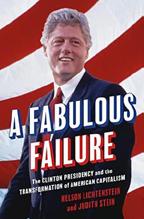
Lichtenstein, Nelson & Judith Stein
Princeton Univ. (504 pp.)
$39.95 | Sept. 12, 2023 9780691245508
How the moderation of the Clinton era sowed a legacy of problems.
Academics Lichtenstein, author of State of the Union: A Century of American Labor, and Stein, author of Pivotal Decade: How the United States Traded Factories for Finance in the Seventies, approach their subject from the left side of the political spectrum. In this collaboration, they revisit the years of the Clinton administration, wondering why it moved so far from the quasi-socialist views of its early days to embrace a globalist neoliberalism that helped Wall Street more than Main Street. In the opening section of an overlong text, the authors offer an adequate review of the ideological development of Clinton and many figures within his administration, but this story has been told many times, including by Clinton himself. Lichtenstein and Stein are reluctant to criticize the Clinton years, so instead they focus on identifying a wide range of villains. They are initially unsure whether the Republicans who opposed Clinton’s early agenda were stupid or evil; eventually, they opt for both. They blame centrist Democrats. They blame the voters who handed control of Congress to the GOP in 1994. They blame various billionaires. The media. Larry Summers. Al Gore. It’s a long list. The authors believe that if Clinton had stayed on the left, and even marched further out to the edge, he would have won huge electoral support. However, that scenario didn’t seem likely then, and it does not seem likely in hindsight. The bigger question, however, is, why are the authors rehashing these events? If Lichtenstein and Stein are calling for a return to the days when big labor told the Democratic Party what to do, it does not sound like much of a way forward. The book may appeal to those on the left who are fascinated by their own myths, but other readers may take a pass.
A progressive perspective on why the Clinton administration delivered so little.
Ed. by Madfis, Eric & Adam Lankford
Temple Univ. Press (362 pp.)
$34.95 paper | June 16, 2023
9781439923139
A collection of academic essays on the American penchant for mass shootings.

Americans commit a disproportionate number of mass shootings, far greater than other societies even where private gun ownership is permitted, such as India and Switzerland. The contributors to this volume, edited by criminal justice professors Madfis and Lankford, seek to understand what elements in American society fuel this murderous streak—which, as one notes, has only grown in recent years, at least in some measure because of the widespread availability of not just guns, but also large capacity magazines. Banning those “may prove a more effective intervention for mass shootings than restrictions on assault weapons.” Whereas it is a popular trope among gun advocates that mental illness is the real issue, as criminologists Jillian Peterson and James Densley write, its symptoms are likely less important than other indicators, such as “stress, unemployment, relationship struggles, violence, and trauma.” Besides, they add, only 5% of violent crimes are committed by “people with serious mental illness.” So who are the shooters? As several contributors provide data points to show, they are often White males who are sexually insecure, have likely been ridiculed or bullied, and have easy access to weapons. Older mass shooters tend to hold White supremacist beliefs, while younger ones are more likely not to be particularly ideological. Whereas “three overlapping groups—gun owners, Republicans, and conservatives” insist that there’s nothing that can be done to stop mass shootings, several of the authors suggest that this isn’t so. For instance, reforming an educational system that reinforces social isolation, bullying, and untreated trauma might “lead the way to a less violent society with far fewer mass shootings and other pathologies.” More immediately, and predictably, many contributors call for stronger measures to restrict the availability of military-grade weapons to civilian buyers.
A useful work of scholarship in documenting American lethality.

Mahfouz, Sola &
Malaina KapoorBallantine (320 pp.)
$28.00 | June 6, 2023
9780593359761
An inspiring memoir about escaping repression, violence, and protracted war. Writing under a pseudonym to protect her family, Mahfouz, who now lives in the U.S., recounts her eventful life story to Kapoor, a writer and producer of the radio public affairs broadcast “In Deep.” Born in 1996, just two years after the rise of the Taliban, Mahfouz grew up under an oppressive regime. “In the name of Islam,” she reveals, “the Taliban banned television, music, games, photographs, and most schools.” Women were forced to wear the burqa, which completely covered their faces and bodies, and they could not walk alone in public. Although her parents—her mother had been a college teacher—hoped she would get an education, when she was 11, two men came to her house, threatening to burn her face with acid if she continued to go to school. Suicide bombs and rockets made daily life “brutally dangerous.” In Kabul, the Taliban transformed a soccer stadium into a public execution arena, where killings took place in front of spectators. By the time she was 13, Mahfouz rarely left the house. She felt pressured to make an early marriage but resisted what she believed would mean “the death of my personality, my independence, my girlhood.” Determined to break free, she taught herself English and then discovered classes at Khan Academy, from which she learned math, science, and literature. On Skype, she connected with Emily, an American, so she could practice speaking English, and soon the connection turned into friendship. Desperate to earn the credentials needed to apply to colleges in America, Mahfouz tried to find ways to take an SAT and language proficiency test only to be turned down by Afghani and Pakistani authorities. The author describes Emily’s resourceful help on her behalf as well as her own dogged pursuit of an escape from the atrocities that consumed her homeland—exacerbated after the Americans’ hasty withdrawal of troops.
A moving debut memoir of courage and persistence.
Martin, Rachel Louise Simon & Schuster (384 pp.)
$29.99 | June 13, 2023
9781665905145
Historian Martin recounts an opening salvo in the 1950s push to desegregate public schools.

In the years before 1955, Clinton, Tennessee, had a Black enclave whose high school–aged youth were bused an hour into Knoxville each day. When the U.S. Supreme Court ruled that desegregation should occur with “all deliberate speed,” Clinton complied, if reluctantly. That move was fraught: On one side stood a small number of Black civil rights activists and a few White allies, on the other was a sizable contingent of KKK members, segregation-forever types, and ordinary citizens resistant to change. There were a few surprises in the standoff as well. Some White students, including members of the football team, stood up for their new Black classmates, while Gov. Frank Clement, who sent in the National Guard to restore order even as he insisted that he was not an integrationist, argued that if the anti-Black mob “can take over Tennessee because of one issue, they can take it over others.” Early on, violence was threatened but mostly averted, but then “outside agitators,” as the saying has it, entered the picture, with some supposed anti-integrationists working the anti-Black mob for money and others planting bombs, one of which destroyed the old Clinton High and resulted in a highly publicized trial. The verdict went against the perpetrators, an outcome no one would likely have predicted. As Martin writes, “What white Southern jury had ever incarcerated other white Southerners for maintaining racial order?” At the end of her wide-ranging history, based on extensive interviews with contemporaries, the author explains that despite such turns of events, the wounds of that time have yet to heal, and the monument erected to commemorate Clinton High’s desegregation, she notes pointedly, “fails to note that the fight for integration has yet to be won.”
A timely contribution to the literature of the post–Brown v. Board Civil Rights Movement.

Matthews, Hannah
Atria (352 pp.)
$18.00 paper | May 2, 2023
9781668005255
An “abortion care worker” describes an ecosystem of activists working toward reproductive justice.
“Forget the abortion care we need,” writes abortion doula, mother, and clinic worker Matthews. “What is the abortion care we dream of? How can we…sustain that dream care, in our own communities?” In this powerful treatise, the author examines the status of American abortion before and after the Supreme Court’s decision to overturn Roe v. Wade in 2022. Matthews starts her exploration of reproductive justice—a term coined by women of color that describes the set of conditions necessary for pregnant individuals to be able to both give birth to and raise children in peace and safety—with the story of her own abortion, which required both pills and an “in-clinic procedure” to complete. Using this experience as context, the author
introduces readers to her community of abortion care workers, which includes fund providers, who connect individuals who need abortions with the money necessary to do so; herbalists who create homemade abortifacients for communities with little access to clinics or drugs; Muslim and Jewish leaders who consider abortion to be holy; and self-described witches, who create ceremonies to release the pain abortions sometimes cause. Throughout, Matthews strives to center the knowledge and narratives of Black and brown practitioners because they not only bear the brunt of reproductive violence; they also come up with some of the most creative solutions to patriarchyinduced problems. The result is a text that substantially widens our ideas of what abortion does, can, and should look like. The author’s tender voice exudes knowledge and forgiveness, turning a controversial topic into something bordering on cozy. Though the prose is occasionally overwritten, the narrative reflects a refreshing paradigm shift, providing a comprehensive view of abortion in modern America.
Volume 1
McPhee, John Farrar, Straus and Giroux (192 pp.)
$27.00 | July 11, 2023
9780374603601
A collection of articles published, in slightly different form, in the New Yorker over the past few years..

“I decided to describe many…savedup, bypassed, intended pieces of writing as an old-man project,” writes McPhee, longtime New Yorker contributor and author of more than 30 books. “Doing such a project as this one,” he continues, “begets a desire to publish what you write, and publication defeats the ongoing project, the purpose of which is to keep the old writer alive by never coming to an end.” Among the many subjects the author covers in this first volume are the impression left on him by an exchange with Thornton Wilder almost 60 years ago, which served as the impetus for this project; assorted experiences as both student and professor at Princeton, including his plan to write “about workouts with varied coaches in various sports over the years, but I never got around to it”; the life and times of Woodrow Wilson, who briefly coached football at Wesleyan and “appointed the first Jew to the faculty” at Princeton and “literally turned [it] into a university”; and his thoughts on titles. “I can wax polemical on titles,” he writes. “Editors...seem to think titles are like chicken heads. They can cut them off without additional effect on the C.V. of the chicken. They can replace each one with their own idea of the head of an improved chicken.” Throughout, McPhee reflects on his writing career, explaining why he did or did not follow through on projects about a wide variety of concepts. Now in his early 90s, he occasionally quotes himself. The cogency, potency, and temperance of his voice never
waver, no matter where he meanders. One of the strengths of this collection is that McPhee maintains both momentum and interest—including, not least of all, his own.
A gem from an exemplar of narrative nonfiction.
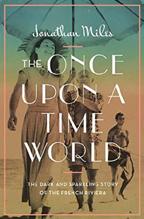
The Dark and Sparkling Story of the French Riviera
Miles, Jonathan Pegasus (464 pp.)
$29.95 | Sept. 5, 2023
9781639364954
For a small slice of geography, the French Riviera has cast a long shadow, and it is one of wealth, style, and decadence.
Miles, the author of a string of well-received books, describes The Once Upon a Time World as “the second volume of an informal trilogy dedicated to phenomenal places created by strangers”; the first was St Petersburg: Three Centuries of Murderous Desire. The Riviera is a strip of land, including the microstate of Monaco, nestled between the azure waters of the Mediterranean and the stunning foothills of the Alps. It was Englishman Lord Brougham who started the show in 1835, with the idea of building a health resort for the well-to-do. The plan was successful, and over time the guest list extended to artists and writers, many of whom liked the sexual freedom available. Picasso, Coco Chanel, F. Scott Fitzgerald, Cole Porter, and Stravinsky spent considerable time there. Even Karl Marx, and later Harpo Marx, put in an appearance. The lush casinos attracted high rollers, and American money and celebrities poured in. The Riviera fared badly during World War II, but there was a resurgence in the 1950s and 1960s, with Hollywood stars leading the way. Grace Kelly married into Monaco royalty, sealing the bond. But the good times could not last. Eventually, overdevelopment turned much of the scenery into concrete, and the area became increasingly known for crime, corruption, and money laundering. Tourism is the main business of the area, but it runs mainly on nostalgia and pleasant weather. Miles suggests that a recovery is possible, but he sounds more hopeful than convincing. Looking back, the long heyday of the Riviera seems like a fantasy story, replete with colorful and unlikely characters. And it’s a story that, perhaps, starts with “once upon a time, there was a beautiful beach….”
Miles obviously has a great time recounting the history of the Riviera, making the book an enjoyable, absorbing read.
A moving, timely vision of what abortion care could become in the U.S.
“A gem from an exemplar of narrative nonfiction.”
tabula rasa
Mirski,
Sean A.PublicAffairs (512 pp.)
$35.00 | June 27, 2023
9781541758438
A thoroughgoing history of how the U.S. moved from the Monroe Doctrine to “regional hegemony.”
As Mirski, a lawyer and foreign policy scholar, delineates, becoming an interventionist power in its own hemisphere was a dangerous moral compromise for the U.S., a fraught trajectory that many observers still don’t feel comfortable examining. The author offers an evenhanded account of the political gains and drawbacks of annexation, occupation, and intervention in troubled regional states from 1870 to 1945 as well as the moral challenge of not acting like the imperialist Old World powers. While the U.S. was torn by civil war, France and Spain made moves into Mexico, challenging the Monroe Doctrine. Mirski looks closely at decisions by successive secretaries of state and presidents regarding these incursions, and he takes each regional crisis in turn: Haiti, Chile, Venezuela (twice), Nicaragua, the Dominican Republic, the Philippines, Puerto Rico, and Guam, among others. He also chronicles the annexation of Hawaii and the 1898 war with Spain to liberate Cuba, thereby joining “the great power club.” The Panama Canal, by connecting the Atlantic and Pacific oceans, effectively doubled the size of Theodore Roosevelt’s beloved Navy, and the so-called “Roosevelt Corollary” to the Monroe Doctrine essentially forced the U.S. to become “an international police power,” which ushered in a brief but disastrous interventionist period. Mirski offers an extensive, incisive analysis of why the interventionist period did not work, and his excellent, relevant conclusion about current moves by Russia and China shows how rising powers tend to embrace “expansion and aggression.” Regarding the former, the author writes, “Since the Soviet Union’s collapse, several of Russia’s neighbors have experienced chronic domestic unrest, including ‘color revolutions’ that replaced neutral or Russiaaligned regimes with pro-Western ones. Moscow blames Europe and the United States for the trouble, and it has responded by aggressively exploiting its neighbors’ instability for its own ends.”

A tremendous work of well-structured research that will appeal to a wide audience.

Norton (288 pp.)
$28.95 | July 18, 2023
9781324007012
A fascinating look at infectious fungi, “the most devastating disease agents on the planet.”
A former toxicologist and author of Unnatural Selection, Monosson begins her latest book with a discussion of Candida auris, a fungal pathogen that was first described in 2009, when it was isolated from the ear of a Japanese woman. Deadly and highly resistant to antifungal drugs, C. auris has recently been flagged by the Centers for Disease Control and Prevention as a serious global health threat. While it might be new to Homo sapiens, “over the past century,” writes the author, “fungal infections have caused catastrophic losses in other species.” The uptick could be the result of climate change. For mammals, the author explains, the primary line of defense against fungal infection is body temperature, which is too warm for most fungi to thrive. However, a warmer general environment may enable fungi to “evolve a higher temperature tolerance” and “jump the temperature barrier.” Monosson takes readers on a tour of devastation wrought by various fungal pathogens in other species. She follows a biologist who set out to study frogs in Costa Rica and inadvertently ended up documenting the “great frog die off,” the result of an amphibian chytrid fungus. The author then moves on to rusts, a group of pathogenic fungi similar to mushrooms that infect trees. Beginning in the early 1900s, a rust called chestnut blight obliterated between 3 billion and 4 billion American chestnuts in a few decades, pushing the species into functional extinction. One of the more distressing fungi is Pseudogymnoascus destructans, which has killed North American bats in droves; the author describes “caves that smelled like death” and “mice eating moribund bats that were too ill to fend them off.” Monosson is a skilled writer, capable of translating complicated scientific topics into compelling layperson’s terms, and she crafts a thrilling narrative around even the less charismatic victims of fungal pathogens (bananas, for example).
An engrossing read with an urgent message about the next frontier of disease.
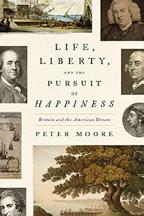
Moore, Peter Farrar, Straus and Giroux (592 pp.)
$35.00 | June 27, 2023
9780374600594
A nation rises out of the Enlightenment. Like Jenny Uglow’s The Lunar Men and Leo Damrosch’s The Club, Moore’s vibrant group biography
brings to life the intellectual and political currents, in Britain and Colonial America, that gave rise to the phrase “life, liberty, and the pursuit of happiness,” words that “were destined one day to become an evergreen mantra for politicians, and a shorthand for that ideal we call the American Dream.” Moore’s central figures are Philadelphian printer, scientist, and politician Benjamin Franklin, aspiring to “gentlemanly credentials”; Scottish-born printer and publisher William Strahan; the irascible Samuel Johnson; “political agitator” John Wilkes; historian Catharine Macaulay, whose romantic liaisons inspired salacious gossip; and outspoken British émigré Thomas Paine. In tracing their lives and interconnections in the decades leading up to 1776, Moore depicts a British nation increasingly focused on commerce and geopolitics, with a new generation of Britons “beginning to see themselves as masters of their own destiny,” talking of liberty “as a rare and fragile thing.” As the author writes, “liberty meant freedom from tyranny. More distinctly, people thought of it as the right to live with some independence, within a legal system that protected them from the malignant reach of arbitrary power, in a property of their own possession that was safe from intruders.” To Britain’s colonies, liberty meant independence from a king who was quashing free speech, imprisoning opponents, and extorting money from its possessions through taxation. They would not be enslaved by Britain, although they did not include their own slaves in their cry for freedom. “How is it,” Johnson remarked acerbically, “that we hear the loudest yelps for liberty among the drivers of negroes?” It was Paine who urged his fellow colonists to send a “manifesto” to Britain outlining their intentions to break with the motherland, in effect providing a prototype for the committee that met to draft that declaration, and it was Jefferson who summarized the yearnings of the age in a simple phrase. An energetic and meticulously researched history.
Mordden, Ethan
Oxford Univ. (240 pp.)
$29.95 | June 1, 2023
9780190063108
A chronological study of how queer creatives have greatly impacted the theater world.
In his latest book, Mordden, who has written extensively about American and British theater, focuses on the influences of “homosexuals, bisexuals, transsexuals, metrosexuals, and the sexually fluid” on American stage productions throughout the 20th century. The author begins with profiles of high-profile drag queens like illusionist Julian Eltinge and lesbian repertory firebrand Eva Le Gallienne, who, alongside many others, paved the way for gay characterizations and storylines through both “serious drama” and “minty repartee” roles in the 1920s. Another major figure of this time was Mae West. “In a way,” writes Mordden, “she was like a hetero version of your gay uncle, a bank of information about the world that was far more intriguing
than anything you heard from your parents.” The author then moves on to discuss Hollywood’s suppression tactics, including the 1927 Wales Padlock Law, which banned any form of “sex degeneracy” from appearing onstage. But the resurgence was swift in subsequent decades as luminaries like Tallulah Bankhead, Harvey Fierstein, and an exhaustive list of others ushered in new sex-positive, gay-identifiable productions like The Boys in the Band, Torch Song Trilogy, The Normal Heart, and Angels in America. Despite its brevity, Mordden’s book is filled with hilariously quippy biographical information—e.g., “portly and owlish” Alexander Woollcott was as gay “as a parade of candy canes”; Joan Crawford “was one of Golden Age Hollywood’s great phallic women”—and contributes uniquely detailed backstage stories from celebrated productions that have continued to shape American theater. As intolerance faded, queer culture thrived, moving well beyond the strict artistic censorship and homophobia that proliferated in the early decades of the 20th century. Gay historians and theater buffs of any persuasion will appreciate this terrific, condensed 100-year retrospective.
A lively, highly knowledgeable report on queer culture’s significant contributions to Broadway.

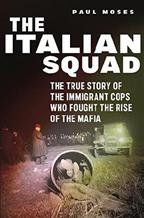
Moses, Paul New York Univ. (304 pp.)
$29.95 | June 3, 2023
9781479814190
History of a little-known unit within the New York Police Department made up of Italians who battled organized crime.
In the early 1900s, many members of the NYPD looked down on Italian immigrants, as journalist Moses documents at several points. However, Joseph Petrosino, the first commander of the Italian squad, analyzed the data and concluded that “97 percent of Italian immigrants were law-abiding and hardworking,” and their presence in criminal statistics was no greater than that of any other ethnic group. Appointed to the post by Theodore Roosevelt, then the commissioner of police for New York, Petrosino went up against the first glimmerings of the Mafia in the city. He was assassinated in Sicily, where he was on the hunt for mobsters, in 1909, succeeded by an Irish department head who expanded the squad and who learned along the way that Petrosino had been killed at the orders of a peripheral criminal the detective had shamed with a public beating. Still, Petrosino was enshrined as “the quintessential police officer and New Yorker.” Michael Fiaschetti, another Italian-born officer, eventually headed the squad, fighting the Black Hand and other criminal organizations while doing plenty of self-promotion, which, all the same, didn’t keep him from being demoted for roughing up a defense attorney. The Italian Squad was, as Moses notes, “mythologized” from the start, but Fiaschetti was
“A lively, highly knowledgeable report on queer culture’s significant contributions to Broadway.”
a master of “inflating his reputation,” so the facts are not easy to come by. Though the narrative isn’t quite as riveting as a wellrendered crime procedural, the author does a solid job digging through the files to get at them, noting that while the squad ultimately didn’t make much of a dent in controlling organized crime—the Mafia flourished in the 1920s and ’30s—it did serve as “a bridge for an alienated immigrant community” that was all too often reluctant to help the police.
A serviceable, well-researched examination of a littleknown corner of the NYPD’s past.

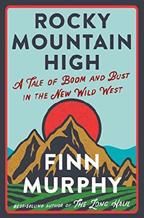
Murphy, Finn Norton (256 pp.)
$27.95 | June 13, 2023
9781324006107
An eastern entrepreneur goes west with calamitous results.
In 2018, 61-year-old Murphy, a selfdescribed “acolyte of the Atlantic establishment,” moved to Colorado. He assumed that because all his other business startups had been successful that he had the savvy and vision to make a fortune growing legal hemp. His timing was prescient, his plan impeccable, his future fragrant. What could go wrong? Just about everything, it seems. Murphy, the author of The Long Haul, is an insightful and incisive observer, not least regarding the cultural differences between his native, class-conscious New England and the more egalitarian Colorado. Though he felt at home with the West’s enterprising spirit, he knew the reality: “There’s a reason the word ‘dream’ appears upon that mythic American pedestal.” The author had his reservations about the hemp business, had no experience in agriculture, and could obtain little useful data on hemp growing; for the most part, he was flying blind. Planting crops on a rocky alluvial plain in a semiarid environment was not ideal, but the prospect proved irresistible. He chronicles his rise and fall with a wicked sense of humor, especially useful in skewering persistent myths of every kind, whether business, ecological, or historical. However, his withering critique of the rugged individualist frontier malarkey and its damaging effects on our society is no laughing matter. Murphy is a capitalist to the core but no fan of what he calls the plague of “corporatocracy,” whose misdeeds he savages. He also tells the true story behind America’s hopelessly misguided war on drugs. Murphy spent 20 years as a long-haul mover, which acquainted him with America’s “underclass,” and few could rival his assessment of the immigrant community and our treatment of it. He never tires “of listening to the life stories of people inhabiting the bottom of the American Dream,” and his book is all the richer for it. An engaging cautionary tale with much to teach about business and many relevant socioeconomic issues.
Neguse, Joe Simon & Schuster (288 pp.)
$30.00 | Aug. 8, 2023
9781982191672
A collection of stories about members of the House of Representatives who exhibited political and moral bravery.
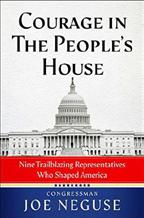
Colorado Congressman Neguse, whose parents came to the U.S. from Eritrea, states at the outset that his first book is similar to John F. Kennedy’s Profiles in Courage. Yet whereas Kennedy’s book focused on members of the Senate, Neguse looks at the House of Representatives, aiming to enhance the tattered image of Congress via the lives of representatives who made courageous decisions in the face of discrimination, hostility, and political pressure. Some of those featured, such as Margaret Chase Smith, Shirley Chisholm, and Barbara Jordan, are familiar figures. Neguse makes excellent use of the Library of Congress to highlight lesser-known stories of Black congressmen such as Joseph Rainey and Josiah Walls, who worked to advance civil rights legislation after the Civil War; Henry B. Gonzalez, who “devoted himself to the truth, even when it led to uncomfortable places and exclusion from the insiders’ club”; and Oscar Stanton De Priest, who sought to advance the rights afforded by the Constitution to all citizens. The author lauds William B. Wilson and Adolph Sabath for their efforts on behalf of labor and immigrants, respectively, in addition to broad-mindedness in the political arena. Neguse brackets the profiles by often mentioning his role as a House impeachment manager in 2021 as part of the inspiration for the book. He clearly wants to be considered in the same vein as the members he profiles, which is presumptuous. Still, Neguse’s profiles are admirably crafted, accessible, and well researched. This is a fine first effort that could become the foundation of an ongoing series that would add to the noble history of the House of Representatives, but it also serves as a reminder of how largely devoid contemporary Congresses have been of courageous politicians.
A well-written addition to the history of Congress.
O’Connell, Mark Doubleday (304 pp.)
$29.00 | June 27, 2023
9780385547628
A vividly written account of the author’s encounters with one of Ireland’s most notorious murderers.
In 1982, Malcolm Macarthur, an idle member of Ireland’s once-landed gentry, mortally wounded a young nurse while stealing her car, then called on a farmer who had a shotgun for sale, killed him with his own weapon, and drove off in his car. Improbably, he then holed up in the home of Ireland’s attorney general, a friend. He was finally found and arrested, yielding a multilevel scandal. “The people of Dublin know this story well,” writes O’Connell, author of Notes From an Apocalypse. “But we know it only as a story….He pleaded guilty, and so no evidence was heard in court.” The story took a different turn when John Banville, the subject of O’Connell’s doctoral dissertation in literature, wrote a novel that borrowed liberally from the Macarthur case. O’Connell not only studied Banville, but also decided to find the recently paroled Macarthur—who bore a striking resemblance to the novelist—to hear his side of the story. It wasn’t easy to find the killer, but finally, “very tentatively and politely,” O’Connell was able to approach him. Thus began a quest for understanding that, while not exactly cat and mouse, was a study in misdirection and vague asides, leading the interviewer to early despair: “As soon as I begin to see him, as soon as I believe I have grasped him as a subject, he slips away into darkness, and I know no more, and perhaps even less, than I did to begin with.” Erudite, seemingly emotionless, haughty, absolutely unrepentant, and elusive, Macarthur evaded easy analysis. The resulting picture of the killer is seen as if through a proverbial dark glass—and it’s as chilling, in the end, as any Hitchcock film.
A superb study of real-life crime and punishment, to say nothing of sociopathy in action.
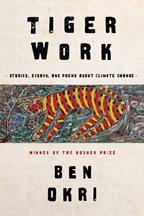
Okri, Ben Other Press (240 pp.)
$24.99 | June 20, 2023
9781635423365
Grave warnings for humankind. Booker Prize winner Okri gathers poems, essays, and tales into a collection that conveys an urgent message about humans’ “suicidal relationship with the earth.” Each piece reflects the author’s frustration over our failure to act in the face of “ample evidence” that we have brought our environment to the brink of disaster. “We are proliferating disease and illness,” he writes. “I think it is nature’s revenge for strangling her, for tampering with her, and for being divorced from her. We are isolated and rootless in our lack of belief in anything.” In one piece, travelers from the distant future explore the “rich evidence of life” on our long-deserted planet. Earth, they decide, was “the most beautiful of the planets that we saw in our journeys across the galaxies,” but, sadly, they discern that it had been inhabited by “a rather parochial and tribal species, bedevilled by ideas of race and gender.” Another piece reveals politicians’ arrogant denials of climate change, while others offer dystopian visions of humanity’s last days. One long narrative follows a man and
woman as they struggle to reinvent the world that greed has destroyed. “We say that there is a climate emergency,” writes Okri. “But it is truer to say that there is a humanity emergency.” He beseeches Earth itself to “teach us with your silent wisdom how to live again, how to be simple again, and how to rise to the greatness and sense of universal justice that is our divine inheritance.” Artists, especially, should dedicate themselves “to nothing short of redreaming society.” To that end, he advocates what he calls “existential creativity”: “it means everything I write should be directed to the immediate end of drawing attention to the dire position we are in as a species.” He urges “ferocity / To protect our humanity,” adding: “Can’t you hear the / Future weeping?”
An artist’s ardent plea for change.

Oliva, Alejandra
Astra House (320 pp.)
$28.00 | June 20, 2023
9781662601699
A graceful meditation on the unresolved traumas of life in a land where one is often not welcome.
“If you’ve experienced deep grief, if you’ve lived through any kind of event with an aftermath, you know the way that time fractures and splinters, the way true things take on the sheen of unreality while dreams feel vivid and visceral.” So writes Oliva, who, bilingual in English and Spanish, worked for years as a translator and interpreter for refugees and immigrants seeking admission into the U.S. Hidden inside the Spanish of those arrivals from Central America is the terror of living amid gang wars and political repression, of being dispossessed from one’s land, of being hungry. The border, writes Texas native Oliva, “is porous. Sometimes you cross for a day job, and sometimes you cross for keeps.” For those who have arrived from afar, it can be an insurmountable barrier. Confronting it requires courage, and it is no easy matter to decide to leave one’s homeland, even when survival is at stake. Going from big cities and courtrooms to small outposts on the border, the author encounters many similar stories, bringing the words of those in need into a “lingua franca of global systems of capital, whose speakers expect to be met and accommodated within this language.” Yet, of course, it is those people who make it across the border, legally or not, who wind up harvesting the food we eat and staffing the restaurants where we eat it, drawn in at the very bottom of that capitalist regime. Evenhandedly and without sentimentality, Oliva urges that we can stand to be both more understanding and more generous:
“We sit here, on our prosperous shores, surrounded by the materials to build bridges, to build homes, to build cathedrals, to build irrigation canals and make plenty for everyone.”
A humane, elegantly written book that gives voice to the voiceless at our borders.
“A humane, elegantly written book that gives voice to the voiceless at our borders.”
rivermouth
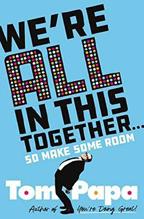
Papa, Tom St. Martin’s (256 pp.)
$30.00 | June 6, 2023
9781250280091
Brief essays on the art of being human.
In his third book, Papa offers more humorous, sympathetic, and humane personal anecdotes to show that survival in a world of changing institutions, challenged human rights, and digital isolation comes down to understanding one’s humanity and finding “new ways to connect” with others. Like most people, the author grew up wanting only to “blend in and be normal.” However, in the words of his grandmother, “there’s no such thing as normal. Everybody’s a mess.” That quirkiness, notes the author, combined with “a certain amount of rude self-interest,” is very much at the heart of everyday problems people face whenever they encounter other humans. With tongue firmly in cheek, Papa writes, the “same people who make life intolerable for everyone at home actually go out into the world, work in office buildings, run for office and drive around in police cars.” Even after a deadly global pandemic, though, human behavior seems not to have changed: People—like the woman Papa watched “sneezing into her hands and wiping it on her stretchy jeans” in an airport—are just as lacking in manners and consideration as they ever were. One thing that redeems the messiness of life is laughing at human foibles, which in turn sparks “joy and connection” with others. The other is an awareness of the regrets that accumulate over past mistakes. For Papa, regrets are actually a sign of health and an indicator that “you have evolved into a person who knows better” and can connect with others in more positive ways. Papa’s latest book is sure to appeal to his fans as well as anyone who appreciates understated humor that probes the nature of the human condition. Chapter titles include “Cats— Ancient Menace,” “There’s No Cure for a Hangover,” and “Regrets? I Have a Bunch.”
Papa delivers another relatably witty collection.

Parisi, Giorgio
Trans. by Simon Carnell
Penguin Press (144 pp.)
$24.00 | July 11, 2023
9780593493151
An Italian Nobel laureate uses his background as a theoretical physicist to illustrate the importance of science.
In the opening paragraphs of this essay collection, Parisi states that crises like climate change and the Covid-19 pandemic
have demonstrated that now, more than ever, science is essential to humanity’s survival. Unfortunately, in today’s hypercharged partisan landscape, nonscientists often view science through a lens of distrust, a stance that, most recently, led to the unnecessary deaths of the unvaccinated during the pandemic. “If citizens and politicians do not trust science,” writes the author, “we will move inexorably in the wrong direction, and the struggle against any number of global ills—global warming, infectious disease, hunger and poverty, the depletion of the planet’s natural resources—will fail.” Parisi believes that scientists can rebuild this trust by being more open about their processes and says that the purpose of this book is to help people understand how science really works. “It is important to understand how scientific consensus is achieved,” he writes. What follows is a collection of essays that range widely. The author offers a personal account about participating in an occupation of the Physics Institute in Rome in 1968; a philosophical treatise on the importance of metaphor in scientific breakthroughs; and a diagram-laden chapter on “the theory of spin glasses, considered my most significant contribution to physics.” Throughout, Parisi’s voice is amiable and conversational, which endows the book with the feel of a conversation with a wise and generous elder. However, each of the chapters is wildly different in tone and content. While some passages read like literary memoir, others read like dry excerpts from textbooks. Though the author returns to his thesis about science and trust at the end of the book, the thesis feels only loosely applicable in the middle.
An intermittently charming but incohesive essay collection about physics, matter, and memory.
Payne, Chris
Dey Street/HarperCollins (496 pp.)
$32.00 | June 6, 2023
9780063251281
A full immersion into a musical genre that “was never supposed to be cool.”
The music called emo (often with derision) rose gradually in the early 2000s, made an explosive popular impact, and then experienced a quick descent. With this oral history, music journalist Payne seeks to keep the legacy alive. Drawing from more than 150 interview sources—musicians, crew, journalists, and fans—this is a book by fans for fans, a celebration of a musical phenomenon too often dismissed as punk lite. The text will satisfy any emo obsessive, those who know everything about the scene that spawned Fall Out Boy and My Chemical Romance and are still hungry to know even more. Others might have trouble keeping all the names and the bands straight, though the author provides an effective overview of how the scene developed and what went right and wrong. For the uninitiated, emo is short for emotional. An offshoot of the DIY punk

scene, it was initially branded emocore, a response to the hardcore punk that was so abrasively aggressive and dominated by male stars. Emo was music for and by more sensitive boys as well as the girls who loved them and broke their hearts. It was a grassroots movement from suburbia and flourished on video, in shopping malls, and on the Warped Tour. Some of the bands were so young and became popular so fast that they couldn’t possibly have been prepared for the pressures of stardom and international popularity. Record companies were still throwing massive amounts of money at them in the early 2000s. There were plenty of casualties—drug overdoses, rehab, psychological treatment—and a couple of huge success stories. Payne covers it all in exhaustive (and occasionally exhausting) detail. The multiple cast-of-characters lists are helpful for non–die-hards.
A must-read for emo fans but not likely to win the genre many new followers.
Rocero, Geena Dial Press (320 pp.)
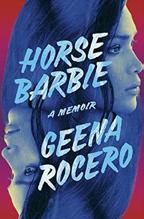
$28.00 | May 30, 2023
9780593445884
A model and trans advocate recounts the story of her life, from her childhood in the Philippines to a series of careers in the U.S.
In a humorous, zesty memoir divided into 25 lively chapters, Rocero explores the various identities she has taken on and cast off, from “Craigslist Girl” to “Storyteller” to “Playmate.” Growing up, she always identified as female in a country that celebrated transgender individuals and honored them in beauty pageants. As a child in a cramped apartment in the Manila metro area, Rocero looked forward to being able to compete in pageants. In high school, she began working with Tigerlily, “a slender femme in her early twenties with pouty protruding lips and long lustrous hair who’d made a name for herself as the Beauty Queen Maker.” Affectionately called Horse Barbie by the members of her pageant cohort, due to her prominent teeth and long legs, neck, and hair, she quickly rose to the top of the scene. Her nostalgic stories of these days, when she crafted a version of a bridal veil out of toilet paper and ate her fill of “the classic Filipino trio of garlic fried rice, eggs and marinated beef,” are the highlights of the book. At 17, Rocero moved to San Francisco to be with her mother. To save money for gender-affirming surgery in Thailand, she worked at the Macy’s cosmetic counter and then moved to New York to become a model. As she recounts, her early years modeling were some of the most anxious times of her life. While trans models were accepted in the Philippines, she feared that being outed in New York would mean an ignominious end to her career. While readers may grow weary of accounts of her dating life, Rocero’s cheerful, upbeat attitude carries the story through even its less absorbing chapters.
A jaunty and inspiring memoir of an eventful life with many acts left to unfold.
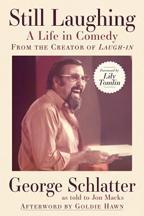

Scheel, David Illus. by Laurel “Yoyo” Scheel
Norton (288 pp.)
$28.99 | June 13, 2023
9781324020691
A marine biologist dives into the wondrous world of octopuses.
A professor of marine biology at Alaska Pacific University, David Scheel has been studying octopuses for more than 25 years, specializing in animal behavior. “Behavior, in particular,” he writes, “reveals values—what is good and what is bad to an octopus—and hints at an animal’s experiences and intentions.” In his first book, the author shares the fruits of his research, as well as that of other marine biologists, to show us much of what has been learned—and remains to be understood—about these fascinating sea creatures. As the author notes, more than 300 different species of octopuses exist, yet their elusive behavior and the changing nature of their appearance make them difficult to locate, identify, and study. Among the questions the author addresses in this page-turning natural history: How has climate change affected octopuses? How can they be protected from overharvesting? What self-defense tools do they deploy? How do they use their senses to interact with their environment? Do octopuses dream? Do they experience emotions? Perhaps most surprising of all, the author has discovered that “despite their solitary reputation, octopuses like closeness.” Though the author’s research has taken him around the world, his primary focus has been Alaska. In addition to an endless supply of interesting factoids about octopuses and their habitats, the author also shares knowledge and stories from Indigenous cultures regarding the lives of octopuses, many of which inspired him to pursue his work further. “Indigenous science seeks not only to understand,” he writes, “but also to respect people and the natural world.” The author’s passion for octopuses, combined with his accessible language and vivid descriptions of his encounters, creates a memorable book that is sure to appeal to fans of underwater adventures and anyone who enjoyed the film My Octopus Teacher. Laurel Scheel’s simple yet elegant illustrations complement the text.
A heartfelt and enlightening look at one of Earth’s most curious creatures.
Schlatter, George with Jon Macks
Unnamed Press (260 pp.)
$28.00 | July 11, 2023
9781951213794
Enjoyable memoir by “a ninetythree-year-old who still loves fart jokes.”
Schlatter had a peripatetic youth, winding up in a Missouri college on a
“A heartfelt and enlightening look at one of Earth’s most curious creatures.”
many things under a rock
football scholarship but then signing on to an opera company while falling in love with burlesque. “I learned what ‘shtick’ meant from the very best,” he writes, “which was useful when I ended up in Hollywood.” Given his desire to get into show business, it was almost inevitable that he would wind up in Los Angeles, and after an abbreviated stint in college there, he talked his way into a job at a talent agency, where Frank Sinatra took him on. From then on, Schlatter did a bit of everything, including producing a memorable TV special with Judy Garland and a fast-cut ad-lib hour with Art Carney and Jonathan Winters, “television without a net.” He then concocted LaughIn, a partly scripted, partly ad-libbed show with a cast and guest list made up largely of unknowns. “The network suits didn’t audition or approve any of them,” he writes. “That would never happen today.” One was British singer Judy Carne, hired because she could “take a punch,” another the comic Arte Johnson, whose fortunes had flagged to the point that he was selling suits. Jo Anne Worley told good near-blue jokes, Chelsea Brown and Flip Wilson were pioneering Black comedians, and Tiny Tim—well, he was Tiny Tim. Schlatter takes justifiable pride in sneaking in “the first prime-time nipple on the air, kind of making me the Jackie Robinson of breasts.” On the other hand, he regrets bringing Richard Nixon onboard to utter the line “Sock it to me” after many grim takes, since it made Nixon seem hipper than he was. There’s dish aplenty and gracious appreciations, too, including Schlatter’s declaration that “giggly dumb blonde” Goldie Hawn was “the smartest member of the whole cast.” The book includes a foreword by Lily Tomlin and afterword by Hawn.
Lively notes on TV comedy by a master of the genre; a pleasure for fans.
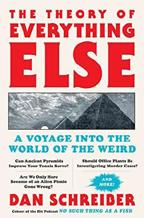
Schreiber, Dan Morrow/HarperCollins (368 pp.)
$28.99 | June 27, 2023
9780063259195
A collection of wacky beliefs, incidents, and conspiracy theories that will amuse many readers.
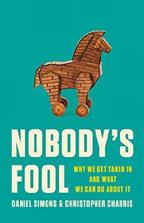
Schreiber, co-host of the hit podcast No Such Thing as a Fish, assembles a selection of his more oddball interviews and adds a torrent of historical eccentrics and anecdotes. Skeptics will find good reason to gnash their teeth, and lovers of alternative facts will enjoy an embarrassment of riches. One fascinating story involves the work of neuroscientist John Lilly, who sought “to teach dolphins to speak the English language so perfectly that they would be given a chair at the United Nations to speak on behalf of all marine mammals.” Surprisingly, the chestnut about the faked Apollo landing is absent, but the astronauts themselves were apparently an offbeat bunch, deeply religious before or converted by the experience, when not preoccupied by the
paranormal. The book is overpopulated with aliens, whether they were witnessed or were historical figures (Jesus may have been one). Stories of encountering ghosts or talking to the dead are almost too common to attract readers’ attention, but Schreiber collects a crowd of them. Billions of mildly interesting coincidences occur every day, and nearly every prediction of the future turns out to be wrong, but a few hit the mark. Schreiber delivers breathless accounts of many. The author portrays himself as a man of good sense partial to scientific evidence. He also knows that debunkers sell modestly, but outright zany authors and books often make the bestseller lists. He admits doubts about some particularly outlandish stories but otherwise confines his qualms to the occasional skeptical footnote or hint (“according to science”). Ghost hunters and conspiracy theorists will find plenty of red meat to chew on, whether Schreiber is discussing clairvoyance, “pyramid energy,” “the theory of the hollow earth,” or the idea that time travelers sank the Titanic, not an iceberg.
A cheerful collection of paranormal phenomena, correct prophecies, alien encounters, and unlikely historical events.
Simons, Daniel & Christopher Chabris
Basic Books (336 pp.)
$30.00 | July 11, 2023
9781541602236
America is awash in lies, liars, and scams as well as books denouncing them, and this is among the best.
Simons, a professor of psychology, and Chabris, a cognitive scientist, are aware of the popularity of stories about scammers. In this collaboration, they deliver a steady stream of such tales in which the well known (Bernie Madoff, Elizabeth Holmes) barely scratch the surface. Mostly, scammers exploit habits that serve us well in daily life but make us easy prey. We believe what others tell us unless something seems fishy. We see what we expect to see. Without adequate critical thinking, it’s a formula for disaster. A respected psychology journal published a study in which subjects walking through dirty streets were more likely to think racist thoughts. Had the study—which turned out to be fake—reached the opposite conclusion, the editors might have paid more attention. We also tend to accept fascinating stories without question. Told that Bill Gates, Steve Jobs, and Mark Zuckerberg are college dropouts who became billionaires and then asked if dropouts are more likely to strike it rich, most subjects answer yes. In fact, nearly all billionaires are college graduates. The authors promote Ronald Reagan’s dictum about negotiating with the Soviet Union: “Trust, but verify.” Readers will agree but also admit that we readily distrust statements that contradict our beliefs and accept without question information we agree with. The authors present a delightful parade of fakery in which scammers compete with equally dishonest
entrepreneurs, scientists, journalists, and politicians, with special attention to the psychologists. As to the “What We Can Do About It” in the title, Simons and Chabris prescribe easy, common-sense rules, not-so-easy-to-implement but excellent advice on researching dubious claims, and repeated warnings to question our deeply held beliefs and distrust gut feelings.
An outstanding guide to nonsense for critical readers.
Sunstein, Cass R. Princeton Univ. (208 pp.)
$22.95 | Aug. 15, 2023 9780691252049
An incisive rethinking of the U.S. Constitution.
Sunstein, the founder and director of the Program on Behavioral Economics and Public Policy at Harvard Law School, begins by pointing out the irrefutable fact that “the Constitution does not contain the instructions for its own interpretation.” Thus, “no approach to constitutional interpretation is required or self-justifying.” On those grounds, he briskly swats away every jurisprudentially, philosophically, and historically justified interpretive scheme—“anti-originalist” as well as “originalist,” of the left as well as the right—that has been advanced since the 19th century. All schools and schemes of interpretation fall before his generous-spirited ax strokes. In their place, he argues, there can be only one acceptable, humane approach to judicial interpretation: the search among jurists for a “ ‘reflective equilibrum’ in which [jurists’] judgments, at multiple levels of generality, are brought into alignment with each other” in order to achieve the most democratically acceptable and fairest outcome achievable at the time. “There is no alternative to the search for reflective equilibrium,” writes the author, because “no theory makes sense for every imaginable world.” Though disarmingly and intentionally “simple and straightforward,” as well as open-hearted, common-sensical, and succinct, Sunstein’s text, given its grave and demanding subject, requires readers’ attentiveness. Despite the author’s fair-mindedness, it’s clear that his main targets are the originalist and traditionalist arguments that have recently captured the radical right and are overturning decades of settled constitutional law. Is Sunstein’s interpretive scheme strong enough to halt the further advance of originalist and traditionalist thinking on the Supreme Court? Probably not. But it’s a brave, muscular, and compelling roadblock now standing in the way of originalist ideologues. This book should be in the hands of every law student, constitutional lawyer, judge, and Supreme Court justice. One of the most significant works about constitutional interpretation in recent years.
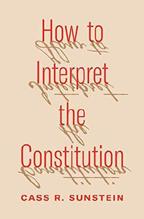
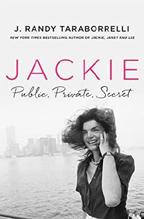
St. Martin’s (528 pp.)
$35.00 | July 18, 2023
9781250276216
The veteran Kennedy family biographer brings fresh details and insights into the public and private life of a first lady like no other.
Taraborrelli’s nearly 25 years of research and interviewing sheds new light on every phase of Jacqueline Bouvier’s life, including her marriages to John F. Kennedy and Aristotle Onassis; the sacrifices and choices she made when establishing her publishing career; fits, starts, and ends with various lovers in the wakes of those marriages; and her relationships with her rakish, adoring father, John “Black Jack” Bouvier, domineering but loving mother, Janet Bouvier Auchincloss, and doting, reliable stepfather, Hugh D. Auchincloss. Taraborrelli spares readers from slogging through a conventional chronology, instead offering detailed vignettes in tandem with the necessary facts from his subject’s life that inform and enlighten. He details Jackie’s decidedly weird relationship with her sister, Lee, a sibling rivalry involving their attractions to love, money, and power. He elegantly portrays how the horrifying trauma of the assassination of JFK and Jackie’s attempts to reconcile the bizarre cocktail of tawdriness and genuine affection of their marriage were always under the surface. The author also capably describes Jackie’s efforts to restore and revitalize Lafayette Park, the White House, and Grand Central Station as metaphors for her own self-improvement, independence, and growth as a modern woman in the latter half of the 20th century. Taraborrelli’s firsthand knowledge of Jackie’s career in publishing, which underscored her lifelong literary sensibility, enlivens the tale, and his descriptions of Jackie’s editorial work with the likes of Michael Jackson—and her attempt to sign Frank Sinatra to write an autobiography (which dredged up uncomfortable truths about the company kept by JFK) make clear the overwhelming intersection of power, celebrity, and fame in which Jackie found herself. The author understatedly conveys the many heretofore-unknown details of Jackie’s “secret” life without resorting to lurid or salacious sensationalism.
An absorbing and comprehensive account of one of the most remarkable women of the 20th century.
“One of the most significant works about constitutional interpretation in recent years.”
how to interpret the constitution
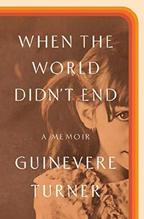
Turner, Guinevere Crown (336 pp.)
$28.00 | May 23, 2023
9780593237595
A Hollywood actor, screenwriter, and director reflects on her upbringing in a doomsday cult in the 1970s.
Anchored by diary entries, Turner’s memoir vividly recalls her unconventional upbringing in the cultlike Lyman Family. She was not raised by her mother, Bess, but by other group members who home-schooled her and the other community children. The isolated, hierarchical Lyman commune was led by charismatic “Lord” Mel Lyman, who preached about the dangers of everyone outside their community. He, alongside “Queen” Jessie, reigned over a network of extension communities, all rooted in the knowledge of an impending apocalypse. In January 1975, the Lyman followers were instructed that the global population of “World People” would be extinguished and only their group would ascend in a spaceship to live on Venus. When the ship never materialized, Turner, as the oldest of six children and having already been shuffled among various homes, was relocated to the East Coast with her excommunicated mother, who had abandoned the group altogether. Though the author relished the camaraderie of cooking, farming, cleaning, and being a kid with the other Lyman children, she became more confused and less enchanted once the culture shock of living outside the clan kicked in. Still, she continued writing in her journal, mostly as a means of self-expression. “There have been points in my life when keeping a record of what was happening to me felt like the only power I had,” she writes. The author’s prose is reflective, vivid, and confessional, a rich combination full of striking imagery. Turner found much to reconcile as she entered early adulthood, and she even considered foregoing college to rejoin the Lyman Family. In a memorable closing sequence, the author expresses her disillusionment with the outdated gender hierarchy still in place on the farm.
A moving portrait of a bizarre childhood written with emotional nuance and bittersweet deliverance.
BY ALL MEANS AVAILABLE Memoirs of a Life in Intelligence, Special Operations, and Strategy
Vickers, Michael G.
Knopf (576 pp.)
$35.00 | June 20, 2023
9781101947708
The former undersecretary of defense for intelligence under Barack Obama reflects on key military campaigns and the lessons and insights he garnered during his many years of service.
From his early training in the Special Forces to the many high-ranking positions he held within the CIA and the Department of Defense, Vickers had a long, distinguished career that often placed him at the center of some of the most significant military and intelligence operations of the past several decades. In this engrossing, densely packed memoir, the author recounts in vivid detail how these events unfolded and the particular role he played in each instance. He chronicles the U.S invasion of Grenada in 1983, the CIA’s secret assistance to Afghan forces fighting the Soviets in the mid-1980s, the capturing of Osama bin Laden in 2011, and counterterrorist efforts to impede alQaida and the Islamic State group. Vickers is successful in his plan to write “an analytical memoir” in order “to provide sufficient historical context for the events in which I participated, show how intelligence, special operations, strategy, and warfare evolved during my more than four decades of service, and how policy battles in Washington often decided the outcome of our operations and wars as much as our action in the field did.” Regarding policy battles, the author candidly scrutinizes how and why decisions were occasionally misguided, when he felt the U.S may not have responded quickly enough or accordingly. Like other recent policy analysts, he contends that the U.S. is enmeshed in a new Cold War, which includes China and Russia, with possibly graver consequences at stake. “Competing successfully in this new era will require far more than military strength,” writes the author. “Our military and intelligence power, moreover, must be transformed to reflect new realities, as must our alliances and national security institutions.”
A masterful, fully compelling assessment of key intelligence and special operations missions over recent decades.
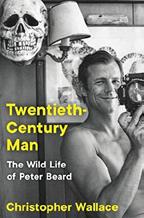
Wallace, Christopher
Ecco/HarperCollins (288 pp.)
$29.99 | July 4, 2023
9780063066410
Biography of the well-known wildlife advocate, art photographer, socialite, and fashion icon.
According to Wallace, Peter Beard (1933-2020) was “a man of action, maybe the last great romantic adventurer,” and Paul Theroux called him “the first person to chronicle the decline of wildlife…of East Africa.” From their initial encounter for an Interview magazine profile in 2016, Wallace has remained fascinated by this “proto-influencer” whose “prep-kid-gone-bamboo style” would inspire entire fashion collections in his image. Beard’s jet-set lifestyle included friendships with the artists Dalí, Warhol, and Francis Bacon, who considered Beard his muse. He attended bullfights with Picasso, and he romanced Cheryl Tiegs (his second wife), Iman, and Lee Radziwill. “Obsessed with the idea of Africa,” Beard made his home at Hog Ranch, his own “patch of bush” teeming with wildlife, outside of Nairobi, Kenya. He kept lifelong diaries, took hundreds of photographs, and made
collages documenting his quest for an aesthetic ideal he called “primitiva.” Throughout his life, he endeavored to make himself “a vessel for art.” Wallace emphasizes Beard’s overriding insight that “the end of wildlife…is the end of us” as a species. The author succeeds in looking beyond Beard’s surface appeal as the “ideal avatar for our adventurous impulses, shirtless on a perpetual safari,” to explore what he calls Beard’s fatalism, his “heartbreak over the destruction of the natural world.” He was, writes the author, “a savant in the bush.” Near the end of his life, he walked out of his Montauk compound without his heart medication, which he could not go without for more than 24 hours. After 19 days of searches, a hunter found his body in the woods nearby. Beard had achieved his lifelong goal: a final return to the wilderness, which for him was not a geographical location but a state of being.
A vivid account of a life devoted to the African wild.
Walton, Calder Simon & Schuster (688 pp.)

$34.99 | June 6, 2023
9781668000694
A thorough history of a century of conflict between Britain and America and the East.
A serious scholar and lucid writer, Harvard historian Walton, author of the three-volume Cambridge History of Espionage and Intelligence, maintains that the Cold War began with the 1918 Soviet coup and is still in progress in the digital world. Taking advantage of recently declassified documents, the author delivers a vivid account of intelligence skulduggery, mostly familiar to history buffs but no less deplorable in the retelling. Despite a dystopian government and threadbare citizenry, the Soviet government’s proclamation that they were building the first truly just society galvanized idealists around the world. This gave them a permanent spying advantage because many Westerners volunteered their services. Stalin feasted on their avalanche of intelligence but acted as his own analyst; wildly paranoid, he regularly dismissed vital information. The Cold War followed with occasionally spectacular but mostly uninspiring and often disastrous operations, from the overthrow of unsympathetic governments to American officials’ near-psychotic obsession with Cuba to unwinnable wars and Soviet moles. At the same time, unhappy Russians occasionally defected or passed on their nation’s secrets. Walton emphasizes that the disintegration of the Soviet Union in 1991 did not include the KGB, which reconstituted itself as an agent of revenge against the West. “It was from this bitter revanchist stew in Russia that Putin emerged,” he writes. Putin’s efforts to make Russia great again may not be going well, but his intelligence service’s strategy of hijacking the internet to spread disinformation and influence American elections may be its most successful operation. In the final chapter,
Walton focuses on China. Not crippled by a command economy and more technologically sophisticated, it is vacuuming up American secrets with a remarkable efficiency. Throughout, the author is incisive in his analyses, and the seven-page glossary of relevant acronyms will help readers keep track of countless global agencies and organizations.
A gripping, authoritative work.
Wertz, Julia Black Dog & Leventhal (320 pp.)
$30.00 | May 9, 2023
9780762468256
A graphic memoir about a cartoonist’s struggles with alcoholism, recovery, and romance.

Early on in the text, Wertz, the author of Tenements, Towers & Trash, notes that she had long been telling her doctor that she enjoyed a couple drinks every evening. It turns out she was drinking multiple bottles of wine daily. At the time, she felt like she couldn’t live without it, even though she was warned that she would not live long if she continued her habit. Though the subject matter is grim, Wertz’s light touch as a narrator and talent as an illustrator help the narrative avoid the down-and-out, hell-and-back pathos of so many recovery memoirs. The author was a functioning alcoholic, publishing productively and meeting deadlines, but there was not much except work and wine to fill her life. However, when she stopped drinking, at least for a while, it didn’t solve her problems. In some ways, life got messier, as she forced herself out of her comfortable isolation to meet people and try to find a romantic partner. When she inevitably relapsed, it was not the end of the world but more of a learning experience. She received support from her brother (also in recovery), close friends, and other alcoholics at meetings even as she tried to minimize residual trauma as merely “a relentless series of tedious misfortunes.” By any objective standard, her life improved—not only professionally (her work started to appear in the New Yorker and the New York Times), but personally as well. Refreshingly, none of this seems like a pat, cause-and-effect morality play. With her consistently engaging, well-wrought black-and-white cityscapes—native New Yorkers, in particular, will appreciate the fine details of the illustrations— Wertz captures the busyness of life, teeming with possibility, including a happy ending.
Her story may be “completely average,” but the way she tells and draws it is extraordinary.
“With her consistently engaging, well-wrought black-andwhite cityscapes...Wertz captures the busyness of life, teeming with possibility, including a happy ending.”
impossible people
Yeebo, Yepoka Bloomsbury (400 pp.)
$29.99 | Aug. 1, 2023
9781635574739
For two decades, a Ghanaian con man surfed a wave of lies and luck, living large on multiple continents while swindling “millions upon millions of dollars.”
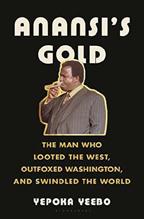
“This is a story of how lies change history,” writes Ghanaian journalist Yeebo. The lies at the center of her story are those of Dr. John Ackah Blay-Miezah, whose name and title were both lies. He claimed to hold the key to the (nonexistent) Oman Ghana Trust Fund, billions of dollars supposedly spirited out of Ghana by its first president, Kwame Nkrumah, and held in Swiss banks, ensnaring investors in a classic fraud. Yeebo makes clear that Blay-Miezah’s lies were founded on other lies—first those of the British colonizers, who “siphoned off over 150 million pounds” that were to have been held in reserve pending independence, and then those of the U.S. and British governments, which helped engineer the 1966 coup that toppled Nkrumah. The racism that underlay these actions also propelled many of Blay-Miezah’s investors, who “saw [him] spinning a tale about darkest Africa, untold wealth, and a corrupt leader….[T]he story—and the man—fit their preconceptions like a dovetail joint.” The great tragedy, writes the author, is that Blay-Miezah’s lies have become one of Ghana’s foundational myths. It’s an incredible story, told with muscular acerbity and populated by secondary characters as compelling as the leading man. There’s the diplomat duo of Shirley Temple Black, U.S. ambassador to Ghana, and Ebenezer Moses Debrah, Ghana’s former ambassador to the U.S.; Gladys Blay-Miezah, Blay-Miezah’s second wife, whose ability to track down her philandering husband earned her the nickname Columbo; and Joe Appiah, who successfully prosecuted Blay-Miezah in Ghanaian court only to see him freed after a brutal coup. Even as she catches readers up in what often reads like a breathless caper, the author takes care to ground them in what matters most: Ghana and its sadly “fragile” history. Utterly absorbing.

Yurkiewicz, Ilana
Norton (288 pp.)
$30.00 | July 11, 2023
9780393881196
A reflective doctor uses moving stories to reveal huge gaps and potential fixes in the deeply flawed American health care system.
Yurkiewicz’s poignant prose reads like a novel, knitting patient and personal stories with an honest insider’s evaluation of a highly problematic system. The author, a physician on the staff of Stanford Medicine, writes from her experiences as a resident, fellow, oncologist, and caregiver. As she states, the system is designed for reaction and “shifts blame onto individuals instead of focusing on sustainable systemic changes,” leaving patients and their families at serious risk. Yurkiewicz describes three major issues with the American health care system and presents the potential solutions. In the first part, “The Data Dig,” the author tackles the massive difficulties she encounters with electronic medical records. When a patient has a complex history, attempting to treat them is “like opening a book to page 200 and being asked to write page 201.” In the second section of the book, “Lost to Follow-Up,” Yurkiewicz calls for a more preventative-focused system. She uses multiple patient stories to explain the critical, yet common, problem of fielding a full team of doctors and illuminates the many issues involved with the pernicious 28-hour shift, “a rite of passage for doctors.” In “The Stories We Tell Ourselves,” the author criticizes many enduring myths about the U.S. health care system, and in the chapter titled “These Things Happen,” she examines her subject through the lens of her caregiving role for her ill father. “I started to see my dad’s hospitalization as an endless series of branch points: each of them could make or break the recovery of a critically ill person…His medical care was a game of risk.” Though Yurkiewicz may not fully solve the health care game, she provides plenty of food for thought for caregivers and medical professionals. An engaging read that paints an honest picture of how a broken system impacts patients and providers.

Zambreno, Kate Riverhead (256 pp.)
$28.00 | July 4, 2023
9780593421062
A deeply personal memoir of motherhood in a time of isolation.
In her latest memoir, Zambreno thoughtfully drifts through her daily
experiences parenting young children during the pandemic. The author opens at the end of summer 2020 in Brooklyn’s Prospect Park, where she brought her 4-year-old daughter and newborn, “another private pandemic baby who sees faces only at home,” for their weekly forest school. When not at the park, she and her husband alternated parenting duties while teaching online courses from their cramped apartment. This book bears similarities to Yuko Tsushima’s Territory of Light, a novel about “the vertiginousness of early motherhood, of exhaustion and despair and small joys,” which Zambreno was reading in stolen moments during the pandemic. Zambreno, too, lays bare her feelings of near-constant fatigue, effectively contrasting darkness and light, frustration and pure happiness. At the same time, she was reading artist Joseph Cornell’s diaries, strewn with scribblings that document the minutiae of his life. Like Cornell, Zambreno compiled a vast archive of notes, observations, and feelings “to catch something that’s vital or sublime,” which, for Cornell, provided what he called “a sense of illumination.” Of her own fragments, Zambreno asks, “Is that what these paragraphs are? Are they lightboxes?” Other artists provided similar inspiration, among them writer Natalia Ginzburg, whose “Winter in the Abruzzi” further nudged Zambreno toward seeking the light in each moment. The seasons, cycles of new Covid19 variants, finding a moment to commune with friends, the baby’s teething eruptions—all became measurements of the day’s passing. Zambreno’s writing is lyrical throughout, and allusion, imagery, and color—the pink of her feverish child’s cheeks, bright blue of the baby’s eyes, and constant green of the linden— take on the shape of waves upon which her readers drift pleasantly through this meandering meditation.
Through her unflinching chronicling of its externalities, Zambreno plumbs the poignant interior of her experiences.

Zook, Kristal Brent
Duke Univ. (232 pp.)
$27.95 | Aug. 7, 2023
9781478017196
A veteran journalist, activist, and writer embarks on a journey of introspection and healing.
Zook, a journalism professor at Hofstra and author of Color by Fox and I See Black People, grew up in 1970s Los Angeles with her mother and grandmother. There were candles, tarot, wrestling, tears, and joy, but there was also something missing. A biracial girl raised by Black women and abandoned by her White father, Zook was on a quest to find her place in the world. In this book, she writes, “I take a journey back to a time when I recognized the power of others to move mountains but couldn’t quite see the brightness of my own star. This story is my testament to the power of forgiveness and settling into one’s own authentic identity. In short, it’s my rediscovery of a little girl who once stood tall and joyful in
her favorite, beloved yellow poncho.” That little girl in the yellow poncho spent the next few decades searching for answers about herself, injustice, family, friends, politics, and race. As she examines her life and successful journalism career, the author writes with a pleasing combination of anger, consolation, and candid reflection. Readers get the sensation of peeking into a diary. One of the primary elements of the book is her tumultuous relationship with her father, which Zook reevaluates throughout the text. Zook is an impressive stylist, and her words teeter between witty and devastating. Highlighting what it means to be a biracial woman and declaring space for herself, Zook delivers a contemplative, therapeutic, and spiritual work.
“I saw myself as a race woman, in the old-fashioned Ida B. Wells sense of the word; a journalist who dug deep to lay bare injustices and hold a mirror to our collective trauma and triumph. I was down for the cause, despite what some may have seen when they looked at me.”
A powerful memoir about a woman’s odyssey for connection, self-identity, and love.
“A powerful memoir about a woman’s odyssey for connection, self-identity, and love.”
the girl in the yellow poncho
Alikhan, Salima
Illus. by Noor Sofi Simon & Schuster (40 pp.)
$18.99 | June 20, 2023
9781665901840
A child celebrates their multifaceted identity and heritage.
At school, with Multicultural Day looming, the unnamed narrator’s teacher asks the class to create a project that celebrates their cultures. The other students immediately identify objects that represent a single country or tradition. But the narrator identifies with three different countries: India, where Papa is from; Germany, where Mama is from, and America, where the family lives now. While at first this collection of identities feels confusing, a German, Indian, and American dessert combination sparks the epiphany the protagonist needs to realize that their story’s complexity is exactly what makes it beautiful. The next day, when the child shares their assignment with their classmates, they are delighted to learn that they are not the only student with a complicated heritage—or the only one who understands how rich a multiracial, multiethnic life can be. This richly illustrated, poetically told story builds upon the tradition of books like Natasha Wing and Robert Casilla’s Jalapeño Bagels (1996) and Malathi Michelle Iyengar and Jennifer Wanardi’s Romina’s Rangoli (2007) with one important addition: It honors the child’s American heritage alongside their parents’ immigrant status. The relatable narratorial voice and lively, momentum-packed pictures combine for a fast-paced story starring a protagonist who finds a creative solution to their problem. This child-centered story eschews pontification in favor of quirky, thought-provoking fun. (This book was reviewed digitally.)
An insightful, imaginative story about embracing our full selves. (Picture book. 38)
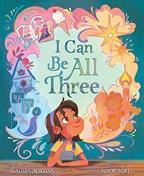
I love reading immigrant stories aimed at children, but many of these tales follow a formula that has long bothered me: An immigrant child joins a new community, where they are made to feel different; sometimes they’re bullied. When it turns out that the newcomer has a special ability, the other kids are suitably impressed, and the child is welcomed into the fold. While these stories are written with the goal of fostering acceptance, they send immigrant children another, unintended message: To truly fit in, you need to bring something remarkable to the table. It’s a heavy burden—what if you don’t have a talent with which to wow your peers? And why should a sense of belonging hinge on external validation? But I’m pleased to note that several new picture books offer powerful counternarratives. Multifaceted, nuanced, and deeply moving, these titles make clear that immigrants are more than enough just as they are.
In Zeno Sworder’s fantastical My Strange Shrinking Parents (Thames & Hudson, Jan. 10), two Asian immigrants give up inches from their height in return for a birthday cake, tuition, and other things for their young son; eventually they become so small that they move into a dollhouse built for them by their nowadult son. Though the boy is taunted by classmates because of his parents’ tiny stature, this is not a story about proving one’s worth; it’s about the boy’s growing appreciation of his parents’ heartaches and hard work. Drawing from the experiences of his own mother, who emigrated from China to Australia, Sworder finds beauty in the often unacknowledged everyday sacrifices that many immigrants make for their children.
Erika Meza’s To the Other Side (Katherine Tegen/Harper Collins, March 14) follows two Latine siblings as they cross the border from Mexico into the United States. In Meza’s strangely beautiful grayscale images, the vibrant hues of the masks the children wear (to “make us fast. Make
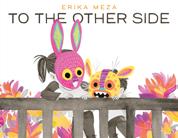
us brave”) contrast with the ghoulish monsters that would do them harm. Through it all, the older sister encourages her sibling to persevere despite exhaustion and fear; this is a much-needed testament to the bravery of refugees and to the strength of familial bonds.
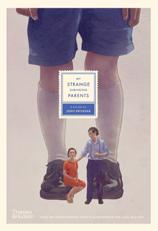
Two books celebrate the Windrush generation that, between 1948 and 1971, traveled by sea on the Empire Windrush from the Caribbean to England. John Agard’s Windrush Child: The Tale of a Caribbean Child Who Faced a New Horizon (Candlewick, April 11), illustrated by Sophie Bass, chronicles a family’s voyage, conveying their excitement, fear, homesickness, and joy through the eyes of their child. In Patrice Lawrence’s Granny Came Here on the Empire Windrush (Nosy Crow, May 2), illustrated by Camilla Sucre, Ava needs help picking someone she admires for a school project. Granny has many suggestions—civil rights icon Rosa Parks, singer Winifred Atwell—but Ava realizes that none of them compare with her own grandmother, who as a young woman left her family in Trinidad and endured cold, lonely days as she carved out a new life in London. Both books recognize the courage of uprooting one’s entire existence in hopes of a better life and emphasize that every immigrant’s journey is a story worth telling.
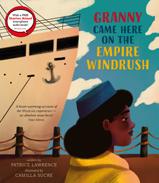

A lot can happen in 12 months, as the protagonist of Michelle Sterling’s Maribel’s Year (Katherine Tegen/Harper Collins, May 9) learns. The book opens in January, soon after Maribel and Mama depart the Philippines, leaving Papa behind, and concludes in December, with the family reunited. Sterling’s rich verse and Sarah Gonzales’ warm artwork depict the child’s adjustment to an unfamiliar climate, a strange language, and new traditions. Notably, this tale demonstrates that finding a sense of belonging isn’t instantaneous—it takes time for a child to finally realize they are home.
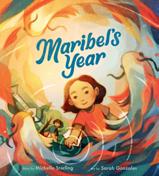
Mahnaz Dar is a young readers’ editor.

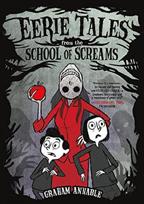
Annable, Graham
First Second (368 pp.)
$14.99 paper | July 18, 2023
9781250195036
A gathering of genuinely chilling tales, related by children in a classroom and presented in graphic format.
Invited by their teacher Ms. Nomed (mark the name) to tell “the eeriest story you have,” five young volunteers, variously light or dark of skin, stand up in turn to petrify their classmates. Alvin, for instance, shares a historical tale of a village that vanishes after previously friendly green bipedal “fish people” discover a taste for human flesh. Emily tells of a spaceship’s crew that looks human…right up until the tentacles shoot out of their eyes and mouths. Those and other tales that feature ghosts and conversations with a decapitated stranger are related in even tones that work effectively with the sepia and other subdued color schemes in Annable’s cartoon panels to provide properly slow builds to horrifying climaxes. The most lurid twist comes at the end of the last and longest entry, “The Door to Demons,” which turns out to be not made up at all but a frame story that touches off a mad scramble to escape a teacher who has suddenly transformed into a toothy, terrifying monster with a spectacularly weird upside-down head. It will take hardy readers indeed to sit comfortably in their own classrooms by day—or for that matter, hope for peaceful dreams at night—after these screamers.
Thoroughly, deliciously creepy. (Graphic horror. 912)
MR. S
Arnaldo, Monica
Katherine Tegen/HarperCollins (40 pp.)
$19.99 | June 13, 2023
9780063003958
One dreary day in room 2B, a class of kids embraces a sandwich as instructor.
On the first day of school, a lightskinned man carefully writes the words Mr. S on the blackboard and then, noticing that a tree has crashed on his car, dashes out to the parking lot, leaving behind a stack of papers and a sandwich. When a dozen or so big-eyed students arrive, they argue about what to do in the absence of their teacher, but when a ruler falls to the floor with a mysterious “THWACK!” the kids come to a conclusion: The sandwich is their instructor. Held together with a toothpick pierced through two green olives, Mr. Sandwich appears to glare at them, so they get to work, with a day of learning centered on (you guessed it) sandwiches. Attentive readers will delight in following the parallel plot through the classroom window as a series of disasters continue to befall the car and will enjoy the satisfying and creative twist. Salmon-colored walls invoke an appropriately unsettled feeling. Everything about the narrative
is playful, and readers will be sucked in by a seriously funny question: Can a sandwich be a teacher? The students are racially diverse; one uses forearm crutches, while another uses a wheelchair. (This book was reviewed digitally.)
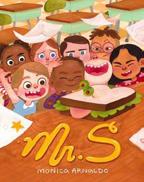
Far from stale and ripe for repeat reading. (Picture book. 47)
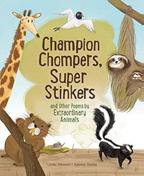
Ashman, Linda
Illus. by Aparna Varma
Kids Can (48 pp.)
$19.99 | June 6, 2023
9781525303500
In personified mask poems, animals boast about their claims to distinctions like biggest, strongest, and longest-tongued.
Together comprising a guessing game for readers, each short, rhyming verse is accompanied by a teaser illustrating part of the animal’s body. A page turn reveals each animal in its habitat along with its distinguishing “best” and a concise paragraph packed with well-chosen facts. After introducing three of the fastest animals—the cheetah, pronghorn, and peregrine falcon—Ashman spotlights the three-toed sloth in a witty poem called “Slowpoke.” “Although I know / I’m very slow / (the pokiest around), / I take first prize, / Endurance-wise, / For time spent upside down.” This tree-dwelling “SLOWEST Mammal” moves so little that greenish algae grow on its fur, helping to camouflage it from predators. Birds, fish, land and marine mammals, and reptiles are covered, and among renowned greats like the giraffe (“TALLEST animal”) and blue whale (“BIGGEST Animal Ever”), Ashman includes several fascinating, lesserknown species. Casting the white-spotted puffer fish as “BEST Undersea Artist,” she highlights the males’ extraordinary sandsculpting. Their “amazing circular designs of hills and valleys more than 20 times their body size” are designed to attract a female, who lays her eggs at the center. Varma’s appealing, digitally composed pictures simplify the animals’ salient features within a naturalistic palette of green, blue, and ocher. (This book was reviewed digitally.)
A brimming compendium that inventively mixes facts, poetry, and humor. (information on protecting endangered animals, measurements, and mask poems; websites; recommended reading; glossary) (Informational picture book/poetry. 69)
words of wonder from z to a
Asterplume, Z.B.
Feiwel & Friends (32 pp.)
$18.99 | July 11, 2023
9781250823441
A sparse pantry still holds possibility…and a tiger!
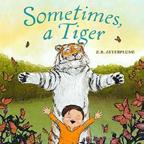
Dario opens the pantry to find few options for breakfast: “a can of beans, pretzels, pickles.” His hunger is forgotten, however, when he discovers a tiger hiding within. The boy and his tiger meet opposition throughout their day. Classmates question whether a tiger can ride the bus, his teacher finds the tiger distracting, and a neighbor eyes the pair with disdain. Dario greets each conflict with cheeky optimism until everyone discovers animal companions of their own and eventually begins to see “what could be instead of just what was.” With their perspectives shifted, Dario’s community comes together to fill his plate. Animals, including Dario’s tiger, a bejeweled giraffe, and an octopus clutching celery, are whimsically rendered, participating in visual gags that will delight young readers. While adults may use this book to start a conversation about food insecurity, the connection between Dario’s empty pantry and the parade of creatures is vague at best—without grown-ups to prompt discussion, most readers will be perplexed. Dario and his parent have light-tan skin and brown hair. His classmates and neighbors are diverse; one child uses a wheelchair. (This book was reviewed digitally.)
A sweet but confusing introduction to the value of mutual aid. (Picture book. 48)
Avantgarde, Zaila
(“L-A-U-G-H-T-E-R,” “K-I-N-D-N-E-S-S”), inviting readers to draw their pronunciations out slowly, as if to playfully savor their “feel.” A pithy quotation from luminaries such as Albert Einstein, Sitting Bull, and Shakira accompanies each word. Energetic, bold illustrations featuring dynamic patterns and characters diverse in skin tone, age, and physical ability greatly enliven the book. Readers should be strongly encouraged to create personal word lists and commentaries. (This book was reviewed digitally.)
In a word: Wonderful. (the origins of Zaila’s words of wonder) (Picture book. 710)

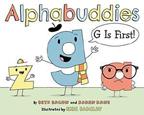
Bacon, Beth & Karen Kane
Illus. by Eric Barclay
Harper/HarperCollins (40 pp.)
$17.99 | July 4, 2023
9780063055971
The letter G’s plea that the letters take turns going first is almost defeated by A’s insecurity.
Illus. by
Keisha Morris Doubleday (40pp.)
$18.99 | $20.99 PLB | June 27, 2023
9780593568934
9780593568941 PLB
A spelling-bee champ welcomes readers to the zesty, awesome world of wording wizardry.
Whether you recite it from A to Z or in reverse, the alphabet’s cool, not to mention the words you can build by combining its letters in myriad ways. Such is the premise of this cheerful book that lists 26 empowering words, from Z to A—Avant-garde’s own initials—each beginning with a different letter of the alphabet (except X, for which extraordinary subs). Each word is a favorite of the teen author, who in 2021 became the first African American to win the Scripps National Spelling Bee. The word list begins and ends with the author’s own names (Zaila, meaning “mighty, powerful,” and Avant-garde, “to be at the forefront”). On each page, the same word appears three to five times, printed in boldfaced type, alongside brief, thought-provoking, upbeat observations. The words cavort spiritedly on the page in hyphenated form
An ABC book thrills G: “Look! It’s a book about us!” When A claims proudly to be “first, as always,” G invents a game called “G is first!” A strenuously objects: “You will NEVER be first!” because “It is all there in the song.” Changing the song, as G naturally suggests is dismissed. Though both G and Z agree that they should take turns going first, A says that changing the alphabet order would “DESTROY reading.” The two rebel letters proceed to sing “G, B, C, D, E, F, A,” and, finding that they survive, accuse A of scare tactics, leading to a confession that A’s rigid adherence stems from a fear of losing status. G and Z reassure A—after all, A is an entire word! A concedes happily that being first doesn’t matter. They sing a new version. Finally, the number 3 asks to join the fun; A and Z are dubious, but G and 3 begin singing, making 3 the third letter of the alphabet, and…BOOM! But it’s not the end of reading—just of the book. The small-panel comic illustrations are charming; the letters, with stick appendages, tiny accessories, and simple but expressive features, have distinct personalities. The bubble-text type is clear and at developing readers’ level, while the pacing and humor are deft. (This book was reviewed digitally.)
Hilarious and subversive. (Picture book. 48)

Baliga, Vikram
Illus. by Brian Lambert
Neon Squid/Macmillan (80 pp.)
$17.99 | July 11, 2023
9781684493296
A plant scientist explains why plants are important.
“In a word: Wonderful.”
This very simple survey starts off with introductions to the greenhouse effect (which, Baliga writes, is making our planet “warmer and weirder”) and other environmental issues but then really goes back to basics: “Most plants have leaves, stems, and roots, and they’re an important source of food for animals and humans.” From there, and ignoring his own definition to bring algae and fungi into the discussion, he goes on to a quick flurry of select vegetative topics and wonders, from the various sustainable uses to which beets, bamboo, and banana trees are, or theoretically could be, put and the importance of taking care of soils and habitats to the often vaguely worded medicinal values of plants, before closing with a push to grow houseplants and cultivate window boxes. Aside from the speculative passages, which the author tosses off without furnishing either specific examples or leads to further information, little of this is likely to be new even to very young audiences. Still, as a refresher, this does offer a cheery outlook as well as the visual appeal of the ever reliable Lambert’s bright renditions of flora, either isolated or in natural settings, being tended to by a racially diverse cast.
Rambling and untidy but may take adventitious root. (glossary, index) (Nonfiction. 68)

BeKa
Illus. by Maya

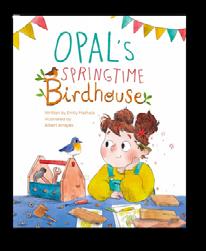
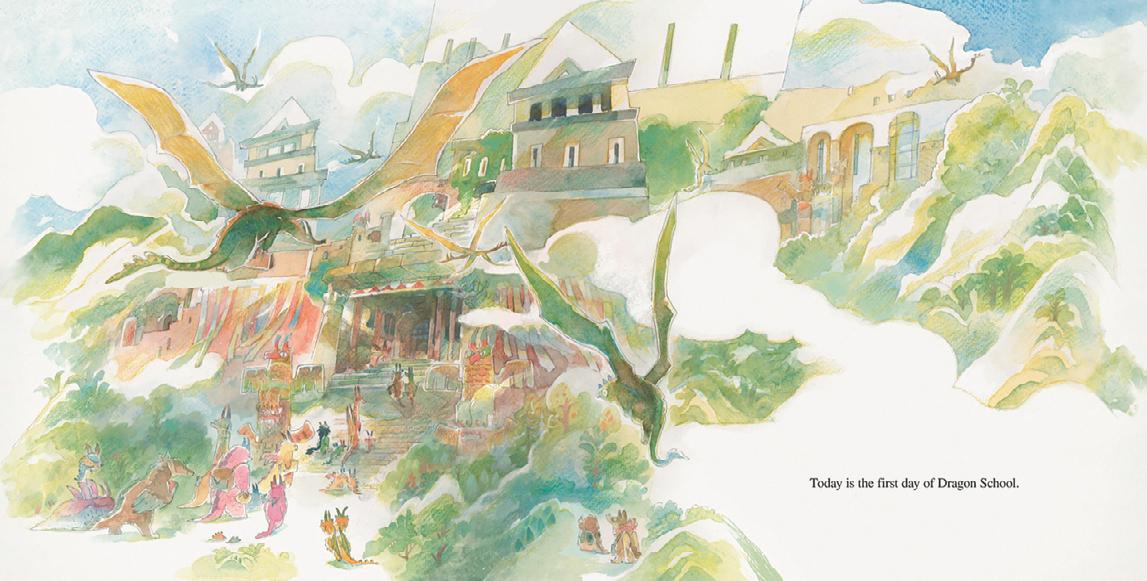

Trans. by Jessie Aufiery & Ivanka Hahnenberger
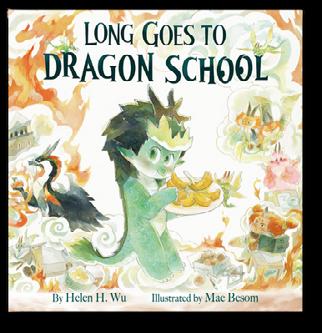
Hippo Park/Astra Books for Young Readers (192 pp.)
$19.99 | $12.99 paper | June 13, 2023
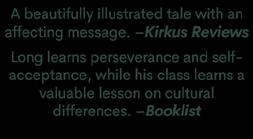

9781662640407
9781662640414 paper

Two middle schoolers set out to investigate what love truly means.

Lola loves love and wants to understand it better now that she has a crush on a classmate. Her best friend, Grace, whose parents’ arguments at home are escalating, has a more cynical view of romance, but she’s still willing to help. So the pair go around school, interviewing couples and gathering gossip about who has a crush on whom. For all the nuanced issues this graphic novel, translated from French, attempts to explore—among
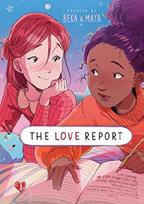
them slut-shaming and the pain of first love—too many shallow caricatures remain. Nearly all the boy characters come off as unfeeling, selfish jerks whom girls are justified in mistreating when their feelings aren’t returned. Scattered storylines mix with contradictory takeaways—the boys are rightfully depicted as sexist for ranking the girls by physical attractiveness, but the girls’ decision to reciprocate comes across as justifiable revenge. And even after Lola and Grace realize that Felicity, a beautiful and popular classmate, has hidden depths, Lola still refers to her as a “bimbo.” Further, the boys’ objectification of Felicity is framed as inevitable rather than something to push back against. Many characters have similar facial designs, giving the artwork a generic look. Lola, Felicity, and most other characters present White; Grace is Black.
A superficial and meandering exploration of friendship and love. (Graphic fiction. 1015)
 Bird, Daisy Illus. by Marianna Coppo
Bird, Daisy Illus. by Marianna Coppo
Tundra Books (48 pp.)
$18.99 | Aug. 22, 2023
9780735268012
What the beginning of the universe, the Mona Lisa’s smile, and certain other epochal touchstones in between have in common.
Pandering again to audiences that can’t get enough of certain words—or in this case sound effects—often enough, the creators of Whose Poo? (2021) string together a series of events linked, in Coppo’s elementally simple gouache frames, by small green clouds emerging from one butt or another with disproportionate consequences. A family of mice sits down to watch a “very serious” documentary. “Best show ever!” squees a child to a discomfited parent as the first “PFFFT!” bursts into stars and galaxies, the next one from a tiny primordial fish drives animals out onto dry land, another from a volcano leads to the downfall of the dinosaurs (“Dad, is that why it’s called exSTINKtion?”), and later putts end an ice age, cause the Sphinx’s nose to fall off, knock the apples off Isaac Newton’s tree, and other watershed events. Critics might carp that the fumes sending a diversely hued crew of Vikings fleeing to North America come from a whale’s blowhole…but any port (so to speak) in a storm, and it’s not like accuracy is a priority here. Dad as usual becomes the (wait for it) butt of the joke as he produces the biggest PFFFT! of all while indignantly reaching for the remote’s off switch. Why dads should be unamused by this breezy revisionist history is anybody’s guess. (This book was reviewed digitally.) Strictly for cheap laffs. (Picture book. 46)
Birdsong, Bea Illus. by Linzie Hunter
HarperCollins (32 pp.)
$18.99 | June 20, 2023
9780063214804
Join the fun and be the “boopiest booper with booping flair!”
Get your finger ready to boop a dog on the snoot. As Birdsong explains, a snoot is a nose, and a boop is a gentle tap. After all, “snoots need boops.” The floppy-eared golden canine star of this tale loves boops and celebrates after receiving one. (A warning opposite the title page notes that children should ask permission before booping a real dog.) One spread contains a counting exercise as readers are asked to count “One snoot. Two snoots. Three snoots. Four. And boop one more!” Young listeners will love interacting with the playful cartoon illustrations to find and give boops to the “floofiest” and “smooshiest” snoots. Another page invites them to boop a pooch sitting on a seesaw, one who’s standing on a wagon, and another who’s lying upside down on a giant ball. The dogs’ excitement increases with each creative page turn. Readers must even rotate the book 90 degrees at the height of the “boopiest boop-bonanza.” Amid all the joyful chaos, the main dog looks directly at readers and orders them to “STOP the BOOK!” After all, “there’s one more snoot that needs a boop!” Laughter will ensue as readers are asked to get their fingers ready and boop their own snoots. (This book was reviewed digitally.)
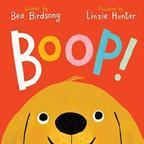
Will give adults and children alike many reasons to giggle. (Picture book. 14)
Bloom, Molly, Marc Sanchez & Sanden Totten
Illus. by Tiffany Everett
Little, Brown (40 pp.)
$18.99 | July 25, 2023
9780316459471
A third grader brings her microbiota to show and tell in this picture book from the creators of American Public Media’s podcast Brains On!
Putting a glossy shine on the topic, young Dominique, who presents Black, exuberantly fills her diverse and equally gobsmacked classmates in on the “various viruses, funky families of fungi, and mini mites” that teem by the trillion on and in her body. In the bright cartoon illustrations, Everett opens with 10 children and their teacher sitting in a circle, then zooms in for glimpses of googly-eyed mites laying eggs between eyelashes, stomach germs in hard hats breaking down a sprig of broccoli, grimacing intestinal “micro-pets” producing gas (“kaboom! Mega-fart!”), and other critters making “cool plaque sculptures” on teeth or helping the immune system repel “not-so-nice” intruders. By the time the young STEM winder is winding

down (“Plus, they’re great listeners, they love to snuggle, and I never need to walk them”), everyone in class is clamoring for micro-pets of their own. Guess what? “You already have them!”
For readers who haven’t made a (futile) dash for the showers at this news, the authors supply light injections of reassurance and further facts at the end along with a list of relevant podcast episodes and a Q&A ascribed to the spinoff podcast Moment of Um. (This book was reviewed digitally.)
An invitation to meet the neighbors infused with relentless, though apt, positivity. (Informational picture book. 79)

Bourne, Shakirah
Scholastic (304 pp.)
$17.99 | June 6, 2023
9781338783575
A 12-year-old discovers more than she bargained for as she determinedly faces her fears.
Serenity Noah is a Black girl from “a mysterious Caribbean island” who’s plagued by a recurring nightmare. Consequently, she’s decided to face her fears, developing an obsession with horror movies and even making her own with the help of her younger brother, Peace. Calm, well-behaved Peace is the opposite of Serenity, whose loud voice makes her soft-spoken parents anxious. That is, until the day when Peace has a screaming meltdown; later he says shadows called his name and were trying to take him away. Now he’s unable to sleep alone. Serenity’s parents take him away for a silent retreat on Duppy Island,

“Bourne’s sophomore novel for young readers delivers a thrilling storyline filled with twists and turns.”
nightmare island
When Aida Salazar and Yamile Saied Méndez first met in a Facebook group for kid lit writers of color, their commonalities made the friendship feel like serendipity. They were both newly minted Latine authors in a predominantly White market, both mothers who imbued social justice in their parenting and praxis. And they were both fascinated with depictions of menstruation in American literature for young readers.
“I shared that my debut [novel] was a menstruation story,” Salazar explained in a recent video chat with both authors, referring to her Kirkus-starred title The Moon Within. “[Yamile] said, ‘I wrote my thesis on that!’ That’s how it all began.”
Méndez clarifies that her thesis, written while completing her MFA at Vermont College of Fine Arts, explored representations of biologically female puberty in children’s fiction. Her research indicated that The Moon Within was the first menstruation-centered book published in the U.S. since Judy Blume’s Are You There God? It’s Me, Margaret. came out in 1970. It also suggested that Salazar’s book, which features a Black and Puerto Rican main character, was the only menstruation novel with a non-White protagonist ever published in the United States. Salazar had suspected as much but hadn’t known for sure.
“It made me incredibly sad and angry,” Salazar says, “both that we had to wait generations to have a book that even discusses the topic and that I was the first [American] woman of color to write [a novel] about menstruation. Ever.”
Her desire to address this inadequacy motivated Salazar to write a proposal for what would become the anthology Calling the Moon: 16 Period Stories From BIPOC Authors (Candlewick, March 28), which received a starred Kirkus review.


During the pitching process, Salazar asked Méndez to be her co-editor, and Méndez readily agreed, helping to bring together an impressive roster of critically acclaimed writes who are Black, Indigenous, and people of color. Among the contributors: Newbery Award winner Erin Entrada Kelly, Kirkus Prize winner Christina Soontornvat, and National Book Award finalist Ibi Zoboi. (Méndez herself is a Pura Belpré Gold Medalist, and Salazar’s debut won the International Latino Book Award.)
Explaining her enthusiasm for the project, Méndez says, “One of the main things that can have a positive effect on a person going through puberty is information. The more we talk about it, the more information young readers have.”
But while there is a plethora of teen-friendly scientific information about menstruation, Méndez says, there remains a lack of emotional information—something short stories are uniquely equipped to provide.
“Stories have the power to show what it means to go through these changes,” she says. “The experience of growing up is not the same from person to person. We wanted the stories to reflect different cultures and different time periods—like how some societies’ views of periods have changed and how some haven’t.”
To this end, the co-editors included stories like Saadia Faruqi’s, in which a young Muslim girl’s first period forces her to postpone her long-awaited first Ramadan fast; Padma Venkatraman’s, in which a group of Hindu friends
stage a protest when one of them is banned from religious rites because she’s menstruating; Elise McMullenCiotti’s, in which a Cherokee girl draws strength from her grandmother’s traditional tale about period power; and Zoboi’s, in which a New Moon Rebirth ceremony ties a new menstruator to her ancestors.
Another topic the co-editors knew they had to tackle was the array of challenges BIPOC menstruators face in a patriarchal, White supremacist society.
“Girls in our demographic, they’re starting to go through puberty earlier. That’s such a big issue,” Méndez says. Indeed, recent studies show that Black and Latine menstruators tend to get their first periods before their White peers. (Asian American menstruators do not follow this trend, and research about Native American menstruators is almost impossible to find.) “Plus, there is anecdotal evidence that BIPOC girls are sexualized younger and younger. They’re obliged to grow up faster than their [White] counterparts. That’s something that really affects children’s psyches.”
Of course, BIPOC menstruators hold many identities beyond race and ethnicity, some more oppressed than others. For this reason, Salazar says she felt it was vital to include at least one “gender expansive” character in the anthology, which is why she asked Mason J.—who, in their bio, describes themself as “gender creative” and proud of “their biracial, music nerd, Two-Spirit, punk and writer identities”—to contribute a story with a nonbinary protagonist.
“People who are fighting the good fight for reproductive rights know that it behooves all of us to be inclusive,” Salazar said. “That means we have to understand not only that trans people menstruate and people of other genders menstruate, but also that some women don’t menstruate at all.”
Despite their best efforts, though, Méndez says there were still identities that they were unable to include. Most notably, she says, none of the protagonists in the book are disabled.
“We were sad that we couldn’t include more voices,” Méndez says, “but also, we’re hoping that this anthology will be one of many.”
Salazar agrees, stating that the anthology’s purpose is to “break open a door” to a wider variety of stories— something that feels especially urgent in the current legislative climate. Salazar observes that the Supreme Court’s 2022 decision to strike down Roe v. Wade has had a devastating effect on the reproductive justice movement, most recently spurring a bill banning menstrual education in Florida elementary schools. Additionally, in 2021, there were 117 anti-trans bills introduced in the U.S., a number that CNN called record-breaking, at least un-
til this year: As of this writing, the ACLU is tracking 430 anti–LGBTQIA+ bills in the first three months of 2023 alone.
But just because Calling the Moon breaks silences around menstruation, race, and gender doesn’t necessarily mean it will reach those who need it most. Censorship in the U.S. is at an all-time high: According to the American Library Association, more than 1,200 books were challenged in 2022, which was double the number from 2021. Salazar and Méndez believe that this wave of repression will certainly affect access to Calling the Moon
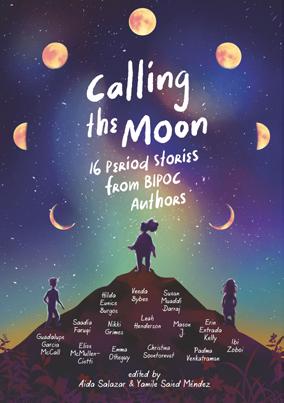
“Even if it’s not an official ban, there’ll be soft censoring,” Méndez says, alluding to gatekeepers like teachers and librarians who could keep the book off their shelves. “It’s not if but when.”
Nowadays, the world can feel like one giant trauma trigger, particularly for BIPOC menstruators like the ones featured in this book. For this reason, Méndez says, it was important that the anthology retain a sheen of optimism and promise. Consequently, every protagonist in the book experiences a happy ending, something the coeditors hope both BIPOC and non-BIPOC readers notice.
“Literature is a sanctuary,” Salazar says. “When we can see one another and learn empathy through the sanctuary of literature, I think we’re giving the world an incredible gift.”
“Our children deserve to see joy on the page,” Méndez adds. “They need to know that, yes, things can be difficult, but that we can also break through patterns of patriarchy and misogyny and lead happy lives. To show that there is hope: That, in itself, is a rebellion.”
Mathangi Subramanian’s novel A People’s History of Heaven was a finalist for the Lambda Literary Award. Calling the Moon received a starred review in the Jan. 15, 2023, issue.
alarming Serenity—after all, duppies are “malicious spirits that haunt people at night.” She stows away on a boat and, arriving on the island, uncovers secrets that both excite and scare her about Dr. Whisper, who is running the retreat; evil douens, faceless spirits of children; and her own ancestral lineage. Bourne’s sophomore novel for young readers delivers a thrilling storyline filled with twists and turns. Readers will be captivated by Serenity’s voice, original perspective, curiosity, and bravery as they eagerly follow her journey.
A horror story with strong appeal for fans of the genre featuring a bold, intriguing protagonist. (Paranormal. 812)
Boyer, Stéphanie
Illus. by Caroline Hamel
Trans. by Carine Laforest
CrackBoom! Books (32 pp.)
$17.95 | Aug. 29, 2023
9782898024160
A clown’s hair takes flight. Momo has a scribble-scrabble poof of red hair. It’s on his head when he walks out the door, but when he runs to catch the bus, the hair is gone. The repeated refrain—the question on everyone’s mind—rings out: “Where did Momo’s hair go?” Oh no! Here it is…“on the head of Mrs. Strudel’s poodle.” But then the pup sneezes, and the hair is off once again. It flies through the air many times, always landing on various dogs. The breeds rhyme with their owners’ names (“Ms. Peppard’s German shepherd”), although some feel like a bit of a stretch, perhaps the result of translating the text from the original French. Transportation enthusiasts will enjoy spotting the many forms of transit found along the hair’s flight path (even a unicycle). The playful text has momentum built in with the pursuit of Momo’s hair, but Hamel’s quirky art steals the show. Dollops of bright colors, accented with squiggles, dots, and dashes, imbue the illustrations with fluidity and movement. Momo’s city includes human inhabitants (with all skin colors, including blue; Momo has skin the white of the page) and anthropomorphized animals. The story ends on a cliffhanger, inviting readers to fill in the rest. (This book was reviewed digitally.)
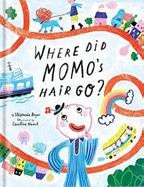
A silly romp through a silly town. (Picture book. 36)
Braden, Ann

Nancy Paulsen Books (176 pp.)
$17.99 | May 2, 2023
9781984816092
A 12-year-old girl learns that questioning faith can make it stronger.
Agnes, named after a saint who at age 12 was dragged through the streets when she chose to devote herself to God
rather than marry, is having a hard time believing in the God she’s been told about—an old man with a white beard. She can’t help but question the sexism of original sin and the cruelty of the Old Testament God. After helping to rescue a mother opossum, Agnes learns that playing dead is a survival skill for these marsupials. She comes to identify with the opossum—by going along with confirmation classes despite her doubts, is she merely “playing dead”? Through eye-opening talks with her anthropologist neighbor, creative writing exercises from the perspective of an opossum, and the powerful poetry of Maya Angelou, Agnes finds a version of God that makes sense to her and realizes she has the power to challenge authority. Braden crafts a nuanced story supported by clear metaphors and honest, deep emotions. Readers faced with similar situations will find support here even if it’s only the confirmation to keep questioning. As Agnes learns and grows, she comes to realize that there are many conceptions of religion and God—that God could be a Black woman, for instance. Agnes, her single mother, and most other characters are presumed White.
Mind-expanding. (Fiction. 813)
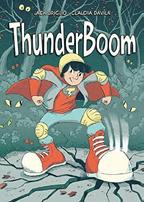
Briglio, Jack
Illus. by Claudia Dávila Kids Can (128 pp.)
$16.99 | May 2, 2023
9781525304965
Anyone can be a hero.
A mostly nonverbal boy named Logan is excited to see a holiday parade with his family. On the way there, he greets many people on the train, including a younger brown-skinned girl with a stuffed bear. Once they arrive, Logan squeezes through the crowd and finds himself surrounded by people in masks—something he definitely does not like. In his imagination, they morph into tall, bushy-haired monsters. But that’s nothing that ThunderBoom, Logan’s imaginary alter ego, can’t handle with his sonic foot stomps. Later, Logan finds the girl from the train, also separated from her family, and helps save her teddy bear from baton-twirling “ninjas.” Logan also encounters grocery-store mascots that, in his mind, morph into robots and a loud neighbor dog who may just be misunderstood, like Logan. Logan narrates the imagination sequences, his confidence, helpful, friendly nature, and frustrations on full display—though all of these are evident in the rest of the story as well. Expressive cartoon art, dominated by oranges and blues, adeptly conveys Logan’s story. Based on Briglio’s son’s experiences and diagnosis of Angelman syndrome (a genetic disorder that causes developmental delays and speech impairment), this tale shows the rich, inner life of someone who isn’t always understood, even by those who love him. Brownskinned Logan is biracial—his dad’s family is Italian and Whitepresenting, while his mom is brown-skinned.
Dynamic heroism wrapped in realistic adventures. (Graphic fiction. 812)
“Mind-expanding.” opinions and opossums
Bury, Katryn
Clarion/HarperCollins (304 pp.)






$16.99 | April 18, 2023
9780358701521
Middle school detectives confront locker thefts and ransom notes.
Drew Leclair, future FBI profiler and current seventh grader, does not want to get into trouble like she did after her last successful sleuthing outing (Drew Leclair Gets a Clue, 2022). That’s how you get suspended from school and don’t get to go to Quantico. But who else can investigate these serial thefts? All kinds of kids—mostly kids who don’t have a lot of money but who saved up for something special—are getting treasured items stolen right out of their lockers at school. A couple of the crimes have even been accompanied by threatening letters created from cut-and-pasted newsprint. There has never been a
better excuse to pull out thumbtacks and red thread for Drew’s crime board. Meanwhile Drew struggles with her feelings about Alix Chang, because while Drew’s known for a while that she’s probably bisexual, she’s still pretty sure that she’s not going to become interested in actual kissing. Drew, who has asthma and anxiety, is one of the few White students in a setting diverse in race and sexual identity and orientation that also includes students who are physically disabled. A funny, likable cast of characters inspects the evidence to solve a mystery together, culminating with an excellent use of glitter.
Humorous, charming, and a win for mystery fans. (Mystery. 912)
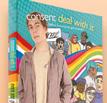

“…patiently and clearly sets each scene, identifies the issue, offers real-life examples, and provides do’s and don’ts to help readers navigate the various scenarios.”
— Kirkus Reviews
“Interactive format… Great for group discussion.”



“Empowering and useful.”
— Booklist
— Kirkus Reviews
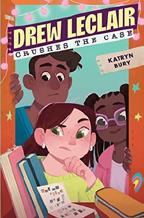
• Real-life situations kids face


• Kid-friendly treatment of tough topics


• Q&A’s, quizzes, and advice columns









• Conflict resolution ideas that are age appropriate
• All perspectives discussed — victims, bullies, and witnesses
• Diverse racial and ethnic backgrounds, gender identities





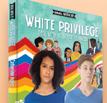


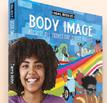
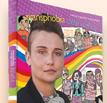

• Graphic novel-style illustrations
• Approachable reading level
• Supports for critical thinking, challenging biases
• For grades 4 and up, ages 9 to 14
Carzoo, Breanna
Harper/HarperCollins (32 pp.)
$19.99 | July 18, 2023
9780063054066
Is it fair that everyone stops for the red light, slows down for the yellow…but at the first sign of green just zooms away?

Carzoo, staunch defender of the lowly fireplug Lou (2022), champions another essential infrastructural stalwart. “I used to think I was super bright, and sparkly, and spectacular…but every time I share my light with the world,” grumbles the traffic signal, “it’s like they can’t get away from me fast enough.” Well, “I’m done shining!” Rendered with utmost simplicity in the flat paper collage pictures, the dissed disk closes its googly eyes—and discovers that being alone in the dark offers peace, quiet…and a chance to take stock (in words addressed as much to similarly discouraged readers): “There’s nothing wrong with you. You’re a good light.” And when the realization that being liked by others is less important than liking oneself turns out to be literally eye-opening, the discovery of a massive pileup of waiting traffic on the road below keys both a refreshed sense of agency and an exhilarating climactic “GO!!!” that irresistibly invites young audiences to holler along…and to let their own lights shine. (This book was reviewed digitally.)
A stopper for readers ready…and set to…GO! (Picture book. 58)
Chantler, Scott
First Second (176 pp.)
$14.99 paper | May 9, 2023
9781250249340
Series: Squire & Knight, 1
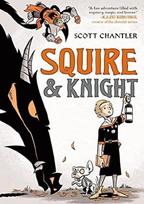
A knight and his squire take unique approaches to helping a plagued town.
Sir Kelton of Eldergard and Squire arrive in “cursed” Bridgetown, whose inhabitants live in fear of a nearby dragon and where everything seems to be going wrong, from failed crops to a leaky boat. Orange-haired Sir Kelton boldly vows to defeat the dragon and rides off, leaving skinny, young, blond Squire behind. Squire’s research in the Hall of Records—where a horned, three-eyed, four-armed archivist tells him about the town’s founder, a powerful wizard—reveals there is more here than meets the eye and high stakes for both townspeople and dragon. Squire puts together clues from the archivist and townsfolk to discover the truth about the wizard, the dragon, and the alleged curse. A palette of autumnal colors, effective use of light and shadow, and a variety of page layouts are visually appealing and make the action easy to follow as Chantler recognizes and subverts typical fairy-tale tropes with dry humor (Dragon to Squire: “And how did you get into my basement?”). Our hero—Squire, not Sir Kelton—is intelligent, brave, and honorable, a perfect foil to
the knight’s ineffectual bravado. This tale is delightfully compact in eight chapters and an epilogue, with the possibility of more to come. Sir Kelton and Squire are light-skinned; the supporting cast varies in skin tone.
Compelling and full of adventure, with a plot as clever as its main character. (author’s note, character sketches) (Graphic fiction. 812)
Cheng, Jack Dial Books (320 pp.)
$17.99 | June 6, 2023
9780525553823
A Detroit tween comes into his own while adjusting to changes at home and dealing with the trials and tribulations of sixth grade.
Starting middle school is daunting, and Andy Zhou is off to a rough start after the DIY bleach job that Cindy Shen, his best friend, convinces him to try results in patches of orange in his black hair, drawing the attention of bullies. Empathetic Andy tries his best to be the person that his friends and family need him to be, but juggling those roles isn’t easy, especially when he’s not sure what it is that he wants. With Cindy spending more time with new friends and mounting racist microaggressions setting off his “spider-sense,” Chinese American Andy can’t shake the feeling that he doesn’t belong. But just as he resolves to keep his head down, he discovers that Chaldean American Jameel Zebari, one of his bullies, might have more in common with him than he thought. Peppered with anime and pop-culture references, Cheng’s tale succeeds in capturing the nuances of shifting relationship dynamics during the vulnerable early years of adolescence, including mental health struggles. Although the reasons behind some of Andy’s pivotal epiphanies may be a bit subtle for some readers, the story has a sincere heart that will resonate with tweens as they recognize themselves and their friends in the pages.
A perceptive coming-of-age tale that captures the joys and complex anxieties of middle school. (content note, author’s note) (Fiction. 1013)

KARIBA
Clarke, James
Illus. by Daniel Clarke Catalyst Press (230 pp.)
$19.99 paper | June 6, 2023
9781946395825
A young Black girl in 1950s southern Africa experiences a life-altering journey while searching for her father.
While paddling down the Zambezi River seeking treasure on a hidden island, Tongai stumbled upon

a baby girl and brought her home. Now 11, Siku is intelligent and adventurous, so much so that Tongai decides they will move to Salisbury (present-day Harare, Zimbabwe) to further her education. However, as she grows, Siku’s connection to Nyaminyami, the Great River Spirit, and her ability to manipulate water are revealed, putting her safety in jeopardy. Tongai heads to the site of the Kariba dam, a colonial European project that displaced many people, to try to save his daughter, but he disappears when his plans go awry. After they are kidnapped by pirates, Siku escapes with Amedeo, an Italian boy whose mother is working on the dam. As they journey to find Siku’s father, they meet some Shonga people, whose chief offers Siku guidance and helps her connect with a mystical being who informs her of the pivotal role she can play in fulfilling a larger purpose, should she choose to. This fast-paced work, full of daring acts and highlighting Siku’s powerful voice, has a backdrop inspired by colonial history. The illustrations are reminiscent of an animated feature, with strong facial expressions and vivid hues. The varied style of the panels adds extra vigor, particularly when Siku is having watery visions, as the shapes and edges become fluid.
A dynamic, mystical coming-of-age story. (historical note) (Graphic fantasy. 1014)
Coats, J. Anderson
Atheneum (288 pp.)
$17.99 | June 20, 2023
9781665912358
In medieval England, Tick (short for Scholastica) has spent her childhood helping her chandler father make candles and wax charms to sell.
The annual Stourbridge Fair near Cambridge brings in the bulk of their year’s earnings. But when Papa takes on a boy as an apprentice, Tick finds herself pushed away, relegated to helping with the cooking, cleaning, and gardening. Tick resents this, feels rejected by her father, and decides she does not want to grow up or, as she puts it in the story’s first-person, present-tense narration, become “young-womanly.” The description “young-womanly” reappears many times as Tick grapples with gender expectations. She observes her friend Johanna no longer being hugged by her father since she became “rounder in her womanly places”; Tick wonders if the same thing will happen with her father, a concern that is conveyed in a way that might feel to readers uncomfortably close to sexualizing the fatherdaughter relationship. When Tick defies her father and makes her wax charms to sell at the fair without his knowledge, the frequency of her often repeated assertion that her father will be grateful and realize how indispensable she is undermines any tension that may have otherwise built up. The work includes some archaic phrases and words, and the olfactory challenges of the time period are vividly conveyed, but overall the worldbuilding feels thin, and the story fails to compel.
A flat story of a girl challenging the limitations society puts on her. (Historical fiction. 1014)


HarperCollins (32 pp.)
$19.99 | June 13, 2023
9780063059610
School administrators enact different visions of success.
Principal Keene is proud of his “fine, fine school,” where racially diverse students draw, sing, and read to their hearts’ content. But when acute appendicitis results in a hospital stay, the district sends Mr. Tatters—the weedy, pinchnosed opposite of Mr. Keene’s rotund joviality (both lightskinned)—to look over Fine Elementary School in his absence. Tatters disapproves of creativity and implements a strict testing policy, to the dismay of students and teachers alike. Luckily, Mr. Keene’s hospitalization proves brief, and upon his return the school goes back to its colorful, inventive self. Student Tillie (who is light-skinned) takes Mr. Tatters around and represents the schoolchildren as a whole but never establishes a personality of her own. This story seems more for adults than children, since students have little to no influence on school policy and don’t need to be informed that test-taking is less fun than art and music. Key repeated words (“fine, fine,” “smart, smart,” “empty, empty, empty,” “sad, sad, sad”) seem extraneous, as does a lot of the text in this word-heavy read-aloud. Detailed illustrations in a muted color palette maintain a somber tone throughout, even under the rambunctious eye of Mr. Keene. (This book was reviewed digitally.)
A staid story about the importance of fun. (Picture book. 57)
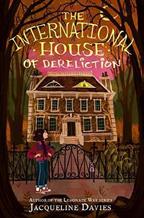
Davies, Jacqueline Illus. by Julia Castaño
Clarion/HarperCollins (240 pp.)
$18.99 | July 18, 2023
9780063258075
A project-oriented child has her work cut out for her in a long-abandoned house with several resident ghosts.
No sooner does 10-year-old Alice discover that the derelict house next door has a heartbeat and is somehow aware of her than she knows what she must do. First, fix up at least the living room—a task of which she is perfectly capable, having assisted her father in refurbishing the last 11 houses they have lived in. Second, help the four ghosts she meets resolve the “Unfinished Business of the Heart” that’s kept them from moving on. This proves considerably more difficult—but with Alice’s being “a rare old soul with more flint and steel in her small body than most people might have guessed,” it’s not impossible despite obstacles ranging from a furious poltergeist to righting the shocking, shocking wrong of an overdue library book. Davies
“Well cast, well told, but mostly just terrific.”
the international house of derelection
if i had a crocodile
really cranks up the climax with the unexpected arrival of a demolition crew, but by that time the cast has already made this a magically immersive experience. Only the stony of heart could fail to fall in love with clever, competent, resolute Alice or, for that matter, the supporting cast that includes her adorable parents and a host of unfailingly interesting ancestors. On their way to the poignant, satisfying close, thoughtful readers may find some new insight into what Goodnight Moon is actually about, too. The cast reads White. Final art not seen. Well cast, well told, but mostly just terrific. (Paranormal. 912)
Dawnay, Gabby
Illus. by Alex Barrow Thames & Hudson (32 pp.)
$15.95 | June 27, 2023
9780500653050
Series: If I Had A...
What would life be like with a toothy green reptile for a pet?
With this series installment, the creative team is in fine form as the series’ star, a small Black child in a blue dress and signature curled-brim hat, considers the advantages of a crocodile companion. There’s nothing wrong with fish or birds, but the child aims for a pet “with lots and lots of style”—like a croc. Crocodiles are “jazzy,” so at school the child and the croc will “practice clarinet”—though the svelte reptile appears to be playing percussion on his own scaly spine—in the “Count Snappy Quintet.” The crocodile gamely allows his elongated snout to serve as a playground slide and ferries children in pirate costumes on a small pond. Child and pet pose at the ballet barre and dine out, after which the child has to deal with cleaning up croc droppings. As the child uses an industrial scrubber to brush the croc’s choppers, their parents (one brown-skinned, one slightly lighter-skinned) hover approvingly in the doorway. The rhyming and rhythm are irresistible, ideal for storytime, with plenty of fun vocabulary (pizzazz, fangs). The child’s friends are diverse. Strikingly composed illustrations are as important as words. The game of snap leads to a punning image of jaws and cards. Warm closure replaces a final narrative surprise, and the penultimate illustration is the cleverest, incorporating references to other images in this book and to other titles in the series. (This book was reviewed digitally.)
Snappy images and jazzy rhymes make this a delight to read aloud. (Picture book. 36)
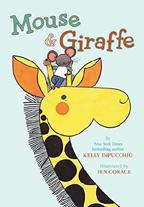

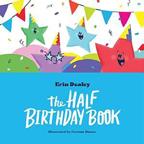
Dealey, Erin
Illus. by Germán Blanco
Genius Cat Books (24 pp.)
$14.99 | April 25, 2023
9781938447556
Dealey and Blanco give kids another day to celebrate each year.
Though the buildup and celebration start on the first page, it’s not until over halfway through the book that a HALF birthday is finally described: “add 6 months to your actual birthday!” Though Dealey’s HALF Birthday Buddies—a group of anthropomorphic stars—may not rival the Tooth Fairy in terms of popularity any time soon, their enthusiasm and sneakiness cannot be faulted, as they exuberantly leave decorations for sleeping children, bake a HALF cake, and leave HALF invitations. And though they will hide from view, you may hear them sing the HALF birthday song. The rhyming text describes further activities for a HALF birthday party with family and friends, though presents are not a part of this celebration, even HALF ones. There are a few spots for the owner to write in personal details, making this more of a gift book than one for library circulation. The digital illustrations are reminiscent of Saturday morning cartoons, with bright colors and diverse, overly excited children. Backmatter offers kids the opportunity to go back and find several HALF objects as well as their other halves. But some aren’t to be found in the illustrations or don’t match the pics on this page. For example, half a lamp is never shown whole, and the HALF paint jar is pink, not green, plus there’s a gift despite what the text stated. (This book was reviewed digitally.)
Don’t hold your breath waiting for HALF birthday invitations. (Picture book. 37)
Illus. by Jen Corace
Viking (40 pp.)
$18.99 | July 18, 2023
9780593465035
A giraffe and mouse don’t see eye to eye—quite literally.
Giraffe is so very tall, and Mouse is so very small. They live next door to each other and meet every day by their mailboxes for a sip of tea. But Mouse and Giraffe’s arguments are endless. Giraffe, whose head is blazing in the sun, thinks it is much too hot. Mouse, who is lounging in Giraffe’s shadow, thinks it is delightfully cool. “Hot!” complains Giraffe. “Not!” retorts Mouse. But when Giraffe moves to the shade, Mouse is left in the sun. The pair bicker about smells in the air, the moon in the sky, and whether a recent rainstorm was delightful or a major inconvenience, each having conflicting opinions because of their own height and perspective. Corace’s inked illustrations humorously highlight the discrepancies between
“Snappy images and jazzy rhymes make this a delight to read aloud.”
the squabbling two. But when Mouse takes to bed with a cold, all differences are put aside, and being a good friend is the only thing that matters. The conceit is clever, and the lesson unfolds naturally, but Mouse and Giraffe never fully communicate what they are learning about each other’s viewpoints. Further discussion may be required after the book is closed. (This book was reviewed digitally.)
A thought-provoking exploration of understanding differences. (Picture book. 48)


Eggers, Dave Illus. by Júlia Sardà Candlewick (56 pp.)
$19.99 | June 6, 2023
9781536215885
Eggers lightly fictionalizes a littleknown true story of moving house (quite literally).
“Like all of the best stories, this takes place in Idaho.” Sometime in the 1870s, a prospector’s dog located evidence of silver, and soon the Minnie Moore Mine was born. Not long after, the mine was sold to Henry Miller, making it Miller’s Minnie Moore Mine. After marrying and building a gigantic house (the Millers’ Minnie Moore Mine Mansion), Mr. Miller died. His widow, left with her son and the house and conned out of most of her money by a “crooked banker,” purchased pigs to raise and sell, but the folks in town had ordinances about that. Rather than leave her house behind, Mrs. Miller concocted a wild scheme (that actually worked) to move the house out of town. Readers with a low excrement tolerance may wish to steer clear, as Sardà takes a naughty pride in seeing how many bowel movements she can work into the earth-toned piggy spreads. Eggers, meanwhile, delights in language, pulling a very natural humor out of an already silly tale. Though the tale is set in 19thcentury Idaho, mention is not made of displaced Indigenous populations, and the entire cast presents as White. (This book was reviewed digitally.)
A whimsical reimagining of an obscure historical event.
(Picture book. 47)

Eliopulos, Andrew
Quill Tree Books/HarperCollins
(304 pp.)
$19.99 | June 6, 2023
9780063228702
Newly diagnosed with Crohn’s disease, Will McKeachie has an explanation for his stomach issues and pain but a new set of problems.
A passionate center midfielder, he is heartbroken about an enforced break from soccer. Twelve-year-old Will soon becomes friends with Griffin Miller, a gay classmate who loves theater and video games, and begins to develop new interests and perspectives as he navigates his illness. He also faces issues he hadn’t previously encountered: recognizing that his friends veer into bullying and disregard his needs and questioning his own sexuality. Thoughtful, introverted Will’s first-person narration is often funny and takes time examining his daily life. His Georgia town and his Baptist church, in which his family is heavily involved, are realistic in their bigotry, but the people around Will are largely decent even when they fail in their intentions. The story takes an intersectional approach that avoids the perils of making Will’s disease and queerness lessons; his identities blend into each other in organic ways. But what is captured here most compellingly are the struggles of developing a chronic illness at a young age, borne from Eliopulos’ own experiences: the gulf between friends before and after diagnosis, well-meaning concern that becomes patronization, and rarely described specific frustrations of navigating a healthy world as a sick kid. As Will’s reality changes, he remains— and becomes—fully himself. Main characters read White.
Warm and nuanced. (author’s note, resources) (Fiction. 812)
Faruqi, Reem
Harper/HarperCollins (320 pp.)
$19.99 | June 13, 2023
9780063284944
Twelve-year-old Adnan Zakir is looking forward to going to Florida to see cousins and participate in a table-tennis competition when tragedy strikes, changing his family forever.
Adnan lives in Atlanta, Georgia, with Abu, Amma (who is pregnant), 13-year-old sister Aaliyah, and 2-year-old brother Riz. He dreams of playing table tennis professionally or maybe becoming a pilot. When Adnan qualifies for the Ultimate Table Tennis Championship Tournament taking place in Orlando over Eid weekend, his family decides to make it a vacation with extended family. What was supposed to be a fun-filled trip turns tragic when Riz drowns in the pool of their rented house. Adnan blames himself: “If I hadn’t gone to Florida to play table tennis, / Riz would still be here.” But with support and guidance from his parents, friends, and table tennis coach, he starts to accept that he is not at fault. Observing his mother channel her grief into educating others about water safety, Adnan finds the courage to return to what he loves. In this verse novel, Faruqi depicts strong community bonds, seamlessly interweaving Adnan’s Pakistani Muslim identity. The story includes details about the family’s time at the masjid (where Adnan also discovered his love for table tennis), Eid rituals, Riz’s funeral, and more. An author’s note discusses a reallife experience that inspired this story.
An emotional tale of a family’s grief and healing, full of courage and hope. (swimming resources, ABCs of water safety, recipe, glossary) (Verse fiction. 812)
Fleming, Candace
Illus. by Eric
Rohmann Caitlyn Dlouhy/Atheneum (40 pp.)$18.99 | June 13, 2023
9781665913317
What is hatching in the museum?
Penny is a sensible, curious, and very observant young brown-skinned girl who finds an unexpected surprise while on a school trip to a natural history museum. She is the only one who notices a mysterious egg, which dramatically cracks open to reveal…a small green baby dinosaur! Penny decides to name the long-necked, long-tailed creature Pip (after his squeaks), and when she realizes she can’t possibly leave him behind, she devises a clever plan that she hopes will ensure his escape and enable her to bring him home. Deceptively simple and very appealing illustrations with just the right amount of detail partner perfectly with the gentle humor and suspense of the straightforward yet graceful text. Visible pencil strokes give the art an intimate, tender feel. Use of white space and perspective is effective; seen next to the hulking dino skeletons, Pip cuts an especially vulnerable and endearing figure. Young readers and listeners are sure to appreciate Penny and Pip’s predicament, cheer them on from start to finish, and return to this story again and again. As our young heroes walk through the museum and into the future, one can only hope that more tales of this charming duo are soon to come! (This book was reviewed digitally.)

A warm and welcoming ode to creativity and friendship.
(Picture book. 37)
Level 1
Fosberry, Jennifer
Illus. by Shiho Pate
Simon Spotlight (64 pp.)
$17.99 | June 27, 2023
9781665931892
Series: Chi-Chi and Pey-Pey
A comics primer dressed up in an odd-couple school story for new readers.

Before the story starts, Chi Chi the chicken and Pey Pey the penguin break the fourth wall to orient new readers to comics basics. They explain that some speech balloons have a “pointy end” to indicate spoken language, while others show thoughts as a “bubbly cloud with little circles pointing to them.” They also introduce the term panel and instruct children to “read the panels from left to right…and top to bottom.” Subsequent pages follow Chi Chi and Pey Pey as they separately anticipate the start of school and then attend their first day together. Their words and thoughts effectively guide readers through the scenes as cute, appealing cartoon illustrations provide visual cues to assist decoding. It’s immediately clear that the birds are opposites, with Chi Chi feeling anxious about school while Pey
Pey isn’t a bit worried. Once in their classroom, the teacher, Mrs. Possum (who confusingly looks like a rabbit), pairs them as class buddies. “Find something you and your buddy both like. We will share it with the class,” she says. The titular drama ensues since Chi Chi and Pey Pey seemingly have nothing in common, but Mrs. Possum encourages them to overcome their differences, and they do so in an unexpected, playful way.
An early reader to befriend. (Early reader. 46)
FAKE
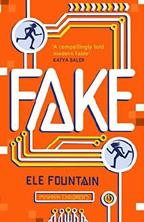
Fountain, Ele Pushkin Children’s Books (256 pp.)
$13.95 paper | June 6, 2023
9781782692904
Disaster looms following an amateur hacker’s moment of carelessness.
Addressing several real, ominous trends, Fountain posits a dismal near future a few decades after an antibiotic-resistant version of scarlet fever has driven society into isolated family groups and allowed cybergatekeeper Global Connections to gain control of the world’s economy. Old enough at last to leave virtual learning behind, 14-year-old Jessica joins an incoming class of girls, some of whom had never met another child except online, at a physical boarding school. As if a heavy course load and challenges like learning to play team sports on real rather than virtual fields aren’t stressful enough, Jess is concerned for how her already strapped family is going to pay for the increasingly expensive medication needed to keep her little sister alive. This leads her to furtive experiments with illegal hacking techniques learned from an old book to explore Global Connections’ company files. Suddenly unable to get in touch with her family, she learns to her horror not only that the medication’s escalating cost had been directly linked to a decline in her family’s online purchases, but that thanks to her lack of expertise, now they’ve all been ruthlessly “deleted” by the corporation as security risks. Though the author engineers a resolution that will strike even uncritical readers as contrived and overly tidy, her premise and picture of cyberdependent daily life cut close enough to the bone to spur reflection and discussion. The cast reads White.
Chillingly plausible. (Dystopian science fiction. 912)
Franklin, Ashley
Illus. by Aaliya Jaleel
Salaam Reads/Simon & Schuster (32 pp.)
$18.99 | June 20, 2023
9781534499836
A young Black Muslim boy has fun attending prayer services each Friday.
Kamal, a boy with dark brown skin and curly hair, is all smiles as he approaches the masjid: “His smile is so wide, it

cool off and ride!
hides his eyes, / A bubble-up joy causing wiggles and giggles, / A percolating pride from sole to soul.” A diverse group of friends greets Kamal from the step—one wears jeans, another sports a kurta, and another wears khakis. Together, they perform common masjid activities: removing their shoes before entering the prayer area, washing their feet as part of ritual ablution, rolling out rugs, listening to the imam, and making Jumu’ah prayer, all while creating mischievous, contagious fun. Building on the text that came before, each page of this “The House That Jack Built”–style tale is a lyrical, rhythmic celebration of those “who come to the masjid Kamal loves,” making it a stellar choice to read aloud. Bold illustrations demonstrate the ways that children participate in the community in the open spaces of the masjid. Except for one child, all community members depicted within the spaces Kamal occupies in the masjid present as male, which is typical of the single-gendered nature of Islamic congregational worship. Many congregants, including the imam, have dark brown skin, making this story a welcome and muchneeded tale that highlights the true diversity of the Muslim community. (This book was reviewed digitally.)
Friendship, community, worship, and fun—what a desirable combination! (Picture book. 58)
(32 pp.)
$18.99 | July 11, 2023
9781635926842
A solution to a hot summer in the city. What did people do before air conditioning was readily available? One option was Baltimore’s Cool Off and Ride Program, which, starting in 1937, encouraged people to climb aboard the streetcar at a discount, relax, and catch a breeze. Friddell’s songlike text captures the city’s various characters on this summer day: kids on the playground, the dog in the backyard, Granny and Gramps on the porch, friends in the river, Mama in the kitchen, a boy who is “a-courtin’,” and a cranky baby. All are invited to “cool off and ride” in a repeated refrain. Retro illustrations capture an atmosphere of hot weather in an old-school neighborhood and show a multiracial cast of characters finding a variety of ways to cope with the weather. While the premise here will undoubtedly have local appeal, any child who has experienced summer heat will understand the need to escape it and enjoy this rhythmic, lyrical tale. Notes explain how the author discovered the program, give some facts about it, and provide a brief history of streetcars, their racial integration, and their surprising relationship to roller coasters. (This book was reviewed digitally.)

A gently humorous depiction of a city’s effort to beat the heat. (bibliography) (Picture book. 36)
Galbraith, Bree
Illus. by Morgan Goble
Kids Can (144 pp.)
$15.99 | June 6, 2023
9781525303296
Series: Wednesday Wilson
An 8-year-old is eager for a new business venture.
Wednesday Wilson, a biracial girl with brown skin and wavy dark brown hair, wants to become an entrepreneur so that her two mothers will never have to worry again about paying the bills. Mum, who presents as White, with short, straight hair, owns a pizza truck, while Mom, who presents Black, with short Afro-textured hair, is an artist. While Wednesday and her friend Charlie have yet to find success in business, they refuse to give up. They have the day off from school, so they decide to go over business ideas. But then Mom invites over Wednesday and Charlie’s former friend Ruby. Ruby’s new friendship with mean girls known as the Emmas troubles both Wednesday and Charlie. During breakfast with Wednesday’s younger brother, Mister, Ruby provides helpful input—can Wednesday, Charlie, and Ruby rekindle their friendship? The three of them, along with Mister, plan a dog-walking business, pivot to a makeup service that paints freckles on clients, execute their new plan, and call in help when needed. This upbeat story provides readers with information and vocabulary for building a business but even greater lessons about friendship, communication, and self-worth. In the cartoonlike illustrations, Ruby is brown-skinned, while Charlie is light-skinned.

A fun story with high appeal for budding entrepreneurs. (Chapter book. 68)
Gapstur, Eric
Colors by Dearbhla Kelly
Aladdin (288 pp.)
$22.99 | July 18, 2023
9781534480322
Series: Sort of Super, 2

Two young superheroes start a search for their missing mom at a summer camp built next to a volcano. What could go wrong?
Enlisting their friends Beto Moreno and Nara Jenkins— respectively, an aspiring magician and a medal-winning wrestler—to help, fledgling secret super sibs Adeline and Wyatt Flynn enroll at Camp Igneous, conveniently situated at the base of the volcano where their mom might have disappeared four years before. Along with pursuing an investigation, though, the team faces serious competition vying for the titular cup in a series of mentally and physically demanding obstacle courses and other challenges, all while keeping their special powers
“A gently humorous depiction of a city’s effort to beat the heat.”
hidden. The art’s bright colors, overlapping panels, and expressively posed cartoon figures ramp up the pacing and visual energy for a plot that features a series of suspenseful contests capped by encounters with “radioactive goop” and other surprises in the volcano’s crater and hints of a connection between the missing parent and a clandestine group of bad actors called the Quadrant. Stay tuned. Gapstur builds preteen banter, team building, frustrated romance, and even a nearly catastrophic eruption that tests the superkids’ abilities to the utmost into this lively sequel. Wyatt and Adeline are White; the supporting cast includes racial diversity.
Triumphs, mishaps, and revelations kick this adventure into high gear. (Graphic adventure. 812)
Gardner, Jim & Rob Gardner
Running Press Kids (96 pp.)
$19.99 | April 4, 2023
9780762482139
The Gardners, creators of the popular YouTube channel Twenty Trucks, which features ditties on everything from dump trucks to street sweepers, compile their favorite lyrics.
In this substantial collection, readers will find songs about both familiar vehicles, like garbage trucks and cement mixers, and lesser-known, high-appeal wheeled machines such as the impressive rock crawler and road zipper, which moves concrete lane dividers. Apart from an introduction and a glossary, the text is composed primarily of lyrics, which do by and large explain what each truck does so that even those unfamiliar with the tunes or the vehicles will understand their purpose. There is no QR code that directs readers to the songs, which would have been helpful for those not already fans of the YouTube channel. Without the music, some of the text feels repetitive (like “Off-Road Racing Truck”), and for the purposes of the book, an edited version of the original lyrics with more photographs than just one per layout would have made it more appealing to younger readers. The glossary does help deepen reader comprehension and is a thoughtful inclusion. (This book was reviewed digitally.)

A clunky, bare-bones format that will nevertheless appeal to fans of all things truck. (Picture book. 46)
Goetter, Sara & Natalie Riess
First Second (224 pp.)
$14.99 paper | June 27, 2023
9781250834669
Series: Cryptid Kids, 1
Penny plans to thank Bessie for rescuing her from a scary plunge in the lake three years ago.
Bessie, known as the Bawk-ness Monster, is a part-chicken, part–sea serpent legend residing in Lake Bockamixon. Penny enlists her friends— skeptical Luc and eager Kaylee, a budding cryptozoologist—to help her reconnect with the large, feathered creature. Penny’s mom, unaware of the plan to find Bessie, reluctantly agrees to take the trio camping at the lake, where Penny and her friends don a fake Bessie costume and are soon captured by a group of cryptid poachers. The poacher’s boss, Alvida Scales, a Cruella de Vil type, is a single-minded, child-loathing villain who has built a lair under the lake to cage the various cryptids she’s collected and plans to sell. The trio of friends—and Penny’s mom— heroically rise to the occasion in order to rescue themselves and the cryptids. The human characters possess a lively, sometimes frenzied energy, with swooping gestures, huge eyes, and enormous mouths conveying emotion. The bright backgrounds, dynamic speech balloons, and many open frames are equally energetic. Kaylee is Black; other major characters read White. A flashback shows Luc’s evolving gender identity. Goetter and Riess provide an illustrated inside look at their process of creating the graphic novel, from concepts to thumbnails to inking. A spirited mix of excitement and broad humor. (Graphic fantasy. 710)

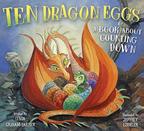
GrahamBarber, Lynda
Illus. by Jeffrey Ebbeler
Peachtree (40 pp.)
$18.99 | July 18, 2023
9781682635261
Mama Dragon needs your help hatching her 10 eggs. Readers are invited to count down from 10 to one and to repeat “Shimshimshimmyshout! Baby dragling, please come out!” as one by one the eggs crack open. There’s a dragling whose two intertwining horns resemble a beehive, one who has a crystal ring around its toe, and one with heart-shaped wings. The partially rhyming text will help readers count down and also strengthens the echo of the refrain, though the inconsistency interrupts the cadence and may make for a slightly bumpy readaloud. Mama Dragon, using her fiery breath to help the eggs hatch, appears appropriately exhausted by draglings six and seven. The final egg holds a surprise sure to have little ones squealing with joy. The closing image shows mother and babies curled up in a sleeping heap, the sun behind them setting over
“A spirited mix of excitement and broad humor.”
the bawk-ness monster
the water. Children will want to revisit this one for the visuals alone. Large and striking images fill the pages. Ebbeler’s appealing illustrations depict dragons who are monstrous and majestic though never scary (and quite endearing, too)—just the right balance for little ones. As a counting down title, this one is a success, describing—and visually showing—how many eggs remain unhatched on each page. (This book was reviewed digitally.)
Delightful and imaginative. (Picture book. 35)
Gratton, Tessa
Disney Lucasfilm (288 pp.)
$14.99 | April 4, 2023
9781368082877
Series: Star Wars: The High Republic
A Jedi Padawan and two young prospectors embark on a stolen vessel in search of a mysterious planet and guidance from the Force.

Twelve-year-old White boy Dass Leffbruk jumps at the chance to join the Hyperspace Chase, a high-stakes prospecting race into the frontier. More than anything, he needs to return to Planet X and his friend Sky Graf, a White pilot who uses they/them pronouns, who has not only a state-of-the-art ship, but a plan for how to find the uncharted planet. Like Dass, Sky intends to prove themself, no matter the cost—even if it means stealing their brother’s ship. When Rooper Nitani, a Jedi Padawan with brown skin and black hair, hears the rumors about conflict on Jedha, she wrestles with her impatience for news from her master. Despite her dislike of privatized space travel, she feels the Force guiding her when Dass begs her to join his prospecting mission for Planet X. As the race begins, their path intertwines with that of Fel Ix, a Kessarine on a mission for the Path of the Open Hand. This High Republic–era adventure follows the perspectives of four characters who are grappling with responsibility, independence, and their sense of purpose in the world. Full of suspenseful action, the story picks up momentum quickly and the pace never lags. Previous High Republic books provide helpful context for understanding significant characters and events.
An exciting chase that will satisfy fans. (Science fiction. 913)
Hahn, Sabina
Harper/HarperCollins (32 pp.)
$18.99 | July 18, 2023
9780063253995
In a frustrating case of mistaken identity, a group of frogs believe a dragon to be one of them.
A dragon happens to be soaking in the water next to very chatty frogs. Seeing the creature’s head poking out of the water,
they immediately decide it has to be a very big frog. Despite repeated protestations (“I am a dragon!”), the frogs insist that dragons are imaginary. It takes a roaring mouthful of flames aimed at the little hoppers to finally convince them that this is, in fact, “a very mad dragon.” At its core, the story is about not being believed when you know who you are and finding a fiery passion to stand up and say it—a powerful message executed deftly. The adorable dragonfly that buzzes around the dragon serves as a helpful cheerleader, almost the story’s moral compass, reminding the dragon that it is real and pointing out that it’s important to “question everything!” The illustrations are simple in the best way, matching the text. A limited palette of pale blues and shades of green help focus the setting and highlight the characters. The book definitely hits its target audience with the right amount of humor and appropriate pacing. (This book was reviewed digitally.)
A funny tale with a much-needed lesson. (Picture book. 36)

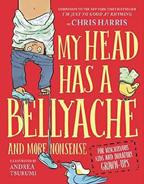
Harris, Chris
Illus. by Andrea Tsurumi
Little, Brown (192 pp.)
$19.99 | July 18, 2023
9780316592598
Series: Mischievous Nonsense, 2
A hefty gathering of versified reflections on topics from “dadding” to what the Nail-Clipping Fairy brings at night. Pitched as the companion to I’m Just No Good at Rhyming (2017) but with artwork from Tsurumi rather than Lane Smith, Harris’ latest collection focuses on parenting, growing up, and like domestic themes. Along with parental revelations (“Secretly, we do the things we tell you not to do! / We leave our dirty clothes out, and we pick our noses, too”) and efforts to recall “My Very First Memory,” he explains that “The Place Where the Lost Things Go” is right here, extolls the virtues of “A Big, Comfy Chair and a Brand-New Book,” and gleefully reassures children that even in the dark they’re never all alone, because…“there are monsters!” Like Smith in the previous volume, Tsurumi plays a maverick role. In addition to a racially diverse cast of wide-eyed youngsters and grown-ups, they depict a set of animal critics regarding a villanelle with disgust and, in the wake of a warning on an early page, a meteor that plunges down later to annihilate an unfortunate poem. Though the adult perspectives and high page count make this a marathon run, protestations notwithstanding, the author is still just fine at rhyming, and that, not to mention his free-wheeling sense of humor, will keep young audiences reading all the way to the (rhymed!) glossary and into the goofy title and subject indexes.
Sidesplitting fun throughout for one or a crowd. (Poetry. 610)
Hernández Bergstrom, Adriana
Orchard/Scholastic (32 pp.)
$18.99 | June 6, 2023
9781338828665
Follow the journey of a tumbling tumbleweed.
In this picture book, lilting—or, more accurately, tumbling—rhyming couplets help readers bounce along with a tumbleweed as, over a period of unspecified time, winds roll it across the shifting terrains of dusty desert sands. What a journey this is. While the text is simple, with usually one couplet or simple phrase appearing on a page, the life forms that the plant encounters are complex. The tumbleweed and readers meet with a marvelous display of biodiversity—other plants and animals, including mammals, birds, reptiles, amphibians, and insects—that proves that a desert bursts with life and myriad wonders. In the course of its travels over day into night and from sunshine into a thunderstorm, the tumbleweed comes into bloom, then travels onward: “Wind blows…Tumble goes and goes and goes.” Who knows where? Readers will have already learned from the gentle text that the possibilities are probably endless. Adults sharing this charming book about a little-known plant and its environs should encourage children to suggest—perhaps with simple rhymes—or illustrate what else the tumbleweed might meet as the wind rolls it across a desert. The many changes in colors in the illustrations suggest the desert’s vitality; dotted lines track the tumbleweed’s path and rotating movements. Some pages are wordless, allowing readers to focus on the evocative natural scenes and up-close views of wildlife. (This book was reviewed digitally.)
Deceptively simple yet wondrous. (can you spot the plants and animals? fun facts about tumbleweeds) (Informational picture book. 36)

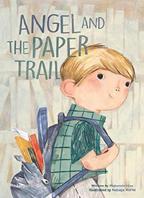
Hice, Makenzie
Illus. by Natasja Horne
Clavis (32 pp.)
$18.95 | July 11, 2023
9781605377322
A shy new student looking for a book finds some new friends instead.
Angel wants the bright orange book lying on top of the library shelves, but he’s too short to reach it. Summoning his courage, he asks taller classmate Oliver for help, and a note falls out of the book: “I hope your day is as bright and sweet as this shining sun.” Oliver immediately sees this as a mystery to solve and takes Angel around to his various friends at recess in an attempt to find the note’s author…and along the way introducing Angel. The handwriting looks like Rose’s, the picture of the sun like something Bea would draw, and the hearts over the I’s are Miles’ specialty. But none are the author. And then the wind steals the note away.
Saddened by the end of the investigation, Angel thinks of something to do with his new friends that will also benefit other new kids like him: They craft a note of their own to place in a library book. Horne’s illustrations are charming, the children’s body language and facial expressions saying everything as new friendships form. Angel is light-skinned, Oliver is tan-skinned, and Bea and Miles are brown-skinned. While this method of welcoming children is slower to work than a buddy bench, it’s still a unique and doable idea. (This book was reviewed digitally.)
A love note to shy new kids. (Picture book. 48)
Hill, Susanna Leonard
Illus. by Natalie Vasilica
Sourcebooks Wonderland (40 pp.)
$10.99 | Aug. 1, 2023
9781728251486
A riff on the familiar nursery rhyme celebrates love and aspirations for a cherished child.
“Star light, star bright / star that lights my sky each night, / I wish you may, I wish you might/ Know wonder, magic, and delight.” Further verses celebrate the lure of adventure and the narrator’s pride and confidence in a child who is “strong and true,” “fun and helpful.” The speaker encourages the little one to “dazzle, sparkle, dance,” and “be brave enough to take a chance,” alternating praise with encouragement (“take the time to show you care,” “stand up strong for what is right”). The last wish is that the star “always shine with love and light.” The illustrations, in lushly romantic style and color unsubdued by the night setting, pair an adult animal with its young, first a pair of giraffes in a savanna as the sun sets, a fox and kit in an evening woodland, zebras in the evening savanna, beavers by a stream, penguins in a rocky Antarctic beneath the southern aurora, chipmunks in a tree bole, belugas in the sea, a male lion with cub riding on his back, two bats against a full moon, and more. On each page, the indigo skies feature a bright large-and-small star pair. (This book was reviewed digitally.)
Little ones and their adults will be drawn to this warm book. (Picture book. 26)

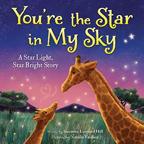
Hoffman, Jilanne
Illus. by Eugenia Mello
Chronicle Books (48 pp.)
$18.99 | July 18, 2023
978-1-79721-175-6
Soil travels from the Sahara to the Amazon.
The narrator is the personification of dust in Africa addressing the Amazon. It reminisces that “Millions of years ago, / no
same love, different hug
ocean lay between us” but that “slowly, great forces tore us apart,” referring to the continental drift. The voice reassures that “I’ve found a way to reach you, / to sustain you, / to help you flourish.” The focus is on a collection of soil that originates in the Sahel in Africa. This section of land stretches across several countries “between / the Sahara Desert, to the north, / and the tropical savanna, / to the south.” As the wind blows, this collection of phosphorus-rich dust crosses the Atlantic to eventually settle and enrich the soil of the Amazon rainforest. The lyrical narrative focuses on the whimsical aspects of the journey. The spare text (“the smudge on a finger, / the grime that swirls down a drain”) is woven into Mello’s bright and speckled textured illustrations. Dust is found trailing a charging group of gazelles in the savanna or swirled in the wing of a pelican over a colorful village on the riverside. Particles of dust are even lost “falling into a dolphin’s eye,” “perhaps floating forever” in a bustling ocean scene. The soil reaches its final destination, renewing the connection between biomes and highlighting the interconnections in the natural world. (This book was reviewed digitally.)
An artistic introduction to a compelling sedimentary journey. (questions for curious minds, author’s note) (Informational picture book. 58)
Holt, Bob
Harper/HarperCollins (40 pp.)
$17.99 | July 4, 2023
9780063237605
A red jacket leads to big changes. A small gray bird gives Bob, a sorrowful sea gull, a red jacket with fries in its pockets because it’s no longer needed. Bob is increasingly thrilled by the “swanky stylish” coat, which feels like “wearing a big hug,” and the jacket also inspires him to be outgoing and helpful. Crabs and flounders are astounded to see this side of Bob, and when he returns to the undifferentiated flock, they greet him enthusiastically. Oblivious to a wave about to descend, Bob is spun in the undertow. When he washes up on the beach with the other detritus, the jacket is gone. Bob is on the brink of returning to his depressed state. Then his many pals find and return the jacket. Bob realizes that he has “so many friends, even without my swanky red jacket.” He happily puts it back on, but then, as a mournful turtle trudges by, he offers the jacket, because “I no longer need it,” and the turtle visibly perks up. The speech bubbles are in clear, large letters, the jacket’s red pop brightens the pages along with red and blue crabs and the blue sea, and the animals, drawn in cartoon style, are entirely personable. (This book was reviewed digitally.)

A delightful story of finding self-confidence and friends— and then paying it forward. (Picture book. 48)
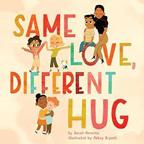
Hovorka, Sarah
Illus. by Abbey Bryant
Clarion/HarperCollins (40 pp.)
$19.99 | June 13, 2023
9780358712817
What kind of a hugger are you— “rough, tough never enough” or “gentle, slow don’t-let-go”?
Although Hovorka’s children found it hard to give her hugs for fear of hurting her due to her disability, they soon discovered that there were many different ways to hug—a realization that led to this book. Readers may already be familiar with bear hugs, but what about “don’t-look-back sneak-attack” hugs or a “big-grin around-we-spin” hug, shared in an accompanying illustration by a child and an adult wheelchair user twirling around together? Sometimes it’s best to save a hug for later, send a “stay-in-place need-my-space wave,” or create a secret handshake instead. Group hugs can be the cure for a day when “sadness swells to the brim,” and celebration days usually require a “skip, prance happy-dance HUG!” The brief, fun rhymes and creative names for the hug variations make reading aloud fun for storytellers and listeners alike. By turns soothing and actionpacked, earth-toned cartoon illustrations capture a wide range of situations, from quiet, loving support when someone is sick or in need of alone time to the playful exuberance of big celebrations. Depicting a diverse group of people modeling many versions of loving behavior, these images are ideal for young readers exploring social-emotional skills and learning to respect others’ personal boundaries and preferences. (This book was reviewed digitally.)
Will show readers that their options for expressing affection are many. (Picture book. 37)
& Dan Jolley
James L. Barry HarperAlley (208 pp.)Illus. by
$24.99 | June 6, 2023
9780063240223
Series: Warriors Graphic Novel, 4
A cat suspects her clanmates when food goes missing.
This spinoff graphic novel installment focuses on orange and white–furred Brightheart, who lost an eye after a savage dog attack that not only compromised her sight, but also shattered her trust in her Thunderclan clanmates. When her romantic partner, Cloudtail, is assigned an apprentice kit and she is not, Brightheart is disappointed. However, this wears off quickly when she learns she is pregnant with Cloudtail’s kits. Soon, the clan finds their food stores are vanishing each night; Brightheart is suspicious that some of the other cats may not be loyal to Thunderclan, and her reservations deepen as Thunderclan’s leader, Firestar, grows
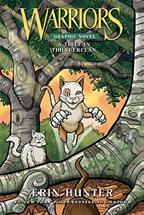
“Will show readers that their options for expressing affection are many.”
more and more distant. This latest about Hunter and Jolley’s feline empire fails to land on all four paws. The central mystery is resolved hastily, and other plot threads feel as quickly disregarded. Barry’s brightly hued art brings a cinematic feel to the orderly panels, depicting the cats’ world as a harsh juxtaposition of violence and beauty. Long-standing fans of the series may be pleased to revisit this world, but a sagging resolution and the sheer volume of name-dropping may prove too much for a newcomer cat fancier.
Lackluster. (Graphic fantasy. 811)

Janicki, Peggy Illus. by Carrielynn Victor Orca (32 pp.)
$21.95 | April 11, 2023
9781459833722
Inspired by her mother’s experience as a child, Janicki (Nak’azdli Whut’en Nation) tells a story of Indigenous resilience and resourcefulness in the face of colonial violence.
Closely connected to her family, the 4-year-old protagonist spends time at the lakeside smokehouse of her ’Utsoo (Dakelh for grandmother) and ’Utsiyan (grandfather). That summer, a priest and a nun encroach upon their family gathering to pressure the narrator and her siblings into attending the Lejac residential school. Conditions at the school are abject, and the children resort to eating toothpaste. The only respites for the protagonist and her siblings are the summer breaks and winter holidays spent at home—requiring her ’Uba (father) to make a 12-hour journey to pick them up. To make it through arduous days of abuse and neglect, the clever child and her friends sew pockets into their petticoats, incorporating what they learned from their families’ beading practices and allowing them to smuggle food out of the kitchen to share with others and keep hope alive—“We sewed our survival into every stitch.” Victor’s (Coast Salish) soft, often understated images depict a heartrending experience. Though the tale is emotionally fraught, young readers are left with an uplifting reminder about the power and resolve of Indigenous people: “We were geniuses. We are geniuses. We will always be geniuses.” (This book was reviewed digitally.)
A moving tribute to Native children’s survival in the residential school system. (glossary of Dakelh terms, author’s note) (Picture book. 611)
Jerome, Kate Weldon Owen (112 pp.)
$7.99 paper | May 2, 2023
9781681889245
Series: OceanX Adventures, 1
A budding journalist takes a dip into marine science while investigating a series of mysterious power failures at a local aquarium.

Tied in with long-distance video interviews, infodumps, and an appended multipage color photo spread to the real OceanXplorer research vessel, this series kickoff finds easily distracted fifth grader Marena Montoya volunteering as a junior science reporter for the aquarium’s newsletter—providing a tailor-made opportunity for readers to learn more about coral reefs and recent discoveries in marine biology as she researches topics for articles or makes presentations. Meanwhile, looking into a strange series of nighttime power failures leads her from romanticized notions of a ghost in the building to exposing the solidly scientific real cause (which involves a precocious octopus and is based on a true incident). Monochrome images of Marena and her best friend, Aisha, depicting both with dark skin, add stylish notes; the episode’s STEM-centric slant is underscored by a substantial number of full-page and spot views of maps, documents, the featured ship, and marine life.
An uncomplicated caper with a large but not unwieldy informational load. (Fiction. 911)

Kasha, Manka
Feiwel & Friends (40 pp.)
$18.99 | June 6, 2023
9781250856982
A royal visit goes awry.
Small Knight is a petite child with peach skin and curly brown hair who uses they/them pronouns. They live with their parents, the king and queen, in a vaguely rendered castle. When Small Knight’s aunt—a famous warrior— and her son come to visit, Small Knight is too starstruck by the Warrior Queen to notice their cousin’s moodiness. The prince is about Small Knight’s size, with the same light skin as the rest of the characters but with vibrant crimson hair that accentuates the angry red vibrations he gives off. The prince’s foul mood is highly contagious, but after some cathartic sword practice and thoughtful discussion with Tiny Bear (Small Knight’s plush but sentient ursine pal), Small Knight nobly decides to help. The prince confides that living up to his mother’s example is overwhelming and that he feels jealous of Small Knight, and eventually the two bond over some butterfly watching and sword practice. An author’s note reassures readers that “if the air was
“A moving tribute to Native children’s survival in the residential school system.”
the secret pocket
to go red with anger again, Small Knight and their cousin know exactly what to do”—though no real resolutions to the prince’s jealousy or the complicated relationships with any of the parents are presented in the shallow plot. Unsophisticated ink and watercolor illustrations on stark white backgrounds pace out the story in a mix of spots and spreads. (This book was reviewed digitally.)
A short-term solution from a very short knight. (Picture book. 37)

Kelly, David A.
Illus. by Edwin Fotheringham
Calkins Creek/Astra Books for Young Readers (40 pp.)

$18.99 | July 25, 2023
9781662680175
A historical anecdote that tees off on readers who think that scientists are invariably serious people.
The 1971 Apollo 14 mission, the third to land on the moon, had tasks and experiments aplenty lined up, but, as they say, all work and no play…. So along the way, Alan Shepard Jr. pulled two golf balls out of one of his spacesuit pockets, attached a golf club head (a 6-iron, for the curious) to the rock scoop used to collect samples, and let fly. As moon suits of the day didn’t allow him to look down at his feet, it didn’t go well, but he did get one solid whack…which, according to a measurement made 50 years later by Andy Saunders, a photographer on Earth, went all of 120 feet. As Kelly drolly notes, “Saunders calculated that a good golfer could hit a ball over three miles” on a lunar course. Sure, but (as he doesn’t mention) all these years later, it’s still a record distance. The author adds plenty of carefully researched detail to a story that is usually barely mentioned in histories, if at all, and, at the end, a very helpful overview of every Apollo mission and what it accomplished. Being as the balls were hit in a vacuum, the sound effects (“POW!”) that Fotheringham adds to his painted scenes of figures in heavy suits lumbering over rocky moonscapes are a misleading but minor shank. Everyone in view is White until a final glimpse of a dark-skinned earthly golfer. (This book was reviewed digitally.)
More stunt than highlight, but this “eagle” does land. (photos, bibliography, picture credits) (Informational picture book. 79)
Kimura, Yukie, Kōdo Kimura & Steve Sheinkin
Illus. by Kōdo Kimura
Roaring Brook Press (48 pp.)
$19.99 | July 18, 2023
9781250206503
A picture book based on Yukie Kimura’s experiences growing up in World War II–era Japan.
Yukie lives with her family on an island where her father is the lighthouse keeper. She and her brother have adventures around the island as they look for sea gull eggs; her sister prefers to read. One day, Yukie sees a giant ship with military personnel onboard. Up to that point, the war had felt far away. Suddenly, her world shifts as the military takes over the town, planes fly overhead, and bombs drop. Yukie notices that some children do not return to school after the war, but as the book closes, her adventures with her brother resume as they jump across ice floes that have floated south from Russia. References to her father’s flute playing and the hidden meanings behind his intonation imply there is much that Yukie doesn’t understand, though she perceives the underlying threats and tension. Disappointingly sparse text is paired with equally oblique illustrations. Kōdo Kimura’s stiff and impersonal style portrays flat landscapes and children with adult, even elderly faces. Repetitive, unoriginal perspectives lack dramatic emotion, creating distance between readers and the story. Older children can read the in-depth backmatter for historical context; younger readers will need guidance from well-informed grown-ups. (This book was reviewed digitally.)
A thin tale with far richer backmatter. (notes from Sheinkin and Kōdo Kimura) (Picturebook memoir. 48)
Klassen, Jon
Candlewick (112 pp.)
$25.99 | July 11, 2023
9781536223378
Caldecott medalist Klassen’s signature style is brought to bear on a Tyrolean tale imbued with equal parts comfort and creepiness.
As the story begins, we meet Otilla, a young tan-skinned girl on the run from her old life, who stumbles upon a large house with a single occupant: a talking skull. The two strike up an immediate friendship, and when the skull confesses that a headless skeleton chases him every night, Otilla is determined to come to his aid. Keen ingenuity on her part protects her new friend, and a happy ending sees the two of them together always. Klassen balances the spooky elements of the story brilliantly alongside cozy teas and the occasional waltz. This is aided in
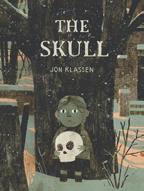
no small part by a limited palette that depicts the slanted burnt umber rays of the rising and setting sun as well as the gentle gleam of candlelight. In a marvelous author’s note, Klassen recounts how he encountered this folktale in a school library and misremembered it in the best way. As he says, “Folktales… are supposed to be changed by who is telling them, and you never find them the same way twice.” One can only hope that children will tell and retell this reinterpretation many times to themselves throughout the years.
Employing his customary pitch-perfect tonal gymnastics, only Klassen could inspire readers to want craniums as pals. (Fiction. 69)
Knapman, Timothy Illus. by Joe Berger Penguin Workshop (32 pp.)
$18.99 | June 6, 2023
9780593521052
A child explores feelings of rage.
“Sometimes I’m a princess who is thoughtful, brave, and sweet,” says the narrator, an orange-haired, tan-skinned moppet. “Sometimes I’m the kindest fairy you could hope to meet,” the protagonist continues, helping their parents wash dishes. “And sometimes I am furious.” As the book progresses, readers witness the things that provoke the child’s ire—when someone accidentally ruins their sand castle, when other kids get more ice cream, when the bakery runs out of chocolate cake. After a double-page spread depicting a tantrum that leads to tears, the child’s kindly grandmother gives them a hug and some whispered advice. Children will enjoy the repetition of furious and will hopefully learn something from the narrator, whose coping methods now include breathing deeply, counting, and singing a “happy song.” Humorous art supports the rhyming verse with bold, eye-catching, thick-lined graphics. Kudos to Knapman and Berger for making it clear that feeling anger—especially at perceived unfairness— is fine; what’s important is finding ways to calm down before a meltdown. One of the child’s parents is brown-skinned while the other is tan-skinned; Grandma is brown-skinned; the supporting cast is diverse. (This book was reviewed digitally.)
A simple and entertaining introduction to anger management. (Picture book. 35)
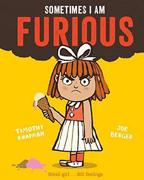
Kousky, Vern
Roaring Brook Press (40 pp.)
$18.99 | July 25, 2023
9781250842022
A kind friend helps by recognizing a friend’s sadness.
Bear is a solitary, unhappy, small figure against a backdrop of lively
playgrounds, streets, and skylines that suggest a New York setting. An antlered friend notices and asks gently, “Sad Bear, why are you so sad?” Maybe it’s because of a dropped ice cream cone, a lost balloon, cold, wet weather, or a forgotten birthday. Maybe something was broken accidentally or a special tree was chopped down. Or “maybe it’s because the world is such a big place, and you are only a little bear. Or maybe there is no reason at all. You are just simply sad.” There might be solutions; in several sunny pages the deer shares some ice cream, helps track down the lost balloon, and gathers friends for a party. The pair plant some seeds and find indoor adventure on a rainy day. “But, Sad Bear, if after all, you still feel a little blue,” says the deer reassuringly, “it’s okay. I understand. Sometimes I get sad too.” The message that it’s OK to grapple with difficult feelings—and that they’re something we all deal with sometimes—is conveyed with admirable simplicity. The details of the city with animal denizens and amusing alternate versions of Times Square and the Statue of Liberty are funny and sweet. (This book was reviewed digitally.)
Gracefully understated and understanding, for Sad Bears and their friends, too. (Picture book. 37)
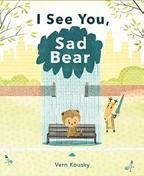
Krensky, Stephen
Illus. by Alette Straathof Apples & Honey Press (32 pp.)
$17.95 | March 21, 2023
9781681155999
An informative look at a Jewish sports legend.
Krensky follows Hank Greenberg’s baseball career from his early days to his stardom with the Detroit Tigers during the 1930s and 1940s. The author focuses particularly on Greenberg’s Jewish heritage and the antisemitism he confronted from both fans and fellow players. This story hinges on a famous episode in Greenberg’s career, when the American League pennant race coincided with the Jewish High Holy Days. After consulting a rabbi, Greenberg decided to play baseball on Rosh Hashanah, the Jewish new year, but to sit out Yom Kippur, the holiest day of the Jewish year, and attend services at his synagogue instead. The Tigers lost the game that day, but Greenberg’s legacy lives on. Bold, stylized illustrations will grab readers’ attention. Swirls of color convey movement as Greenberg slides through the dirt and hits home runs; white zigzags punctuate the “boos” he endures from bigoted audiences as he steps onto the field. Though the book doesn’t delve too deeply into Greenberg’s story, it gives just enough details to whet the appetite for more; both his commitment to his faith and his passion for the game come through clearly. (This book was reviewed digitally.)
A compelling introduction to Hank Greenberg for a new generation of baseball fans. (biographical note) (Picturebook biography. 58)
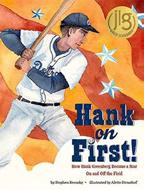
Krossing, Karen Charlesbridge (240 pp.)
$17.99 | July 11, 2023
9781623543563
A boy wrestles with seeing a monster who shouldn’t be real and with finding a sense of belonging.

Morsh’s reputation for once having been home to monsters forms the heart of the town’s booming tourism market. For 11-year-old Dawz, these supposedly mythical creatures are a painful reminder of the monster-obsessed mom who left him and younger sister Jayla to be adopted by their maternal uncle, Pop. (The children have different fathers, but their mother refused to disclose their identities.) Dawz dreams of winning a local baking competition, like Pop before him; baking is a special passion they share. But when he discovers Mim, a small monster with gray fur and purple scales living in his bedroom closet, he worries that makes him weird—like his mom. Mim is struggling with changes, too. She doesn’t remember a time before the closet, but she’s growing larger—and despite her trepidation, she is pulled to explore the world outside this dark, dusty haven. Dawz and Mim discover they have a bond, and they both struggle with learning to accept themselves. In this thoughtful story that deals with serious topics but is lightened by humor, Krossing expertly navigates what it’s like to be young and unsure of yourself through the protagonists’ character arcs. Jayla and Dawz have different skin tones from one another and Pop, who is cued White; their multiracial family is described as “a mismatched crew.”
A moving tale of learning to accept yourself, flaws and all. (Fiction. 912)

Kutner, Rob
Illus.by
David DeGrandFirst Second (224 pp.)
$14.99 paper | July 25, 2023
9781250780805
Five muco-centric graphic tales in the classic tradition of the Slimeballs and Barf-O-Rama series.
Periodically pausing to reset the mood by chewing up classic books and covering a staring storytime audience with projectile vomit, an outsized rubbery mouth spews out a set of original tales—beginning with one about a child who saves the world from being covered in green slime by loogie monsters in exchange for being appointed school principal. Later entries follow a weak-stomached Romanian vampire who immigrates to America (“Where all are created equal, and some are treated that way!”), lay out a steep cultural learning curve when young Stella’s “bio mom” is replaced by a wrapped
stepmummy, show what happens when internet trolls meet real ones, and pit a pair of frustrated ghost hunters against a mob of spectral pranksters. In all of these, DeGrand shows a real talent for lavishing copious quantities of puke, snot, blood, slobber, slime, and goo into his garishly hued cartoon scenes along with endowing the popeyed nonhuman and undead cast members with warty or glutinous skin in a range of noxious shades. Humans present a diverse (and healthier looking) mix of skin colors.
Funny, gross, and clever but definitely not recommended for mealtime reading. (Graphic short stories. 710)
LaRochelle, David
Illus. by Mike Wohnoutka
Candlewick (64 pp.)
$9.99 | July 25, 2023
9781536219821
Series: See the Cat
Big laughs from this early reader. Broken into three stories, LaRochelle’s accessible text will inspire confidence and giggles in new readers. Wohnoutka’s gouache, comics-inspired illustrations use speech balloons to ratchet up the humor while providing context cues to support emerging decoding skills and ample white space for resting the eyes. Ironic counterpoint between art and text is an immediate source of comedy as readers are told to “See the ghost” on Page 1 of the first story, while speech-balloon text on the facing page reads, “Boo!” and points to an invisible speaker. Sight unseen, the ghost scares a yellow dog (“Yikes!” it cries) and a blue cat (“It’s a ghost! Help! Help! Save me!”), whom readers may recognize from the creators’ See the Cat (202) and See the Dog (2021). The ghost is then confused when another “Boo!” fails to frighten some flowers. When another invisible character shows up in the second story, “See the Wind,” blustery gusts cause havoc in new humorous situations with the cat and dog. A fairy arrives in the third tale, exclaiming in her speech balloon, “Hi! My name is Trixie! I am so small that you cannot even see me. Hee-hee!” She’s mischievous, too, and her tricks prompt strong reactions from the dog, cat, and even the wind. Trixie makes amends by gifting the cat and dog new kites, which they fly in the wind as they “spend the afternoon together.”
See the star? Buy the book. (Early reader. 57)

“A moving tale of learning to accept yourself, flaws and all.”
monster vs. boy
Latimer, Alex Roaring
BrookPress (32 pp.)
$18.99 | July 11, 2023
9781250885999
Despite the best efforts of the narrator—and readers—the titular duck just won’t blink.
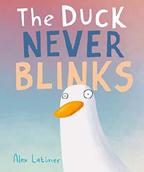
Like Mo Willems’ Pigeon books, this tale plays effectively with narrator-reader dynamics. Speaking directly to children, Latimer opens with, “You see that DUCK over there? I’ve been watching that duck all day and it hasn’t blinked.” The narrator proceeds to suggest ideas for getting the duck’s eyelids to move: shouting, telling a sad story, sharing a joke. Nothing works, of course, until the narrator heads home for a nap and the duck finally closes its eyes. The delighted squeals of children will ring out as this book is read aloud; little ones are sure to love being in on the fun of trying to make the duck blink—and catching it in the act. The duck is the only thing we see in the book, its eyes wide, almost googly circles with pinprick pupils. It sheds a tear and cracks a smile, and though there’s nothing else to look at, the duck is nevertheless captivating. A well-done tight grid across two pages shows the duck in each rectangle, unblinking, unmoving, even as night turns to day and a leaf fluttering past nods at seasons changing. This will undoubtedly be a fun read-aloud for a lap-sitting child or a room full of preschoolers. (This book was reviewed digitally.) Simple and effective, sure to elicit glee. (Picture book. 35)
Lawrence, David Illus. by Cherie Dignam
EK Books (272 pp.)
$12.99 paper | July 11, 2023
9781922539380
Series: The Pen Series, 1
In a wish-fulfillment tale with an allegorical drift from Australia, anything Ruby draws with a certain pen comes true.
The nose-picking headmaster, the sycophantic house mistress, the aptly named teacher Miss Vermin, and her sneering dorm-mate Sasha Sword are all vicious bullies who make life at her new boarding school a misery. So 12-year-old Ruby is thrilled to discover that her new fountain pen is magical. How satisfying it is to draw Sasha with a huge exploding zit and a massive splot of bird poop on her head…and then see both calamities come to pass. Better yet, when Sasha steals the pen, the bees she draws attacking Ruby instead descend on her! So thoroughly does Ruby’s newfound power go to her head, though, that her personality begins to change. Even best friend Faviola is turning away—not from jealousy, Ruby ultimately realizes, but because everything that she draws either hurts someone or makes things worse. But even as she’s making the creditable decision to put

the pen away, the discovery that the headmaster is secretly selling a patch of the school’s woodland to be leveled and made into a theme park sparks a desperate, climactically successful search for alternate ways to scupper the scheme. Afterward, though, she’s determined to be rid of the pen—but that’s another story. Dignam’s energetic ink-and-wash illustrations enhance the Roald Dahl–esque hijinks. Ruby reads White; names and illustrations signal diversity in the supporting cast.
An engaging study of power and moral choices. (Fantasy. 912)
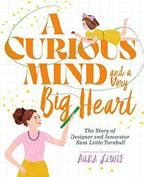
The Story of Designer and Innovator Sara Little Turnbull
Lewis, Aura
Beach Lane/Simon & Schuster (40 pp.)
$18.99 | July 18, 2023
9781665904452
A habit of careful observation led to the design of today’s N95 medical masks.
Born in 1917 in Brooklyn to Russian Jewish parents, Sara Little Turnbull (nee Finkelstein) paid close attention to small details, like the skin of an onion or the shape of an egg. Working as an editor for House Beautiful and a product designer, she traveled the world for inspiration. Noticing the unwieldy medical masks in the hospital where her sister was being treated for cancer in the 1940s, she designed an alternative that in 1995 was developed into the N95 mask. Lewis makes this fact the climax for an appealingly illustrated but cursory biography. Readers might be intrigued by examples of Turnbull’s creations, such as an upside-down watch pinned to her shirt, “light-as-air space suits,” “good-for-kids sweets,” and a more functional pot lid inspired by a cheetah’s grip on its prey. But they will have to look elsewhere to learn that the pot was part of the ubiquitous CorningWare. Well-composed visuals make vibrant use of texture, elegantly set against white backdrops. One spread highlights an inspirational poster that the writer explains is “a reminder that mistakes can help you grow,” though a more specific example of mistakes in Turnbull’s life would have helped readers understand her mindset, as quoted in backmatter: “Ninety percent of my career was made up of failure, but failure is not defeat….” (This book was reviewed digitally.)
Slight and sketchy. (sources and further reading) (Picturebook biography. 59)
“An engaging study of power and moral choices.”
ruby and the pen
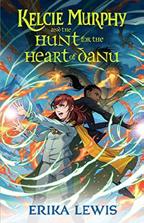
Lewis, Erika Starscape/Tor (432 pp.)
$19.99 | July 25, 2023
9781250208309
Series: The Academy for the Unbreakable Arts, 2
Student mage Kelcie’s second year at the Academy for the Unbreakable Arts proves eventful as the Never-Ending War between the Lands of Summer and Winter escalates.
Expanding the already unwieldy cast of her magic-school story with the introduction of a second lead, Lewis sends 12-year-old Lexis, who’s at the head of her fianna (a closely bound team of schoolmates), into Summer to steal Danu’s Heart, a powerful artifact. The Queen of Winter assures her it will at last bring an end to the war. But while masquerading as a new student at Summer’s Academy and joining Kelcie and her fianna in martial training, Lexis’ conscience (as well as her dedication to her mission) is seriously challenged by claims that the artifact’s theft would actually destroy Summer utterly. Meanwhile, amid portents of impending doom, including a visit from her terrifying war goddess mother, Nemain, and hints of a Winter spy in the school, Kelcie’s relationship with best friend Prince Niall evolves into something more. The author keeps her tale rolling with hard-fought battles and breathless escapades plus a crowd-pleasing array of foes, many drawn from Celtic mythology. Though Kelcie and Lexis have different personal issues to wrestle with, along with being equally matched in the magic and fighting skills departments, by the end they look to be not rivals but allies in future episodes. The cast includes fantasy race diversity; Niall was born with one hand.
An engaging medley of new relationships and hot battlefield action. (glossary) (Fantasy. 912)
Lewman, David
Illus. by Francesco Francavilla
Amulet/Abrams (224 pp.)
$14.99 | June 6, 2023
9781419762062
Series: SpongeBob SquarePants
Mysteries, 2
Trails of glowing green slime lead private detectives SpongeBob and Patrick into danger in this goo-noir spinoff.

Thrilled to don trench coats and fedoras for a second case, SpongeBob and sidekick Patrick Star slide into an investigation that takes them from the tough customers of the Salty Spittoon to a face-off with a squad of slimy villains including Man Ray, Jumbo Shrimp, the Atomic Flounder, and giant mutant Sinister Slug—capped by a wild car chase that brings retired crime
fighters Mermaid Man and Barnacle Boy out of the Shady Shoals Rest Home to help. Other main cast regulars like the Flying Dutchman put in cameos, and the level of humor will likewise be familiar to fans of the TV series: “ ‘Luckily, no customers got hurt,’ SpongeBob observed, ‘since there are never any customers here.’ He laughed at his own joke. ‘DI YI YI YI YI YI!’ ” But as the bad guys turn out to be just trying to steal a car for a joyride and meekly turn themselves in at the end, Lewman doesn’t squeeze out much in the way of either stakes or suspense to engage nonfans of the “man of aquatic action.” The art is limited to murky monochrome vignettes at the chapter heads, with a partial view of the spongy, heavy-lidded gumshoe, feet on desk, used several times.
An underboiled grab for fan dollars. (Illustrated fantasy. 79)
Liu, Linda
Henry Holt (40 pp.)
$18.99 | July 11, 2023
9781250835079
A rock explores existential questions and is the wiser for its efforts.
It’s the Jon Klassen eyes that pull viewers in: black pupils on gray/green irises atop white ovals. With just a hint of movement, they express exactly what the gray, speckled half-orb is feeling. Adults may hear a Paul Simon refrain after the first line—“I am a rock”—while emerging readers will appreciate the smooth rhymes and simple language that nevertheless convey deep thoughts. When a brochure advertising “The World’s Most Beautiful Gem” blows by, the protagonist joins throngs of other stones headed to the Museum of Rocks. Liu’s watercolor and digital compositions include softly textured landscapes with rounded green hills showcasing the domed edifice. The effect of the gorgeous, multicolored gems (also with eyes) on the main character is palpable: “These rocks shock and glow and humble.” The rock wonders how it can be special, too, and imagines following the same rocky journeys as the others or molding itself to be like Michelangelo’s David or various famous paintings whose faces have been replaced with rocks. But seeing its reflection in a dazzling diamond helps the rock grasp its own beauty—and the worth of those around it. While there are many recent children’s books that celebrate identity, make room for this one, which blends subtle humor and superb design for a profound, deftly conveyed message. (This book was reviewed digitally.)
The levity lightens the mood; the art is breathtaking. (Picture book. 37)
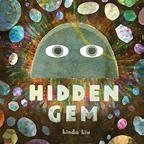
$18.99 | $21.99 PLB | July 25, 2023
9780593375310
9780593375327 PLB
Lines blur between reality and fantasy in this tale of a beloved stuffed rabbit who is lost and found.
A title-page illustration shows a child with brown skin and wavy dark hair clutching a plush bunny while walking toward two adults (one has similar coloring; the other is lighter-skinned) who are packing a car with a canoe strapped to its roof. As the trio drive off on their camping trip, the child holds the stuffed rabbit out a rolled-down window. It becomes clear that the titular you refers to the toy, as the child loses hold of it. The rabbit sails out the window and into the roadside woods. While it’s hard to understand why the family doesn’t stop the car to look for the toy, their inaction is crucial to the plot: It is in the woods that the toy comes to life. Forest creatures, including a friendly fox, come upon the rabbit, and “That’s when lost can become something else.” Whimsical descriptions of “something else” might be obscure for some readers (“A poem without words. // A song without notes. // A light / a breath / a world / a celebration”), but accompanying watercolor-and-ink illustrations, which make dramatic use of perspective, ground the story in the rabbit’s playful explorations of the woods with new woodland friends. A reunion between bunny and child rounds out this sweet story, with a cozy campfire delivering a happily-everafter ending. (This book was reviewed digitally.)
Find this book. (Picture book. 36)
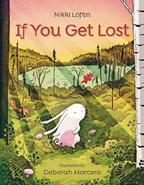
$18.99 | May 16, 2023
9781338776218
From dawn to bedtime, loving glimpses of children living through an ordinary day.
Writing almost entirely in rhyming, sonorous sequences of simple nouns, Lukoff begins with sunrise—“A kiss, a blink, a dawn, / a break. // A yawn, / a peep, / a stretch, / awake!”—and goes on to caption cozy digital paintings of three young suburban child neighbors stirring out of bed, dressing and eating, walking out with parents to a playground…then at day’s end coming back home for a bath, a meal, a book, and finally bed. Realistically, the outing has its emotional downs as well as ups, as a broken toy and other mishaps lead to “a lap” for one child, “a nap” for another, and, following a tantrum, a calming bath for a third. Alam depicts a cast diverse of age, race, and family composition, including among the last a child and a baby sibling
with two male-presenting parents (brown skinned, in different shades) and a live-in elder. From first light to moonlit final scene, each moment of this domestic round glows with feelings of warmth and safety. (This book was reviewed digitally.)
Soothing, familiar, and perfect for reading at bedtime—or any other time. (Picture book. 46)
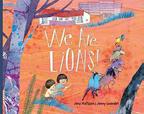

Makechnie, Amy
Illus. by Ariel Landy Simon & Schuster (320 pp.)

$17.99 | June 20, 2023
9781665918985
Miniature schnauzer Lord Tennyson is in charge of the six rambunctious McNiff children.
This precocious dog has his paws filled teaching the children to mind their manners, curb their fighting, and ride their bikes. The children’s bumbling father directs community theater productions, and their absent-minded mother is distracted by her gardening and baking—which leaves this accomplished canine in charge. As if six children weren’t enough, the family, who live in a pink New Hampshire farmhouse, also have two bunnies, six chickens, and a snake. It is summer vacation for the McNiffs, who are cued White, and chaos reigns, especially between the two oldest girls, Mary, 11, and Annie, 13. In fact, their mutual animosity is venomous; some readers may be distressed by the meanness on display and find it difficult to feel compassion for them, while others may relate all too well. With bed-wetting, a stolen diary, and graffiti involved, even the Sibling Council cannot repair their fractured relationship. Lord Tennyson must find new tricks to bring the children back together into a united pack before summer’s end. When Pearl, one of the younger McNiffs who will be entering kindergarten, goes missing, the drama switches gears as Lord Tennyson truly proves his dedication and value to his family. The writing is strong, and Lord Tennyson has an arch, competent manner in keeping with his professional role model, Mary Poppins. Final art not seen.
Chaotically entertaining. (Fiction. 812)
Mattsson, Jens
Illus. by Jenny Lucander
Trans. by B.J. Woodstein
Groundwood (32 pp.)
$19.99 | March 7, 2023
9781773067018
Two siblings must learn to be fierce in the face of a frightening new foe.
A boy and his little sibling (who narrates this story) love pretending to be lions—they roar and hunt and stalk the savanna. Until one day, big brother lion does not feel well and has to go to
the doctor. Big brother must go to the hospital, where he looks like a caged lion surrounded by tubes and equipment. His mane begins to fall out, and he misses his pride. Playing at being lions helps the younger sibling grapple with their elder brother’s serious illness as patients in hospital hallways are, through the magic of imagination, transformed into the beasts of sub-Saharan Africa. In Lucander’s chaotic illustrations, dramatic overhead angles brilliantly evoke the turmoil this family confronts; in many scenes, objects are askew, and the parents look drawn and worried. Collage art brings to life the siblings’ vivid imagination as they race into the savanna to escape their troubles. Unsentimental yet brimming with emotion, Mattsson’s matterof-fact text, translated from Swedish, makes the idea of childhood illness somehow more comprehensible to both adults and kids. While the story ends with the older sibling still sick in bed, it ends on a note of hope: “Soon we’ll go hunting again.” The siblings and their father are tan-skinned; their mother is lighterskinned. (This book was reviewed digitally.)
Inspired and sensitive storytelling that will help little ones make sense of a potentially disturbing topic. (Picture book. 48)
McCloskey, Kevin
TOON Books/Astra Books for Young Readers (36 pp.)
$13.99 | July 11, 2023
9781662665080
Series: Giggle and Learn
A caterpillar’s journey from egg to butterfly…or maybe moth.
“A caterpillar,” McCloskey writes, alongside an inside peek at a specimen with important parts labeled, “is a tube with a stomach.” As impersonal (and true) as that may be, his endearing cartoon images of various kinds of caterpillars will give young readers good cause to join two budding investigators—one light-skinned, the other dark-skinned—and a cat in learning about eggs, instars (or stages), anatomy, cocoons, and chrysalises on the way to witnessing in sequential views a set of marvelous transformations. Nearly every figure in the cleanly drawn scenes, including the cat, offers simple facts and playful comments on the way: “And what do you think comes out…of the chrysalis or the cocoon?” “A big baboon?” “NO!” “A small raccoon?” “NO!” “A dish that ran away with the spoon?” “NO!” Along with pointing out physical differences between butterflies and moths, McCloskey goes on to depict examples of both posed next to their different-looking juvenile forms and closes with a quick summation of the monarch’s migratory life cycle. An animated entry about a common backyard miracle. (Graphic nonfiction. 57)

Messner, Dennis Top Shelf Productions (88 pp.)
$9.99 paper | June 20, 2023
9781603095235
A potbellied pig and an iguana ditch their petting zoo home for freedom in this webcomic-turned–graphic novel.

The escape plan starts with chaos: A miniature train crashes through the zoo’s gate. Next, Pigmund Isidore Pigmund (a pig) and Lizárdo Van Buren Van Halen (an iguana, allegedly) ride off on getaway chickens as the zoo’s maintenance man chases after them. In the outside world, a pampered Chihuahua inspires the runaways to seek out “SWEET PET PERKS.” The duo then declare themselves “FREELANCE PETS,” meaning they “can walk away from their dumb pet job ANY TIME THEY WANT.” After creating business cards on the backs of pizza boxes, they go door to door on a “Finding Business Quest.” Eventually they find their ideal customer—on their 74th try. That is, until a hamster warns that things might not be what they seem. This pseudo-autobiographical comic (told from fictional pig to real-life human Messner) is divided into five “adventures.” Messner’s black-and-white illustrations, often borderless, give a DIY comics feel. The style fits well with Pigmund’s over-the-top, self-referential first-person narration. Circuitous storytelling situates Pigmund as a delightfully unreliable narrator who even occasionally teases withheld details. All human characters’ skin is the white of the paper.
Hog wild hilarity. (Graphic fiction. 912)
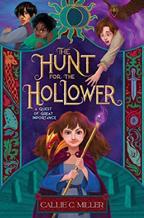
Miller, Callie C.
Illus. by Kristy De Guzman
Aladdin (400 pp.)
$18.99 | June 13, 2023
9781665918107
Eleven-year-old twins Merlynda and Percy are descendants of the wizard Merlyn, who prophesied that a member of their generation would be destined for greatness.
Merlynda’s often explosive magical mishaps are legendary, so everyone assumes the Septimum Genus—the most powerful magician in their generation, the seventh since Merlyn—will be gifted Percy. But Merlynda receives her familiar first, and he says that she is the Septimum Genus. In another shocking twist, Percy suddenly disappears into a portal, but not before passing his sister a parchment bearing the name the Hollower. Merlynda and Iggy, her wormlike wyvern familiar, set out to save Percy, accompanied by Neci, the twins’ friend, a girl who desperately wants to be a knight. The rescue is their main focus, but as with any good legend, they tackle side quests and gain
“Hog wild hilarity.” the unpetables
companions, including Batu, a boy minstrel with noteworthy fighting skills. It’s all very colorful, amusing, and action-packed and complemented by atmospheric spot art. Occasional notes from the narrator are interspersed when background information is needed. As they travel, the questers gain allies and enemies who fiercely clash when they finally confront another towering figure from Arthurian lore and attempt to secure Percy’s freedom. The youngsters’ adventures change them; they, Percy especially, must confront truths about themselves, even when that is uncomfortable, and develop strength of character. The twins read White; Neci is cued Black, and Batu has black hair and tawny skin.
A rousing romp with deep themes. (Adventure. 812)
Miller, Kelly Leigh
Simon & Schuster (40 pp.)
$18.99 | July 18, 2023
9781534497696
Series: I Love My Books
Magic: What’s not to love?
Willow, a young witch, loves her wand, which magically whisks stuff her way when she brandishes it. Everything Willow wants to accomplish, she does. She attributes her very witchiness to it. Alas, the teacher (a mummy in a yellow dress) at the school for cryptids Willow attends confiscates the wand when our witch unfairly uses it to score a goal during a soccer game. Afterward, Willow cleans up, waters the plants, and plays with her mythological schoolmates—a pint-sized Dracula, unicorn, werewolf, and a dragon who uses a wheelchair, among others— without magical intervention. When the wand is returned, Willow claims she’d forgotten about it, realizing she hadn’t needed it. Willow concedes that though her wand’s great, she doesn’t have to use it for everything to be a witch. She seems to understand her own abilities and talents are what’s really magical, and she can be a witch without the wand. Intended to reassure readers about their own strengths, this message may go over more literal-minded children’s heads, who might wonder how someone can be a witch without their powers. The vividly colored digital illustrations fare better: They’re lively and sweetly appealing, and the cryptid students are endearing. Unusually, text is set in all capitals. Exuberant, purple-haired Willow has light-brown skin; other humanoid characters are diverse in skin tone. (This book was reviewed digitally.)
A cheery reminder that true magic lies within. (Picture book. 47)
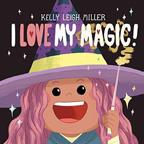

Morlesin, Rodrigo
Illus. by Mariana Ruiz Johnson
Trans. by Sara Lissa Paulson
Minerva (56 pp.)
$18.99 | June 20, 2023
9781662651106
Gather round and hear the story of Luna the dog and her daughter Ranchera, the most famous singing sensations in the Nuevo Wild West.
A cat stands on a stage before an audience of diverse humans and animals and tells of this doggy duo. As the story goes, Luna was forced to resort to stealing to feed herself and her puppies, including the feisty and courageous Ranchera. One night, a man shot at her, and Luna ran till her legs ached. When she stopped, she was stung by a bee and began to howl—“It was the pain of constant hunger, the pain that comes from never havin’ whatcha need.” The sorrowful sounds brought everyone from far and wide, led by Ranchera. Ranchera howled along with her mother, and their heartbreaking song was heard by humans and animals alike. After that, Luna and Ranchera became famous and sang for audiences far and wide. This rags-to-riches story of a mother-and-daughter pair making it big will pull at readers’ heartstrings. The framing device—that of the cat recounting the story for an appreciative audience—is inspired. Translated from Spanish, the writing has an appealingly folksy, tall-tale feeling. Reminiscent of Raul the Third’s artwork, the illustrations feature large-eyed, anthropomorphic animals wearing sombreros and scarves in a hip, Western-inspired desert setting. (This book was reviewed digitally.)
A strikingly original story of overcoming the odds. (Picture book. 48)
Moyer, Rich
Random House Graphic (240 pp.)
$13.99 | $16.99 PLB | June 20, 2023
9780593308998
9780593309001 PLB
Series: Ham Helsing, 3
Ham and the gang return to fight the ultimate vampire.
In his third graphic-novel adventure, gentle Ham Helsing returns with friends Ronin the ninja, vampire-pig Malcolm, werewolf Eugene/Lobos, and Knuckles the bear. Although Helsings have a long-standing history of fighting vampires, Ham wants to stop hunting monsters. Following his father’s untimely death, he and the gang travel to his ancestral home to make peace with his legacy. However, two surprise guests turn their plans upside down once the crew arrives at the snowy Helsing manse: Ham’s father, Clarence—now very much alive—returns alongside a powerful, old shape-shifting vampire. When the vamp stalks the gang, they must work together with
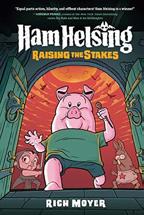
“A strikingly original story of overcoming the odds.”
luna ranchera
Clarence in order to survive. Moyer’s latest installment is a sheer delight, bursting with humor and fast-paced action. Though the silliness alone is enough to create appeal, Moyer adds surprising depth, exploring themes of perceptions and assumptions, familial expectations, and toxic masculinity. Clarence treats Ham poorly, often forgetting his name (though never forgetting that of the son whose behavior he approves of) or openly mocking him because he does not share the Helsing passion for destruction. Despite this, once their bond is tested, Clarence finally comes to accept the wholly likable Ham just as he is. Like its two predecessors, this volume concludes with a short comic about Shaz-ham.
Filled with heart and still as funny as ever. (Graphic fantasy. 711)
Mucha, Laura & Ed Smith
Illus. by Harriet Lynas
Nosy Crow (64 pp.)
$21.99 | Aug. 1, 2023
9798887770185
A wide-angled overview of the foods that sustain and entertain us.
Taking a resolutely international approach, the authors—one a poet, the other a trained chef— offer terse but taste-tempting descriptions of hundreds of dishes prepared worldwide with dozens of fruits, vegetables, meats, herbs, spices, nuts, and sweets. After priming readers to think of food analytically in terms of taste, smell, and texture, they launch their survey with various savory examples made with “Remarkable Rice” or “Amazing Maize,” from Italian risotto (which “you must, must, MUST keep stirring as you cook, because this helps it become really oozy”) to noodles like Ukrainian lokshyna. Along with the multitude of entrees, side courses aplenty look at tableware, the dangers of overfishing, how to say delicious in 15 languages, and more on the way to pages of desserts and a closing map of all the countries featured (with, characteristically, “The End” in 18 languages). Lynas’ brightly colored images of, mostly, children diverse in race and ethnicity who appear eager to chow down on yummy-looking provender make all of this even easier to digest. Though some widely consumed ingredients don’t earn separate entries (neither barley nor honey makes the cut, for instance), the menu does extend to insects and even (if under the heading “Fake food”) meat grown in labs or made from plants.
Another way we are all linked by our differences; rewarding reading for everyone who eats. (Nonfiction. 79)

Munro, Roxie Holiday House (32 pp.)
$18.99 | July 18, 2023
9780823453603
Discover the world of reptiles. Munro follows her presentation of life-size coral reef inhabitants (Dive In, 2020) with another informative introduction showcasing 21 lizard species from around the world. Like her many other nonfiction titles for young readers, this one features careful research and thoughtful selections of examples and details that will be both engaging and useful for identification. Lizards, she tells us in an introduction, have been on Earth since before the dinosaurs. They’ve fascinated humans for millennia. Most are harmless, and their habit of eating insects is helpful. Each depicted lizard gets a life-size portrait and a paragraph of introduction. The smaller lizards appear three or four to a spread, and readers work their way up from the armadillo girdled lizard and the green anole, which range from 5 to 8 inches in length, to the 10-foot Komodo dragon, which requires two spreads (and even then much of the lizard’s long tail is left out). In these detailed and accurate ink and acrylic paintings, a bit of environmental context surrounds each example. Useful words are italicized in context and defined in a helpful glossary. The backmatter includes further information about each of the chosen species, including Latin name, length, habitat, diet, bodily and behavioral adaptations, and even nicknames. (This book was reviewed digitally.)
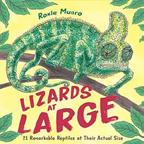
A straightforward and appealing introduction. (author’s note, books, website, index) (Informational picture book. 610)
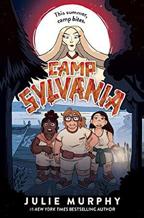
Murphy, Julie Balzer + Bray/HarperCollins (288 pp.)
$18.99 | June 6, 2023
9780063114029
A girl must survive not only fat camp, but the vampire who runs it.
Despite Maggie’s plan to spend the summer with her best friend at Camp Rising Star, where she’ll hopefully get over her persistent stage fright, her parents instead ship her off to Camp Sylvania so she’ll finally lose her “baby fat.” Though feeling betrayed, Maggie, who is White, starts to think spending afternoons on the lake might not be so bad, especially as she gets to know her bunkmates and decides to try out for the camp musical. But between the odd diet of mostly red foods, lack of technology, and mean and creepy counselors, the only place the campers truly feel comfortable is in the air-conditioned blood bank (regular donations are mandatory). When her co-star’s brother goes missing along with several other campers, Maggie and her bunkmates begin
an investigation into the gruesome truth at the heart of the camp. Murphy renders her camp of fat characters with nuance, giving them unique personalities beyond their size and often pointing out how others’ judgments ignore their full humanity and undermine their confidence. Jokes and sweet interactions round out the story, while hints at the camp’s monstrous nature create a spooky atmosphere. A continuing focus on the musical in the latter half stunts the story’s growing stakes but gives Maggie the chance to fully seize her moment in the spotlight.
A fun and spooky celebration of fat kids and friendship. (Fiction. 913)
Murray, Diana
Illus. by Luke Flowers
Sourcebooks Jabberwocky (32 pp.)
$18.99 | July 4, 2023
9781728271323
A rhyming undersea celebration. Murray and Flowers stay true to the formula of Unicorn Day (2019), though this time it’s a group of mermaids who are getting together for a can’t-miss shindig. In honor of Mermaid Day, a tan-skinned mer-queen is hosting “a great big bash!” After the preparations are complete, the guests—mer-friends and marine animals alike—swim inside the mer-queen’s castle for a day of fun. The mer-queen invites the partygoers to try on the jewelry from her treasure chest. Then it’s time to make music, dance with dolphins, ride seahorses, and play a game involving tossing rings onto the narwhals’ horns. A fabulous full spread is dedicated to the arrival of an intruding shark, but Murray subverts expectations by revealing that this fearsome-looking underwater predator just wants to join the jamboree. Anyone seeking a more subdued story should look elsewhere—the scenes are unapologetically busy in color, layout, and word choice. The mer-queen’s lavish castle looks like a layered cake festooned with decorations, while the treasure chest bursts with bling. This book delivers on its promise of a fun-filled day—mermaid fans will turn the pages again and again. The mer-friends are diverse in skin tone. (This book was reviewed digitally.)

A joyful romp from beginning to end. (Picture book. 36)


Nabi, Zohra
McElderry (336 pp.)
$17.99 | June 6, 2023
9781665931083
Cryptic directions from her mother lead Yara Sulimayah from England to a magical world.
Upon her death, Yara’s mother leaves her instructions for reaching another world—the city of Zehaira, where she’ll
find the sorceress Leyla Khatoun. Although skeptical, Yara’s also desperate to learn more about her and her mother’s past (on paper, they’re from Iraq). She finds an alternate world where the Sultan has sided with the alchemists, banning magic and forcing the sorcerers into hiding through a brutal Inquisition. On her journey to find Leyla, Yara overhears evidence of a dangerous plot to wipe out sorcerers for good. But Leyla, rather than helping her as her mother promised, is busy keeping a secret sorcerer settlement running and is uninterested in the city sorcerers’ woes. Yara must crack through Leyla’s self-protective mechanisms and convince her of the existential threat coming their way, all the while trying to get Leyla to spill the secrets Yara’s mother kept. That Yara ends up having (unconventional) magic of her own might be expected, but by then readers will have already formed an attachment to the determined, bighearted hero. The setting—an Arab-coded world that simmers with magic—is richly described and populated by complex people and jinn. The ending wraps the action up a bit abruptly but looks forward to more dangers and adventures in the sequel.
A debut that marks the author as an exciting storyteller to watch. (Fantasy. 814)
Nelson, Colleen
Pajama Press (224 pp.)
$18.95 | June 6, 2023
9781772782790
Seventh graders Roxy Markowski and Scout Chang-Poulin are longtime best friends.
They live in Umbrella House, a real co-op in New York City’s East Village. In 1988, the then-abandoned building was occupied by squatters who restored it, after which the city government legalized the situation. Several decades later, this realistic, contemporary novel, narrated by Roxy, tells another story. A developer is buying up properties and needs the city council’s permission to acquire the building. Long-term inhabitants of the East Village, which is known for its artists, musicians, and activists, see this as unwanted gentrification. Roxy lives with her paternal grandmother, a flea market dealer. Scout has two moms, a lawyer and an art gallery owner. The kids join with neighbors to save their building: bookstore owner Miguel, artist Ortiz, and musician Lenny. Roxy, with her research, writing, and acting skills, and Scout, with his photography, video, and editing abilities, have their own YouTube channel where they share stories about the East Village. Now they enter a contest— the prize is working with a professional reporter to produce a documentary—and their video entry focuses on the fight for their building. Blending fact, fiction, social issues, and friendship, this novel ably highlights young people’s strengths. Names are the only clues to ethnic diversity.
Art versus mammon: An uplifting account of creative kids working to preserve a city landmark. (map, photo, author’s note, sources) (Fiction. 913)
dolly parton’s billy the kid makes it big
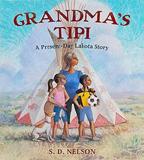
Nelson, S.D. Abrams (40 pp.)
$18.99 | May 9, 2023
9781419731921
Two young Lakota children learn about their Indigenous culture from loving elders.
Clara can’t wait for an extended summer visit with her cousin Juniper and their unci (grandma) on the Standing Rock Reservation. The excitement only builds when Uncle Louie arrives in his red pickup with “a large canvas-cloth bundle” and “poles, as long as could be”—the family’s tipi, of which Unci is the keeper. Unci teaches Clara and Juniper through storytelling about “the circle of our tipi” and its connection to Cangleska Wakan, or the “Sacred Hoop.” Nelson (Standing Rock Sioux) depicts his people’s customs with reverence; from burning sweetgrass to painting the canvas walls with spirit pictures, the grandchildren’s cultural inheritance is illustrated with warm, beautifully textured details. Under Unci and Uncle Louie’s loving guidance, Clara and Juniper learn more of their Lakota traditions: drying meat into bah-pah (jerky), beading necklaces and traditional dresses, and the hilarious antics of heyokas (sacred clowns). These practices have endured over time, just like the family tipi, built to withstand heat, wind, and rain. When Clara’s time on the Standing Rock Reservation comes to an end, the rich lessons of her heritage stay with her—just as they will with young readers, who will be drawn in by both Nelson’s moving narration and glowing images. (This book was reviewed digitally.)
A love letter to Lakota traditions. (author’s note, photographs) (Picture book. 510)
Ormsbee, Kathryn Harper/HarperCollins (320 pp.)
$19.99 | June 13, 2023
9780063060043
It’s the first day of eighth grade…over and over again.
Vivian Lantz has a bad first day every new school year, but she’s determined to have a fresh start for eighth grade even though she’ll be without her best friend, who recently moved away. She sets out to accomplish the tasks on her Master Plan, but right from the start, nothing goes as anticipated, and it ends up being the worst of her very bad first days. When she wakes up in the morning, though, it’s Monday all over again. Vivian wants to use her second chance to have the perfect day, but with each time loop reset, she makes different choices that lead to her changing her mind about what her goals should be and what a perfect day would look like. This story set in Austin, Texas, successfully uses the repeating-day trope to explore the emotions
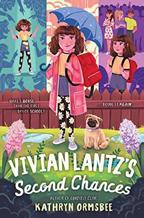
and conflicts common in middle school, from friendship drama to new crushes to getting one’s period for the first time. Just as Vivian, an aspiring author, relates to the characters and themes from her favorite fantasy book series, readers of this book will connect and empathize with bighearted Vivian even when she makes frustrating decisions. Vivian is cued White, is attracted to both guys and girls, and has queer dads; there is ethnic diversity among secondary characters.
A warm, engaging coming-of-age tale with a sprinkle of magic. (Speculative fiction. 913)
Parton, Dolly with Erica S. Perl
Illus. by MacKenzie Haley Penguin Workshop (40 pp.)
$17.99 | April 25, 2023
9780593661574
In this picture book from singer Parton and co-author Perl, a small French bulldog goes to Nashville, joins a band, fends off bullies, and meets one of the queens of country music.
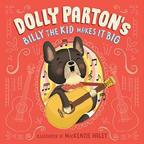
Promising at the outset that this is just the first of a series of adventures starring her beloved “god-dog,” Parton goes on to hit all the conventional thematic notes. Inspired by musical dreams, Billy heads for Nashville. After a “ruff day” in which being scorned by big dogs for not being a “true muttropolitan” leaves him feeling “lower than a stick on the ground,” he eats some flowers, strums some tunes, forms a band with a trio of little dogs, and, after sending the big pooches packing, trots out a “pawsome” performance at the “Battle of the Bow-Wows.” And from there it’s on to the Grand Ole Opry to hear his bighaired favorite singer warble out lines from her song “Makin’ Fun Ain’t Funny,” about celebrating differences rather than mocking them. Haley slips those lines, along with references to “Jowlene” and “I will pawlways love you,” into painted scenes of an all-dog-or-Dolly cast set against swirls of music and simply drawn backdrops. (This book was reviewed digitally.)
Music takes center stage and bullies get properly punished in this hearty and wholesome howl. (Picture book. 68)
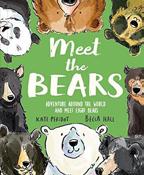
Peridot, Kate
Illus. by Becca Hall
Welbeck Children’s (48 pp.)
$19.95 | July 11, 2023
9781804535110
A parent and child take a worldwide nature tour to meet the eight members of the ursine clan.
The trip starts right up as, teddy bear in tow and following a page on which helpful travel and bear-spotting supplies are laid out, the two brown-skinned nature lovers board a boat
“Music takes center stage and bullies get properly pun-ished in this hearty and wholesome howl.”
to cruise past a polar bear in his icy setting. From there it’s on to watch a brown bear (from a healthy distance) as she snags salmon from a river for her two cubs, peer cautiously out of a tent as a black bear eats supplies carelessly left on a picnic table, and go on to glimpse a spectacled bear in an Andean cloud forest and other bears in their natural habitats. For each encounter, Hall provides both a full-page close-up illustration and a set of smaller images of paws, foods, poop, or other select details to go with Peridot’s descriptive and range notes. And for readers who might be inspired to undertake some bear watching of their own, the importance of staying safe is very properly highlighted, from a first-page comment that bears “are strong. And they can smell you coming from miles away,” to a closing set of cautions for proper behavior in bear country. (This book was reviewed digitally.)
Savvy and informative—equally suitable for both armchair and open-air expeditions. (information on other bearlike but unrelated animals, list of bears by size, map, websites) (Informational picture book. 68)
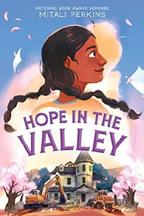
Perkins, Mitali
Farrar, Straus and Giroux
(304 pp.)
$18.01 | July 11, 2023
9780374388515
Grief, memories, and the difficulty of letting go permeate this powerful story about family, friendship, and finding your voice.
Pandita Paul’s Bengali family includes two older twin sisters, Shar and Indy, and their father, Baba, but it has a gaping hole: their late Ma. This chasm is deepened as the nearby abandoned Johnson property, including the orchard Pandu and Ma called Ashar Jaiga, or place of hope, is being sold and developed for rental units. This demolition will take with it Pandu’s sweet recollections of enjoying the orchard’s apricots, flowers, and bird song with Ma. Things are changing too fast for Pandu. Worse, everyone seems to be moving on, including her ex–best friend and even Baba, who is dating The Intruder. But tentative friendships blossom at her summer drama camp even as Pandu, desperately clinging to her memories of Ma, is pitted against her own sister, who advocates for affordable housing in their Silicon Valley community. Set in the 1980s, this beautifully written book weaves together the Indian American Pauls’ personal histories as well as those of the U.S. and India. In trying to save the place she and her mother loved, the 13-year-old embarks on a journey that takes her down pathways of memory of earlier inhabitants of the Johnson house and the region. In doing so, Pandu gives wings to her words and her voice. There’s poetry here, along with literature and lots of culinary heritage, all combining in a deeply compelling read.
A riveting, courage-filled story. (Fiction. 812)
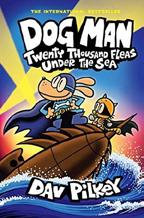
Dav
Colors by Jose Garibaldi & Wes Dzioba
Graphix/Scholastic (240 pp.)
$14.99 | March 28, 2023
978-1-338-80191-0
Series: Dog Man, 11
When Dog Man accompanies Chief and Nurse Lady on a date, it kicks off a series of events that find the doughty hero deep in the evil Piggy’s sweat gland facing off against a microscopic parasitic mite.
The plot of Pilkey’s latest adventure featuring his caninehuman hybrid cop is characteristically Rube Goldberg–ian, with such cheerfully bizarre twists as the rupturing of the mini-jail containing Piggy when a dog named Mister Stinkles picks it up and drops it. That Mister Stinkles is being walked by the dog-hostile restaurateur who tried to refuse service to Dog Man a few pages earlier is just one of this outing’s many delights. The fleas of the title are actually the Fuzzy Little Evil Animal Squad, but only one of them—the aforementioned Piggy—can be called evil. Indeed, his henchcreatures are so amiable that they’ve joined the Friendly Friends with Daryl the moth, much to Piggy’s disgust. Threading through the silliness are some serious themes, and readers who peer past the madcap antics will find critiques of the carceral system and the social media feedback loop of fear and anger. Fueled by loud, frenetic colors (courtesy of Garibaldi and Dzioba), this adventure’s got something for just about everyone, including a heartwarming conclusion. Chief presents Black; most other human characters present White.
Supa satisfying. (cast of characters, drawing tips, notes & fun facts) (Graphic adventure. 812)
Pollan, Michael
Adapt. by Richie Chevat
Rocky Pond Books/Penguin (208 pp.)
$18.99 | $10.99 paper | May 9, 2023
9780593531525
9780593531549 paper
A youth-friendly reimagining of Pollan’s seminal work on the intersection of evolutionary botany and human desires.
Adapted by Chevat, this title examines the relationships between four foundational human desires and plants that have evolved alongside us to satisfy them. Apples, tulips, coffee and tea (filling in for marijuana in the original), potatoes—each has had an effect on and in turn been affected by human civilization, satisfying our innate cravings for sweetness, beauty, energy (intoxication
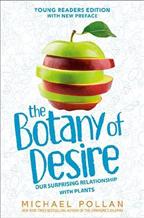
“Grief, memories, and the difficulty of letting go permeate this powerful story about family, friendship, and finding your voice.”
hope in the valley
in the previous book), and control (the modifications we’ve made to the potato represent an attempt to exert power over the natural landscape), respectively. A deep dive into the biology of each plant as it intertwines with the history of humanity will entice readers with historical or scientific interests. Pollan’s friendly, conversational tone and first-person recollections bring levity and enthusiasm; his sharp wit and self-awareness give much-needed life to what would otherwise have been more esoteric and dryly scientific sections. Pollan’s passion for his subject is evident and infectious as he encourages readers to psychologically reconnect with nature. The omission of marijuana and some sexual content will make this a more acceptable choice for young people’s collections, and adult readers of the source material may want to check out this adaptation for the added chapter on the desire for energy and our beloved caffeinated beverages. Though readership for this work may be somewhat narrow, those who are drawn to it will find a wealth of information and food for thought.
A fascinating and accessible adaptation for scienceminded or history-obsessed youngsters. (glossary, partial sources) (Nonfiction. 1014)
Potter, Ellen Illus. by Sara Cristofori McElderry (112 pp.)
$17.99 | June 13, 2023
9781665926751
Series: Squirlish, 1

Cordelia’s home is a treehouse in a large elm tree in New York City’s Central Park.
No one knows where Cordelia came from, but the squirrel Shakespeare finds her as a tiny baby under a shrub and adopts her. By the time she is 8 years old, she is more squirrel than human, moving easily through the branches, leaping from tree to tree, and speaking Chittering. Shakespeare, her beloved father figure, mentor, and teacher, exposes her to the human Shakespeare’s plays at the theater in the park. Groundskeeper Viola Berry is her one human friend, supplying her with necessities. Cordelia often forgets she is human and is curious about people but uncertain around them. When her squirrel-like leaps attract the attention of a gymnastics coach, a series of hilarious events brings her into close contact with human children and adults, sometimes with disastrous results. But the adventure leads to a new appreciation of her unusual life and to Isaac, a new human friend. Cristofori’s detailed black-and-white cartoon illustrations match and enhance the fast-paced tale. Most of the action is set in real locations in Central Park, each with its own special aura, making the park an important character in the tale. Cordelia is inquisitive, confused, lovable, and utterly unique. The fantasy elements of her world are imaginative and charming, if a bit implausible. In the illustrations, Cordelia is light-skinned, Viola presents Black, and Isaac is brown-skinned. Suspend all disbelief and enjoy being a part of this world. (Fiction/fantasy. 710)
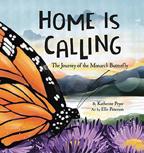
Pryor, Katherine
Illus. by Ellie Peterson
WorthyKids/Ideals (40 pp.)
$17.99 | Aug. 8, 2023
9781546003137
A close-up look at the 3,000-mile fall monarch butterfly migration to overwintering grounds in Mexico.
An opening spread shows a difficult-to-recognize distended North American continent, several orangish-white lines extending from the north and converging in Mexico. The text notes that it takes monarchs traveling north in the spring four generations to reach their destinations, but monarchs that hatch in the fall make the trip to Mexico in one go. From this opening, swirling, twirling orange-and-black butterflies fill the pages of this informative yet lyrical book. Challenging vocabulary will stretch readers’ own wings: kaleidoscope, nectar, roost. Pryor doesn’t shy away from the fact that not all will survive: Lack of resting spots and adequate food as well as storms are issues. The backmatter delineates other threats, things readers can do to help monarchs, the life cycle and anatomy of a monarch, information about milkweed, info about monarch migration and a map, and an author’s note. Here the text also notes that “insects change form as they grow in a process called metamorphosis,” which is true for only about 80% of species. While the picturebook format may be young for the audience that matches the text’s language, it’s a good springboard for further research into monarch migration for older students and a good stretch for younger ones. (This book was reviewed digitally.)
A launch pad for learning more about monarchs. (Informational picture book. 510)
Ramm, Meggie Amulet/Abrams (96 pp.)
$13.99 | March 28, 2023
9781419756573
Series: Batcat, 1
The adventures of a creature who is not entirely one thing or the other.
A ghost has made itself at home in Batcat’s comfy Spooky Isle treehouse, hogging the remote and stealing snacks. Batcat goes to the island’s witch—who is “neither a good witch nor a bad witch,” but, like Batcat, “somewhere in between”—for a magical solution. Gathering ingredients for the promised spell leads to scary and thrilling encounters with true bats in the “cavernous caves,” snotty cats in the graveyard, and a pair of wise griffins (who, as half-birds, half-lions, are also not one creature but parts of several), and eventually Batcat resolves nagging identity issues by accepting that they are unique in themself. The message is clearly in the driver’s seat here, but the story and the visuals are

sturdy and charming enough to carry it easily. In the full-color art, Ramm depicts Batcat as a rotund, Pikachu-cute figure with whiskers, pointy ears, and small (but working) wings. Likewise, for all the impenetrable darkness, mysterious graveyard screams, and seemingly deadly hazards of the spooky stops along the way, the smiling, brown-skinned witch (the only human figure) and the rest of the spectral, undead, and mythological cast have benign looks that keep the overall tone light.
Spooky fun, with a theme that’s relevant on Halloween and every other day besides. (Graphic fantasy. 710)
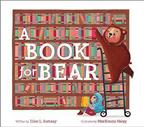
Ramsey, Ellen L. Illus. by MacKenzie Haley Flamingo Books (32 pp.)
$18.99 | July 18, 2023
9780593527245
Who doesn’t want to find the perfect book?
Book-loving Bear stands at the edge of the woods daily, listening to a blue-haired, tan-skinned girl named Ellen reading aloud beneath a tree. Before long, Bear emerges from his hiding place and sits beside her, entranced. Bear wants his own book— one that is the color of “ripe red raspberries” and is “delicious to read”—and asks Ellen where to get one. The places she names— her classroom, the library, the bookstore—don’t welcome bears. In order to choose his own book, Bear, accompanied by Ellen, visits each locale in disguise, dressing up as a superhero, a blueberry bush, and a coat-and-hat–wearing, umbrella-toting furry giant; unfortunately, all his efforts end in disappointment, with no book in paw. But never underestimate good old-fashioned ingenuity: Bear comes up with an ideal plan for acquiring a book, and together, he and Ellen find—no, make—the perfect book for Bear, a raspberry-red one that Ellen reads aloud, beginning with the words “Bear loved books.” This cute but obvious, slightly strained tale nevertheless conveys a terrific message about the love of books and the joy of reading. The warm bond between Bear and Ellen is sweetly appealing, as are the gentle humor and lively, colorful illustrations. Adults sharing the book should encourage children to write and illustrate and, if possible, read their own books. (This book was reviewed digitally.) A pleasant story about books and reading to share with kids and bears. (Picture book. 47)
Rhee, Helena Ku
Illus. by Stella Lim with JiHyuk Kim
Candlewick (40 pp.)
$17.99 | May 9, 2023
9781536209938
In her grief, a child finds new meaning in a cherished activity. Sora’s Korean grandmother, Halmoni, visits every summer. One of their favorite activities is finding shells on the beach. Sora observes as Halmoni collects a beautiful shell and leaves it on a bench before they leave. When they return the next day, they find that the shell is gone. Halmoni explains that the shell “wasn’t ours. It was a gift.” A puzzled Sora reacts by filling a jar with shells she hides for herself. Weeks later, Sora starts kindergarten and struggles with classmates who mock her name. Tragedy also strikes as Halmoni suddenly passes away. The family mourns by taking a trip to the coast. There, her mother explains that Halmoni had named her Sora (Korean for seashell) because “finding a perfect shell is like receiving a wonderful gift.” The illustrators deftly layer shadows and blur boundaries between colors, evoking the feeling of a warm memory. The gently paced narrative reveals Sora, now understanding her grandmother’s words, bringing her jar of shells for show and tell. After explaining her name, she gives each classmate a shell, changing a few minds in the process. As her own tribute, Sora places her last shell on the same bench. Sora is biracial; her mother is Korean, and her father is White. Her classmates are diverse. (This book was reviewed digitally.)
A tender tale of loss and love. (Picture book. 58)
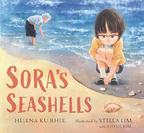

Rich, Simon
Illus. by Tom Toro
Little, Brown (40 pp.)
$18.99 | July 11, 2023
9780316628341
Everyone’s nervous about going to school—even your backpack!
After months of relaxing in the closet over the summer, a green backpack quivers with nerves when it hears the words back to school. The backpack has to be pried from the closet by a light-skinned child with a blond ponytail. Going to school is, we learn, a far more terrifying prospect for a backpack. “First you open my mouth and shove a bunch of strange new books and binders down my throat.” Slung over the child’s shoulders, the backpack “can’t even see where I’m going.” At school, the backpack is smashed, stuffed, and dragged. But the worst part of school is that the backpack doesn’t seem to fit in anywhere— a feeling that will be familiar to many readers. All that changes when it crashes into another backpack worn by a child with dark skin, short curly hair, and glasses. The punny moral of
the story? Life is better with a friend “because you don’t have to carry everything alone.” This funny romp will leave readers feeling empowered for their own first days. Strategically placed black pages with white lettering ramp up the drama. In Toro’s exaggerated cartoon illustrations, the backpack is wonderfully expressive, its eyes and zipper mouth conveying panic, nausea, a longing to belong, and, finally, happiness. (This book was reviewed digitally.)
Will give children the emotional distance to process their own first-day jitters. (Picture book. 46)
Riley, James Aladdin (352 pp.)
$18.99 | May 30, 2023
9781665904926
Series: Once Upon Another Time, 3
The evil Queens of Fairy get just deserts at last thanks to former giant Lena and her airheaded Lilliputian counterpart, Shefin.
Presuming that characters and events in previous episodes will be fresh in readers’ minds, Riley picks up his tale in midboil—guiding Lena to the Cauldron of Truth to throw off the fairies’ loyalty spell, regain her memories, and, with rebel fairy princess Gwentell and other allies, renew her quest to rescue the genie Jin from the magic lamp that imprisons him. But it’s Shefin, her forcibly assigned true love, who takes the lead here, and despite being as dense and clueless as a fence post, he’s utterly convinced that he’s the greatest hero ever. Armed with a magic sword that turns anyone it touches into a fervent partisan of the queens, Shefin will put readers back on his side by coming through at the last tick with an improbably clever wish that snatches victory from the jaws of defeat. Before that, though, the author spins out further misadventures with his large cast, predominantly cued White and largely drawn from European fairy tales, embedding frequent italicized digressions that fill out some significant backstories. Better late than never, but the latter do give the narrative a distinctly patchy character. Also, though slipping in a teasing hint of, maybe, further sequels, he gives Lena barely a bit part in the windup.

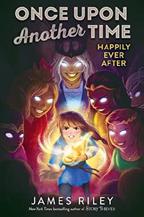
A proper, if not exactly seamless, trilogy finale. (Fantasy. 912)
pp.)
$14.99 paper | June 20, 2023
9781250625380
Series: Cat’s Cradle, 2
A young monster tamer journeys in search of her family.
This sequel to The Golden Twine (2022) picks up with 12-year-old Suri looking for odd jobs to keep herself, imp Caglio, and giant doglike monster Byron fed as they make their way to the Monster’s Cradle, where Suri hopes to find her family. Being followed by a group of Caitsiths, catlike shape-shifters, they head to the mining town of Tancredi, where they hope to find work. But unbeknownst to them, the miners of Tancredi have been going missing, leaving the formerly prosperous town in ruins. On their way north, they are attacked by a mole king, but they manage to escape and in the process rescue Kolya, a thief on an impossible mission who harbors a secret. Kolya stumbled across the mole king’s treasure but was caught in the act of trying to take some of the gold coins. He and Suri team up to try again. The action moves at a quick pace, and the storylines are easy to follow, although readers familiar with the first volume will better understand some of them. Strong in comedic timing and banter, this entry follows plucky Suri as she continues to problem-solve, extricating her band of travelers from numerous sticky situations. Suri has brown skin and hair; Kolya has light skin and black hair.
An exciting, adventurous continuation centering a clever protagonist. (map, journal entries) (Graphic fantasy. 814)
Rudd, Maggie C.
Illus. by Elisa Chavarri
Farrar, Straus and Giroux (40 pp.)
$18.99 | June 13, 2023
9780374390143
A town observes Independence Day. This colorful, rhyming picture book spotlights families celebrating a standard American Fourth of July. There are references to sparklers, cookouts, and parades as a sunny day transitions into night, building anticipation for a fireworks show. A lengthy description of an unnamed town’s big display dominates the story, ending with a good night’s sleep as children “dream of the colors red, white, and blue.” Written in a loose ABCB rhyme scheme with occasionally diverse meter, this is more like a structured list of things an American child might expect to see on that particular date than a story. Rather than following a specific character or group or coalescing around a plot or idea, the book depicts a racially diverse group of youngsters and their adults (many of whom are members of the armed forces, indicated by their clothes) who are simply celebrating. There’s very little information
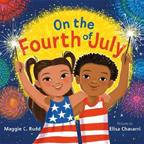
“An exciting, adventurous continuation centering a clever protagonist.”
the mole king’s lair
yenebi’s drive to school
about the holiday itself, and the only hint as to the “why” of the day is a single page’s mention of honking horns and a vague reference to “let freedom ring” and a cheer of “Happy birthday, America.” (This book was reviewed digitally.)
A jaunty, kid-friendly celebration of the Fourth of July, though light on story and background information. (Picture book. 37)
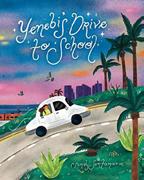

Salmon, Caspar Illus. by Matt Hunt
Nosy Crow (32 pp.)
$17.99 | June 6, 2023
9798887770246
A witty challenge using reverse psychology: Count only one item on each spread.
An unseen narrator presents one red apple, then one gray elephant. But now there are two large blue whales. Nevertheless, the text firmly instructs us to count only the one sausage held aloft by the whale’s spout. Bowls of red, green, and yellow soup tempt us to cry “three,” but the task is to count the one fly in the green soup. With deadpan encouragement, the narrator admires our progress: “You are really getting the hang of counting to ONE.” But then we are warned that “This is a bit more tricky”: There are four objects—one dinosaur in an astronaut helmet, one molded pink jello, one flaming meteor, and one pair of tighty whiteys, all floating in starry space. Pick one and count it! On another spread, 14 animals (including seven green snakes) and a few insects are arranged across a spread, with categorical instructions: “Using your counting skills, please count the giraffe.” Rashly, the narrator blurts out, “Hey, what number comes after ONE?” but quickly retracts the question: “I’m kidding! Don’t say it!” Finally, the last spread offers a challenge: Count the 100 objects arranged. Salmon manages a difficult task—a wholly original counting book that will have little ones gleefully defying the narrator’s instructions. Delightful, deceptively simple, collagelike illustrations show mastery of color and clever composition. (This book was reviewed digitally.)
Catnip for teachers or anyone leading a storytime and sure to tickle kids. (Concept book. 25)
Saltzberg, Barney
Orchard/Scholastic (32 pp.)
$12.99 | May 16, 2023
9781338815191
A little elephant eagerly anticipates the arrival of a new sibling.
It’s tough to be patient for a new baby, especially when there is so much to share with them. A
little purple elephant proudly lists all the fun things the siblings will do together: playing peekaboo, singing, and telling secrets, for example. The simple illustrations show the little elephant practicing knock-knock jokes and dancing with their pregnant mother in preparation. All the pages have brightly colored backgrounds, the elephants drawn with a thick black outline, their expressive faces displaying joy, impatience, and wonder. Directly addressed to the new baby from the little elephant, the text refreshingly focuses on the knowledge the sibling has to share rather than the changes to come. This encourages young readers to feel excited, empowered by all that they have to impart, and an important part of welcoming a new family member. When at last the baby elephant does arrive, the little one does not disappoint, adorably wrapped in a yellow polka-dot swaddle. The final pages showcase the siblings’ playful and loving relationship. (This book was reviewed digitally.)
A loving, charming ode to a growing family and sibling bonds. (Picture book. 25)
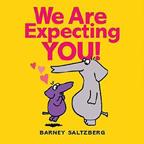
Santamaria, Sendy Chronicle Books (40 pp.)
$17.99 | June 27, 2023
978-1-79721-629-4
A trip to school takes on new meaning with the addition of a border crossing. Yenebi’s morning routine is similar to most other students’. Each day the young Latine child wakes up to the sound of Mami’s voice and helps little sister Melanie get ready for the day, packing their backpacks and preparing to head to class. For Yenebi and Melanie, however, their 5 a.m. departure from home marks the beginning of a daily journey that will take several hours and span two countries. Mami drives the kids across la linea, the border, every weekday from their home in Mexico to attend school in the United States. The trip is prolonged by slow-moving traffic through the international checkpoint. Mami’s love is palpable in her words of encouragement and the way she provides for the children along the way. Yenebi’s observations of the wares— tamales, wallets, cellphone charges—that vendors sell along the roadway to the passing cars bring the trip to vivid life. These youthful impressions contrast with Mami’s unspoken desire to provide the children with educational opportunities in the United States and the lengths to which she’ll go to make it happen. Softly rounded illustrations bring the vibrant border towns to life. Spanish phrases and vocabulary are mingled into the English text. Publishes simultaneously in Spanish. (This book was reviewed digitally.)
A going-to-school story elevated by a mother’s devotion and a child’s dedication. (Picture book. 58)
“A going-to-school story elevated by a mother’s devotion and a child’s dedication.”
SarconeRoach, Julia Knopf (40 pp.)
$18.99 | $21.99 PLB | June 20, 2023
9780593309858
9780593309865 PLB
A sweet-eyed squirrel with magic aspirations is determined to prove their prowess…with a little help from a friend.
Squirrel introduces themself at the start as an expert in making snacks disappear by eating or hiding them. What Squirrel really wants to do, though, is use magic to make the food vanish entirely. When a stray ice cream cone is discovered, Squirrel seeks out the help of friend Bear. But what’s this? After being left out in the sun, the ice cream is gone! Drunk with power, Squirrel locates an empty ice cream truck and holds a magic show for a plethora of woodland creatures. Afterward, sugary goodness for all! “It turns out that we were all good at magic,” says Squirrel as ice cream of every kind disappears down bestiary gullets. Squirrel’s inability to tell when something has vanished due to magic rather than because it has melted or been eaten by Bear (or, in one funny scene, because it has wound up stuck to Bear’s backside) soon wears thin, but there is real enchantment in the book’s illustrations. Small details fill the pages, yielding new things to see with every read and reread. Sugar cones make excellent hats, with readers treated to an adorable array of them. Glowing colors complement wonderful facial expressions. This tale merrily accompanies Sarcone-Roach’s other bear-related tales, The Bear Ate Your Sandwich (2018) and There Are No Bears in This Bakery (2019). (This book was reviewed digitally.)
I scream. You scream. We all scream for vanishing ice cream. (Picture book. 36)
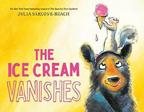
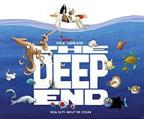
Sheneman, Drew
Harper/HarperCollins (48 pp.)
$19.99 | July 11, 2023
9780063224551
An editorial cartoonist’s–eye view of deep-sea mysteries and denizens.
Avast, there! When light-hued Brownbeard the pirate proves clueless about what glittering “treasure” lies at the bottom of the sea (“Awk! What’s a doubloon?” asks feathered first mate Alan. “I have no idea. Maybe a pastry?”), a dark-skinned scientist in a lab coat pops up on his ship’s plank to set him straight. Starting with ancient divers bringing up food (“This looks like a booger,” says a Chinese diver, peering into a clamshell) and sponges, the scientist proceeds to introduce oceanic denizens from sea pigs and giant squid to snailfish and life around thermal vents, with nods to exploratory ventures of the past giving way to modern uses of sonar and submersibles for research. The book ends with warnings about the dangers of climate change and overfishing (an image of a polar bear atop a tiny melting piece of ice drives home the issue), which leave
the captain tearful and lead into a closing spread of random ocean facts highlighted (if that’s the word) by a portrait of a blue whale posed for scale next to a barely visible banana. The art throughout is similarly finished and playful. (This book was reviewed digitally.)
An easily digestible course of “real facts.” (Informational picture book. 68)
SHAKTI
Sindu, SJ
Illus. by Nabi H. Ali
HarperAlley (256 pp.)
$24.99 | $15.99 paper | May 23, 2023
9780063090132
9780063090118 paper
Middle schooler Shakti discovers her powers.

Shakti has two moms: Pregnant Mom, who reads Black, is a microbiology Ph.D. student; Amma, Shakti’s biological mother, is a programmer and a witch from a line of Indian women closely connected to the Hindu goddess Durga Ma. Shakti hasn’t learned much magic—last time Amma taught her a spell, she accidentally summoned Kali Ma, goddess of death and destruction. After moving to Amherst, Massachusetts, Shakti quickly befriends Chinese American Xi, another new kid, but there’s a weird energy on campus. Harini, Emily, and Kelly—queen bees known collectively as HEK—misbehave with impunity and seem to have the teachers under their spell. Shakti and Xi bond with other social outcasts, but after discovering HEK performing dangerous spells in the woods, they realize that there’s something more sinister than run-of-the-mill bullying going on, putting the entire town at risk. Amma warns Shakti against trying out the magic in the spell book handed down from her ancestors, but, desperate to protect her unborn sibling, Shakti is unable to stand by—and the consequences are more than she bargained for. Ali’s luminous, expressive, jewel-toned illustrations steal the show, highlighting the broadly diverse cast and supernatural happenings. Readers will have to suspend disbelief over wild violets and fiddleheads in the New England autumn, but Sindu’s protagonist lives up to the meaning of her name, “energy of the universe,” as she learns lessons about anger, balance, courage, and compassion.
Powerful and enthralling. (land acknowledgment) (Graphic fantasy. 1013)
Smiley, Jess Smart
First Second (240 pp.)
$12.99 paper | June 20, 2023
9781250889645
Series: What Happens Next?, 2
Megan and classmate Charlotte have entered a project in the middle school science fair—but will it all go smoothly?

Megan just experienced a school talent show in all its various wonders and horrors in the series opener, What Happens Next?: Talent Show Troubles (2023). Now readers get to make choices to guide her through Sunbright Middle School’s science and invention fair. The opening premise seems straightforward enough, but vice principal Mr. Fisher is looking for Megan, and readers need to decide: Should she stay and see what he wants or hide and try to meet Charlotte at their table? The adventures and mishaps begin. Using the choose-your-own-adventure format, readers can repeat opening steps, then make different choices to see how it affects the outcome. The book offers over 100 paths, but there are around 25 distinct endings, so they can end up with the same outcome via different routes. The different scenarios include experiencing an exciting crush, being suspended from school, enduring an attack by gulls, and having an alien encounter. Panels of art in vibrant colors and varied fonts exaggerate the action, sustaining readers’ interest. An appendix offers instructions for drawing a couple of the characters. Most main characters read White; one classmate has brown skin and black “springy hair.”
Zany and true to middle schoolers’ emotional experiences. (Graphic fiction. 812)

Smith, Heather
Illus. by Byron Eggenschwiler
Orca (32 pp.)
$21.95 | March 14, 2023
9781459833913
A neighbor feels down. There are four apartments in the big house. Narrator Frida Bellows and their father live in the bottom left one. Ben Doldrums, a single university student, lives above them. Each morning, the Bellowses’ parrot wakes them. They tap on their ceiling to wake Ben, who gets up to rap on the wall to the family next door; they in turn knock on their floor to wake the two women in the final apartment. They are all part of “something big.” One day, Frida doesn’t hear Ben’s footsteps, so after waking the neighbors, the child checks on Ben, who’s still lying in bed, not knowing exactly how he feels. The tenants each try to cheer Ben up in their own way, but nothing works. Finally, Frida gives Ben an old broom handle so he can tap on the wall without getting out of
bed, if he needs to. The system works. Smith creates a microcosmic metaphor for supporting someone with depression. It doesn’t matter why Ben is feeling down; what’s important is that he receives support so that he can then perform his regular duties with slight modifications. It’s a very social-focused lens. Eggenschwiler’s clean, smooth illustrations play with perspectives and with the cross sections of the apartment building. The Bellowses and Ben are light-skinned; the other neighbors are racially diverse. (This book was reviewed digitally.)
A sensitive and socially conscious take on mental health. (Picture book. 58)

Smith, Jennifer N.R.
Thames & Hudson (40 pp.)
$24.95 | June 13, 2023
9780500653203
Teeming swirls of earthly flora and fauna shine and shimmer with unearthly light in this atmospheric, oversize overview of our bioluminescent world.
Without using phosphorescent inks, Smith still gives her translucent but accurately rendered bioforms, set against deep black backgrounds, an intense, even eerie glow while offering lively introductions to fireflies gathering in a “bioluminescent flash mob,” sea creatures seeking or becoming “Dinner in the Deep,” and “Fungal Fairy Lights.” That’s just the beginning, though, as she also tallies animals from platypuses to people that shine in wavelengths visible or otherwise, tracks discoveries about the phenomenon made by racially diverse researchers (portrayed, with other human figures in the art, in the same lambent hues), describes the ways it is produced, including the variety of chemical reactions that light up not just body parts of, for instance, lanternsharks and ghost mushrooms, but also the defensive slime of sea fireflies and vampire squid, and presents circumstantial evidence of natural glimmer found everywhere from fossils to folktales. Readers dazzled by Julia Kuo’s outstanding Luminous (2022) will be irresistibly lured to this for its breadth of coverage and even more beautiful art.
Lights up its topic both visually and textually. (map, glossary, index) (Informational picture book. 710)

Snyder, Laurel
Walden Pond Press/HarperCollins
(304 pp.)
$19.99 | May 16, 2023
9780062836656
A 13-year-old witch just wants things to stay the way they are, so who needs a bat mitzvah?
Zippy—Zipporah Chava McConnell— doesn’t feel very Jewish. Her parents take her to synagogue for the High Holidays and halfheartedly follow Passover, but mostly they’re just an everyday, White, American family living in Atlanta. What’s special about Zippy is that she’s a witch. She collects items that make her feel witchy: black candles, birds’ eggs, a blue penny. She makes up spells, mantras that settle her anxiety or vanish pimples. Maybe Judaism itself is a little witchy, too. Sure, Zippy’s bat mitzvah parsha—the Torah reading she will recite—says “Thou shalt not tolerate a sorceress to live,” but even so, the Hebrew letters feel so…magical. And has Zippy somehow summoned a Jewish angel? Or maybe a dybbuk? How has she learned Hebrew overnight, and why does she suddenly know how to play the piano? Zippy dips her toe into the Jewish esoteric, finding parts that seem comfortably familiar to her homegrown occult witchcraft. But the creature Zippy has summoned is hurting her. Zippy’s awkwardness, from her fights with her best friend to the way she dabbles in both Judaism and witchcraft, is painfully, believably genuine. And as the rabbi teaches her, her struggles with Judaism and her attempts to make it fit into her witchiness are exemplars of Jewish learning.
Authentically uncomfortable, a well-done modern attempt to explore self and community. (Fantasy. 912)
Soria, Gabe
Illus. by Vincent Batignole & Rafa Ribs
Colors by Warren Wucinich
Andrews McMeel Publishing (160 pp.)
$12.99 paper | March 28, 2023
9781524878689
Series: Bright Family, 2
The Bright family ventures through portals and visits other planets, learning important lessons along the way.

Readers are dropped immediately into the action as Banira Suzuki-Bright and Benjamin Bright and their kids, Nia and Jayden Bright, wrap up “a simple containment and closure operation.” Thanks to their help, sea serpents that had been wreaking havoc on a resort on the Moon of Grabar are now back on their own side of the portal. A grateful resort manager offers the family a free vacation, which ends up becoming an opportunity for Benjamin to repair his rocky relationship with his dad, Grandpa Winston. Another episode sees Banira taking the kids
with her to the Transdimensional and Intergalactic Science and Goodwill Summit. Nia and Jayden befriend the kids of two rival aliens and avert conflict by demonstrating that “it’s a lot easier to get along than it is to hold a grudge.” In an additional short story, “One Birthday in Time,” Benjamin goes back in time to remind himself to pick up Jayden’s birthday cake. With superbright colors and no more than five panels per page, the action is absorbing and simple to follow, and both alien and human characters are unique and easy to identify. Dad, Grandpa Winston, and the kids present Black, Banira is cued Japanese.
Out-of-this-world fun. (Graphic science fiction. 812)
Soto, Gary
Clarion/HarperCollins (240 pp.)
$18.99 | June 13, 2023 9780063267787
A boy dreams of love and basketball stardom following public embarrassment. After missing a shot and costing his basketball team a chance at the championship—a humiliation witnessed by his crush, Sierra Mendez—13-year-old Jordan Mendoza is sitting by the canal, nursing his injured ego, when he spots a puppy struggling in the water. Jordan saves the puppy and later, guided by a dream, finds a second one. When Coach emails with news that their team will compete in the playoffs after all, Jordan anticipates his possible redemption. In fact, after he scores the winning basket, Sierra invites him to volunteer cleaning up litter with her the next day. That night, another dream sends Jordan back to the canal, where he finds a partially submerged car, a discovery that leads to yet another puppy in need of rescue. But just before his meeting with Sierra, the police, investigating the car and the drug-related crimes linked to it, arrive and bring Jordan in for questioning. The investigation, Jordan’s relationship with Sierra, and the championship game intertwine in a headlong rush toward a satisfying, bittersweet ending. Employing a close-third-person narration centered on Jordan, Soto skirts thorny social issues, which are only ever hinted at through the parents’ reactions. Lighthearted storytelling punctuated with humor makes this novel an enjoyable read. Most characters appear to be Latine.
A feel-good novel about a boy’s first love. (Fiction. 1013)

“Out-of-this-world fun.” family vacation
why did the monster cross the road?
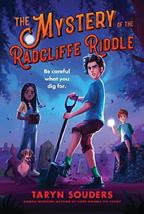
Souders, Taryn
Sourcebooks Young Readers (288 pp.)

$15.99 | July 11, 2023
9781728275468
A boy inherits a needlework sampler that is also a treasure map, leading to opportunity—and danger. Grady, a White middle schooler, is grieving the tragic loss of his mother and struggling to connect with his father. To make matters worse, his family’s trailer in fictional Gifton, Georgia, is facing foreclosure. When eccentric local Eudora “Kooky” Klinch passes away, it is revealed that Grady is her next of kin. He inherits from her a cross-stitch sampler and a note suggesting that it leads to fortune (her house and the rest of her possessions are, frustratingly for Grady, left to a cat rescue organization). Motivated by his stressful financial situation, Grady works with best friends Thad (a White redhead who uses the names of architects as swear words) and Clemmie (a confident Black girl who is an emotionally intelligent leader) to solve the puzzle. The subsequent events are well paced and cleverly delineated—especially when it comes to exploring multilayered linguistic clues. The characterization and setting, however, are less successful. The small-town drama and antics of the large cast are humorous but verge on caricature, and the fictionalized setting muddies attempted investigation into Georgia’s complex history. The dialogue—especially between the kids—is lighthearted and feels genuine but unfortunately includes frequent usage of terms like dumb and stupid. Themes of family and hope are directly and carefully addressed in this gripping narrative. An entertaining, riddle-focused mystery. (historical note, further reading) (Mystery. 812)
Stine, R.L.
Illus. by Marc Brown
Orchard/Scholastic (40 pp.)
$18.99 | July 4, 2023
978-1-338-81525-2
The creators of Goosebumps and Arthur team up for a monster of a joke book.
Two monster friends, one big, one little, perch on a tree branch. Funny decides to improve glum Hunny’s mood with some irresistible jokes. Hunny remains unimpressed and resolutely grumpy, but Funny increasingly ups the ante, assuring Hunny more and more firmly that the best gags are yet to come. Funny tells a dozen jokes in total. Some are incoherent, while others are mildly amusing; all but one feature monsters, many involving monstrous appetites: “What’s the monster’s favorite school lunch?” “The teacher!” Funny believes that each one is hilarious and cracks themself up, but Hunny is unmoved. The
impasse is resolved with one moment of slapstick: Funny jumps up and down on the branch in frustration, then becomes unbalanced, falls off the limb, and lands in the water below with a huge splash. Hunny thinks that the pratfall is hilarious and finally guffaws, good humor restored. Many readers will find the so-bad-they’re-good jokes and the ending satisfyingly absurd. Blocky collage illustrations of varied textures and cheerful colors, set against a flat background, carry readers through the text; the monsters are toothy, but most are reasonably friendly looking. Touches of red provide accents. Large text and mostly simple words will appeal to beginning readers. (This book was reviewed digitally.)
Comic fun for those who appreciate farce—or monsters. (Picture book. 59)

Carrie
Stirling, Jasmine A.
Illus. by Udayana Lugo
Union Square Kids (48 pp.)
$19.99 | July 11, 2023
9781454934578
Series: People Who Shaped Our World
Dare to ask questions; dare to demand answers.
As a child, Carrie Chapman Catt (1859-1947) questioned why women couldn’t vote. She became a tireless fighter in the battle for women’s suffrage and marched, made speeches, and traveled around the United States to promote the cause. Eventually, she questioned the movement itself because Black and working-class White women were excluded. Carrie also asked why strategies to attract women to the movement couldn’t be more creative. In New York, she and her romantic partner Mary Garrett Hay galvanized women into bold, exciting action. The First World War proved the turning point: The men of New York state—who voted in favor of women’s suffrage in 1917, after acknowledging they’d filled male jobs when men went to war— and President Woodrow Wilson took note. In 1919, Congress passed the 19th Amendment, granting voting rights to all American women (though the book doesn’t specifically note that many Black women were still deprived of that right for decades, backmatter states that the right to vote “was, and still is, often denied to many U.S. citizens”). This concise, insightful account allows readers to focus on the salient points of Catt’s work and should inspire them to follow suit and support causes they are passionate about. Energetic, humorous visuals are enhanced by varied fonts and playful text placements. (This book was reviewed digitally.)
A captivating, respectful portrait of a dynamic American woman who made history. (author’s note, about Carrie Chapman Catt, photo) (Informational picture book. 69)
“Comic

Stuart, Scott Scholastic (40 pp.)
$7.99 paper | July 18, 2023
9781338875829
A pretentious professorial goose tries to school a younger goose on animal plurals.
English collective nouns for animal groups are notoriously irregular. When monocle-wearing, bow-tied Bruce pompously instructs, “Two goose is geese,” boisterous young Bill responds, “And two goose is geese!” (But as Bruce realizes, two moose are not meese.) Bill always looks elated, while Bruce appears harried. Seeing leaf-bearing ants in single file, Bill guesses logically they’re a herd—but no, they are a colony. As Bill sinks headfirst into a huge anthill, only the goose’s lower half showing, Bruce exclaims in exasperation, “I can’t take you seriously if you will not wear pants!” Sheep multiply over four pages, but one or many, they remain sheep. A group of bats is a cauldron; multiple giraffes are a tower. After readers learn about plural monkeys, fish, penguins, and pigs, teacher and pupil face a skulk of playful foxes and their stolen “socks-es.” Suddenly, one fox contemplates Bruce not as a source of knowledge but as dinner—but it’s Bill to the rescue! Stuart wrings humor from the absurdity of grammar rules and from the interactions between the two geese. The animals are depicted in cartoon style, with expressive eyes and jointless bodies, Bruce with a flat head and geometric neck. The pages have bright, flat-hued backgrounds, and the cavorting animals are given close to their natural coloration. (This book was reviewed digitally.)
An amusing way to learn some collective nouns and enjoy the underdog’s triumph. (Picture book. 36)
Sutanto, Jesse Q. Feiwel & Friends (288 pp.)
$17.99 | June 27, 2023
9781250794369
Can young Theo Tan and his friends infiltrate hell and save his brother, Jamie?
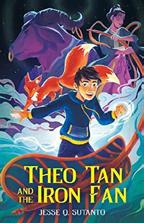
In this follow-up to Theo Tan and the Fox Spirit (2022), Theo and Kai, his newly minted spirit companion, seek a way to retrieve Theo’s brother’s soul; Jamie was also Kai’s original human master. Their quest takes them away from San Francisco on a dangerous adventure into Diyu, or “hell’s waiting room,” according to Chinese mythology, with the desperate—and very likely naïve—hope that Jamie can be brought back to life. Getting to Diyu is one difficult task, and getting out of there is even more complicated. They’ll have to navigate the dangerous courts of Diyu and the kings who rule them as well as formidable Princess Iron Fan. It’ll take lots of ingenuity and teamwork to pull it off without ending up permanently stuck in Diyu. Sutanto builds an intriguing fantasy
world of spirits, spells, and mythologies. With dual narration from the first-person perspectives of Chinese American Theo and his shape-shifting fox spirit, Kai, the book takes readers on a well-paced journey that explores themes of identity, courage, connection, and especially grief and life after loss. Some comedic levity in the precarious situations the characters find themselves in balances the emotional themes. Kai is especially expressive, and her chapters frequently feature footnotes highlighting her feistiness and snark. A supportive friend group in Namita Singh, Danny Chang, and Xiaohua, Danny’s divine dragon companion, bring additional heart.
An animated adventure centering family and friendships. (Fantasy. 812)
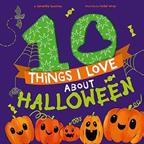
Sweeney, Samantha
Illus. by Jordan Wray
Tiger Tales (24 pp.)
$10.99 | July 4, 2023
9781680102949
Counting up from one to 10, a child joyously lists their favorite things about Halloween.
A small child jumps excitedly on a chair to watch Dad at the sewing machine, happily helping to make a “spooktacular” vampire costume. “Making my costume” is No. 1, and the narrator’s light-skinned little sister, dressed as a pumpkin, cheerfully applauds the “terrifically terrifying” look. Riding on a tractordrawn trailer to go pumpkin picking with both parents is No. 2, while carving the gourd is third. No. 4 is decorating a haunted house, while No. 5 is a “mummy race,” with kids wrapped in toilet paper. No. 6 is getting the house decked out for Halloween. For No. 7, telling spooky stories, the siblings are joined by a friend inside a blanket tent. The counting draws to a close with apple bobbing and dangling doughnuts; a Halloween parade; and, of course, trick-or-treating. And the sadness of day’s end is dispelled by the reassurance of more fun next year. This upbeat tale leans heavily on the sweet rather than the scary side of Halloween, Lively, colorful, slightly simplified illustrations with changing background color washes offer many details for young viewers to spot, including lots of lights and the family’s black cat. The main character and their family are light-skinned; the supporting cast is diverse. (This book was reviewed digitally.)
Downplaying fright, this book is a fine introduction to the holiday for smaller participants. (Picture book. 37)
Thomson, Pari
Illus. by
Elisa Paganelli& Alan
BakerFarrar, Straus and Giroux (384 pp.)
$17.99 | June 6, 2023
9780374391379
Series: Greenwild, 1
A hidden door in Kew Gardens leads a child to life-changing truths about herself and her family.
Having spent most of her life traveling around the world with Leila, her intrepid eco-journalist mother, 11-year-old Daisy Thistledown has acquired useful skills, from shoplifting to slingshot expertise, but not magic—or so she thinks. In the wake of her mother’s sudden disappearance in the Amazon, Daisy enters Mallowmarsh, one of a set of pocket universes called the Greenwild where magical flora and the Botanists who preserve and study them shelter from the hostile Grayside, as they call our world. Met with both welcome and suspicion, Daisy quickly fits in without losing her determination to return to the Grayside to search for Leila and goes on to play a pivotal role in saving Mallowmarsh from mysterious eco-cidal villains dubbed Grim Reapers. The author tucks in a standard-issue magical school for Daisy to attend, though largely just as a setting for occasional class encounters with viciously feral plants, and kits her out with a lively supporting cast complete with a ghost, several previously unknown relatives, and (in the role of Draco Malfoy) bully “Poison” Ivy Helix to sneer at her supposed lack of magic and deride her for being an “unlawful immigrant.” Daisy’s mother is Persian, and her deceased English father is cued White. Finely detailed illustrations by Paganelli join Baker’s equally exact botanical ones.
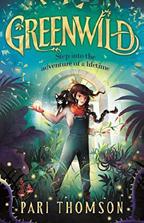
Another magic school story, albeit expertly wrought and worth planting on shelves for its cogent themes. (map) (Fantasy. 913)
Tracy, Kristen
Chronicle Books (336 pp.)
$16.99 | July 25, 2023
978-1-79721-506-8
A fifth grader and her cat magically swap bodies.
After a particularly embarrassing day at middle school when she was laughed at and her friends didn’t stand up for her, Poppy McBean is sharing all her problems with the best listener she knows: her cat, Mitten Man. When she wishes she had his awesome, easy life, she suddenly magically transforms into Mitten Man’s feline self! Even more surprising, Mitten Man now inhabits Poppy’s body (and is from then on referred to as “Big Poppy”), and the two can communicate telepathically but only when looking at each other.
Through alternating first-person narratives, readers follow girl and cat as they embark on strange new adventures and learn about each other, themselves, and what it means to be a good friend. There’s a slow start, but once the characters are a bit more settled in their new bodies, the pace picks up. Big Poppy is not great at thinking about others and makes many cringeworthy decisions. As “Old Poppy” (human girl Poppy in cat form) helplessly watches her friendships ruined, she winds up on a dangerous rescue mission involving a stray cat and a turtle that amps up the drama. There is plenty of humor throughout, but it’s the realistically imperfect friendships that give the book depth and heart. Poppy is assumed White; names imply some ethnic diversity among her friends.
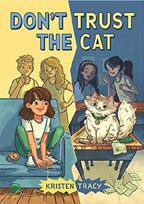
Funny fare realistically exploring feelings. (Fiction. 912)
Trejo, Jesús
Illus. by Eliza Kinkz
Minerva (48 pp.)
$18.99 | June 6, 2023
9781662651045
Is little Jesús prepared for the awesome responsibility of managing Papá’s magical water-jug clock?
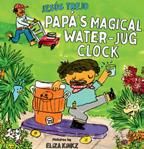
Hooray, it’s Saturday! Jesús can help his gardener father with the family business. Jesús is tasked with taking care of the water jug, which, according to Papá, is “also a magical clock. It tells us how much work is left to do!” Jesús gets ready as Mamá reminds them “to drink lots of agua.” Piling into their trusty van with its supplies and intoxicating smell of gasoline, oil, and “yesterday’s cut grass,” Jesús and Papá head out. First stop: the Saldañas’ house, where Jesús gives water to some thirsty old cats, Papá, and himself (and splashes some water on his face) while Papá tends to the lawn. At Juan-Diego’s super big house with its tiny dog, Jesús hands out lots of water to everyone (plus two face splashes) to ward off the heat. By Stop Número Tres, the magical water-jug clock is out of water. Time to go home? But there are still 11 more houses to go. Oh no! Where did Jesús go wrong? A marvelous portrait of a working-class Latine family, Trejo’s picture-book debut, inspired by his own childhood experiences, brims with humorous, childlike observations. Anchored by its pint-sized mischief-maker, this tale of a loving father-son relationship radiates pure warmth. Kinkz’s scrappy watercolorblended artwork bursts with bright colors and amusing details, matching its tiny hero’s chaotic spirit. Publishes simultaneously in Spanish. (This book was reviewed digitally.)
Gleefully fun. (Picture book. 48)
green birds

Turnbloom, Lucas
Colors by Marc Lapierre & the author Crown (240 pp.)
$13.99 | July 11, 2023
9780593301470
Series: Steve L. McEvil, 2
Identity issues continue to haunt the 11-year-old scion of a long line of supervillains.
Caught between the pressures of McEvil family tradition and the good influences of book-smart Sierra Flores and superhero dude Vic Turry, bad-guy–wannabe Steve, he of the ferocious scowl, opaque goggles, and outsized red quiff, sees a trip to the nation’s capital as an opportunity to reestablish his villainous cred by breaking into a secret vault beneath the Washington Monument. Unfortunately, not even judicious use of his smartwatch’s fiendish fart ray proves powerful enough to keep him and his allies from becoming part of someone else’s evil scheme—or to prevent the opening of another wormhole by another minion of interdimensional hypervillain Perses the Destroyer. Is Earth doomed (again)? Or can the destabilized portal at least be closed before it sucks everyone nearby into some random universe? No? Well, maybe Steve’s brilliant and genuinely villainous purple-haired little sister, Eve L. McEvil, can pull off a save? Readers will have to wait to find out, as Turnbloom, the cad, ends this fast-paced and comically melodramatic sequel on a cliffhanger. At least he adds drawing lessons and a featurette starring the inscrutable McEvil house cat (mis) named Mrs. Cuddles.
Less farting but still a gas. (Graphic fantasy. 1013)

Tyng, Taylor
Pixel+Ink (384 pp.)
$17.99 | July 4, 2023
9781645951599
When her science experiment goes awry, Clara receives international attention—and an invitation to join a race that circles the globe.
After her mother’s death, 12-yearold Clara Poole tried to become the “safe version” of herself to please her cautious father. Then, while floating above the ground at the end-of-school-year fair in a plastic lawn chair lifted by hundreds of balloons, Clara has a thought: She could descend to earth—or she could go higher. Cutting her tether, Clara soars away over Michigan. When she lands, Clara is greeted by reporters, grounded by her father, and invited to join the World Organization of Balloon Aeronauts on their 100th air race. Consisting of 10 stages, including an endurance trial over the Sahara and a hunt for flags among the rocky cliffs of
Mount Kailash in Tibet, the race is notoriously dangerous and completely thrilling. Partnered with a seasoned aeronaut and three monkey co-pilots, Clara learns the temperamental art of ballooning while navigating new friendships and scheming competitors. Invented elements, like the use of a flusterboard to travel between balloons, exist alongside references to genuine landmarks, creating a fantastical world that feels wholly possible. Most main characters, including Clara, are assumed White. Aeronaut teams represent their countries; Clara forms notable friendships with the Hoshis from Japan and the Jollys from India.
An engrossing and inventive flight through the skies. (Adventure. 812)
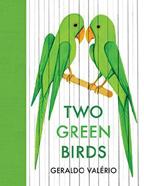
Valério, Geraldo
Groundwood (88 pp.)
$14.99 | May 2, 2023
9781773067957
A child and his grandmother can’t get their two new parakeets to eat until they think outside the cage.
Valério calls on memories of his native Brazil for a set of short chapters enriched with spot and larger images of shimmering birds, feathers, flowers, and foliage. Young Francisco’s initial delight when his Grandma Antonia comes home with a pair of beautiful parakeets—“green as fresh leaves, as green as the inside of an avocado, as green as the skin of a guava not yet ripe”—turns to anxiety when, instead of taking the offered polenta, crackers, collard greens, or even birdseed from the local pet shop, the two birds just huddle fearfully in a corner of their cage as days go by. Why won’t they eat? In the end, Grandma’s observation that parakeets “are birds that cannot live alone” hints at the reason…and seeing their excited reaction when a whole flock of wild parakeets lands in a nearby guava tree, Francisco soon realizes what he has to do. Along with capturing a sense of comfortable intimacy in recording visits and exchanges with his grandmother, Francisco’s account is infused with sensory pleasures, from seeing a neighbor’s lush garden to watching polenta being made to sharing a delicious meal of rice and beans. Both the boy and his grandma have lightly tanned skin in the illustrations.
A deeply felt episode exploring themes of family ties and empathy for wild creatures. (Fiction. 79)
“A deeply felt episode exploring themes of family ties and empathy for wild creatures.”
two
Völker, Sven Cicada Books (32 pp.)
$16.99 | July 4, 2023
9781800660373
A bear and a butterfly embark on a transformational journey.
In A Million Dots (2019), German graphic designer Völker explored exponential growth. Here, he presents visual and verbal contrasts for viewers to ponder. Bear is an immense, solid black form, whereas Butterfly is a slight, airy creature with green, blue, and yellow gossamer wings. Butterfly invites Bear to accompany her on a trip. Bear is initially attuned to practical matters—food, rest, and destination. The philosophical, Yoda-esque insect explains, “The journey itself is the reward.”
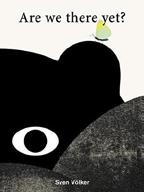
Compositions incorporate a pleasing balance of flat colors and stylized images (trees shaped like pyramids, falling leaves as ovals) and textured objects (a tan cave speckled with black dots). As the conversation continues, Bear finds a rhythm as he climbs the mountain, enjoys the magnificent view, and summons the courage to swim across a rushing river. Butterfly’s patience and encouragement and Bear’s playfulness contribute much to the expedition’s quality, their mutual vulnerability allowing them to connect and care for one another. One enjoyable spread depicts Bear snacking on berries while Butterfly sips nectar from some flowers. She remarks, “And then you’ll poo out the seeds and more flowers will grow. We’re part of a great big circle.” Observant children will notice the rounded sun behind them, the moon on the next page, and their return to their point of origin.
(This book was reviewed digitally.)
A sensitive script, touches of humor, and a captivating design combine for an excursion readers will want to repeat.
(Picture book. 48)

Vrabel, Beth Atheneum (256 pp.)
$17.99 | June 13, 2023
9781665918626
As they experience growing pains and family problems, loner middle school students in small-town Utah unknowingly support one another on unexpected journeys of self-discovery.
Eleven-year-old Gerty is proud. She knows exactly what she wants and has the grit to get it. She seeks refuge from her survivalist parents in her grandmother Nanny Pat’s barn, where she secretly builds an ultralight and dreams of one day being in the Civil Air Patrol. Gerty shares lunches in the school counselor’s office twice a week with fellow new student Hayes; both of them need support with social skills. While he struggles with rebuilding a relationship with his ex-con mother and suffers from severe self-doubt, Hayes has a
strong inner fire that is one spark from igniting. When turmoil ensues in each of their home lives, Gerty and Hayes seek one another’s company. Vibrant depictions of the characters’ experiences paired with witty dialogue immerse readers in the main characters’ lives. Their heart-wrenching backstories and realistic experiences evoke a deep level of empathy. With chapters purposely shifting from character to character, readers slowly but satisfyingly become part of their lives and friendship and cannot help but root for them until the very end. Main characters are cued White; the school counselor is coded Black.
A heartwarming read with a powerful message: The lonely and jaded can heal with the love of an empathetic friend. (Fiction. 812)
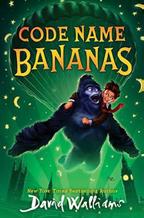
Walliams, David
Harper/HarperCollins (384 pp.)
$17.99 | July 11, 2023
978-0-06-284015-8
Some plans are bananas from beginning to end.
Eleven-year-old Eric Grout is a victim of the times, having lost both his parents to World War II—his father at Dunkirk and his mother when the factory where she worked sewing parachutes was bombed. He’s left with two relatives: his nearly deaf paternal Granny, with whom he goes to live, and Uncle Sid, his maternal great-uncle, who is a zookeeper at London Zoo. Eric takes joy in assisting Uncle Sid, and his favorite animal is by far Gertrude, the old gorilla who has a knack for mimicking Eric’s gestures, often to the delight of the wartime crowds. When, during the Blitz, tragedy strikes again, Eric and Uncle Sid are left trying to save Gertrude from being euthanized by overzealous zoo director Sir Frederick Frown and his horrendous henchmen. Television personality Walliams isn’t afraid to throw everything and the kitchen sink at readers, so be prepared for terrifying Teutonic twins, grand escapes, tea with royals, and a lot of smelly body humor. Fans of Walliams’ previous outings will find themselves on similar ground here, and new readers, especially those who love toilet humor, will happily go along with the madcap zaniness. Sticklers will point out one or two inconsistencies along the way, such as a disregard for wartime rationing, but logic and kooky camp rarely coexist. All characters read White.
Readers will go ape. (historical notes) (Adventure. 812)
“A heartwarming read with a powerful message: The lonely and jaded can heal with the love of an empathetic friend.”
when giants burn
Wang, Jialin
Illus. by Ziying Jiang Clavis (32pp.)
$18.95 | July 4, 2023
9781605377742
Even a life filled with wild adventures, a cozy home, and plenty of food isn’t enough when there’s no one to share them with.
In need of a friend, Cat goes out and buys one—a fish in a bowl. But Fish hides in terror every time the bewhiskered face looms outside her world. Cat laughingly assuages Fish’s fears— he’s not going to eat her; he just wants a pal. Life is grand after that, and every day Cat tells Fish about his wonderful exploits… until he notices that Fish is wasting away. It turns out that living vicariously through Cat is not enough for poor Fish, who misses her family. He knows he’s going to miss her terribly, but Cat works out a way to get Fish back home again. Neither wants to lose their friendship, but they say goodbye and wish each other well. Later, Cat joyfully realizes he can still play with Fish in his dreams. Wang’s sweet story of an unlikely friendship touches on the importance of being sensitive to each other’s needs. Jiang’s detailed illustrations in soft pastels capture Cat and Fish’s life together. From Cat’s winsome home, which resembles a giant loaf of bread with a door shaped like a fish, to the welcoming tropical landscape, the perfect setting for a nearly perfect friendship shines through. (This book was reviewed digitally.)
A gentle reminder that true friendship means putting others first. (Picture book. 48)
$19.99 | July 11, 2023
9781913074142
An orangutan family finds safety in a new home.
In her debut picture book, Ward offers young readers and listeners a simple, gentle example of the loss of jungle habitat in Sumatra and the efforts of humans to relocate the orangutans that had been living there. The story is generic, but the rescued animals at Bukit Tigapuluh National Park (Thirty Hills) are real and apparently thriving. Her account begins with a lyrical description of family life in their “emerald green forest,” which is unhappily interrupted by noise and smoke. The orangutan mother moves her family only for their lives to be disrupted again when a machine knocks down their tree. This is a scary moment, but, reassuringly, a friendly human (portrayed as Asian) leads them away. They’re rehomed in a new forest where other orangutans live and forage. There’s repetition, both in the description of approaching devastation and in the family’s activities: eating fruit, tree swinging, and building

sleeping nests—salient facts about orangutan habits. The tale is enlivened by Littlewood’s colorful illustrations, which convey a remarkable sense of the lush jungle world. Full of motion, the preliminary orangutan sketches on the endpapers and in the backmatter are a nice touch. The jungle animals are portrayed realistically. The orangutan faces are very expressive, conveying sadness and terror as the machine destroys their home and, at the end, joy. (This book was reviewed digitally.)
An uplifting story of animal rescue. (facts behind the story) (Informational picture book. 37)

Wells, Rosemary
Little Simon/Simon & Schuster (32 pp.)
$18.99 | June 27, 2023
9781665924894
A new kindergartener’s worries about starting school bleed over into his parents’ minds, too.
Despite his mother and father’s enthusiastic assurances that he’ll make new friends and learn new things on his first day of kindergarten, Milo (an anthropomorphic kitten rendered in Wells’ soft and expressive signature style) is anxious about starting school. On the night before kindergarten, he has a series of nightmares about things that could go wrong. He wakes up in the middle of the night and tells Mama and Daddy all about the dreams, eventually going back to sleep while snuggled between them in their bed. The next day, Milo successfully makes the transition to school, where he even helps his teacher, Miss B, soothe other kittens who miss their parents. As for Milo’s parents, his dreams take root in their consciousness, making them fret about him as he goes about his day away from them. They needn’t have worried, though, because Milo has a great time doing various activities, and he even brings Heather, a new friend, home on the bus with him. The story winds up feeling a bit disjointed, however, since we never see Milo reunite with his parents at book’s end to put their minds at ease and share about his day; instead, the tale concludes with Milo and Heather eating pizza. (This book was reviewed digitally.)

Sweet but incomplete. (Picture book. 46)

Whaite, Michael Random House (32 pp.)
$18.99 | June 6, 2023
9780593648599
Diggersaurs meet their cosmic counterparts.
Whaite once again combines machine and beast. However, this time, instead of construction trucks, it is Martian rovers who take center stage as readers meet the Roversaurs. Their
spindly appendages and agile frames lend themselves nicely to the dinosaur mashup. These Roversaurs have research to conduct. They test soil, take photos, and map the topography of the landscape. They are also looking for the perfect spot to build a special project. They have a “Constructorsaurus” who works late into the night, but when the hologram blueprint is projected, the team quickly realizes they need some help. Diggersaurs to the rescue! The Diggersaurs squad comes flying in on a spaceship, and the two groups merge. While the dino-vehicles may be fantastical, details like the dusty red atmosphere and solar-powered machines are all gateways to further nonfiction exploration. Two astronauts, one with dark skin and one with light (both of whom offer amusing asides), and one tiny alien can be found on each spread. With jaunty rhymes and surefire kid appeal, this one will make any storytime blast off in excitement. (This book was reviewed digitally.)
Will have truck enthusiasts making the leap to astronomy. (Picture book. 36)
BOY DAD Williams, Sean Illus. by Jay Davis
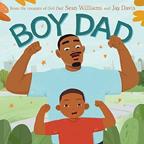
Harper/HarperCollins (40 pp.)
$18.99 | May 16, 2023
9780063113640
Following up Girl Dad (2022), Williams and Davis present an affectionate tribute to the bond between fathers and sons.
As Williams describes how “boy dads” love and support their sons, images show Black fathers and sons fishing, watching movies, flying kites, playing football, and more. Davis’ illustrations are full of color and movement. The rhyming text has a cadence that matches the upbeat visuals and will appeal to emerging readers. While some moments hew closely to traditional ideas of masculinity and chivalry (the verse “It’s no easy task teaching a boy just how to be a man. / But boy dads raise fine gentlemen the very best they can” accompanies an image of a boy holding out a chair for a female-presenting child), the book also challenges stereotypes. In one scene, a boy and his father, clad in aprons, whip up a tasty concoction in the kitchen. In another, a father comforts his son, who’s teary-eyed after spilling a dish of mac and cheese: “Boy dad knows to be brave and strong / means sometimes you have to cry.” The love between fathers and sons shines through on each page; many men and boys of color will especially appreciate seeing their experiences reflected here. (This book was reviewed digitally.)
Heartening examples of paternal love. (Picture book. 48)
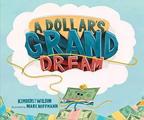
Wilson, Kimberly Illus. by Mark Hoffmann
Page Street (32 pp.)
$18.99 | July 11, 2023
9781645677116
A dollar goes a long way to find his purpose.
Big Bill is a cowboy-themed dollar bill, complete with hat and lasso, in a world of anthropomorphized currency (picture googly eyes on all those green and metal faces). Tales from Hundred about the luxurious lives of larger bills cause Bill to toss Penny into a fountain and wish to become a larger bill. After becoming a $10,000 bill, our hero gets a tour of the lavish life from Thousand, who tells him that “Rare bills stay in the shade—we can’t afford to fade.” Bill realizes he would rather be a useful bill in circulation than a guarded asset, and he escapes. This book is an effective conversation piece, especially for its many portrayals of how money is handled, including being printed, put in a cash register or purse, flipped into fountains, and transported in trucks. Sans-serif text changes between black and white for maximum contrast, while large, blue sound effects punctuate the action. Punny dialogue imparts monetary terms and idioms (“My two cents—you’re top dollar!”). Backmatter includes notes about the history of U.S. currency, graphics showing the digit places in 10,000 and how $10,000 divides into different denominations, and a bibliography. (This book was reviewed digitally.)
An amusing primer on forms and uses of money. (Informational picture book. 48)

Kaz
Paula Wiseman/Simon & Schuster (48 pp.)
$18.99 | June 6, 2023
9781665905053
A young bat who does things a little differently from her classmates figures out a way to thrive.
At school, Bitsy Bat hangs from a chair by her toes instead of sitting, uses her feet rather than her fingers to paint, and brings an ant for her snack. Between the “too-bright light,” the “tooloud words,” and a chorus of “Wrong!” from Winnie the rabbit, Bitsy melts down. But with some support from her parents and teacher, Bitsy has a great idea—some accommodations help her feel comfortable enough to learn, and a classroom activity helps her and her classmates see how she, and each of them, is special. The story is highly relatable to any young reader just getting used to school but is specifically targeted at autistic children. Though the word itself doesn’t appear in the main story, backmatter offers more information about autism, framed in a positive, supportive way. The adorable, lively illustrations bring the point home well. Bitsy is depicted right-side-up at home with
her family, though the world around them is upside-down. At school, she is upside-down but much happier than when she was trying to be right-side-up like the other kids. With a lot to see on every page, children won’t get bored with repeat reads, and they’ll even learn a lesson along the way. (This book was reviewed digitally.)
A darling book for all children but especially those with autism. (author’s note) (Picture book. 48)
Winston, Sherri
Little, Brown (272 pp.)
$16.99 | June 13, 2023
9780316461610
A tween in Jacksonville, Florida, worries about changes in her closest friendship.
Daija and Maggie are best friends, two Black girls with plans to turn their hair-braiding skills into a summer business. Things become complicated with the arrival of Maggie’s new half sister, Callie; Callie’s White mom had kept her existence a secret from Maggie’s dad until just before her death. Maggie’s close-knit family absorbs their new addition, but there’s naturally some tension. Meanwhile, Daija desperately needs Braid Girls to succeed so she can afford private ballet lessons. The girls incorporate their braiding business into their duties as junior counselors at a local day camp and get off to a great start—until girls from another camp set up a rival business and try to steal their clients. This adversity, along with Daija’s worries about money and her place in Maggie’s life, creates a rift, revealing personality differences the friends had ignored. But they eventually realize their different ways of handling things can make them a stronger unit. In addition to the centrality of friendship in the lives of middle schoolers, the family connections are richly portrayed. Daija’s drive to prove herself to her father, now remarried, is always on her mind; Maggie’s need to play peacemaker is perceived as a weakness; and Callie puts on a brave face while mourning her mom. The story is told in the three girls’ alternating voices, and the supporting adult characters add realistic texture.

An enjoyable story with lively and engaging protagonists. (Fiction. 812)
Jenna
Aladdin (352 pp.)
$17.99 | May 30, 2023
9781534487963
Series: Lia Park, 2
A Korean American tween and her friends team up to recover powerful heirlooms before they’re used to destroy the world.
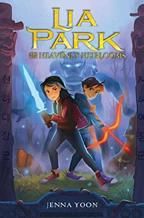
Fresh off her world-saving heroics in Lia Park and the Missing Jewel (2022), expectations are high for 12-year-old Lia’s first year at the International Magic School. She is anxious to prove her abilities as a powerful spell-caster among her new classmates. Instead, it’s Joon, Lia’s best friend, whose talents impress, stirring jealousy, competition, and insecurity between the two. Complicating matters given their growing distance, Lia and Joon are matched with classmates Eugene and Chloe and sent on a dangerous mission. They must retrieve hidden artifacts before the King of Darkness uses them to unleash imprisoned monsters into the world. Along the way, Lia learns that a traitor has been sabotaging their efforts, and she has reason to suspect each of her teammates. Revelations about the double agent and a mysterious prophecy set up the next volume. As in the first installment, Korean words and phrases appear throughout the text, and Korean landmarks act as locales, adding to the sense of place. Strong worldbuilding continues to provide a captivating magical universe inspired by Korean mythology. Grounding the story is the platonic relationship between Lia and Joon, which realistically portrays the tension between establishing your own identity while preserving a close friendship.
Meaningful cultural connections provide a solid foundation for this inventive fantasy adventure. (Fantasy. 912)
Young, Brian
Heartdrum (384 pp.)
$19.99 | May 23, 2023
9780062990433
Before he ages out of seeing Holy Beings, Nathan must find water monster Dew a mentor.
A couple of years after the events of Healer of the Water Monster (2021), Nathan’s life in Phoenix, Arizona, is changing—he and his mother, Janet, are moving in with Janet’s boyfriend and his son, the book’s co-protagonist, Edward. More than that, Nathan’s going through puberty and knows his time with Dew is limited—her new guardian will be Edward. But to ensure that Dew learns the water monster songs, she needs a mentor. Nathan wants it to be powerful water monster Yitoo Bi’aanii, who eagerly returns to the Fourth World. Upon seeing how her
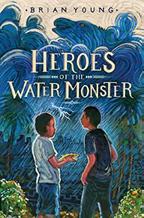
“Thought-provoking and full of heart; a genuinely pleasurable read.” heroes of the water monster
river has dwindled, Yitoo declares that an Enemy is stealing the water. The quest to thwart the Enemy is quickly complicated as the stakes rise and the heroes face conflicting loyalties. The environmentalist narrative embraces nuance and complications, avoiding easy answers without undermining the possibility of a hopeful future. Edward, newly informed of his Diné family’s brutal relocation era story, also struggles with inherited trauma, while Yitoo, who was witness to the violence, carries the atrocities with her. Additionally, Edward grapples with the fact that his late mother was White and with being the only household member who is not fully Diné. The bittersweet ending is as beautiful as the prose describing the fantastical journey to get there.
Thought-provoking and full of heart; a genuinely pleasurable read. (author’s note, glossary, note from Cynthia Leitich Smith) (Fiction. 1014)
Zhao, Moran
Reycraft Books (48 pp.)
$19.95 | March 1, 2023
9781478881797
A Chinese child visits their father at a military base.
The young narrator tells us, “My dad is a soldier.” While the text is not explicit about setting, other than a mention of the Yangtze River, gentle yet vibrant watercolors suggest that the father is a first lieutenant in the People’s Liberation Army. The child misses their father—more than anything, the protagonist wishes he could pick them up from school. The story follows the child and their mother as they travel by rail to a faraway military base for an extended visit spanning three seasons. There are brief references to training and target practice, but the story is primarily concerned with noncombat activities like cooking steamed buns, fighting floods, hiking, and reading letters from home. Zhao confronts the challenges of deployment directly, tempering the child’s joy at reunification with fear of a face made unfamiliar by time apart, worries about the father’s physical safety, and sorrow when the family must part again. In simple prose, this relatable story captures the pain of separation from a parent and will draw in young readers. All characters are Chinese, but a range of skin tones is depicted. (This book was reviewed digitally.)
A bittersweet story about the emotional cost of deployment. (Picture book. 48)
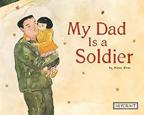

Zommer, Yuval
Thames & Hudson (64 pp.)
$19.95 | June 20, 2023
9780500652930
A collection of inventive yet simple art projects that children can make from natural objects.
Zommer sensibly reassures readers that the objective is not to produce perfect work but “to connect with nature and let your creativity run wild!” All projects have only four steps; rule-breaking and independence are encouraged, but instructions are sometimes vague (“draw a bat”). Although most materials are natural (pine cones, leaves, flower petals), kids will also need some other common supplies like glue and paper plates—and googly eyes are a must. The colors of the finished projects are mostly subtle, with some pops from paint or paper additions. Cutout photos of the creations are posed against neutral or flat habitat backgrounds, giving them a three-dimensional feeling. Bits of scientific information, like the exoskeleton support of insects, supplement the art on each spread. Among other possibilities, readers can make seahorses, owls, turtles, jellyfish, snakes, fish, moths, birds, bats, and more. Finding an image of an ant 15 times in the book adds an element of play. Children are encouraged to glue their creations to paper and then draw an appropriate setting for them or display them in their own museum. The author urges readers to “forage” for “natural treasures” and to use recycled materials. Occasionally, projects require adult help, and scissors are involved in many options. These activities are perfect for summer and, with preparation, could be used in art classes.
Beautiful inspiration for observant amateur artists who love nature. (index) (Activity book. 69)
9781338897463


Annan Jr., Vidal Free Spirit Publishing (140 pp.)
$15.99 paper | July 11, 2023
9798885540001
A lucid, basic introduction to key emotions, their positive and negative effects, and their management.
This brief book’s goal is to enable teens to know their feelings so that they can make informed decisions about their actions; it balances information with some practical strategies. After three introductory chapters addressing the book’s relevance to teens, defining emotions, and explaining how emotional intelligence functions, chapters separately consider love, anger, sadness, anxiety, jealousy and envy, guilt and shame, joy, and well-being. Each emotion is described and analyzed as an experience (broken down into physical, mental, and behavioral components), followed by a section on myths and truths about it, suggestions for living with the emotion, and one mini-exercise to develop emotional awareness. The author, a clinical psychologist, addresses teen readers in a serious, sympathetic, professional tone leavened by short anecdotes, like the case of a boy who was comfortable with strangers but paralyzed around his friends: He hadn’t understood that his behavior stemmed from anxiety. The book’s goal is to provide readers with the words and concepts to identify and understand their emotions. The information is valuable, reassuring, and sometimes thoughtprovoking, but the layout and design make it harder to absorb: Although there is some variation in font and text size and color, there is just one graphic and few bullet-pointed lists to break up the paragraphs; illustrations might also have added to the book’s appeal.
A clear and helpful overview. (index) (Nonfiction. 1318)
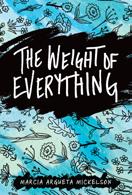

Do you like your accent? What do you think it tells the world about you? What accents do you find most pleasing? Perceptions of how we speak—what is considered prestigious, attractive, trustworthy, authoritative, or friendly (or the opposite of all of the above)—are inextricably intertwined with social status and, therefore, racism, classism, and other forms of prejudice. Himawari House by Harmony Becker, the 2022 winner of the Kirkus Prize for Young Readers’ Literature, powerfully pushes back against anti-Asian racism that often manifests as mockery of Asian accents. Many of Becker’s characters are Asian English language learners whose speech is rendered lovingly, faithfully, and phonetically.
Who you are influences others’ expectations of how and what you speak. Viral videos featuring White people being fawned over for speaking non-European languages feel less heartwarming to the children and grandchildren of immigrants whose nonfluent, foreign-accented speech is often met with ridicule and judgment in their families’ countries of origin. The lack of respect for dialects that arises in diaspora communities is also tied to calcified ideas of language purity and social status.
It’s impossible to speak any language—including the one(s) you grew up with—without an accent. Learning a new language after early childhood makes you especially vulnerable: As you progress, you’ll make mistakes, feel foolish, not be able to express yourself spontaneously or with nuance, and quite possibly have a foreign accent forever. But surely this should be a badge of honor, a sign of your daring and curiosity and not a source of embarrassment?
Sadly, too many books for young readers still use foreign-accented or socalled “broken” English to signal that characters are evil or to make them objects of fun, compounding the shame many children and teens feel over their own speech or that of their parents. This, in turn, has a direct impact on academic achievement, social integration, and emotional well-being. Too many families in English-dominant countries succumb to xenophobic pressures to be monolingual, with resulting language barriers and cultural losses between generations. Fortunately, more YA books are now addressing these critical themes in ways that will resonate widely, cultivate awareness, and shift mindsets.
Visiting relatives abroad, struggling with language competence, and seeking belonging are among the subjects explored in ¡Ay, Mija!: My Bilingual Summer in Mexico by Christine Suggs (Little, Brown, April 4), ¡Viva Lola Espinoza! by Ella Cerón (Kokila, April 11), and The Dos and Donuts of Love by Adiba Jaigirdar (Feiwel & Friends, June 6). Suggs’ graphic novel is based on their own visits to family in Mexico, where they wrestled with Spanish and identity. Lola, the protagonist of Cerón’s novel, is sent to visit grandparents in Mexico after getting a bad grade in Spanish class. Bangladeshi Irish Shireen’s bestie, Fatima, visits Bangladesh, where cousins call her bideshi, or foreigner, for speaking Bengali with an accent. All three works offer heartfelt, nuanced examinations of crosscultural adolescence.




The languages we speak are bound up in history, including colonization, war, and political conflicts, and these complex situations echo through generations. The following works skillfully and sensitively examine the impacts of major world events on contemporary teens: All That It Ever Meant by Blessing Musariri (Norton Young Readers, Jan. 3), She Is a Haunting by Trang Thanh Tran (Bloomsbury, Feb. 28), and The Weight of Everything by Marcia Argueta
Mickelson (Carolrhoda, May 2). In Musariri’s novel, Zimbabwean British teen Mati’s late mother prioritized assimilation, avoiding speaking Shona; language is one facet of cultural divides the family straddles. Tran shows Jade’s pain over her limited Vietnamese when she goes to visit her dad in Vietnam; language struggles represent loss and longing. Mickelson centers Guatemalan and Mexican American Sarah: Following her mom’s death, she starts learning Spanish and uncovers difficult, hidden family stories.
 Laura Simeon is a young readers’ editor.
YOUNG ADULT | Laura Simeon
Laura Simeon is a young readers’ editor.
YOUNG ADULT | Laura Simeon
the king is dead

Bowles, David & Guadalupe García McCall
Bloomsbury (464 pp.)
$19.99 | June 6, 2023
9781547609895
Lovers separated by time fight for their lives.
Calizto and Sitlali are not from the same world: They may come from the same place, but they’re living centuries apart, pursuing completely different lives, and struggling with their own battles. In 1521 in the city of Tenochtitlan, Calizto is fleeing from pursuit by colonizing Spaniards when he throws a sacred shell, a moon conch, into the sea. In 2019, Sitlali is walking along the beach when it washes up at her feet. Sitlali’s father has left, and her mother passed away years ago; now her Abuela Lucía has died too. Forced by gang activity to quit her job and threatened by a young man who wants to force her into marriage, Sitlali decides to cross the border from Mexico to the United States in hopes of finding her father. Although all of Calizto’s family died in the recent plague, he’s accompanied by Ofirin, a Yoruba man formerly enslaved by the Spaniards whom his father rescued. Sitlali and Calizto start to communicate in Nahuatl and Spanish as the conch connects their thoughts. Calizto learns from Sitlali what the future brings, and the two fall in love. Although the premise is interesting and the worldbuilding is solid, the narrative moves slowly, and the characterization makes it difficult to understand why the two main characters connect so deeply with each other, keeping readers from fully investing in the story.
A clever concept not quite fully realized. (historical figures, gods and legendary figures, maps) (Fantasy romance. 1418)
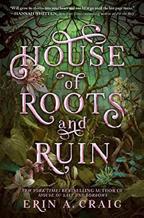
Craig, Erin A. Delacorte (544 pp.)
$19.99 | $22.99 PLB | July 25, 2023
9780593482544
9780593482551 PLB
Series: Sisters of the Salt, 2
In an extravagantly gothic follow-up to House of Salt and Sorrows (2019), Verity, 17, is snared in both a romantic dilemma and a hideous research project.
Prompted by a commission to paint the portrait of 19-yearold Alexander, scion of the refined ducal house of Bloem, Verity defiantly escapes the cloistered life forced on her by overprotective big sister Camille—only to find herself caught up in a web of secrets and lies complicated by the tried-and-true conflict of having to choose between kind, gentle, Alexander, who uses a wheelchair, and a dangerous but excitingly hot rival for her interest. Along with providing a lavishly decorated country house stocked with lush floral gardens, secret passages and stairways, and a hidden library of erotica for a setting, Craig
lavishes her doorstopper with lurid elements, including references to a curse, madness, and feelings of dread; mysterious screams in the night; and encounters with ghostly apparitions. More disturbing still are eventual revelations that Alexander’s seemingly rational botanist father’s research hasn’t entirely been confined to the greenhouse. Overall, the tale well serves both readers who thrill to bloody, onstage murders and visions of body parts in jars as well as those left breathless by watching relationships heat up. Alexander’s mother has brown skin, and his father is White; Verity reads White.
Steamy, suspenseful, and sensuous. (Gothic fantasy. 1418)

Dawson, Delilah S. Disney Press (304 pp.)
$18.99 | July 3, 2023
9781368078917
“In the not very distant past, two magical stars collided, sending reality spiraling in two very different directions.”
While the old tales continue on as normal in the Source Worlds, in the Mirror Worlds, characters from Disney stories exist in heightened forms. The light and dark mirrors created in the stellar collision fell, pitting the forces of good and evil magic against each other. But the dark mirror has broken, and the Fractured Magic that now claws its way out from it threatens to rend the worlds as we know them asunder. Snow White’s peaceful life has been shattered by this magic: Her friends are missing, her evil stepmother is out to kill her, and she needs to put her fairy tale on hold to sort things out. With the help of new friends from new worlds—including Sulley from Monsters, Inc., Mickey Mouse, and Lilo’s companion Stitch—will she be able to stop the spread of Fractured Magic and set her story to rights? Character development takes a back seat to the adventures, battles, and rich visual details in this plot-driven novel. Familiarity with the main characters will do a great deal to endear them to readers, and the cliffhanger ending promises more adventures in the works.
Will appeal to movie buffs seeking light entertainment. (Fantasy. 1214)

Dean, Benjamin Little, Brown (384 pp.)
$18.99 | July 18, 2023
9780316519144
When James’ father dies, it’s only the beginning of the troubles for the teen who would be king.
At 17, the full weight of the crown now sits on the shoulders of James Albert Arthur Hampton, the United Kingdom’s
“All hail this royal debut that revels in palace intrigue and deceit.”
first Black monarch. James wars with feelings of being inadequate beside Eddie, his more likable brother, or less suited for the throne compared to Cassandra, his White cousin who’s next in line. There’s also the matter of his first, secret, love, Jonathan Kent, an 18-year-old Black palace intern. James reflects, “The world could barely cope with a Black king—they’d lose their heads if they knew he was gay too.” When Jonathan disappears and the Daily Eye, a tabloid whose journalists closely mirror those writing for real British newspapers, begins running stories that reveal the royal family’s darkest secrets, it’s up to James to face their virulent actions and try to unravel betrayals that threaten his family’s safety and well-being. James’ progression as he grows in understanding whom he should trust within his innermost circle provides tumultuous internal and external conflict that is impossible to turn away from—especially when the potentially lethal impact of racism is succinctly and sadly presented as part of the overwhelming challenges unique to his role.
All hail this royal debut that twists, turns, and revels in palace intrigue and deceit. (Thriller. 1418)
Elfgren, Sara B.
Trans. by Judith Kiros Arctis Books (400 pp.)
$20.00 | June 20, 2023
9781646900305
A young man struggles with his demons against the backdrop of the Scandinavian death metal scene in this novel translated from Swedish.

Nineteen-year-old Kasper is the son of a legendary bassist whose first band, Dark Cruelty, achieved notoriety in the 1980s due to both its promise and the untimely and mysterious death of its charismatic lead singer, Grim. A short introduction from the point of view of Kasper’s loyal friend Iris, who is trans, sets the stage for this eerie, poignant, and winding story, as she struggles during the Covid-19 pandemic shutdown to find the words to begin writing. A sprawling, multiformat narrative follows, including third-person chapters from Kasper’s point of view, historical flashbacks, transcripts of band interviews, internet forum chats, and further brief interludes from Iris, whom Kasper meets while working at a theme park haunted house. The intricately described world of this very specific music scene will thrill fans and those with a penchant for exploring subcultures. Richly imagined characters populate this niche setting, and the novel’s deft lacing of unsettling paranormal flourishes drawing on myth and magic with accurate and heart-rending depictions of the experiences Kasper has with anxiety and depression provide balance. Ethnic diversity in some background characters reflects modern Sweden’s immigration history.
An atmospheric, heady, ambiguous mystery. (note on the Swedish school system) (Mystery. 14adult)
Goodman, Jessica
Razorbill/Penguin (336 pp.)
$18.99 | $11.00 paper | July 25, 2023
9780593619506
9780593696071 paper
A group of seniors from elite New York City prep schools find themselves embroiled in murder.

Each year, members of the Legacy Club nominate 36 seniors from the Intercollegiate League to become part of their exclusive society. The Legacy Ball is the culmination of a week of activities, and one winner, chosen based on a presentation competition, will receive a check and a seat on the club’s board. The story opens dramatically after the ball, as a body is whisked away in an ambulance, before backtracking to four days before the party. Excelsior Prep’s club nominees include Bernie Kaplan, a White girl with famous socialite parents; her best friend, artistic Isobel Rothcroft, whose Mexican American mother is a wellknown magazine editor; and queer Greek American scholarship student Tori Tasso, whose widowed dad owns a neighborhood diner. Tori feels out of place in this group, but she knows better than anyone the impact access to the club’s social connections could have on her life. The book counts down the days leading up to the ball that leaves someone dead, interspersing chapters from different characters’ points of view with scenes from the ball’s aftermath as secrets are revealed and the drama and intrigue ramp up. As well as being a fast-paced, page-turning thriller, the book explores issues such as social class divisions, grief, and drug and alcohol use.
A skillfully executed thriller with a decadent setting that fans of the genre will adore. (Thriller. 1418)
Gould, Courtney
Wednesday Books (352 pp.)
$18.99 | June 20, 2023
9781250825797
A teen explores a strange town and a family mystery.
Beck Birsching is 17 but already used to being the primary parent. After the divorce, her dad moved away from Everett, Washington, eventually landing in Texas, even as her mom’s mental and physical health disintegrated dramatically before she died. Beck, left to run the house and take care of little sister Riley, needs to know why her mom, an investigative journalist, was so fixated on a small town in the Arizona desert and why she left a note saying, “Come and find me.” The town, Backravel, is a welcoming yet sinister and isolated place resembling A Wrinkle in Time’s Camazotz, where friendly but often confused locals speaking highly of the mysterious treatments that keep them healthy. When Riley starts
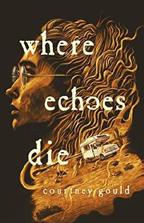
“An atmospheric, heady, ambiguous mystery.”
grim
coming down with a strange affliction that seems endemic to the place, Beck has to figure out what happened to her mom, how it’s related to the mysteries of Backravel, and what to do about curt, enigmatic, and very attractive Avery Carnes, daughter of the town’s charismatic but untrustworthy founder. Whether taken as straightforward science fiction or a meditation on trauma and healing, this is a sophisticated and entertaining read that is highly atmospheric. Characters seem to default to White.
A creative exploration of loss and discovery. (Paranormal thriller. 1418)
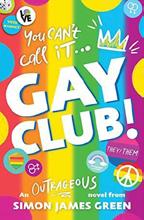
Green, Simon James Scholastic (432 pp.)
$19.99 | June 6, 2023

9781338897463
Friends, enemies, and frenemies see the best and worst sides of each other when the vote for LGBTQ+ Society president is opened up to the whole school. The club supporting queer students at Barney Brown’s school, Greenacre Academy, means everything to him. Passionate about its mission, the gay, White English teen is confident that he’s exactly the president the club needs—and even more confident that he’s a shoo-in for the role. His two best friends, George Piper and Maya Phillips, a White trans boy and Black lesbian, respectively, are the only other people choosing between Barney and Bronte O’Halloran—his opponent, Maya’s ex-girlfriend, and the sworn enemy of the tightknit trio. But when Bronte convinces their principal to allow all 1,000 members of the student body to vote, a contentious election campaign is set into motion in which both candidates will do whatever it takes to win. Adding to the pressure is the news that Rainbow Youth, a national organization, will be choosing one school’s queer club to represent them as global ambassadors. But even when the results of the vote come in, the drama is just beginning. The characters’ relationships and dialogue are endearing and laughout-loud funny. It is hard not to root for these teens as they fail and succeed together. Multiple plot twists and shocking reveals make this book difficult to put down.
Ideal for lovers of both juicy reality TV and inspiring LGBTQ+ documentaries. (author’s note, resources, club minutes) (Fiction. 1418)
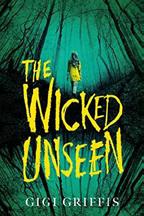
Griffis, Gigi
Underlined (288 pp.)
$10.99 paper | June 20, 2023
9780593644102
A girl is determined to find her missing crush when the town blames the disappearance on Satanists.
When Audre Weaver and her family moved from Brooklyn to a small town in Pennsylvania, she really didn’t fit in— she was sent home from school the first day for violating the dress code with her purple nail polish, and she was taken aback by seeing the Ten Commandments posted in her public high school. Luckily, Audre has befriended David, a fellow outsider who moved there from Puerto Rico, and feels drawn to Elle, the daughter of a local preacher for whom her feelings might be stronger than friendship. Then Elle goes missing, and the dress she was wearing when she disappeared turns up in the woods
soaked in blood at what looks like the site of a Satanic ritual. Audre’s father, who is researching the occult for his book, is detained by the police in connection with Elle’s disappearance. Since the police seem satisfied that they have cracked the case, Audre sets out herself to find out what really happened to Elle. Audre is a strong-willed, loyal protagonist who stands up for what she believes. Her friendship with David is warm and natural, as are her relationships with her parents. The gentle queer romance subplot enhances the well-crafted mystery in this novel that explores Satanic panic. Other than brown-skinned David, characters are White.
An absorbing mystery with strong characterization. (Mystery. 1218)
Hoàng, Brandon
Farrar, Straus and Giroux (304 pp.)
$18.99 | June 27, 2023
9780374388577
A boy befriends the most beautiful girl in school, hoping to get in with the popular crowd.
It is the summer before junior year, and Gary Võ and best friend Preston are ready for a change. Being working-class Vietnamese American kids at a mostly White school in a wealthy neighborhood means they are always on the outside. So, when Gary runs into Gloria Buenrostro, his accomplished, popular Mexican American classmate, making deliveries of altered clothes and tamales in his neighborhood, he takes the opportunity to get to know her. When the popular boys catch wind that Gary is hanging out with Gloria, they offer him and Preston the opportunity to join their club, the Rooster Society. All Gary has to do is steal the silver bracelet Gloria always wears as a trophy for the society’s collection of possessions taken from “the hottest girls in school.” As the summer goes on, Gary and Gloria become close and open up to each other. With mounting pressure from Preston and the Roosters, Gary struggles with his desire to be popular and the potential loss of a real friend. This is a sincere story of unexpected bonds and self-discovery. The lightness of the summer adventures is balanced by raw, honest conversations and depictions of Gary’s poverty and Gloria’s parents’ conflicts. Mental health and toxic masculinity are also explored throughout the novel.
A moving story of true friendship. (Fiction. 1318)
Jensen, Van Illus. by Jesse Lonergan
Colors by Patricia Delpeche
IDW Publishing (176 pp.)
$16.99 paper | July 11, 2023
9781684059980
In a post-apocalyptic world, a teen girl grapples with classism, trust, and the power of stories.

Arca is a spaceship built by a select group of billionaires as the Earth was dying. It’s heading to Eden, the nearest habitable planet, with passengers divided into Citizens, those who hold all the power; Settlers, people under 18 who serve them in exchange for a promise of paradise; and Helpers, the Citizens’ security forces. Shortly before her graduation from the Settlers, 17-year-old Effie discovers an object in the farm soil on Eden that leads her to question the Citizens’ honesty—something that will reshape what Settlers and Helpers think they know about the Citizens and their world. Together with her friends, she must race against the clock as her birthday nears and her future is uncertain to try to uncover the truth and hold the corrupt Citizens accountable. Readers may wish for deeper character development, but this exciting, fast-paced, post-apocalyptic graphic novel tells an engaging story about perseverance and tenacity, friendship and loyalty, truth and lies. The illustrations are reminiscent of vintage comics with their muted color palette and fluid linework. People’s faces are angular and expressive. Characters’ names and physical appearances show an ethnically diverse cast; Effie has tan skin and straight black hair.
A fun page-turner that skillfully explores social inequality. (guide to the Arca, main cast of characters) (Graphic dystopian. 16adult)
Jeong, Lena
HarperTeen (448 pp.)
$19.99 | June 20, 2023
9780063241640
Wielding magic powers, a crown princess must save her brother and her queendom from an ancient evil and a looming war.

Due to her mother’s sudden illness, 16-year-old Mirae faces the Trial of the Gods in order to assume her birthright and protect the queendom of Seolla. With her mother’s magic growing more unstable, Mirae must quickly master Seolla’s three magic systems: Jade Witchery (controlling the four elements), Ma-eum Magic (creating illusions), and Horomancy (manipulating the rules of time). Mirae is under pressure to keep an ancient evil locked away, stop the sovereign state of Josan from starting a war, and fulfill the prophecy

to lead Seolla into its golden future, avoiding eternal ruin. So, when the trial goes wrong and an evil creature kidnaps Minho, her older brother, Mirae takes matters into her own hands. Journeying into enemy lands with her younger brother, loyal Capt. Jia, and Minho’s servant, Mirae learns dark family secrets that could change her world forever. Trust, betrayal, lies, truth, selfishness, selflessness, and familial love affect Mirae’s choices as she strives to rescue Minho and protect the queendom. Full of action-packed twists and turns, this magical, fast-paced story is exciting, but there’s a lot going on, including jumps in time that can be confusing. The rich, historical, Korean-inspired worldbuilding and descriptions will draw readers in with references to Korean history, food, clothing, and mythology.
Complex and captivating. (Fantasy. 1318)

Linsmeier, Amanda Delacorte (336 pp.)
$18.99 | $21.99 PLB | June 27, 2023

9780593572337
9780593572344 PLB
Kit’s dad always said that her grandmother was dead.
But when Kit’s father dies suddenly, Agatha Starling, his mysterious (and very much alive) mother, invites Kit and her mom to leave North Dakota and spend the winter holidays at her home. Agatha lives in a small apartment even though she still owns massive Starling House, the old family home that’s since been turned into a museum. When Kit and her mother arrive in Rosemont, a Stepford-like small town in Wisconsin, for Christmas, what awaits her isn’t a quaint holiday with her long-lost grandmother but a horror-filled trip complete with creepy townsfolk, magical roses, disembodied voices, and even
“Will
starlings
readers will take away from the book. Our conversation has been edited for length and clarity.
Why is it so crucial for young people to learn about money?
It’s incredibly crucial for young people to know about money because, like the rest of us, they were born into a capitalistic system that they didn’t choose. Because of capitalism, money is power. Money is how we access safety, security, and health—for better or for worse. A person who has control over their money has a lot of autonomy in our world. That’s something I didn’t learn until I was much older, and I think it’s crucial for young people to learn this as soon as possible because then they’re better equipped to navigate the world as it truly is.
When you first started your financial journey, you took to social media to document your journey of saving and paying off debt. What were the scariest and most rewarding parts of sharing your finances?
Conversations about money are not usually this captivating, but it’s impossible not to be entertained by the quippy dialogue and engaging infographics in Berna Anat’s Money Out Loud: All the Financial Stuff No One Taught Us (Quill Tree Books/Harper Collins, April 25). In this informational guide for young adults, the financial educator writes about saving, budgeting, and investing, and while none of the topics are new (Anat says so herself), the book speaks to an audience frequently excluded from this kind of information. Anat’s book feels especially timely and nuanced, as she dedicates sections to investing in ethical companies, how to get a bank account if you’re undocumented, and how systemic racism has stymied Black wealth in America. I recently sat down with Anat for a phone conversation, and we discussed the importance of young people managing their money in today’s uncertain world and the one thing she hopes
It was scary to share the fact that I had $12,000 in credit card debt and almost $40,000 in student loans. It was scary because I was taught to be scared of my finances. But then the fear of that quickly turned into gratitude and relief because so many other people felt the same way and were relieved that someone else raised their hand first. The absolute most rewarding thing was having other people go, You know what, since you’re doing it, I’m going to do it, too. Shame makes isolation worse. When we feel shame, we feel isolated and then we don’t ask questions, and we don’t learn. It’s really gratifying to feel like I’m unlocking this piece of freedom for other folks.
One of the things that I appreciate about your book is that you include a lot of prompts for young people to talk about money with their parents, which is especially hard for kids of first-generation immigrants. You also write

about your Filipino family and how their habits shaped your relationship with money early on. How has your financial journey and writing this book transformed your relationship with your parents?
I’ve been very careful about showing how I’ve learned something, and then I try to invite them into the learning process so that it doesn’t feel like I’m turning around and wagging my finger—because that just would not jive in a lot of BIPOC families. It’s like I step ahead a little bit and then invite them into what I’m learning so that it never comes from this place of, like, I did it and so should you, or a place of blame or guilt. My parents have their own relationship with money too, and I need to be conscious of that.
So much of financial planning is making sacrifices today and planning for our future selves. With climate change, unaffordable housing, and inflation looming over us, there’s a temptation for young people to throw their hands up and just say YOLO when it comes to money. How do we approach financial education in today’s unpredictable environment?
So many of us, no matter what generation we’re in, all we know is survival. All we know is barely making it—keeping our heads down, working, and just grinding away in our corner of the world without even thinking of what else is possible. It’s really easy to get down and look at the world as it is. But we cannot think of new systems, new dreams, and new ideas while we’re still stuck in survival mode. And that includes financial survival mode. The dream is to get out of the “surviving paycheck to paycheck” mentality and to care for our future selves so that we can go from panic and doggy paddling to head above water. But we can’t get to that level of dreaming without a basic level of financial self-care. I’m trying to get our heads above water.
In the book, you talk a lot about having “good money friends”: those around you with the same financial goals. Did you have good money friends when you started out? My friends and I were all on the same level of financial confusion, but we weren’t talking about it. We were all in our own little cones of shame and silence about money, trying to do our thing. I grew up thinking you’re not supposed to talk about money with your friends or peers. And so in my own financial journey, sharing my financial education, I took my cone of silence off. I started to share my journey, and I found that the friends and family members that I have became good money friends. Since I’ve been sharing my financial journey and sharing how I became debt free, it’s only brought my current friends closer, and it’s brought new friends—I now have a network of other financial educators I’m learning from.
What would you tell your younger self about money and finances?
When you ask that question, I think about my 13-year-old self, specifically. I would encourage my 13-year-old self to breathe a little bit. There are things you won’t always be able to control. You should still think about being a kid and being young and having fun. And I also want you to think about money as a tool that you can use, not the thing that you hope to get close to you if you’re a very good student or a good worker. Money is something that, even in small amounts, you can organize to work for your life. It’s possible to get the life that you want with money, and it’s possible if you learn good money habits. I would want my 13-year-old self to understand money as a very basic tool to get what you want and not this far-off, distant thing that I’m going to hopefully have.
What’s one thing you want readers to take away from this book?
I really hope that this book is a book full of moments of people feeling seen and their financial issues being reflected back to them. I hope that this book is like a disco ball with reflective surfaces all over where people can see themselves and just feel included in the conversation about money, maybe for the first time. Maybe this is the first book that they read that makes them feel included in the money world, and then they go on to read a ton of other books because they finally feel comfortable enough to get in the conversation. That will be “mission accomplished” for me.
Mariette Williams is a South Florida–based writer with bylines in Travel + Leisure, Teen Vogue, Cosmopolitan, and Essence. Money Out Loud received a starred review in the Feb. 15, 2023, issue.

a mysterious death. When Kit’s mother suddenly disappears under strange circumstances and her grandmother seems more preoccupied with an upcoming New Year’s town festival, Kit knows something is not right. She is forced to rely on herself and her few new Rosemont friends to figure out what is really going on and what exactly is keeping Rosemont seeming so outwardly perfect. This is an original and fast-paced horror novel with elements of fantasy. While the prose is at times overly embellished and the supporting characters lack significant depth, the deliciously chilling plot advances swiftly toward a conclusion that will leave readers delightfully creeped out and thoroughly content. Main characters are White; Kit is bisexual, and there is some diversity in race and sexual orientation among supporting characters.
A foreboding, flower-filled, feminist horror story. (Horror. 1418)
Lozano, Camilo Moncada
Colors by Angel De Santiago
IDW Publishing (320 pp.)
$16.99 paper | April 4, 2023
9781684059591
Series: Codex Black, 1

This fantasy adventure based on a popular webcomic introduces a mythical world of gods and monsters overlaid on the historical backdrop of the Triple Alliance in the final days of pre-Columbian Mesoamerica.
The book opens on a forbidden ritual performed under cover of darkness, as orbs of light rise and summon a Child of Darkness against the backdrop of the first days of colonial expansion in Mesoamerica and reign of the Triple Alliance between Tenochtitlan, Tetzcoco, and Tlacopan. Meanwhile, Itzcacalotl, an ambitious, 17-year-old would-be Mexica warrior, wanders from his group into the jungle where a murder of crows brings magical transformation. Elsewhere, 15-year-old Donaji prepares to leave her Zapotec home on a quest to find her longlost father with help from a quechquemitl, a poncholike garment, imbued with the spirit of a god. A wrong turn puts Donaji in Itzcacalotl’s way, and they are able to join forces on the quest to find Donaji’s father, though the path is fraught with supernatural dangers. But how the dark creature from the ritual ties into their journey remains shrouded. Alert readers will know that Spanish invaders lie on the horizon, leaving them eager for the next installment. Graphic novel fans will appreciate how the colorful, manga-inspired illustrations dramatically bring the Mesoamerican setting to life, and history buffs will enjoy the footnote factoids sprinkled throughout.
An enticing, fast-paced series opener. (map, name glossary, places, historical context, deities, author’s note, additional sketches) (Graphic fantasy. 1218)
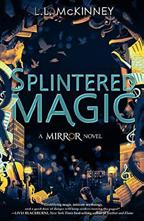
L.L.
Disney-Hyperion (400 pp.)
$18.99 | July 18, 2023
9781368046367
Series: The Mirror, 4
As Tai and Trey approach their 16th birthdays, strange things start happening in this final entry of the Mirror quartet, whose entries are written by different authors.
Trey’s telekinetic and transformative magic gains heightened emotional sensitivity after he loses a coveted orchestra position to a new student, leading to broken cello strings and a shattered salad bowl. Aspiring photographer Tai, who can see brief visions in reflective surfaces, starts seeing a mysterious young woman through her camera lens. The twins grow more unsettled when they find a portrait of a girl called Elva painted by their missing mother, artist Blake Estancia Watson from J.C. Cervantes’ Fractured Path (2022), and references to her in their mom’s notebook. There’s also the family curse to consider—it causes two good incidents to follow one bad one—but to Tai, it seems like there’s only one good thing at the moment, and that’s her cute new classmate, Ayesha, who helps the siblings when they notice they’re being followed by sinister, magicusing strangers. When Tai finds a mirror that reveals a strange secret, she realizes that she may have found the key to finding her mother. Snappy dialogue and pop-culture references establish a strong sense of place and time in this story, which sweeps the three Black teens into a heart-pounding adventure that sets them against a hostile organization and on the path to dissolving a curse that began long ago with a broken promise.
An exciting series conclusion. (Fantasy. 1318)
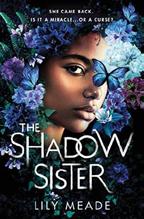
Meade, Lily
Sourcebooks Fire (338 pp.)
$18.99 | June 27, 2023
9781728264479
A biracial high school student questions the truth surrounding her sister’s disappearance and unexplained return.
Sixteen-year-old Cassandra “Casey” Cureton despises her older sister, Sutton. The girls have a White mom and Black dad, and unlike her sister, Casey keeps her hair natural. She prefers the company of best friend Ruth, who is Black, and her online music fandom community. Dedicated cheer captain, flat-iron enthusiast, and rising senior Sutton is a mean girl with a convincingly sweet public persona. When Sutton goes missing on their last day of classes, their parents rally their affluent suburban Seattle-area community to band together and bring Sutton home. Weeks later, she is found physically unharmed but unable to remember anything. While her parents adjust to
“Manga-inspired illustrations dramatically bring the Mesoamerican setting to life.”
codex black
Annick
Press (336 pp.)$19.99 | June 6, 2023
The highs and lows of ballet—and of growing up.
Sixteen-year-old Aisha Bimi has worked hard to be one of the best dancers in her ballet-focused boarding school, but she is continually reminded that, in many people’s eyes, she doesn’t look the part. Aisha is Ghanaian Canadian, and there are few Black people in the world of ballet. After she fails to receive an apprenticeship with the Western Canadian Ballet, Aisha makes the split-second decision to return home to Toronto. There, she toys with the idea of enrolling in an arts high school with her best friend, Neil. She can see that Neil, who is of Korean descent, has an alcohol problem, and she is determined to help, enlisting the aid of Algerian Canadian Ollie, one of Neil’s quiet yet compelling school friends. Can Aisha balance her relationships old and new, her mental health, and ballet, or is it all too much? Aisha’s feelings about dance consistently ring true, from the isolation of having few role models or friends who look like her to her love of classical technique and her hunger for something new. Her struggles with body image are especially authentic. Aisha and her friends face real problems and are not without their stumbles and missteps, but they also work to support each other in finding healing and healthy ways to move forward.
A hopeful, realistic exploration of mental health among teens invested in the world of the arts. (Fiction. 14-18)
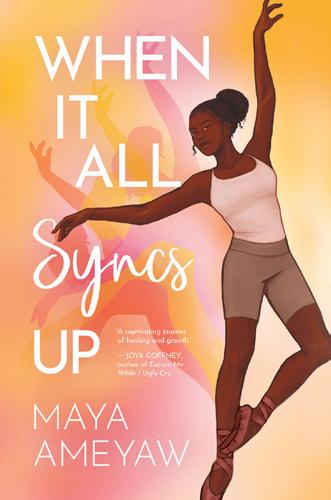
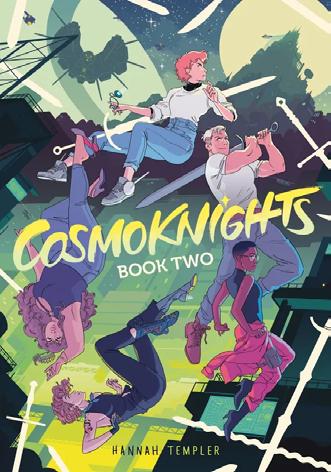 by Hannah Templer
by Hannah Templer
Top Shelf Productions (280 pp.)
$24.99 paper | June 13, 2023
A popular webcomic returns with more galactic drama.
Pan wakes up with an audio message from the past: Five years ago, she helped her best friend, Princess Tara, escape the fate of an unwanted marriage. Now she is startled to hear Tara crying and saying they made a mistake. But she and the crew must focus on their plan to continue freeing other princesses. They currently have one onboard, but she won’t come out of her room. When she finally does emerge, it’s to ping her location, signaling wardens to come take her home. Unfortunately for them all, she only ends up alerting pirates to their whereabouts. Pan finally gets through to Scottie, the latest princess, who shares that she never actually wanted to be saved in the first place and had plans for doing good in her role as queen. This leads Pan to open up about Tara’s delayed message and her self-doubts. Everyone on the fleet seems to have a different opinion as to which strategy to follow now, but they have to decide soon, especially with the pirates on their tail. This sequel raises the stakes as Pan continues to explore different aspects of feminism. In exciting action scenes and sweet romantic subplots, readers, too, will start asking questions. The illustrations offer bursts of hot colors and beautiful sequences that highlight the queer, multiracial cast.
A gripping feminist space adventure. (Graphic science fiction. 14-18)
Sutton’s bittersweet homecoming, Casey realizes there’s something deeply unnerving about the sister who has returned—and it has nothing to do with her amnesia. As Casey races to unmask Sutton’s secrets, she discovers how her paternal family legacy protected Sutton, shedding new light on the powerful bonds of blood. Debut author Meade offers an intriguing, emotionally resonant novel wrapped in supernatural realism. Guided by layered themes of generational inheritance, Black identity, and the reclamation of history, the first-person narrative is told through Casey’s point of view with flashbacks from Sutton. Twists abound, but readers may crave a fuller ending than the actionpacked but quick resolution.
A gripping portrait of fractured sisterhood, reverberating traumas, and the triumphs of omniscient ancestors. (author’s note) (Speculative fiction. 1418)

Mochizuki, Ken
Norton Young Readers (160 pp.)
$19.95 | March 14, 2023
9781324015888
A biography of a woman who exposed the government secrets behind Japanese American concentration camps.
Michiko Nishiura Weglyn grew up on a farm in California where her Japanese immigrant parents worked. After the attack on Pearl Harbor, her family was taken to the Gila River War Relocation Center in Arizona. In a place where everyone was the same race, Michiko began to find her voice and became a leader in the camp high school. Facing discrimination in college and the professional world, Michiko worked hard to become a costume designer for Broadway and popular television shows. When, in 1968, the U.S. attorney general stated there had never been concentration camps in America, an outraged Michiko dedicated her time to uncovering and publicizing the truth about the Japanese American experience during WWII. Through years of research and writing, Michiko revealed hidden facts about the unjust treatment of Japanese Americans that also aided the redress movement. This well-crafted biography highlights a lesser-known catalyst for Japanese American reparations. Although only briefly mentioned, the treatment of Japanese Americans working in rail and coal and copper mines, as well as Japanese Latin Americans who were taken from their countries to U.S. internment camps, is brought to light through Michiko’s advocacy. Using well-chosen quotes from Michiko’s book, Years of Infamy (1996), Mochizuki’s work will resonate with teens.
An eye-opening history of Japanese American treatment during WWII. (photographs, notes, sources, picture credits, index) (Biography. 1318)
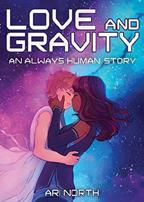
North, Ari Yellow Jacket (288 pp.)
$24.99 | $14.99 paper | July 25, 2023
9781499812794
9781499812787 paper
Series: Always Human, 2
Healthy relationships and healthy conversations unfold in a sweet sliceof-life story, the second in a series that launched on Webtoon.
Possessing much of the same charm of the first book, this sequel, set in a futuristic world where people can modify their appearances using technology called mods, introduces readers to new challenges in the lives of Sunati and Austen. A good portion of the book is focused on friendship, specifically Rae and Sunati’s. It starts with a flashback to 10 years earlier, when Sunati first came to Kaku City and felt scared by how overwhelming everything was—until she found Rae, suddenly had a friend, and wasn’t alone anymore. The story returns to the present, when the two young women work together. Sunati has an exciting new job opportunity, but she isn’t the only one: Rae gets her dream job, but it means she’ll be moving far away. Conflicted—wanting what’s best for her friend but also not wanting her to go—Sunati finds solace in girlfriend Austen. Ultimately, the two best friends work it out. The book includes a positive mention of therapy and a frank conversation about sex, consent, and waiting until you feel ready. These elements reflect a theme throughout this charming work: cultivating satisfying relationships through open, honest communication. The art is mainly in tones of blue and pink, executed in a fluid, dreamy, watercolor-painting style.
Heartwarming. (Graphic science fiction. 1218)
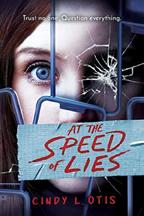
Otis, Cindy L.
Scholastic (368 pp.)
$18.99 | June 6, 2023
9781338806762
An Instagram influencer who uses a wheelchair becomes embroiled in conspiracies.
Quinn Calvet’s junior year isn’t starting out well. She’d hoped to bond with her older sister, Ava, before Ava left for college; hang with her best friend, Ximena; and boost engagement on her Instagram account, “The Whine.” But Ava’s obsessed with grades and extracurriculars, especially Defend Kids, a club to fight child trafficking…which is helmed by notorious bully Cade Bird. And Ximena’s inseparable from her boyfriend, making Quinn—who already feels socially behind her peers after rheumatoid arthritis caused her to miss most of seventh grade—feel left out. When Cade reports that two classmates have disappeared, Quinn amplifies the news on “The Whine.”
But as her followers skyrocket, commenters mob “The Whine” with conspiracy theories and coded references to the Cabal, a mysterious organization supposedly abducting kids across the Northeast U.S. Soon, Quinn’s social media account becomes a vector for misinformation and vigilantes’ violent threats as she and attractive Asher King, her unexpected sidekick, frantically sort fact from fiction. But how can Quinn deactivate her Instagram and lose this source of income when her family struggles financially? Otis, a former CIA officer, realistically examines conspiracy theories while extending compassion to believers. The dialogue is occasionally heavy on exposition, and some secondary characters lack nuance; however, the author’s portrayals of disability, ableism, and growing up experiencing both are insightful. Most main characters are White.
A timely, unsettling, and insightful read. (author’s note) (Suspense. 1418)
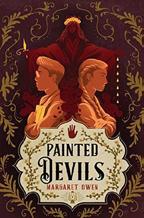
Owen, Margaret Henry Holt (512 pp.)
$18.89 | May 16, 2023
9781250831163
Vanja is back in the sequel to Owen’s Little Thieves (2021), and she has traded her title of thief for leader of a smalltown cult.
Despite saving Minkja, gaining the affection of Junior Prefect Emeric Conrad, and reassuming her own identity, Vanja still doubts she is good enough. One particularly bleak, drunken night, after Vanja appropriates a local legend to gain assistance in recovering her dropped rubies, she is named the prophet of the Scarlet Maiden. When Emeric shows up to investigate reports of a cult, he is surprised to discover Vanja at its center. And soon after he arrives, the Scarlet Maiden herself appears and claims Emeric as her servant and sacrifice. Vanja and Emeric set out to discover whether the Scarlet Maiden is a true Low God and attempt to save Emeric from her claim. Along the way, Vanja searches for her family and learns more about love as she grows closer to Emeric and faces the possibility of losing him. Struggles with identity and feelings of inadequacy are handled with an honest, thoughtful hand, while moments of humor punctuate the heavier subject matter. Owen’s masterful storytelling skills are evident in the balancing of Vanja’s self-doubt and vulnerability as well as the sex, romance, humor, and adventure that keep the narrative moving. The author’s atmospheric black-and-white woodblock-style illustrations appear throughout.
Another winding tale of intrigue and adventures that leans heavily on the heart. (content warnings) (Fantasy. 1418)

Pham, Thien
First Second (240 pp.)
$17.99 paper | June 20, 2023
9781250809728
A Vietnamese refugee looks back at his food memories in this graphic memoir.
Pham’s first memory was when he was 5, fleeing a war-torn Vietnam with his family. Pirates brandishing guns and knives attacked the small boat they were using to escape. His mom held onto him through gut-wrenching, violent scenes punctuated by solid black pages containing only her words of comfort: “I’m right here.” When the pirates were gone, he ate a rice ball his dad saved for him. At 41, Pham can still taste “the saltiness of the fish…the sweetness of the rice.” He details pivotal moments in his life through food—each chapter is devoted to a particular meal. His mom made and sold bánh cuốn at the Songkhla refugee camp in Thailand, where they awaited relocation. Russ, the White man who helped the Pham family when they arrived in the United States, made steak and potatoes for their first American dinner. Moving between harrowing and hopeful moments, his family’s experiences in their new country are powerfully juxtaposed. The narrative cohesion is weakened by time jumps in the final chapters, culminating in Pham’s path to citizenship as an adult, but the depiction of food as a love language holds together throughout. The blocky, geometric artwork is skillfully executed in rich, earthy, muted shades with strong black lines, lending the work a nostalgic feeling.
An American story to savor. (bonus panels) (Graphic memoir. 1318)
Rawitt, Jean Rowman & Littlefield (152 pp.)
$30.00 | July 12, 2023
9781538169353
Rawitt, the author of several teenadvice books, uses real-life examples and current resources for this comprehensive guide to changing your world, even as a teen.
Readers facing a world full of distressing problems are encouraged to become involved in changemaking. The writer argues that teens have characteristics that make them particularly effective: energy; a willingness to take risks, try new things, and speak out about their passions; and wide-ranging social networks. She begins with stories of 12 young activists,
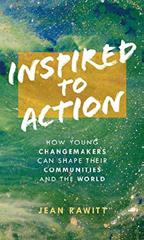
“Another
painted devils
most from the U.S., although three international subjects are included, two from Brazil and one from Uganda. Refreshingly, these are not the usual examples, and they cover a wide variety of causes and projects, from distributing athletic shoes to kids who need them to working for criminal justice reform. The book describes some necessary qualities for successful activism and cites the astute observation of Katie Eder, one of the young people profiled, that being “the odd one out, maybe a bit of a misfit,” can help people feel motivated to challenge inequities. Rawitt breaks down activism into fundamentals—understanding your cause, motivating people, organizing, and strategybuilding—and offers tips on tools and skills from fundraising through self-care. With plentiful examples and extensive quotations, the densely packed narrative is broken up in ways that will make it less daunting for the intended audience. Text boxes define relevant words and concepts such as canvassing, stakeholder, and pro bono
A helpful guide for would-be advocates. (resources, notes, bibliography, filmography, index) (Nonfiction. 1218)

Reinhardt, Dirk
Trans. by Rachel Ward
Pushkin Children’s Books (288 pp.)
$13.95 paper | May 9, 2023
9781782693093
Working-class teenagers who secretly resisted fascism during World War II are the subject of this work of historical fiction translated from German.
An introduction by prolific author for young people and former Children’s Laureate Michael Rosen explains that this novel is rooted in fact: Although they are not well known today, the Edelweiss Pirates really existed. The book opens with Josef Gerlach’s diary entry from late November 1944, describing the killing of his brother, Horst, by the SS as witnessed by Josef and his friends. In 2011, a boy named Daniel, visiting the cemetery where his grandfather was recently buried, meets Josef, who is by Horst’s grave. Josef piques Daniel’s interest with the claim that Horst’s story might interest him especially. Daniel is hooked—and readers will be too. From this point, diary entries spanning the period from March 1941 to May 1945 are counterpointed with scenes of Daniel and Josef at the latter’s modest digs in a home for elderly bachelors. Reinhardt’s energetic novel is both a coming-of-age story and a historic thriller that works best when Josef and his fellow Pirates are in action, ambushing Nazi patrols, hiding from the SS, or breaking into a van to secure provisions. Along the way, Tilly and Floss, two girls, also join the group. While fueled by a sense of romantic adventure, the novel doesn’t shy away from the horrors of war and Nazism. Important history tucked into a brisk roman à clef. (historical note, glossary) (Historical fiction. 1318)
Reyes, Sonora Balzer + Bray/HarperCollins (320 pp.)
$19.99 | May 23, 2023
9780063060302
Ariana Ruiz had a terrible evening. She’s not sure she actually consented to having sex with Luis Ortega, which brings on horrible feelings, including dissociating for hours. Queer Mexican American Ariana is autistic “with a heavy dose of selective mutism,” and she’s starting to wonder if her silence is precisely what Luis liked. Shawni, Luis’ ex-girlfriend, told Ariana to stay away from him only to see them go into a room together at a party. So when Ariana texts Luis, and he agrees not to tell anyone what happened but everyone still seems to know, she assumes Shawni is to blame. Boys start harassing Ariana, and the situation spirals into hellish bullying. And then, she finds a note in her locker reading “me too.” The mystery writer and Ariana connect on Tumblr, although Ariana is initially against their suggestion of getting back at Luis. But after learning that he was even more deliberate in his exploitation of her than she realized, she goes to the appointed meeting place. There, she discovers she’s not the only one invited: It’s a support group for people whose reputations were ruined by Luis. Readers may find that the actual revenge they take feels flat against the violent trauma Luis put each of them through, but the group of teens, who are diverse across many dimensions and were previously socially isolated by Luis’ actions, forge new bonds and help each other heal.
A fresh story exploring timely issues. (author’s note, content warnings) (Fiction. 1418)
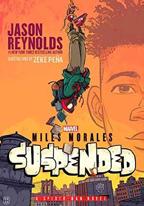
Reynolds, Jason
Illus. by Zeke Peña
Caitlyn Dlouhy/Atheneum (320 pp.)
$19.99 | May 2, 2023
9781665918466
Miles Morales contends with a new threat.
Another week begins at Brooklyn Visions Academy, and Miles is in a tough spot. Following the events of Miles Morales: SpiderMan (2017), in which he defeated villain the Warden, Miles assumed things would settle down. But history teacher Mr. Chamberlain appears to be stuck in the past: Miles’ crush, a Black girl named Alicia Carson, leads a protest and is suspended. Mr. Chamberlain unfairly picks on Miles, and he ends up being given inschool suspension too. Miles’ parents, Boricua and Black, are proud of him, but it doesn’t feel like his school understands. As the suspension day crawls along, Miles’ thoughts race. Austin, his cousin, is locked up: How can he help? Alicia is there in ISS

“Both a coming-of-age story and a historic thriller.”
the edelweiss pirates
too. A few days ago, he gave her a poem he’d written, and she gave him one in return. Classmate and dedicated library assistant Tobin Rogers is being punished for destroying books—but why would he do that? As the answers to these questions slowly come into focus, Miles realizes who the unlikely foe is. Quick thinking and quicker moves may not be enough to take this villain down, but he must try. Reynolds returns with a genre-bending sequel exploring the inner workings of Brooklyn’s latest web-slinger. Told in a fluid combination of prose and verse, the story lays Miles’ emotional truths bare. The antagonist’s origin and incentives are a bit lacking by contrast, but the strong plot will keep pages turning.
Relatable high-stakes fun. (Fantasy. 1218)
Roberts,
Illus. by Mike
NortonColors by Allen Passalaqua
Dark Horse (200 pp.)
$19.99 paper | June 6, 2023
9781506729404
Social outcasts find their collective calling along with some incidental heroism.
It’s May 1989, and 16-year-old Doug Cowen is putting a band together to open for returning local boy Tommi Tungstun, who has achieved a modicum of heavy-metal success outside their small Tennessee town. Drummer Jonny Duncan, Lenny Heck on his older brother’s bass, and Marty Ward on guitar round out the main cast. Each of them is held back personally or targeted for bullying at school as a result of their circumstances and upbringing, be it Doug’s small stature and gifted and talented label, Marty’s poverty, Jonny’s repressively conservative Christian family, or Lenny’s larger body size. Scenes of adolescent downtime that find the four outcasts nerding out over music ring true. Performance as their means of escape, expression, and bonding is also cause for bold sound effects lettered in primary colors. The group’s tenuous camaraderie serves as an escape from the ever present bullying of quarterback and sheriff’s son Clay Guidry, who finds and torments them at school and around town. Climactic action revolving around carnage caused by mutated pigs created by a multinational corporation may seem out of place, but it also serves as a catalyst for the gang’s character arcs. A substantial epilogue closes out the bloodied but rockin’ wonder years. This concise offering scratches that Stranger Things itch without overstaying its welcome. Main characters appear White.
A nostalgic nod to the power of friendship. (Graphic fiction.
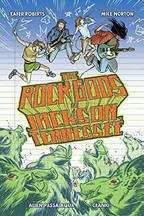
1317)

Romero, R.M.
Peachtree Teen (384 pp.)
$18.99 | July 11, 2023
9781682634837
Hilde may look like a human girl, but she’s not one—though sometimes, she is a swan.
Set in our human past as well as the mystical world of spirits and gods, Hilde’s story takes her from her magical and secluded woodland home into late-1800s Bavaria. Hilde and her five sisters are the daughters of the god Odin, the All-Father. Each of the young women has been endowed with a special gift as well as the ability to turn dreams into reality. Hilde’s desire to distance herself from her particularly macabre skill—“The gift / of greeting / death”—sparks her desire to flee with her new friend, the human boy Baron Maximilian von Richter, leaving behind her duties in favor of human girlhood. When Richter takes Hilde to the great and bustling city of Munich and the court of melancholy King Ludwig II, she meets Franz Mendelsohn, a nonbinary Jewish teen artist. As Hilde and Franz grow close, they strive to create a successful balance between magic and reality, encountering surprising kindness and deep betrayal along the way. Written in sparse free verse, this character-driven queer narrative is an original yet slow-moving story of an otherworldly being trying to find her place in the universe. Though lyrical, the simple poetry and unembellished plot make this milquetoast historical fantasy ultimately fall flat. Main human characters are presumed White; Hilde is darker skinned and has red hair.
A lukewarm historical fairy-tale fantasy. (Verse fantasy. 1418)
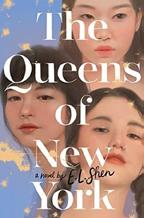
Shen, E.L.
Quill Tree Books/HarperCollins (336 pp.)
$19.99 | June 6, 2023
9780063237957
For the first time in their decadelong friendship, Everett Hoang, Ariel Kim, and Jia Lee, all 17, are spending the summer apart.
Vietnamese American Everett is headed to a musical theater program in Ohio, where she hopes to land a lead role in the annual performance. Korean American Ariel, still consumed by unanswered questions surrounding her older sister’s recent death, graduated early and is going to Briston University in San Francisco to attend a rigorous pre-college STEM program. The only one staying home in Flushing is Chinese American Jia, who has to work at her family’s dumpling restaurant and take care of her kid sister and ailing grandmother. The girls have remained best friends over the years despite diverging interests and attending different schools, but Everett
and Jia can’t help worrying about Ariel’s increasingly withdrawn behavior. The chapters switch among their three points of view with prose that effortlessly conveys each character’s personality. Emails and group chat messages interspersed between chapters bring the story to life as the girls share their summer triumphs and setbacks with each other. Although they have their own challenges to face—whether it’s cultural insensitivity in the theater world, pressure to take over the family business, or unresolved grief and guilt—Everett, Jia, and Ariel know that their friendship means they’re never truly alone.
A heartfelt, skillfully wrought portrayal of friendship. (Fiction. 1318)
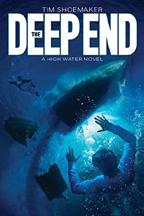
Shoemaker, Tim
Focus on the Family (416 pp.)
$15.99 paper | June 6, 2023
9781646071104
Series: High Water, 3
Third in the High Water series, this stand-alone volume combines fast-paced suspense with a spiritual message targeted toward young Christian teens.
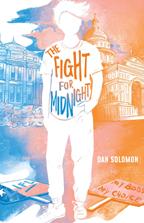
Nothing means more to Harley Lotitto than Kemosabe, the beloved motorcycle he and his late father built together toward the end of his dad’s life (the name’s troubling associations are not addressed in the book). So, when Harley and his friend Parker Buckman find a cryptic note written in dramatic red ink and shortly afterward a mysterious caller tells Harley the shed where he stores his bike is on fire, fear and panic ensue. Thankfully, the damage is minimal, but emotions run high, and the resulting drama drives the plot as Harley, Parker, and friends Ella and Jelly are determined to find the culprit despite facing numerous obstacles. Uncle Ray, Harley’s guardian, is determined to access the funds from Harley’s dad’s life insurance policy. And Bryce Scorza, a quarterback who used to be Harley’s best friend, has stood in his way before. Could either of them be behind this? The third-person narrative alternates among various characters. Though the antagonist’s motives and actions may feel less than believable at times, the author keeps the tension taut leading to the page-turning finish. Spiritual themes abound, and the protagonists demonstrate spiritual and emotional growth as they explore the importance of friends and trusting God. The main cast is assumed White. A quick read that will keep readers’ attention through many twists and turns. (map) (Mystery. 1215)
pp.)
$19.99 | May 23, 2023
9780063283268
It’s the summer before she starts university, and a comic enthusiast from Oxford, England, has plans.
In addition to a vacation with best friend Ritika Ghosh, Elsie Lo is finally going to confess her feelings for Ada Hobbs, her long-distance crush and online fandom friend who has a Black Nigerian mum and a White English dad. Things start to shift when Elsie runs into Joan Tse, the childhood BFF who ghosted her years ago. The two start chatting, rekindle a friendship, and come out to each other as lesbian (Joan) and bi (Elsie). Elsie shares her plan to try to reunite two long-separated women—probably lesbian lovers, one of them Ada’s grandmother. She hopes this grand romantic gesture will impress Ada. Joan is game to join in, and the Cornwall vacation with Ritika turns into a three-person research trip. This ambitious novel has many threads, including an epistolary element and multiple romances, and it doesn’t always come together. The relatively deep backstories—Elsie is also the survivor of an unhealthy relationship—and numerous key characters make for a slow start. Still, Elsie’s search for an older generation of queer women even as she grapples with her own challenging grandmother gives the story momentum and depth, and her journey to finding love, her people, and herself rings tender and true. Both Elsie’s and Joan’s families are from Hong Kong; most major characters are people of color and/or queer.
A worthwhile celebration of love and second chances from a fresh voice. (Romance. 1318)

Solomon, Dan Flux (288 pp.)
$19.99 | June 20, 2023
9781635830866
A grieving, lonely teen unexpectedly lands in the middle of a political protest.
It’s 2013, and Alex faces the summer before his senior year with the grim acceptance that his only friend is Mr. Monaghan, an 85-year-old man he reads to at an adult day center for his required community service. Alex is shocked but thrilled to get a call from cute, unattainable Cassie, “the most Catholic girl on the planet who isn’t an actual nun”—they have known each other since their elementary years in Catholic school, but they aren’t exactly friends. She asks him to come to the Texas Capitol building for something important, which turns out to be a filibuster for Senate Bill 5, proposing a ban on abortions after 20 weeks. Alex is only vaguely aware of the controversy, and he experiences many
reckonings throughout the day. This smart, poignant novel effectively weaves the backstory of the death of Alex’s best friend into the present-day events, portraying Cassie, who is there in support of the abortion ban, as intelligent and caring even as it makes clear the hypocrisy of the politicians involved in its proposal. Well-drawn secondary characters shine, including confident, compassionate Iranian American Shireen, Alex’s classmate and former friend who is present to support the filibuster, and foulmouthed Mr. Monaghan, who is an astute, progressive role model. Cassie is cued Latine; other major characters read White.
A thoughtful and compelling personal story set amid larger societal issues. (Fiction. 1318)
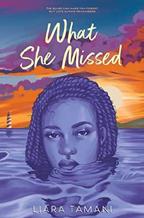
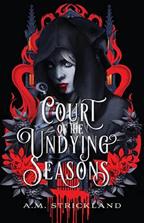
Strickland, A.M.
Feiwel & Friends (400 pp.)
$19.99 | May 16, 2023
9781250832627
When it is time for the annual Finding, an orphaned 19-year-old girl volunteers to be the sacrifice from her village to join a vampire school—with extraordinary consequences.

Fin’s mother was taken by vampires, and now that she is at Courtsheart as an initiate, going in place of the girl she loved, she sees it as the opportunity for revenge. At the same time, she hopes to avoid the fate of becoming one of the beings she despises. But the more she learns about the undead and the different courts they belong to—five Houses, each with their own rules—the more she becomes seduced by their temptations and by the delicious blood she drinks from Gavron, her maker. But if she fails to pass the harrowing lessons, she will become a mortal thrall instead of a vampire. And that’s when a string of mysterious murders commences. A welcome return to the world of suitably dark, thirsty, wholly inhuman vampires, this is a story that pays homage to classics and plays with boarding school and murder-mystery tropes in an original, inventive way. Fin’s own journey into power along with the medieval-esque setting, heart-stirring romance, well-rounded secondary characters, and found family make it a delectable read indeed. White bisexual Fin is exploring her sense of gender in a world with ample diversity of race, gender, and sexuality.
Abso-bloody-lutely brilliant. (guide to the undying Houses) (Fantasy. 15adult)
Tamani, Liara Greenwillow Books (320 pp.)
$19.99 | June 13, 2023
9780063093287
Grief, severe anxiety, and an abundance of negative self-talk make for a narrator who is at odds with herself— and who’s missing a lot of what’s going on around her.
Sixteen-year-old painter Ebony Jones couldn’t bring herself to complete a self-portrait assignment at her old school before her parents uprooted her whole life and moved her to Alula Lake, a historically Black seaside town in Texas where she spent summers as a child. She hasn’t been back since her grandmother Gigi’s passing. Now, she’s struggling with the ways she sees herself, both as an artist and as a person, the begrudged change in scenery, the loss of her friend group, and constant reminders of Gigi, all of which exacerbate her issues, leading to Ebony’s quickly spiraling into self-destructive habits even as her parents and a childhood best friend try hard to reach her. Brief passages from the perspective of an omniscient narrator interspersed between Ebony’s first-person chapters give readers necessary insights into things Ebony’s unable to notice or deeply unwilling to accept. Without this awareness, she can’t help but tank her relationships and find herself in embarrassing and dangerous situations. It’s the alternative perspective that clues the reader in to the long journey ahead, as even the closing honesty and reconciliations will not resolve some of her deeper issues. She is a protagonist who is simultaneously deeply frustrating and relatable, and by the end she’s at least able to paint herself more clearly.
Heartbreakingly well executed. (Fiction. 1218)
Walther, K.L.
Sourcebooks Fire (384 pp.)
$11.99 paper | June 27, 2023
9781728263137
The senior prank at Ames, an upscale Rhode Island boarding school, reignites romance and conflict for Lily Hopper and ex-boyfriend Tag Swell.
Their relationship lasted nearly two years before Lily broke it off. Her feelings for Tag remain intense— but so is her jealousy over his girl admirers, especially valedictorian Blair Greenberg, whom he dated next. After Tag and Blair’s split, Lily keeps her distance until she’s tapped to join the senior prank, an invitation that secretly comes from Tag himself. They are setting up student body president Daniel Rivera—whose promposal Lily regrets accepting—by hiding the new yearbooks he’s scheduled to hand out in two days. Planting a trail of clues for Daniel across campus at night, Lily and Tag revisit their history and
“A welcome return to the world of dark, thirsty, wholly inhuman vampires.”
court of the undying seasons
feelings; the one obstacle to their happiness was Lily’s insecurity, the plot’s linchpin. Athletic and an accomplished dancer, she’s the class salutatorian and bound for Georgetown University, but attending Ames for free as the daughter of one of the most popular teachers on campus and surrounded by students who are far wealthier, she is acutely self-conscious of her “fac-brat” status, has always played it safe, and struggles with self-doubt. Rehashing their past through flashbacks, Lily faces difficult emotional truths. Tag’s Type 1 diabetes is well described and woven into the story without being the focus of his characterization. Lily and Tag read White; surnames cue ethnic diversity in the supporting cast.
An engaging story of personal growth and a second-chance romance. (Fiction. 1418)
White, Tracy
Street Noise Books (168 pp.)
$19.99 paper | June 20, 2023
9781951491208
A documentary-style account dramatizes the situations of many teen asylum seekers.
Spare, striking, black-and-white illustrations portray five teens fleeing dangerous situations and making hazardous journeys to the U.S. Bookish Guatemalan Vilma, 13, was beaten and sexually abused by her father. Burdened with guilt for speaking up and precipitating the flight of her mother and younger sister too, she struggles with depression and selfharm but gets therapy and an education in the Chicago area. At 12, Rosa from Honduras worked to support her family; at 16, her narco boyfriend threatens her, and after reaching the U.S., she learns that she is HIV-positive. In El Salvador, Ricardo, 17, and his sister, Karen, 13, are preyed upon by gangs. A coyote drops them in the desert, and they’re picked up by border patrol. But Ricardo ages out of the U.S. facility for minors and is deported. Fanta, a girl from Guinea, underwent female genital mutilation and was married at 12 to an abusive 40-year-old man. At 16, she left her children with her mother, embarking on a challenging journey to the U.S., where she entered inhospitable foster homes. Carefully researched composites, these harrowing accounts are representative of cases seen by the Safe Passage Project, which provides pro bono legal support to young people like these. This fast-paced, relatable work is informative and enlightening, treating its subjects with respect.
Powerful text and images honor young people’s suffering and strength. (author’s note, notes, glossary, further reading, study guide questions) (Graphic nonfiction. 15adult)
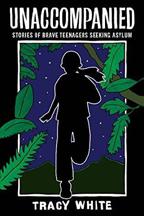
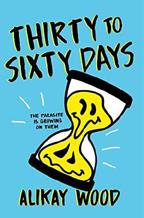
Wood, Alikay
Amulet/Abrams (320 pp.)
$19.99 | June 20, 2023
9781419752308
News that they are about to die boots three Florida high schoolers out of individual ruts.
Wood offers readers a trio loaded with personal issues and ripe for plenty of fizzy chemistry. Narrator Hattie Larken, who reads White, spins constant, outrageous lies and has a habit of breaking into people’s homes to make and post videos about their private lives. Following a kindergarten bout with leukemia, Chinese American Albie Chang has been forced into the role of kid cancer survivor. And Carmen Diaz—beautiful, overachieving, proudly out grandchild of Mexican immigrants—has multiple relationship problems. So when all three are exposed to an experimental mind-altering parasite developed by a local bioweapons lab, hardly have they been forcibly checked into a quarantine ward than they check out for a weekend of wild Miami misadventures in which stolen boats, an endangered sea turtle, encounters with a pop star, viral videos, and a comically suspenseful round of fantasy board gaming figure prominently… as do rescues, sniping, betrayals, revelations, budding romance, and liberating acts and declarations. The realistic end leaves the trio cautious allies. The eventual breakdown of Hattie’s stubborn resistance to accepting her single mom’s steadfast love offers a path to renewed self-esteem, while Albie’s observation that his own parents are now “working on treating me less like their sick kid and more like their kid who happened to be sick that one time,” is well taken.
Three engaging odysseys in one, lit by humor of a particularly dark and spiky sort. (Fiction. 1418)
LUPINA
Wane
Wright, James F.
Illus. by Li Buszka
Colors by Bex Glendining
Legendary Comics YA (96 pp.)
$9.99 paper | March 14, 2023
9781681160993
Series: Lupina, 2
Lupa seeks revenge for the destruction of her village.
Lupa has arrived at the Inner Light monastery with her wolf companion, Coras. Convinced the monks there are the ones who killed her family, Lupa attacks, but she is disarmed and faced with a devastating truth. The Empress Salkis, fearing a prophecy that eight children would dethrone her, sought to kill them and disguised her assassins as monks so as to erode the girls’ trust in the very people who were destined to train them to fight against her. With her sister

“Lit by humor of a particularly dark and spiky sort.”
Kita dead, Lupa must take both her own place and Kita’s in this celestial sisterhood. The additional burden weighs heavily on her, and she has difficulty keeping her destructive tendencies in check. While fighting off an assassin, Lupa accidentally lights the monastery on fire, and after warning the others, she decides to leave on her own and go discover her true self. The story moves so quickly that there is little room for character development, making the narrative feel thin. This is not helped by multiple time skips jumping over years of character growth and resulting in a disjointed, breakneck pace that doesn’t give events room to breathe. The story opens with a brief recap of the first volume, making this entry accessible to new readers. The classic comic–style art is dynamic, highlighting a cast that is racially diverse.
A formulaic skeleton without any meat on its bones. (storyboards, character profiles) (Graphic fantasy. 1214)
ANANGOKAA
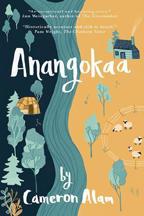
Alam, Cameron
Blackwater Press (322 pp.)
$19.99 paper | April 3, 2023
9781735774787
When a teen’s life is forever changed by an outsider, she must face the costs of her new friendship in this historical novel. In 1804, 14-year-old Flora MacCallum comes to the New World with her family, looking for hope and new opportunities. In the Old World, their home in Scotland, they faced persecution from the English. This New World, Baldoon, is going to offer a fresh start and a better future. But then everyone grows sick, including Flora, and when she wakes up, her parents and closest sister are dead. Now, Flora is mute and her sister Isobel is constantly frustrated with everything she does. Flora’s brother, Hugh, is trying to do his best for their family, but Isobel disagrees with him (“I’m weary, Hugh….Weary of wolves, bears, snakes startling us from the path. I have a pit of fear always burning in my belly”). She, along with the whole community, is also fearful of the Chippewa living across the river. Meanwhile, Hugh gives Flora a task that will help the family: tending the cows in the barn. One day, she meets a Chippewa boy named Niigaani. At first, Flora is scared of Niigaani, but she soon finds that his visits bring her solace from her loneliness, and she begins to look forward to seeing him. As winter sets in, Hugh takes the family to live on an island for safety. While Flora’s friendship with Niigaani develops, she will soon have to face the consequences of her closeness with an outsider. Alam has created a rich text that fully transports the characters to the world of Canada in 1804. The author has clearly done her research and presents information in a way that highlights and supports the story and players. Flora is an engaging protagonist whose fears, hopes, struggles, and teen angst are palpable throughout the tale. Her siblings are relatable, and their love for one another and conflicts are understandable and realistic given the awful circumstances they find themselves facing. Their plight and Flora’s absorbing story fill the pages of this wonderful book, which maintains a steady pace and delivers a satisfying ending.
Deep and dramatic, this engrossing family story will haunt readers.
THE WORK
A Jigsaw Memoir


Arama, Roxana Ooligan Press (288 pp.)
$18.00 paper | $8.99 e-book | Feb. 7, 2023 9781947845381
An immigration lawyer and her latest client both face injustice and a host of menaces in Arama’s debut thriller.
Seattle-based attorney Laura Holban reluctantly takes on a new case despite her hefty workload. U.S. Immigration and Customs Enforcement officers have just arrested undocumented Guatemalan immigrant Emilio Ramirez, who has lived in Washington state with a happy family and a steady job for more than two decades. But he’s now up against Seattle’s chief ICE prosecutor, Mason Waltman, who seems determined to eject him from the country. Laura’s burden is to prove that her client shouldn’t be deported, a task that is complicated by a false assault claim leveled at Emilio. Someone appears to really want Emilio back in Guatemala; his family’s home is broken into, and Laura is physically intimidated in an effort to get her to drop the case. Suddenly, questions arise about the validity of Laura’s own green card, which she received when she immigrated to the United States from Romania 18 years earlier. Laura worries that Emilio will be killed if he returns to his native country, a sad fate that’s befallen other clients of hers—but the greatest danger for her, Emilio, and his family may be much closer to home. Arama’s taut narrative brims with tension and indelible characters. The author is sensitive to discrimination (“When a native speaker makes a mistake, it’s because they’re tired or distracted. When an immigrant makes the same mistake, it’s because they’re dumb”) and microaggressions: Several people make note of Laura’s accent, as if she’s a tourist in the country she’s made her home. The story derives suspense from unpredictable threats courtesy of ICE, crooked lawyers, and the mysterious figure targeting Emilio. Most of Laura’s fight takes place outside the courtroom, where only a few scenes are set. Violence crops up in the final act, though it’s nominal, and the ending packs a mean dramatic punch.
A remarkable cast sparks this incisive, riveting tale of intolerance.

Barbosa, Tessa
Entangled Teen (368 pp.)
$18.99 | $7.99 e-book | March 21, 2023
9781649373366
In this debut YA epic fantasy from Filipina Canadian author Barbosa, a cursed girl must rescue her mother while competing to become the ruler of Tigang.
Seventeen-year-old Narra Jal has been searching for her mother, Shora Jal, since she went missing eight months ago. One month ago,
Narra and her sister, Kuran, received word that Shora had been arrested. As the book opens, Narra returns to her birthplace, Bato-Ko—the capital city of Tigang—hoping to find a record of Shora’s arrest. Narra is successful, but Manong Alen, the Archivist who points her to Shora’s arrest record, becomes suspicious of her motives and follows her out of the city. Narra, who hides nearby, sees a magic-wielding Tigangi woman in royal garb intercept the clearly intimidated Archivist. Manong Alen calls the woman Arisa moments before she murders him. We learn that Arisa is the Astar, “a ceremonial position in the government,” though Narra isn’t yet aware of Arisa’s position or the role she will play in her future. Arisa calls a Guardian to move the body, and Narra is struck by intense déjà vu: She somehow knows the Guardian, who is named Teloh. The author depicts an intriguing romance between Narra and Teloh as Narra attempts to untangle her fragments of memory surrounding him. Narra devises a risky plan to rescue Shora: Enter the Sundo, a deadly competition in the glass fortress where, “once a decade, people from all over our country gather to select a new ruler,” learn her mother’s exact location within the fortress, and free her. Barbosa’s characters are vivid on the page. Narra, for example, is guarded but still compassionate. The author also excels at building suspense: “In a little over two weeks, the country of Tigang will crown its new ruler. This means in three days’ time, people will start dying.” The mysteries of Narra’s curse, Shora’s fate, and the hauntingly familiar Teloh will keep readers invested even before the Sundo begins.
A page-turning fantasy with a daring protagonist, thrilling mysteries, and romance.
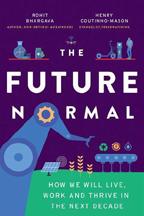
Bhargava, Rohit & Henry CoutinhoMason Ideapress Publishing (336 pp.)
$24.99 | $0.99 e-book | March 7, 2023 9781646870653
Entrepreneur Bhargava and consultant Coutinho-Mason predict new patterns for work and society in this debut nonfiction work.
The future is already here—it just hasn’t gone mainstream yet. That’s the philosophy undergirding the work of the two authors of this book, who make it their business to know where, in the present, the seeds of the future are already beginning to sprout: “What is happening on the edges of most industries or in society—the technological marvels, the ambitious innovations, the bold social agendas—hold the potential to become mainstream in the future, to change how we’ll live and work and what we’ll value,” they write in their introduction. Some of these ideas have already filtered into the popular consciousness, even if they haven’t become routine for everyone, such as remote work, the medical use of psychedelics, and plant-based meat. Others will likely strike readers as completely novel; in the future, the authors assert, children may get a substantial
In Indieland, we’re seeing more picture books that explore neurodiversity among children and consider the emotional effects of being “wired differently.” In kidfriendly terms, the books explain, for example, the nature of sensory sensitivities or the need for more direct communication styles. These three picks use inventive ways to build awareness and illuminate life on the spectrum.
In Ian’s Show and Tell Surprise, written by Vicenta Montgomery and illustrated by Christopher-James Bolognese-Warrington, Ian wishes his classmates understood him better. In a show-and-tell session, the third grader, who has autism, uses various objects to help his classmates imagine things from his perspective (e.g., a hula hoop represents his tendency to forget about personal space). The classroom is initially shown in grayscale, but each new object introduces more color. “The voice feels authentic to Ian’s experiences, and the empathetic story is based on a presentation the author’s own son did for his third grade class,” says our reviewer. “A sympathetic, engaging, and understanding look at autism.”

Writer and illustrator Dani Haendiges gives readers an abecedarian tour of life with her son, Ollie, in A Is for Autism. Our reviewer notes, “As [Haendiges] travels through the alphabet, one core theme resonates: ‘It is important to know that our neurodiverse kids are not sick; they are just wired differently.’ Starting with apple (Ollie only likes green apples because of the way he processes the world) and ASL, which the boy uses to communicate more smoothly, the author immerses readers in a detailed journey.”


The Amazingly Awesome Amani Battles the Molar Monsters, the latest in the Amazingly Awesome Amani series written by Jamiyl Samuels and Tracy-Ann Samuels and illustrated by iNDOS Studio, shows Amani conquering his anxiety of getting his teeth cleaned. The dentist’s patient approach—he allows Amani to investigate the dental tools and considers Amani’s sensory sensitivities—may help children with or without autism manage their own fears.

portion of their education passively by playing video games embedded with stealth learning technology. If one lives alone, they say, one may rely on Siri-like virtual assistants, trained to offer people emotional support and companionship. Large companies, in order to better integrate themselves into the community, may invite nonprofits, local businesses, and artists to share their office space, the authors note, and one’s city may be redesigned so that all the places one needs to go daily— work, home, school, parks—are within a 15-minute commute. The new urban center may feature vertical forests—skyscrapers filled with trees and plants to regulate their temperature and muffle noise—and vertical farms, and biotechnology may replace plastic, making products waste-free. This might sound like the stuff of SF, but with each chapter, the authors introduce readers to concepts that make the future seem less dystopian—and right around the corner.
This present-is-future philosophy is why Bhargava and Coutinho-Mason jokingly refer to themselves as “now-ists” rather than futurists. Their prose reflects the optimism and enthusiasm they feel for each new idea, as when they discuss the pre-owned clothes marketplace Depop: “Digital secondhand marketplaces also allow people to flaunt their entrepreneurialism as a key source of status too. If eBay is the Goodwill of the digital secondhand fashion world (huge, functional, but unsexy and hard to navigate) then fashion marketplaces like Depop are its younger, more creative, cooler cousin.” Chapters generally introduce an emerging trend or technology and then highlight an organization or company that’s currently putting it into practice. If there’s a knock on Bhargava and CoutinhoMason’s method, it’s that they sometimes come across as a bit too rosy in their assessments. For example, the authors choose to focus on how much time artificial intelligence technologies can save artists—highlighting a movie trailer that was made in hours instead of weeks—without addressing how that saved time will likely mean a smaller paycheck. In general, however, these now-ists succeed in making the future a little less scary and a lot more exciting.
An intriguing and cheerful look at ways that innovation may reshape society.
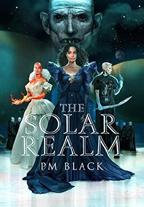
The Silver Slayer
Black, P.M.
Self (332 pp.)
$0.99 e-book | Dec. 5, 2021
In Black’s SF debut novel, a ruthlessly efficient assassin must deliver a powerful relic to the next in the line of succession following an empress’s murder.
A coup by a treacherous Chancellor and his hordes results in the death of the formidable Empress. Now, the Imperial Orb, an artifact of immense potency, must pass to her royal heir. The rightful successor is 17-year-old princess Jenanine Blackwater, who’s uninvolved in her kingdom’s
conflicts and, aside from healing skills, painfully lacking in magisterial magical arts. Kora, known as the Silver Slayer, is the Imperial factotum tasked with delivering the Orb to Jenanine. She’s the most fearsome of a caste of solder-assassins— many of whom, it seems, are on the bad guys’ side. Depending on their home worlds, Slayers wield weapons based on water, ice, wind, rock, or other natural elements. Hailing from the harshest planet—one that’s “barren and brutal just like its people”—Kora has a host of deadly talents. After crash-landing on Jenanine’s world, Kora and the Orb become targets in a skirmish between dragon-rider Witches and the Muri, whose youthful Prince Cameron makes impulsive choices that place his life in peril. Then again, just about everyone in this novel is in danger thanks to the Chancellor, the Shara-La dragons, and the vampirelike aliens who’ve insinuated themselves into the clergy. Black’s high fantasy novel offers virtually nonstop combat in a realm where interplanetary travel and aliens mix with magic-wielding beings, royalty, and brutish warriors. Various players alternate first-person narration, with the notable exception of lethal, enigmatic Kora; intriguingly, most can’t see past their petty provincial-nationalist feuds, which are often laced with racial overtones, to see the crisis’s bigger picture. The violence is unsparing and often head-spinning: “Twisting my body, I bump her off and swipe at her leg with my blade. She hisses in pain as metal cuts the skin on her thigh, but before she can get back to her feet, two arrows lodge themselves into her sternum.” An open ending leaves many bloody plot points unresolved. Characters wreak havoc and homicide on an epic scale in this breathlessly paced action-fantasy.
Bruggeman, Suzette Skinny Leg Press (441 pp.)
$14.99 paper | $4.99 e-book | April 4, 2023
9798987270400
A novel set mostly in the 20th century features a weary sex worker, a German immigrant, and a transcendental love story.
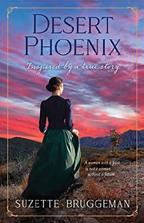
Springing from interviews, archives, and the oral storytelling of Bruggeman’s great-grandfather, this fictionalized account of a romance in the early 1900s centers on two distinctive characters. Tempa, a 33-yearold sex worker, has few expectations for her life. Born Lou Taylor, she found herself in a tailspin when she lost most of her family at age 15 to an influx of yellow fever. Though she miraculously survived and reunited with her estranged sister, Sarah, the woman’s cruel husband, Mr. Marshall, only further obliterated Lou’s warmth and hopes. He eventually sent her against her will to work in an upscale “prostitution home” in Montana. Cut to nearly two decades later, and Lou, now wielding the name Tempa as a form of protection from her own past, is as destitute as she’s ever been, living hand to mouth in Stateline, Nevada. She is no longer providing services to “important men, gentlemen with fat waistcoats and gold toothpicks,” but instead to anyone begging for cheap relief from his labors in the nearby mines.
It is here, nearly prepared to take her own life were it not for her companion Belle, that Tempa meets Henry, equally imperiled after fleeing Germany and his domineering stepfather. Though Tempa has been weathered by life and sees few prospects, Henry’s tenderness, principles, and boyish charm induce in her “an odd sense of intimacy” that leads them deeply and irrevocably to each other. The novel is admirably crafted, its characters and setting unfolding in such an organic way that readers cannot help but perceive the realities that inspired them. With elegant and resonant prose, the author revives an era now over a century removed, animating “deep pockmarks” in a young girl’s cheeks filled “with flyspecks of shadow” and portraying “the sun” as a “silver navel on the belly of the sky.” The relationship that unfolds between Tempa and Henry is particularly vivid and painful, a gripping chronicle of two characters with few remaining hopes fighting against and eventually relinquishing themselves to what little good remains.
A meticulously detailed historical drama with high stakes and compelling characters.
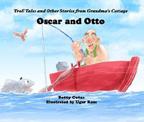
Illus. by Ugur Kose
Windy Sea Publishing (38 pp.)
$18.95 | May 1, 2023
9781956277074
A troll and a fish realize that they can help instead of harm each other in this Scandinavian-inspired legend.
Oscar the troll, star of Cetas and Kose’s Oscar and the Awful, Horrible Smell (2022), loves to fish. Otto is a fish who plays pranks on anglers, evading all attempts at capture. When Otto arrives at Oscar’s pond, a challenge of wills begins. Otto eats the worms from Oscar’s hook and net, so Oscar tricks Otto with a clear line and hook. “Oscar and Otto both pulled and pulled and pulled.” The line breaks, leaving Oscar frustrated and Otto hurting, with the hook still stuck in his mouth. When Oscar tries ice fishing, unable to wait until spring, the troll falls through the ice—rescued by none other than Otto! Determined to catch the fish to remove the hook, Oscar makes a new plan, this time ending in friendship. The two wily characters, well depicted in both Cetas’ prose and Kose’s gentle cartoon illustrations, will have readers delighted that neither loses in the end. Cetas uses some repeated story beats, building Oscar’s frustration and Otto’s arrogant behavior, and Kose compliments those moments, adding Otto’s peers into the illustrations to show that his lack of humility has not won him many friends. With plenty of repeated words to help young children decipher the vocabulary, this is a good choice for emergent readers.
A charming enemies-to-friends tale with big personalities.

Cook, Robert Zalika Productions (210 pp.)
$24.98 | $19.98 paper | $9.98 e-book

Jan. 23, 2023
9798987451205
9798987451212 paper
In Cook’s debut thriller, a government subcontractor follows cryptic messages to thwart the destruction of the civilized world.
Chase Memphis works for various agencies to help prevent crises, using an “unnatural intuition” to pinpoint danger. In Tanzania, he directs United States soldiers on a search-andrescue mission that ends with a shocking, unexplained explosion that kills nearly 30 soldiers. He returns to his Washington, D.C., office—the Mud Room, so called for its beige walls, old brown carpet, and the messy cases that are assigned there. Desperate to discover the truth behind the disaster in Tanzania, he embarks on a journey to gather and study various pieces of artwork and an ancient document written by the Greek scientist Archimedes, convinced that these items contain clues to the mystery and warnings of evils that could tear humanity apart. For this international excursion, he teams up with Ellis Newton, an old friend, and Mercy Peabody, a new romantic interest. Chase comes to cautiously trust Faan, a strange, sometimes helpful man who pops up wherever Chase goes while insisting that it’s Chase who’s following him. The author fills this story with abstruse details: Chase can’t explain his premonitions, and it’s not clear what Archimedes and the others were trying to say through their work. Nevertheless, Chase fights to save the world from…some form of peril. And while that peril is mostly vague, a tangible, powerful villain is hot on Chase’s trail. This evildoer is one of the novel’s several indelible characters, as are Faan, who’s charming but too mysterious to be wholly reliable, and Helen, the Mud Room receptionist who functions as a surrogate mother to the orphaned Chase. Cook’s narrative takes readers around the world, including stops in London and Greece, and aptly depicts the sights: white buildings on Mykonos Island seen from above are described as “tiles lined up in haphazard rows.” The ending, like the rest of the book, is ambiguous and open to interpretation.
A delightfully bizarre and enthralling tale of good versus evil.
Dunblazier, Tracee REDFeather (272 pp.)
$16.99 | May 28, 2023
9780764366314
Dunblazier presents a comprehensive, wide-angle view of healing from grief.

Each of us, the author asserts, will have “multiple relationships to the losses
we experience,” and those relationships can take a variety of forms, expressed in terms of aggression, displacement, delusional thinking, or even overeating. These responses, she says, are related to three broad “circles” of experience: the traumatic event itself; the beliefs, ideas, or choices that are brought to light by that event; and the consequences of acting upon these notions. Dunblazier draws on her experience as a professional counselor, but she also puts a good deal of emphasis on one’s “spiritual imprint” as the key to the phenomenon of grief: “You may relate to them as past lives or simply the inclination and compulsions you begin with, but no matter how you see them, they are the premising lens through which you view life, as well as the foundation of your grief.” She suggests a variety of compensatory activities, from journaling to singing to sex, advising her readers on how to focus that “premising lens” in order to better view their grief. Dunblazier writes with appealing sensitivity throughout this book. Although her specific spiritual rituals (lighting candles, making use of a “sacred altar area,” and so on) won’t appeal to every reader, her more generalized comments show a deep understanding of the nature of grieving that will be useful to anyone who may be dealing with loss. She reassures them that grief is not a sign of weakness, for example, and that many bereaved people take comfort in dealing with pragmatic details, such as paying bills or cleaning the house. Likewise, the personal anecdotes that dot the book will help many grieving readers to know that they’re not alone.
A sweeping, compassionate, and thought-provoking look at recovery from loss.
Dzahn, E. Adrian Bowker (497 pp.)
$19.99 paper | $8.99 e-book | Nov. 11, 2021 9781737083429
A retired literature professor experiences real-life drama when aiding his granddaughter’s investigation of a Scottish immigrant who inherited a fortune—and mysteriously disappeared—in Dzahn’s novel.
Widower Francis Wallace, 79, is intrigued when his granddaughter, Adelaide Cohn, reveals that she has agreed to date Carson Smith, a law school classmate who has asked her out. Adelaide lives with Francis in his Manhattan apartment while attending law school in the mid-1990s. Although helpful around the household—she does the cooking—Adelaide is also a bit quiet and closed off. Francis learns from Adelaide’s mother, Olivia, that Adelaide’s college boyfriend died in a tragic incident. Carson becomes a regular dinner guest. Francis disparagingly draws a connection between the unctuous Carson and the grasping Morris Townsend character in Henry James’ novel Washington Square and judges him unworthy of Adelaide. She lets Carson leave for a job in San Francisco without assurances of any feelings greater than friendship. Adelaide immerses herself in part-time casework that includes discovering what happened
“A contemplative, complex weaving of intersecting generational stories.”
unexpected fortune
to Mary MacDonalde, who immigrated to the United States from Scotland in 1904, then disappeared in 1913; any proven descendants of MacDonalde stand to inherit a multimilliondollar fortune. Francis and Adelaide visit the upstate New York area where Mary worked as a governess, which leads to answers about her fate as well as shocking danger that leads to dramatic new life decisions for Francis and Adelaide.
The author has written an engrossing, richly detailed novel that delves into the minds of characters in a way that Francis, a Henry James scholar, might very well term Jamesian. Jane Austen fans will also enjoy this book’s links to her works, with Francis referencing Pride and Prejudice while discussing with Adelaide “the perils of a Jane Bennet–like manner and the importance of displaying one’s affections forthrightly.” Particularly satisfying are Francis’ Emma-like epiphanies about misjudging people, most notably Carson, as when the former professor takes himself to task: “Why had I not recognized that the young man’s high-society pretensions arose not from snobbery or opportunistic cunning but from the fictions we each construct to soothe our souls?” The book is packed with subplots, including Adelaide’s meetings with people claiming to be MacDonalde’s descendants, Adelaide and Francis’ minding a neighbor’s grandson who has cerebral palsy, and a surprising and somewhat out-of-left-field encounter with a serial killer. Yet these are largely effective grace notes within this well-orchestrated novel. Adelaide’s musings about Mary provide a glimpse into the introverted law student’s interior life; ultimately, however, the novel’s many byroads intersect to bring readers to Francis’ realization that he must engage more fully with other people in his life rather than hide in his world of literary analysis. Dzahn captures this evolution beautifully, with the professor noting, “And if the world of fiction was not as bright a star as before, perhaps the cause of that dimming was not loss but an increased luminescence all around.”
A contemplative, complex weaving of intersecting generational stories capped by an emotionally satisfying ending.
Faulkner, Rebecca
Write Bloody Publishing (86 pp.)
$16.00 paper | March 23, 2023
9781838033262
Faulkner’s debut collection of poems explores the underbelly of humanity.
The author boldly confronts the ugly, dark aspects of life and death in this powerful set of poems; she recounts a tragic accident and contemplates the aftereffects of war, among other grim topics. In “King’s Head,” a speaker recalls “gum hardened” desks, a phone cord in “Twelve” “stretched under my door umbilical tight,” and, in “Sixteen,” she describes being groped outside of a club. The innocence of a “jump-rope slap” in “Rope” and double Dutch chants of youth give way to “Operation Virginity” and gruff sex
with a soldier. “Viable” describes a miscarriage, after which the speaker seeks solace on a lake bed in “Small Bodies of Water.” In “Fireweed,” the speaker yearns to tell an absent man about his son, “but there is no more room inside your busted skull for us.” She describes the ease of deceiving a doctor in “Transference” and the awkwardness of crossing paths with a therapist in the grocery store in “Shrink.” Faulkner also imagines the mindset of German political activist Sophie Scholl during her execution by the Nazi government in 1943 and pens a tribute to Mrs Dalloway author Virginia Woolf’s traumatized World War I soldier Septimus Smith. The author is masterful at evoking the tough, gritty nature of her speakers’ surroundings, describing the way “the shoreline keens & punches,” the “gin-sodden drizzle” of Southend, and the “burnt chalk taste of trams” in East Berlin. Her work addresses the experience of being female in a hostile world: In “Sixteen,” the speaker recalls walking home, “brass keys clasped between shaking fingers.” Her “hunger / for things that are just out of reach” is palpable and relatable. That said, some readers might feel unmoored by the nonchronological order of the text.
An intense and unforgettable compilation of poetry.
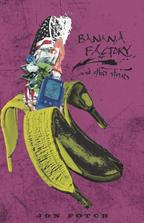
Fotch, Jon
BookBaby (132 pp.)
$18.99 paper | $9.99 e-book | Oct. 8, 2022 9781667859804
In Fotch’s debut collection, cryptic short stories simmer with the potential for violence and menace.
Most of the narratives in this trim anthology unfold as simple vignettes or fragmentary impressions of situations, delivered in stylized prose that challenges the reader to make logical sense of the dire things that are transpiring. “Frank,” perhaps the collection’s most accessible piece, is a first-person workplace satire from the point of view of an office worker—a demonic scion of a dark religious cult—who goes about his workday carrying the bloody head of a sacrificial victim while narrating in mundane, watercooler banter. “Rabbit Man” reveals that imaginary childhood playmates will, under some circumstances, follow their wards into the grown-up world, even into the hellish reality of bottomed-out drug addiction. The title story describes a place where all bananas are manufactured (“No one knows that the bananas they lovingly slice atop their kid’s breakfast cereal are made and assembled in an industrial factory that has a hazmat permit from the state”), an employer of minimally skilled workers with bad attitudes. More sobering is “Closet,” which conveys the panicked impressions of a family man caught in the outbreak of a nuclear war. A post-apocalyptic tone also hangs over the puzzling “Forks,” in which a mother bloodily gives birth to an “egg” every year in time for a Christmas feast. In other tales, a homicide accomplice prepares to flee pending the arrival of the actual murderer, who may be imaginary (“Troy”); a psychiatric clinic’s captive can hear the thoughts of nearby “dogs”
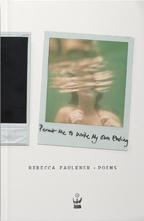

Please tell us a little about yourself and your work. I’m a biracial gay femme. My mother was a mail-order bride from the Philippines; my father was originally from Texas. The Queen of Gay Street is about how I escaped a dysfunctional upbringing and came to New York to become the first lesbian writer with a sex-anddating column for a small magazine. Unexpectedly, my editor at the time was another woman who had also lived through a lot of excessive trauma. We ended up having a tempestuous tryst where we had to confront what we lived through, both finding and losing ourselves as young women in New York.
Was your storyline something that you envisioned from the beginning, or did you build/change it as you wrote your novel?
The book sprang from a writing workshop led by Susan Shapiro. She had an exercise: to write about the most humiliating moment in your life. I wrote about the time I caught the editor I was dating at a bar with another woman, who was also an editor for a large magazine. She mocked me for being a low-budget sex blogger before going home with my ex. Sue loved it, so I kept writing and used a screenwriting technique: It was a three-act structure and had the same proportion of narrative beats as a script. Whenever someone says the book reads like a movie, I think that’s why.
Any advice for others starting the process of independent publishing?
Fully explore all distribution and pricing options so you can adjust your sales strategies accordingly. Also, stay true to yourself. I struggled for a long time to
get this book published. I tried to tell publishers and agents that it was like a grittier, edgier Sex and the City They said there was “no market for LGBT romance.” Eventually, I decided to commit to my vision and not let the idea that my voice might be underrepresented discourage me. One editor said I would “never sell a single copy of this book.” I’ve now sold thousands of copies internationally.
How did you create/acquire the cover art?
First, I created focus groups and found the biggest fans of the book were women in their 20s and 50s. I found this funny because my book is so raunchy! My cousin said, “It’s because younger women want to go on these adventures. Older women fondly remember when they had them.” With this in mind, I thought about how nostalgia would speak to these two generations. I contacted a book designer and said I wanted a Valley of the Dolls throwback with a nude pink—so that it looked a little edgy and mature—and to add leopard print from one of the scenes in my book. I knew it would attract a younger demographic while keeping a classic look.
How have you built your audience?
Mainly through social media! When I pitched this book, I said fans of Sarah Jessica Parker would probably like it even if they identified as heterosexual. I would estimate that roughly half of my readers are women who identify as queer and half who identify as straight. I get all kinds of letters every day. Some are queer readers who relate to the story; others want to understand a child who just came out as gay. Some are women questioning their sexuality later on in life and need advice. I try to respond to every single message and letter because I am deeply grateful to readers who have supported me and helped me beat the odds.
Portions of this Q&A have been edited for clarity.
(“Dogfight”); and a betrayed husband transfers his affections to a seabird (“Beatrice”). The material leans toward the fantastic, surreal, and macabre, and its often mystifying nature immerses the reader in Fotch’s eerie dreamworld all the more deeply.
Intriguingly textured short stories, generally of a disquieting nature when they can be deciphered.
Gholz, Sophia Illus. by Xiana Teimoy Running Press Kids (40 pp.)
$17.99 | $9.99 e-book | Aug. 2, 2022 9780762475551
A comedic, nonfiction picture book explores the history of human hygiene and toilet paper.

Starting at the beginning of human history (200,000 years ago, according to Gholz’s timeline), this creative story examines potty tools. Early substitutes for toilet paper and hand towels included seashells, grass, moss, and leaves. The author fast-forwards to ancient Mesopotamia’s ceramic and brick nonflushing toilets and makes a stop at ancient Rome’s public toilets—recommended “if you don’t mind pottying in public and sharing a tersorium (a bum brush) with others.” She then proceeds to the invention of paper in China in 79 C.E. But it takes many years before flushing toilets and commercial toilet paper hit the market, and Gholz and illustrator Teimoy indulge in silliness every step of the way. In endnotes, the author explains that sources differ regarding many facts about toilet origins, but the inventors and time periods in the book are the most commonly accepted. For sheer potty humor, Gholz has hit gold, and the use of simple language and sentence structures allows emergent and newly independent readers to experience the comedy confidently. Teimoy’s diverse cartoon illustrations capture the humor of early potty techniques (for example, a bidet user in 1700s France loses her balance while getting a “spritz”). For some readers, the specifics of how toilet paper was invented and marketed may come as a revelation. In addition, this history of how humans have gone to the bathroom delivers plenty of gross, gleeful details that science lovers will enjoy.
A humorous and clever tale about toilet tools.
Glisik, I.Z.
IGM LEGACY d.o.o. (258 pp.)
$24.90 | $17.90 paper | $16.90 e-book
May 23, 2022
9789619544846
9789619544853 paper
A memoir explores what it means to live with autism.
Born in 2002, Glisik was diagnosed with autism when she was 3 years old. Doctors conceded that they
were uncertain that she would ever be able to speak. Growing up, she found that writing “opened a window to the world” that she thought was “locked shut.” In this book, the author endeavors to come to know herself by reflecting on how autism has shaped her life. She touches on key life events, such as the experience of being an “American kid” who relocated to Slovenia in the third grade. But the memoir’s emphasis is on describing the emotional effects of autism. Glisik addresses in detail how aspects of the world would overwhelm her as a child, such as everyday sounds and contact with specific materials. As an adult, she explains how she struggled to “tune into” all forms of nonverbal communication. The author also recounts coming out as a lesbian with autism. This work can be read as a stand-alone or in tandem with Don’t Look Away: My Child Has Autism (2022), which offers the perspective of Glisik’s mother, Mojca. Glisik is a smartly descriptive writer who displays the ability to place readers in her position. Her actions as a child, which perplexed others, are explained with clarity—such as her “becoming a human police siren” in reaction to invasive noises: “My high-frequency shrieks would draw my attention away from those hostile vibrations in the air. After all, what’s more soothing than my own screams?” The author’s writing also demonstrates an acute self-awareness. With regard to her obsessive behavior, such as repeated hand-washing, she writes: “I’ve been caught in the same Catch 22: listening to those obsessive thoughts and acting out my compulsions eased the anxiety, but it also made me downright miserable.” Glisik is also mordantly incisive when it comes to the stereotyping of autism, such as referring to it as a “superpower”: “Telling me…that the reason I missed my mom’s graduation party was because of a superpower is merely insulting.” The author’s brilliantly expressive memoir is important: It not only opens readers’ eyes to how an individual with autism feels, but also articulates the burden of skewed societal expectations.
Bold and illuminating writing about autism.

Gonzalez, Debbie
Illus. by Kate Fallahee
Mindful Spark (34 pp.)
$19.99 | $9.99 paper | Sept. 9, 2022
9781733613064
9781733613071 paper
A little dog and his human “Grandma” spend time together in Gonzalez’s latest series picture book.
Cooper is an affectionate canine who lives with two humans, Mommy and Daddy. When Mommy brings Grandma (whom he also calls Abuela) to visit, Cooper is elated. As they dance together, Abuela imagines they’re in the Puerto Rican town square of her youth, and as they play hide-and-seek, Cooper pretends the bedroom is a playground and Abuela, his playmate. Later, they eat breakfast together, and Abuela shares a bit of her tortilla y torcino (omelet and bacon) with Cooper. The family takes a walk around a nearby lake; Cooper and Daddy search for squirrels while Abuela and Mommy chat. As their visit ends,

they have one last snuggle in an armchair. The text works many Spanish phrases into the predominantly English-language story in a way that’s easy to understand without breaking the flow: “Cooper thinks visits with Abuela are los mejores, the best.” However, not every Spanish phrase is translated, which may be frustrating for young readers. Fallahee’s illustrations are enjoyable, if perhaps overly reminiscent of PBS’s Wild Kratts cartoon. There’s not much of a story here nor any overarching lesson. However, it’s a cute slice of life that’s certain to please dog-loving readers of all ages.
An affable bilingual read, although a bit thin on plot.
Gormley, Tom Trafford (254 pp.)
$39.99 | $29.99 paper | $0.99 e-book
Oct. 10, 2022
9781698713144
9781698712970 paper
A history of one of the worst forest fires in United States history. The subject of tech-industry professional Gormley’s work of nonfiction is Colorado’s Marshall Fire, which burned 6,000 acres in the state in December 2021, destroying nearly 1,100 buildings, causing $2 billion in damage, and displacing 37,500 people. Many readers will remember the horrific news footage coming from Boulder during those days, and in these pages (full of maps and color photos, many of which are astonishing), the author digs into the details of the disaster. Underscoring many of these is a theme that runs throughout the book: the sheer unpredictability of a fire of this size and ferocity. Some homes were destroyed, while other nearby buildings were largely untouched; some businesses were flattened, while others were able to open up again in a little over a week. Gormley presents a large amount of granular research and many interviews over the course of this work, and he offers a great deal of engaging information, including accounts of tactical snafus (such as fire trucks being prevented from reaching towns because of evacuees crowding the roads) and the heroism of dozens of emergency workers. Gormley has also assembled an incredible gallery of photos from all stages of the emergency. Although the author’s accounting of facts is very thorough, he never forgets to highlight the vibrant drama of the events, as when one interview subject known only as Jase H. tried to wake his sleeping children when he heard a sudden pounding at his front door: “A police officer screamed, ‘Evacuate now! Do not hesitate! Just go NOW!’ ” These moments, plus the many close-scale area maps, help to create what could be the definitive study of the Marshall Fire.
A heavily detailed and gripping narrative account of a historic Colorado conflagration.
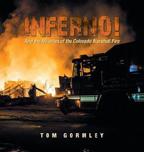
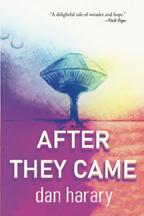
Harary, Dan Genius Book Publishing (340 pp.)
$22.95 paper | $7.99 e-book | Feb. 27, 2023 9781958727027
A 70-year-old failed businessman is chosen to act as humanity’s spokesperson to a race of benevolent aliens in Harary’s SF novel.
Jonathan “JT” Tuckerman is estranged from his adult children. He lost his first wife in a car crash (which was his fault) and is acrimoniously divorced from his second. He has business debts. On his 70th birthday, JT sets out to drown himself in the ocean off Malibu, California. This, however, is the day the alien “Benevolents” reveal themselves to humanity. They rescue JT and fly him in their spaceship to Dodger Stadium, proclaiming him their representative on Earth. JT is to liaise with world leaders and interest groups and meet monthly with the 7-foot-tall male alien Jorthon and his 6-foot-tall female counterpart, Kalyssa, to request their help in solving problems that plague the world. JT is given an office at the United Nations. He and his team petition the Benevolents to eliminate a host of social ills, and the aliens intercede in each case. People worldwide hail JT as their savior, and the future looks bright for everybody. But what will happen when a second, less friendly race of aliens comes calling? The author’s prose is workmanlike but functions effectively to tell a multilayered story. Jorthon and Kalyssa’s interventions smack of childish wish fulfilment—some of their solutions are naïve, and little thought is given to the chaos of instantly transitioning to a world free of hunger and war—but Harary nonetheless succeeds in highlighting the issues in question. JT is not especially likable (“Interminably unfulfilled, JT was the survivor of a traumatic existence which held no joy for him”), and few readers will judge him worthy of adulation, but the turnaround in his fortunes suggests that there is hope for everybody. One important facet of the novel is the way the author extends JT’s team’s scope to countries and problems beyond the United States, presenting a diversity of religions, ethnicities, and genders. While individual characters don’t always act or speak in particularly distinctive ways, the spirit of togetherness and inclusivity lends additional appeal to JT’s journey.
A hopeful, wide-ranging exploration of loss, love, and salvation.
Kaye, Kelley
Red Adept Publishing (262 pp.)
$12.99 paper | $9.99 e-book | June 16, 2021
9781948051729
In this mystery, the murder of a high school football coach spurs two amateur detectives back into action.
This third installment of former teacher Kaye’s Chalkboard Outlines
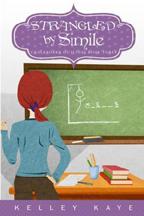
“A heavily detailed and gripping narrative account of a historic Colorado conflagration.” inferno!
series stars beloved veteran English instructor and “rabid pacifist” Emma Lovett and her fashion-conscious best friend, Leslie Parker. They are entering their third year at Western Colorado’s Thomas Jefferson High School. After enjoying a respite from investigating two murders that rocked Jefferson High, it’s not long before another body shows up just a month after the start of the new school year. This time, it’s one of Emma’s colleagues. Football coach and staunch sports fanatic Charlie Foreman (“Sports were—almost—his only reason for being”) is found strangled in a gymnasium office. Though Charlie happened to be the school superintendent’s son, he also was someone with an abrasive personality who frequently locked horns with the staff. But who would go to the extreme of murdering him? Leslie’s dating exploits with her boyfriend, Shawn, and her penchant for quoting Shakespeare throughout the book add touches of humor and whimsy to the weightier amateur investigation, which draws in suspects galore from across the school. They include students, promising athletes, twin brothers, and a Speedo-wearing trailer dweller as well as Leslie herself. As the mystery unfolds and Emma is threatened and then attacked at a party, it becomes clear that both Charlie’s private and professional lives had been vastly underestimated. The rather rushed reveal comes as a surprise after a Hamlet-style trap is set. Adding heft to the storyline are intriguing specifics surrounding Emma’s recent complaints of dizziness and foggy vision. When the cause is revealed after a meticulously detailed MRI, it’s a serious diagnosis. Emma’s trials with the same ailment that the author has grappled with afford readers a more intimate glimpse into the protagonist’s life and immensely humanize her beyond the quirky high school teacher–cum–amateur sleuth persona. With the tale’s swift plotting, hint of danger, and effortlessly clever, hip prose, Kaye again demonstrates how simple storytelling can translate into indulgently devilish fun even in the violence-prone murder mystery genre. A buoyant, frolicsome whodunit anchored by an unassuming, supersleuthing duo.
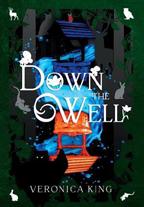
King, Veronica
Inimitable Books (260 pp.)
$26.99 | $13.99 paper | $4.99 e-book
Sept. 5, 2023
9781958607718
9781958607770 paper
A young woman finds herself transported to a magical world of talking animals in King’s YA novel.
Lorette “Lore” Deodarán is an awkward 18-year-old whose life is in upheaval: A new home in the town of Hazel Borough, a new school just a month from graduation, and court-ordered therapy only add to the familiar, crushing anxiety of her fraught family life. A job at a neighborhood bakery and time spent with her grandmother Mamó promise some measure of reprieve—until a big-eared, golden-eyed creature searching for a particular charm bracelet inadvertently causes Mamó’s death. When Lore attempts to catch the beast,
she tumbles down the blue brick well behind her grandmother’s cabin. She lands in the town of Charmsend, in another world called Thimbleton, where humans have long been extinct. It’s a magical place, full of talking animals who wield mystical powers. Lore receives aid from an adventurous mouse named Mathilde who is working to solve the murder of her adoptive father, Gannon, a gentle giant of an alligator. The author’s prose is whip-smart and laced with poetry, regularly returning to themes of precious gems and flowers. Chapters are short and fast-paced, and the characters exchange fun, snappy dialogue (“ ‘Human, I am this size because I am a mouse, not because I am a child.’ Lore sucked on the inside of her cheek and quietly sat back down. ‘You could have just led with that, you know,’ she grumbled”) that makes the exposition go down easily. The novel excels at establishing settings; Charmsend is as bewitching as its name implies, a fully formed society with unique customs for everything, from preserving their history to burying their dead. While there’s plenty of action (including an exciting fight with a giant librarian snake), the way the story captures grief, both in how Lore recalls her grandmother after her death and how Mathilde honors her father, is equally impactful.
Magical mysteries, action and adventure, and ruminations on grief, all in one enchanting package.
The Lost Space Treasure Series Book 1

Knightly, Rae PoCo Publishers (286 pp.)
$11.99 paper | $3.99 e-book | Feb. 20, 2023
9781989605431
In this middle-grade SF novel, a young hero searches for a space treasure. Trinket is a 12-year-old whom locals derogatorily label a “piece of scrap.” Living in the city of Axiopolis on the planet Kepra-2 in the Milky Way, Trinket admits to her personal, built-in computer, Empty, that she “didn’t know whether she was a mortal being with a metal leg or an android with artificial emotions.” Regardless, Trinket is determined to prove herself. Her chance comes when Axiopolis is invaded by the Remnants, cruel warriors led by the ruthless Count Solomon Drakir—a man who fears no one but his boss, the Supreme Leader. The Remnants pillage Trinket’s old house, in which she lived with her creator, the Old Scientist, now deceased. The warriors discover evidence that points to the existence of a “Lost Space Treasure”—and to Trinket as the key to unlocking it. Now, Trinket must avoid capture by the Remnants and battle her way to the treasure first if she is to save the universe. Meanwhile, a war between the Remnants and the Interstellar Alliance looms. During her quest, she meets an unexpected ally in Woolver Talandrin, a wanted terrorist from the farming planet Plethora, who may harbor key secrets. In this series opener, Knightly’s worldbuilding is richly detailed, from its unique languages to its specific cultures like the A’hmuns and Sea Keprans. But while the story also offers gripping action, it is the personal
connections that make this novel shine. Trinket’s bond with Empty is both funny and touching, and her growing friendship with Woolver evolves right alongside her confidence in her own abilities. This smoothly written story is ultimately about a spirited hero discovering who she is and what she’s really capable of—with a generous helping of some stellar fight scenes along the way. Packed with engaging characters and nonstop action, this riveting SF adventure will delight readers.
McKeon, Robert and Sam Fletcher
Illus. by Joe Flood Scout Comics (96 pp.)
$14.99 paper | $3.99 e-book | March 28, 2023 9781639691531
A down-on-its-luck, lowbrow baseball team may find salvation in a talented new player in this graphic novel set in the late 19th century.

Skip and Kingston are two players for the Brooklyn Bridegrooms, a perpetually beaten baseball team owned by swindling businessman Van Der Klam (who sets a poor example of following the law that several of his players duplicate). When Police Commissioner Theodore Roosevelt shows up to quell a riot at Bridegrooms Field, he threatens to shut the team down if any of the players get out of line. Sadly, Skip doesn’t have anything in his life but the team. When new player Rube Shaw shows up with more talent than the rest of the players combined, Skip hatches a plan to save the Bridegrooms. But then three players run afoul of Roosevelt, only narrowly escaping his wrath. Back at the field, Rube leads the team to victory, and Van Der Klam decides to keep the Bridegrooms playing rather than engineering a stadium “accident” and collecting the insurance money. Unfortunately, Roosevelt is still after the team, and it’s only a matter of time before everything explodes. McKeon and Fletcher craft a humorous story aimed at adult readers (there’s plenty of sexual innuendoes and references to sex workers throughout). The madcap tempo of the story, with the bullying Roosevelt as the bellowing antagonist, works to keep the pages turning quickly. Scammers Skip and Kingston seem unlikely to ever get their just deserts, especially with the honest-to-a-fault Rube as their friend, and readers are likely to cheer their successes despite their irresponsible ways. Still, the satire about how public opinion and the press form policy, rather than ideals of right and wrong, is sometimes a bit on the nose. Reporters’ assertions (“What a scandal!”; “Roosevelt crushes symbol of hope for city’s poor and downtrodden!”; “I can see the headlines now!”) are what ultimately put the Bridegrooms back in the game. The color choices tend toward muted, reinforcing the story’s cyanotype-photography era, and Flood’s art ably captures the absolute mayhem and the off-color remarks and gestures of the engaging characters.
A zany, entertaining tale about a Brooklyn baseball team and Theodore Roosevelt.
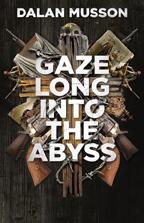
Motz, Adam
Illus. by Jordan Aspiras
Gatekeeper Press (31 pp.)
$19.99 | April 4, 2023
9780578291352
Motz presents a sweet tribute to love and family in this children’s picture book.
“Where do I come from?” is a common question that kids ask adults. This delightful work simplistically but sweetly answers, “I tell you, my child / that you come from love,” followed by 25 colorful pages detailing myriad ways that love can manifest. Whether it comes from “the universe,” “the stars,” and the “earth” or from “the song…sang at your birth,” love is shown to “lift you, again and again” and “carry you, now ’til the end.” Easy but powerful rhymes allude to dynamic themes of spirituality, ancestry, and family, allowing caretakers and their children to choose their own path regarding the subject. The book would work well as a quick bedtime story or an in-depth opportunity to explore the multiple ways to have a family and experience love. Illustrator Aspiras aids in emphasizing the beauty of diversity by using bold, striking colors to depict varied genders and cultures within a family. At the heart of most images are two small children in a picturesque world. Both adults and kids will be enchanted by the alluring, sweeping imagery on each page as they read that love is, in fact, all around.
Artful rhymes and radiant illustrations paint a loving picture in this charming work for young readers.

Musson, Dalan
California Coldblood Books (176 pp.)
$17.00 paper | June 20, 2023
9781955085144
Musson’s debut blends apocalyptic fiction with biblical myth in a story about two unlikely heroes and their quest. Set in an indeterminate time—and world—the story begins with a character known as the Old Man, who is struggling to simply survive in a wasteland where the majority of the population is mysteriously gone. Everything about the Old Man and his reality—from his ramshackle cabin to his half-dead pigs to the sky, which stays a shade of gray—has a hopelessness, a nihilistic heaviness that seems to weigh down everyone and everything. “He, like everyone, had little, and meant less, and ultimately all would return to dust, and the soil would turn over, and in a time none would remember any of the others, and that was just the same as never having existed in the first place.” But when a wanderer called the Kid finds the Old Man and enlists his help to kill a nameless evil who has returned to complete a prophecy concerning the opening of Seals—“It’s happening, just like they said it would….Just like they wrote in the Old Books”—the man reluctantly agrees, and the two set off across a nightmarish
“A zany, entertaining tale about a Brooklyn baseball team and Theodore Roosevelt.”
bush leaguers
landscape in search of the mythical villain. Armed with only a few weapons (the Kid with his rifle and the Old Man with his pistols), the duo witnesses numerous atrocities during their quest of retribution. The prose, stark and simplistic, complements the dark, surreal quality of the narrative: “The Old Man sits up on the small, rickety bed. His legs hang over the side, barely scraping the floor. He’s not a tall man, and it’s not a tall bed.” Additionally, the infrequent New Testament references add a spiritual layer and thematic weight to the apocalyptic tale, particularly at its thought-provoking conclusion.
An intriguing, haunting fever dream at the world’s end.

Penn, Blake & Raven Penn
Good Lux Creative (487 pp.)
$14.99 paper | $4.99 e-book | March 6, 2023
9798987789520
A young man on a quest for vengeance gets more than he bargained for in this fantasy novel by Blake Penn and Raven Penn.
Three years ago, in the fantastical realm of Evgard, a 17-year-old magicusing “magi” called Asher lost his mother, Zerana, also a magi, when she was killed by the Mage Hunter called the Black Valkyrie. Asher’s father, Akayto, takes in teenage brother and sister Kai and Kari after their parents, who had been assisting an elite group of dangerous magi called the Knights of the Torch, disappear. Asher and Kai spend their days adventuring and thieving to accumulate enough money to move Akayto to a safer place. Their situation worsens when Mage Hunters show up at their front door looking for Asher after he and Kai get caught up in a heist gone wrong. Just as Asher fears he’s been found out, the Drekai—winged, horned, dragonlike people—invade. These strong and fearsome beings are seeking their precious dragon egg, which King Rodan of Drakfell (a “keepdom” within Evgard) has stolen. The Knights of the Torch assemble to find the dragon egg, which is incredibly rare and contains potent magic, before it falls into the hands of the Black Valkyrie, who is also pursuing the object. Asher chooses to join them on their quest, to stop the Black Valkyrie and exact his vengeance. Blake Penn and Raven Penn have crafted a complex world with an engaging cast of characters led by the dynamic and entertaining Asher (“I screamed in terror as I watched Whitestone Hall fade away. Once I was out of earshot and certain that no one would hear me, I cried out. ‘No! I’m too handsome to die!’ ”). His quest to avenge his mother is heartfelt, and he demonstrates great compassion and love for his friends and family. Side characters such as Kai, Kari, the Knights of the Torch, and others are equally fleshed out and support the story. The narrative is fast paced and skillfully interweaves the exposition with the plot and character development.
An exciting fantasy adventure and a great start to a promising new series.
pp.)
$3.99 e-book | Dec. 5, 2022
Budding photographer Simon documents the end of his high school experience in this YA debut novel from the Pennyeach Collective.
It’s time for Simon’s high school graduation, but looking back at the last three years of his life isn’t easy considering all the friends he’ll have to say goodbye to. The novel opens with Simon reviewing an imagined photo album from his sophomore to senior years. The very first photo is from his sophomore year French class, when he began learning photography using his grandfather’s old Leica M3; around this time, he also became best friends with classmates Hailey Parker and Benji. At the time, Hailey harbored dreams of becoming a journalist, Benji rebelled against his conservative family, and Simon cautiously contemplated a future in art school. The dynamic among the three friends is tested when Hailey and Benji begin dating. But it isn’t until Hailey becomes pregnant during their senior year that everything changes. She decides she wants an abortion, but the procedure can’t be done in Ohio because her family might find out. So with the help of Hailey’s friend Kaylee, they all set out on a road trip to New Mexico (where abortions can be given without parental consent) that will change the course of their lives forever. Obviously taking into account the sensitive nature of Hailey’s determination to have an abortion, the narration retains a respectful distance from the tougher details of her experience, especially as the story is told from Simon’s perspective. The author is guilty of some heavy-handed foreshadowing as Simon describes his early high school travails. Overall, however, Simon’s speech and actions feel authentically teenage: “I guess I was naive, but I thought for sure they’d end up getting married some day. And this picture captures that moment when I bet Hailey and Benji would’ve said the same.” The novel may remind readers of John Green’s Paper Towns (2013), especially the road-trip scenes. The absence of the actual photos that Simon describes leaves space for readers to imagine the characters in their own ways, though perhaps the addition of a visual component would make the photo album experience come to life.
A well-conceived novel that delves into some potentially important issues for young adults.
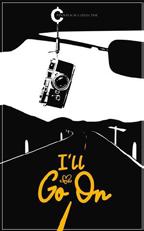

Perry, John Spencer
Self (302 pp.)
$11.98 paper | $7.98 e-book | Dec. 5, 2020
9798574960981
In Perry’s debut novel set in the late 1970s, a journalist searching for a former lover is wrongfully accused of serious crimes.
As this story opens, newly single Jeff Kain is speeding through the California
desert to a job in Palm Springs, but he makes time to stop to pick up hitchhiker Elyse Walker and her fiercely loyal dog, Tramp. Along the way, they take in some sights, namely Joshua Tree National Park, and strike up an intimate romance. Elyse initially sticks around in Palm Springs, but as Jeff settles into his news editor gig, she decides to move on to Los Angeles. Time passes, but Jeff can’t get her off his mind, and when he can’t track her down himself, he hires private investigator Aloysius Vega to do so. The PI does locate her, but it’s clear that Elyse doesn’t want Jeff on her trail: “Jeff needs to understand that he needs to stay away for both our sakes,” she says. “I don’t want him to call me or look for me again.” Her menacing boyfriend also wants Jeff to back off. Before long, authorities have turned their attention to Jeff, as it certainly appears that he’s a stalker. Later, there’s a startling assault and a person goes missing, and Jeff, despite his innocence, is sure to become a suspect. Perry’s measured thriller aptly establishes Jeff and Elyse’s relationship early on. Readers will understand why Jeff yearns to reunite with her, though they may find his preoccupation with her somewhat unnerving. The story’s latter half becomes an effective slow-burn mystery, as Elyse’s murky past comes to light and more than one character turns up dead. Standouts among the stellar supporting cast include ever protective Tramp as well as refreshingly blunt Vega, who headlines Perry’s subsequent novels, including The Gimlet Eye (2021). Arresting details of California scenery likewise invigorate the narrative, whether it’s the barren Mojave Desert or raging wildfires: “As tall Ponderosa and sugar pine trees were engulfed, embers from their crowns, propelled by Santa Ana winds, ignited the next patch of forest.”
A well-developed cast drives a quiet but absorbing thriller.
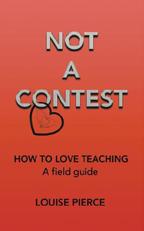
Pierce, Louise Self (104 pp.)
$13.99 | $6.99 paper | $2.99 e-book
July 29, 2022
9798842958511
9798842954759 paper
A retired high school art teacher outlines her key tips and principles in this advice guide.
Pierce, a high school art teacher for 30 years, shares “all the things I wished someone had told me early in my teaching career. Things that would have saved me a great deal of anxiety and stress had I but known.” The book contains 22 topical chapters, kicking off with “Love,” or the primary importance of loving students and the subject(s) you teach since “if you don’t embrace [teaching] all with genuine love, it is not the profession for you.” The advice in other chapters ranges from respecting the support staff to understanding students’ current capabilities and encouraging their efforts (“the most crucial pedological thing in this book”). One chapter explains the book’s title: “You are not competing with the students. They may think it’s a power struggle, but it
isn’t. As unsupported as you may feel, by administration, etc., the classroom is YOUR world. You set the tone and the rules. The system is on your side to ‘win’. So just go in with confidence.” Pierce also emphasizes the importance of joining a union and finding a senior teacher who will act as a mentor. Throughout, Pierce provides her insights and guidance with a clear and passionate voice one can imagine her using with her students. She effectively bolsters her points with some touching real-life cases of students flourishing under her care and attention. Her tips are both practical (have a thick skin, don’t complain and gossip) and philosophical (don’t just “deliver information” but “sell” the passion of your subject to students). Overall, this book encapsulates the kind of experienced wisdom that anyone starting in the profession would do well to consider and follow.
An inspiring, pragmatic primer for beginning or aspiring teachers.

Rieger, J.P.
Loyola Press (234 pp.)
$16.99 paper | $6.49 e-book | May 2, 2023 9781627204606
Quirky characters collide chaotically in Rieger’s darkly comedic detective novel. Robbers burst into a Baltimore hair salon and critically injure a plucky actor. The reader is afforded just a taste of the action before the story jumps back six weeks, then back 25 years, and then forward again, continuing to haphazardly flit through 30 years of related characters and situations every few pages. Among the chaotic jumble of stories, three arcs act as anchors: First, there is the story of Kev Dixit, a cop. He is cynical yet endearing, a family man who stays true to the people and the city he loves as he investigates fraud, robbery, and outlandish murders. Second, Lou Ricciti and Pete Palanzo, pros in the real estate business, find their lives upended upon the arrival of some sketchy new bosses who are up to no good. Finally, actor Chris Waxley struggles to find work and love in an unforgiving city. The author demonstrates an exceptional ability to create eccentric personalities that are lovable, detestable, and everything in between (as when a self-deluding pastor complains about his mistress: “And then while she was so giddily laughing at me and making fun of me, she revealed her latest canvas. It was her hand with a flyswatter about to cruelly strike at a small housefly, painted with glasses and a tie to represent me! Me!”). Each character, no matter how fleeting, teems with potential—potential that is unfortunately often wasted in a story that jumps around so spasmodically and gives the reader so little time to settle in and cozy up to the characters. Dixit, in particular, seems like a sure fan favorite if given more time— his detective work is a joy to read. Each passage is comical and quirky, albeit confusing and brief. Still, there is much enjoyment, entertainment, and, above all else, potential, in Rieger’s story. An eccentric detective novel bursting with comedy and personality.
“An
clonk!
 Rooke,
Rooke,
Jay;
illus. by Manoj Vijayan$23.00 paper |
9798985659283
$2.99e-book | Feb. 7, 2023
Rooke presents humorous cartoons and essays celebrating the parenting experience. The author has built an entire online community around “gonzo parenting,” which he defines as “full-contact parenting. Being in the thick of the messy, authentic, barely-controlled chaos.” His musings online, including stories, videos, and a podcast, have led to this delightful book, in which Rooke’s real-life stories about parenting his 7-year-old twins are paired with fun, full-color illustrations by Vijayan. The book covers a number of aspects of the parenting journey in more than 50 cartoon strips. Their titles (including “Sugar Shock,” “Lemonade Stand,” “No More Weekends,” “Dads Taking Care of Other Dads,” “Pillow Fighter,” and “Pandemic Parenting”) let the reader know what to expect. The topics will be familiar to many caregivers; “Nowhere To Hide,” for instance, is a four-panel look at a dad caught trying to hide out in the bathroom. “Screw the Instructions” is an account of an ill-fated father-and-son attempt to put something together. Interspersed between the strips are four essays that tackle some of the same parenting subjects, always with a humorous twist. The author’s strength in this collection is identifying topics that are as universal as possible in the realm of parenthood—some of the cartoon strips are funnier than others, but nearly all hit on truths that any caregiver could identify with. Rooke excels at writing the dialogue for the cartoon panels, and in his essays, which run a few pages each, he demonstrates that he’s just as effective with longer-form pieces. Compilations of cartoon strips often seem a bit haphazard; this collection avoids that pitfall with its focus on parenting, from which it never strays. And the trip, thanks to Rooke’s sense of humor, is a whole lot of fun. Real-life parenting tales that will make readers laugh— and maybe recognize themselves.
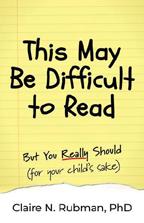
Rubman, Claire N.
Educational & Parenting Matters (254 pp.)
$19.99 paper | $9.99 e-book | Nov. 18, 2022
9798987086117
Rubman, a cognitive developmental psychologist, conducts a comprehensive examination of childhood literacy in this nonfiction work.
The author begins with a series of sobering statistics: Over 42 million Americans are defined as functionally illiterate (meaning they can’t follow written directions), 70% of high school graduates end up requiring some kind of remedial reading help, and 1 in 5
college students enrolls in a remedial reading class in their freshman year. As she points out, statistics like these are nothing new; Americans have heard for years that the systems tasked with building children’s literacy skills are failing. Rubman asserts that the goal of this book is to offer solutions to change this. “Together,” she writes, “we can analyze why, as a society, we seem to be failing to educate our nation’s children and why so many parents obsess so unsuccessfully over this process.” A central concept that runs throughout the book is introduced early: Children acquire their knowledge in their own way. “Remember, their brains are different from our brains,” Rubman writes. “They don’t think, speak, or learn like we do.” As the author explains, this is crucial to remember because, despite many parents’ hopes that their children will take to reading very early (before kindergarten), a child’s brain isn’t finished undergoing the process of myelination, in which neural pathways develop their message-bearing abilities. Allowing that process of natural development to work at its own pace is at the core of Rubman’s revisionist approach to helping kids get the most out of their reading.
The author’s experience, insight, and, above all, compassion shine through on every page of her book, even when she’s carefully demolishing what she views as the incorrect thinking of earlier theorists on the subject of children’s literacy; for example, she extensively debunks the so-called “Mozart Effect” that was in vogue some years ago. She includes well-made graphics to illustrate concepts such as neural development, and she adds bullet-pointed sections and actual test passages designed to flesh out the intricacies of reading comprehension. Along the way, she clarifies a wide array of reading-related matters in ways that parents and educators will find very helpful: “It is not the size of the word that determines its level of difficulty, per se,” she writes of one such issue, “rather its phonetic friendliness and frequency of use…determine…the ‘ease’ with which it’s read.” Her myth-busting energy never flags, which is extremely helpful, as many adults remain beholden to popular fallacies. Regarding the idea that children learn better when they read to adults than they do when adults read to them, Rubman convincingly contends that the reverse is true. “When you read to children, you allow them the luxury of focusing their attentional energy on the meaning of the story,” she writes. “This is an ideal time to work on comprehension skills.” The author’s calm wisdom is very encouraging, and her main message— that there are no shortcuts and that development takes time—will be much appreciated by parents feeling peer pressure to produce little Einsteins.
A wide-ranging and winningly compassionate revamping of how to think about children’s reading.
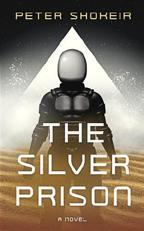
Shokeir, Peter Self (331 pp.)
$3.99 e-book
A wisecracking superhero battles supervillains in a militarized near future in Shokeir’s fantasy adventure.
In the 22nd century, the Western Union is an alliance of North American and European nations fighting a seemingly endless
When taking up a new hobby, it’s often hard to know where to start or what to buy. In this introductory workbook, learning to paint with watercolors is laid out in a simple, easy-to-follow plan. The suggested materials list is simple without being too basic, with Simon noting to the reader: “I want you to see how much beauty you can create with minimal supplies and expense.” She recommends just two student-grade brushes, a waterproofink pen, and nine suggested paint colors, only one of which she recommends buying at professional quality. The text notes that the project pages are printed on premium watercolor paper, meant to be painted upon directly. (A digital copy of the book was provided for review.) Before starting each exercise, the author explains methods clearly, including specific water-topaint ratios, color “recipes” to create various shades, including a comprehensive guide for human skin tones, and, of course, various painting techniques, such as wet-in-wet, wet-on-dry, dry brushing, and more. To perfect these new skills, there are more than two dozen line drawings of plants and animals. For each, Simon indicates suggested colors and brushes at the top of the page alongside a completed full-color version of the painting. The painting process is meticulously described in anywhere from five to nine stages, with specific techniques helpfully made more prominent by using all-caps: “With your Round 4 brush, WASH an entire tulip flower (or just a few choice petals!) in a clear wash, leaving RESERVED areas on some petals, as well as the flower centers.” Simon’s voice is affable and supportive, giving the book the feeling of spending time with a talented friend. Her assurance that one can get beautiful results using easy-to-find materials is sure to be appreciated by newcomers to the craft.
A simple but comprehensive guide offering warm and engaging encouragement for anyone looking to learn how to watercolor.

Sklar, Zachary
Olive Press (214 pp.)
$19.95 paper | $9.99 e-book | Dec. 27, 2022
9781954744967
In Sklar’s memoir, a journalist and Oscar-nominated screenwriter reflects on his professional and personal journey.
The author experienced paranoia from a young age as the son of playwright George Sklar, an ex-Communist whose career was negatively affected by the Red Scare of the mid-20th century. Sklar’s parents largely kept to themselves, warning their son not to stand out as an activist or objector. Despite this, Sklar enrolled at the University of California, Santa Cruz, in 1966 and began attending demonstrations. Eventually, Sklar moved to New York City and worked as a proofreader and freelance journalist. He volunteered to pick coffee beans in Nicaragua for a month at the height of the contra war, and a chance meeting with lifelong leftist activists Ellen Ray and Bill Schaap led to his biggest career break yet: editing On the Trail of the Assassins
(1988), one of the books that would become the basis for Oliver Stone’s controversial 1991 film JFK, co-adapting the screenplay with Stone and earning an Academy Award nomination. Sklar’s involvement with the project marked the end of his mainstream journalism career; he began a second act as a screenwriter and instructor at the prestigious Sundance Institute. Across seven essays, Sklar’s plainspoken voice educates, entertains, and never condescends. His descriptions of life-altering blacklists, homespun island funeral ceremonies, and a dog in distress in Mexico (“By the time Sarah got back, Diane had picked him up and was cradling him like a baby. The trusting dog didn’t fuss or fight. He lay there, his head on Diane’s breast, his sweet eyes fixed on her face”) are powerful and true. He guides the reader through a fascinating journey marked by a primary inner conflict: to loudly proclaim one’s beliefs and potentially lose a livelihood or to suffer in silence? There are no easy answers for Sklar—however, there is always the possibility of human connection, whether in hotel bars, fast cars, or Oaxacan streets.
A beautifully written account of a principled life.

Smith, Robert W. Meryton Press (270 pp.)
$12.95 paper | $6.99 e-book | Jan. 17, 2023 9781681310725
In Smith’s historical novel, a young Irish immigrant encounters unexpected intrigue in the United States.
Conor Dolan and his older brother, Kevin, contemplate the peaceful Irish countryside of County Clare and the distant lovely sight of Galway Bay in 1886, idly thinking about faraway America. The narrative jumps forward to 1903 and a future neither boy could have imagined: Conor, now a lawyer, is visiting Chicago for the first time, intent on paying a visit to his brother, who’s become a policeman. The wild lawlessness of Chicago confronts Conor at every turn (a greetings official advises him to buy a gun): “Prostitutes, procurers, and hustlers assaulted Conor at every step with promises of carnal pleasure or riches,” the author writes, adding with a twinkle, “and it was still morning.” Conor suffers a rude shock: He learns that his brother is dead—by his own hand, according to the local police. Conor can’t believe this and sets out to investigate just what his brother was doing in the New World during the years they were separated. His investigation is aided by an unexpected ally: his new neighbor (and romantic interest) Rebecca Fletcher, a Jewish woman who informs Conor that Scotland Yard had been investigating his brother’s connections with the Clan na Gael, a Chicago branch of Irish Republicans planning to assassinate the visiting Prince of Wales. Smith does a remarkably economical job of sketching out all of the plot’s complications; there’s scarcely an ounce of fat anywhere in this tale. The author occasionally overdoes the stereotypical Irish dialect (“Ahhh, come on now, Conor,” Kevin prodded. “Sure there’s nothin’ t’cry about. ’Tis only the constable come to collect the rent”), but
“Across seven essays, Sklar’s plainspoken voice educates, entertains, and never condescends.”
the work
the sheer tension of his story is irresistible.
A lean and compelling mystery set in the rough-and-tumble Chicago of the early 20th century.
Solovy, Alden
Central Conference of American Rabbis Press (196 pp.)
$19.95 paper | $9.99 e-book | Feb. 2, 2023 9780881236156
Solovy, an American Israeli liturgist and poet, offers a collection of poetic midrashim.

Whatever may bring a reader to this compendium of reflections on the Torah, the overwhelming sense they will depart with is that of a deep care for words and their textures. As the author writes in the introduction, “we are a people of stories. We tell them. Then we tell stories about them. Then we tell stories about the stories of the stories. We call that midrash.” The cyclical return to language and its multiple meanings is at the core of midrash, making poetry a particularly apt vehicle for its scriptural interpretations and reinterpretations. In this collection, 70 Hebrew words of Torah are grouped into 10 sections, with categories ranging from “God” and “Mitzvot” to “Journeys” and “Love.” The entry for each word includes a prose reflection, or d’var Torah, followed by a short poem; chapter introductions offer connections between the chosen terms. These prose exegeses are concise and accessible, prompting scholarly inquiry into the origins of words and rabbinic arguments about their meanings while also offering context for those unfamiliar with the terms and their significance. The poems themselves are simple, often reading as prose sentences broken into shorter lines.
Their spare rhythms can be soothing, if repetitive at times—further explorations into formal and syntactical variation (or even experiments with greater abstraction) would offer welcome nuance. Still, each of the poems is compellingly sincere. Reflecting on T’ruah (“Loud Blast”) the author writes, “Holiness has a sound. / Part swoosh of blood in the veins, / Part hum from the edge of the universe, / Part stillness, part vibration, / …A sound that can only be heard / With the heart.” Whether reflecting on Afar (“Dust”) or Tzedek (“Justice”), these are indeed offerings from the heart.
Thoughtful reflections on the meanings of the Torah.

Traunfeld, Samantha
Inimitable Books (292 pp.)
$26.99 | $16.99 paper | June 6, 2023
9781958607060
9781958607015 paper
A young soldier with untapped abilities must protect her new queen in this new-adult fantasy.
In the realm of Kaizia, Saiden is a member of the deadly Legion. She and her partner, Mozare, take missions from Gen. Nakti on behalf of Loralei, their young and newly enthroned queen. In Kaizia’s culture, the Gifted develop their magical powers when they’re teenagers. Saiden, with her red mane, is Blood-Cursed, supposedly too dangerous to live because of her connection to both gods. Her powers never manifested, however. She’s become a fearsome warrior with a reputation that’s earned her a post in the Queen’s Guard. Guarding Loralei involves protecting Kaizia from dangers, including the Enlightened, religious fanatics who are willing “to die to bring the gods closer to earth.” There’s also an underground Rebellion led by the charismatic Revon, who claims to know an ugly truth about Kaizia society. While Mozare cares deeply for Saiden, his allegiance may be compromised. He wants to dismantle the realm’s foul monarchy, which abides by brutality against common people. When Saiden learns the truth about her own family’s past, will she join the Rebellion? In her series opener, Traunfeld ably depicts the strands of darkness and romance that often weave through YA fantasy. Saiden keeps track of her kills by getting leaves tattooed on her arms, and she always manages to cause more collateral damage than Nakti would like. Loralei, meanwhile, has taken her serving girl, Cara, as her lover, a secret that threatens to bring further turmoil to the country. The narrative shifts among Saiden’s, Mozare’s, and Loralei’s perspectives, with the latter bolstering the tale’s sensuality; in one scene, the queen “watched Saiden pick an orange off the tray, peel it slowly and savor each slice of the fruit.” Some plot components click readily into place, like the identity of an imprisoned woman, and well-executed twists abound in the second half, adding deep emotional shading to the small cast. Traunfeld’s finale reveals bleak terrain ahead in installments to come.
This grim, passionate tale will scorch readers.
the day every day is
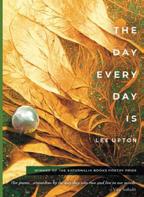
Books (104 pp.)
$17.99 paper | $10.00 e-book
March 15, 2023
9781947817500
A wide-ranging volume of poetry explores mythological figures, relationships, and the natural world.
Upton marries past with present, myth with reality, and ideas with emotions in this collection of poetry. Greek mythological characters feature heavily in the book. She depicts the murder of Hyacinth and takes on the voice of rape victim Danaë. Actaeon and Eurydice merit their own poems as well. Nature is another prominent theme. Upton considers noisy insects that “give the tree a voice” and wonders if it is fair to trick forsythia into believing it’s spring by placing it before a sunny window. Two sacks of mushrooms given a week apart inspire the poet to ask: “What other gifts are wasted on us?” The sight of a centipede in the shower prompts her to ponder: “How strange we must seem / to God. How sometimes we must / frighten him, how he must wish we would just / crawl away.” Intense religious moments, such as the stone in front of Jesus’ tomb being rolled away, and biblical figures, like Adam and Eve, are jumping-off points for other poems. As the book draws to a close, the author’s personal relationships become more prominent. In “The Blanket,” the poet considers her roles as a daughter and a mother and the ways they overlap. Upton is an austere but evocative writer. She details how the “milkweed blossoms / fade as if antique”; the way a willow “slouches as if it were in a classroom”; and the “pine’s greenness / frosted like a forged dollar bill.” The author is well read, as evidenced by references to everything from Shakespeare and Rilke to Shirley Jackson. Upton is also insightful; she wonders why “we give our hours away” to actors “as if our hours aren’t magnificent” and notes that “privacy is a kind of power.” Her honesty is unflinching, but she also injects humor into her work. In “Why Am I Not Invited to Your Party?” she recalls how she used to dance “like someone being stung / by ferocious bees.” The only time she goes too far is when she describes how “steam hisses off the oiled husks of him” and “flesh / slides to his ankles like a stocking” during the satyr Marsyas’ skinning. But even then, it’s hard to fault her for such skillful writing.
A vivid, compelling collection by an erudite poet.

Walker, Rickey Butch & Huston Cobb Jr.
BWPublications (291 pp.)
$9.99 e-book | Feb. 20, 2023
A pair of Southern authors explore untold stories of Black life and history in northwestern Alabama.
Muscle Shoals refers to the Tennessee River area of Alabama that spans from Decatur to the Mississippi state line. This book explores the long history of Black people in the region from the 18th century frontier and the time of antebellum slavery to the rise of Jim Crow segregation and the Civil Rights Movement. Cobb and Walker reconstruct a lost history of men and women who built “the very foundation of the Muscle Shoals” but whose stories “were left out of the Alabama history books in most cases.” The book’s introductory section provides an overview of African Americans shaping northwestern Alabama’s history over the past 300 years; this context provides the foundation for the rest of the book, which consists of abridged interviews with Black men and women from the region who each tell stories from their family histories. These were largely conducted by Cobb with elderly citizens in the 1980s, and many of those interviewed had direct experience with segregation, disenfranchisement, and sharecropping. Many also had close family members who had experienced slavery. The interviews point to the uniqueness of the region in Southern history, including northern Alabama’s affiliation with Appalachia as well as the complex interactions between Black residents and the local Chickasaw and Cherokee peoples. The interviews, which are important historical artifacts in their own rights, are supplemented by astute commentary by the authors, who conducted additional interviews and research during a subsequent tour of the region. Many chapters also feature color photographs of interview subjects and genealogical charts. Though scholars may bristle at the book’s lack of formal citations, Walker has an impressive list of past publications to his credit that includes more than a dozen history books on the American South. His engaging prose style is complemented by Cobb’s expertise as someone who was born and raised in the area.
A valuable addition to the historical record of northwest Alabama that emphasizes the legacy of local Black men and women.
“A vivid, compelling collection by an erudite poet.”
John Grisham is coming out with a sequel to the novel that made him a literary superstar.

Doubleday will publish The Exchange: After The Firm this fall, the press announced in a news release. It is the sequel to The Firm, the thriller that became a publishing phenomenon shortly after its release in 1991.
The Firm followed Mitch McDeere, a lawyer who takes a job at a Memphis, Tennessee, law firm, lured by a lucrative offer. He soon learns that the attorneys he works with have some unsavory connections and the FBI is on the case. In a starred review, a critic for Kirkus called the novel “terrifically exciting and likable.”
The novel spent almost a year on the New York Times bestseller list and was adapted into a hit 1993 film directed by Sydney Pollack and starring Tom Cruise, Jeanne Tripplehorn, and Gene Hackman.
In the sequel, Doubleday says, Mitch and his wife “are living in Manhattan, where Mitch is a partner at the largest law firm in the world. When a mentor in Rome asks him for a favor that will take him far from home, Mitch finds himself at the center of a sinister plot that has worldwide implications—and once again endangers his colleagues, friends, and family.”
Suzanne Herz, publisher of Vintage/Anchor Books, said in a statement that The Firm “defined the legal thriller genre and has stood the test of time. Readers will be thrilled to see what happens next to Mitch in The Exchange.”
The Exchange is scheduled for publication on Oct. 17.

Margo Jefferson’s Constructing a Nervous System has won the 2023 Rathbones Folio Prize Book of the Year, given each year for an outstanding work of English-language literature.
Jefferson’s memoir, which was also a finalist for this year’s National Book Critics Circle Award for criticism, is a reflection of her life filtered through the musicians and authors who were important to her. In a starred review, a critic for Kirkus called the book “a dynamic, unflinchingly candid examination of the impacts of race and class on culture and the author’s own life.”
The judges for the award praised Jefferson’s memoir as “an astounding and rhapsodic book, playful and serious, throwing form brightly open as it goes.”
For the first year, the award presented three shortlists, one each for fiction, nonfiction, and poetry. The Book of the Year award was chosen from the winners in each category.
Jefferson’s book was the nonfiction category winner. Michelle de Kretser was the fiction category winner for Scary Monsters, a Kirkus Prize finalist, while Victoria Adukwei Bulley was named the poetry winner for Quiet.
The Folio Prize was first awarded in 2014, to George Saunders for Tenth of December. Other winners have included Hisham Matar for The Return: Fathers, Sons and the Land In Between and Valeria Luiselli for Lost Children Archive

“The world begins at a kitchen table.” So writes the Muscogee poet Joy Harjo in a valediction to her anthology of Native American women’s writing, Reinventing the Enemy’s Language. That book began its life in 1988 as the flicker of an idea teased out over coffee: anthologies of Indigenous literature were few enough as it was, but none was devoted to the work of Native women despite the outpouring of their work that had followed the 1977 publication of Leslie Marmon Silko’s novel Ceremony.

“That was in the days before the internet, and email was a new thing,” recalls Harjo in a recent phone conversation. “My student and colleague Gloria Bird and three graduate assistants made lists of women writers we wanted to include. But we also took out notices in tribal newspapers around the United States and Canada, finding new communities of writers.”
That work took a decade. Some submissions arrived quickly, recruited from emerging writers who had studied with Harjo and other Native teachers. One was the now-eminent Diné (Navajo) poet Luci Tapahonso, another a young Laguna writer named Debra Haaland Toya, who is now the U.S. secretary of the Interior. Some, like Harjo herself (who would go on to become the nation’s poet laureate), were rising figures in the literary constellation: Louise Erdrich won the National Book Critics Circle Award for her novel Love Medicine; Linda Hogan completed her third book; Paula Gunn Allen was emerging as an important literary historian, biographer, and poet. But most contributors were relatively new to writing and publishing, and the anthology shines with the excitement that comes with the discovery of unknown talent.
Cultural truths and imperatives emerge from the pages of Reinventing the Enemy’s Language, and the enemy, it would seem, is patriarchal power and violence, the destruction of old ways and words—all things that figure in these pages. The Diné poet Laura Tohe counsels against seeking perfection at the cost of blocking the “doorway leading from [a creator’s] heart.” The Ojibwa activist Winona La Duke writes vividly of women’s resistance to male violence. And many of the writers celebrate their “aunties,” the wise women of the community. Memorably, the Choctaw writer Scott Kayla Morrison observes that while she’s not sure about the old belief that people’s bones speak to each other in the grave, she has, after much deliberation, chosen a cemetery that will allow her to “be near my aunts so I could spend the next five hundred years in their company.”
A quarter-century on, Reinventing the Enemy’s Language remains in print, considered a classic and widely taught in Native American literature classes. In the years since, nothing has come along to replace its multicultural blend of fiction, nonfiction, and poetry, which leads Joy Harjo to muse about whether it might be time for a second edition. Certainly email, the internet, word of mouth, and the heightened visibility of new Indigenous writers would make the job easier than it was the first time around. One thing seems certain: If a new edition is born, it will take life on a kitchen table somewhere out in the world.
